The 30 June 2019 local elections in Albania took place in a context of deep political polarization and crisis. The main opposition parties boycotted the elections and called on voters to abstain. As a result, many mayoral races were uncontested. The elections suffered from a lack of trust in the impartiality of the election administration due to its unbalanced composition. While voting and counting were carried out efficiently on election day, the broader process failed to provide voters with a genuine choice between political alternatives. The elections did not resolve the underlying political disputes and the country remained in a state of political uncertainty.

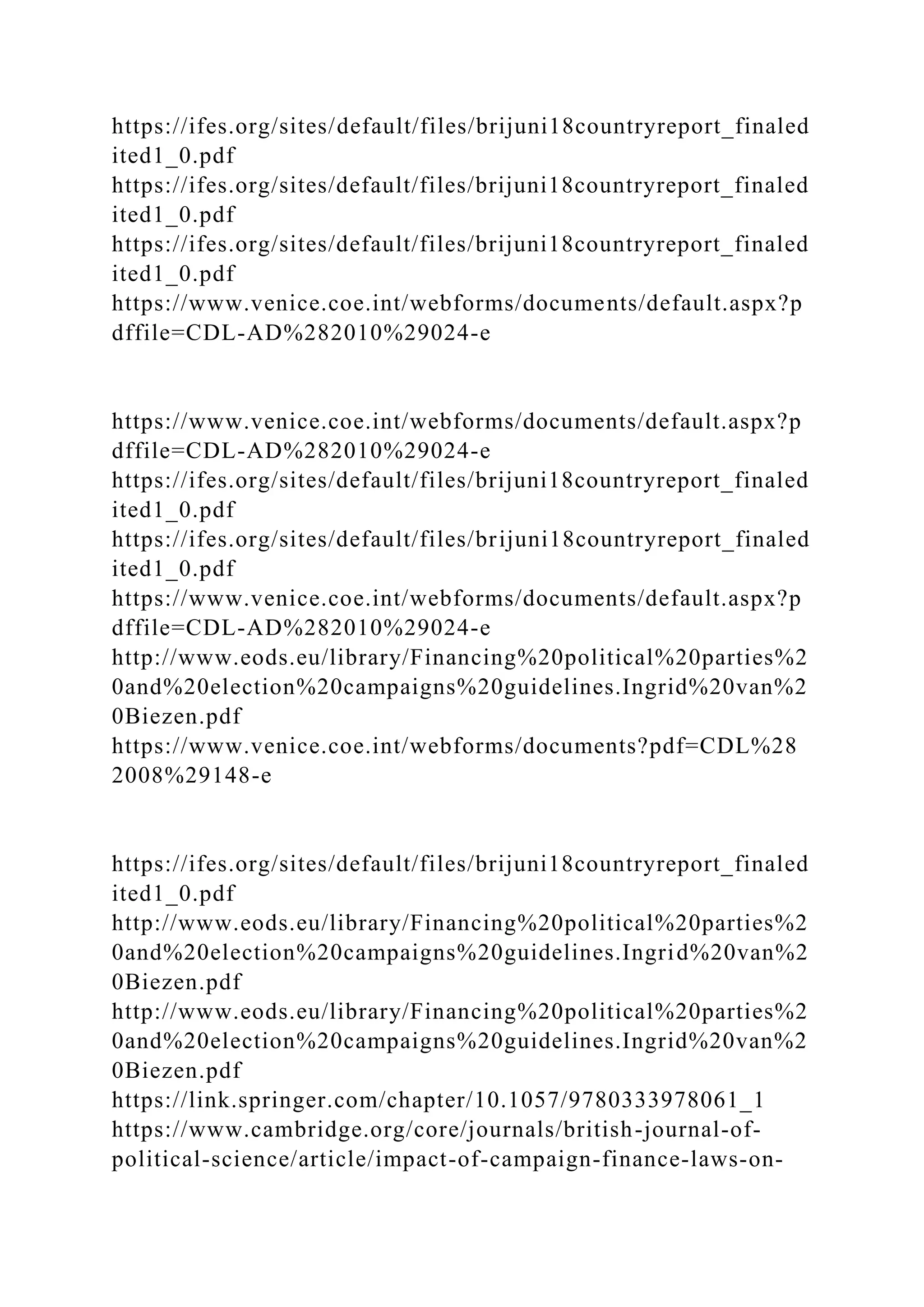




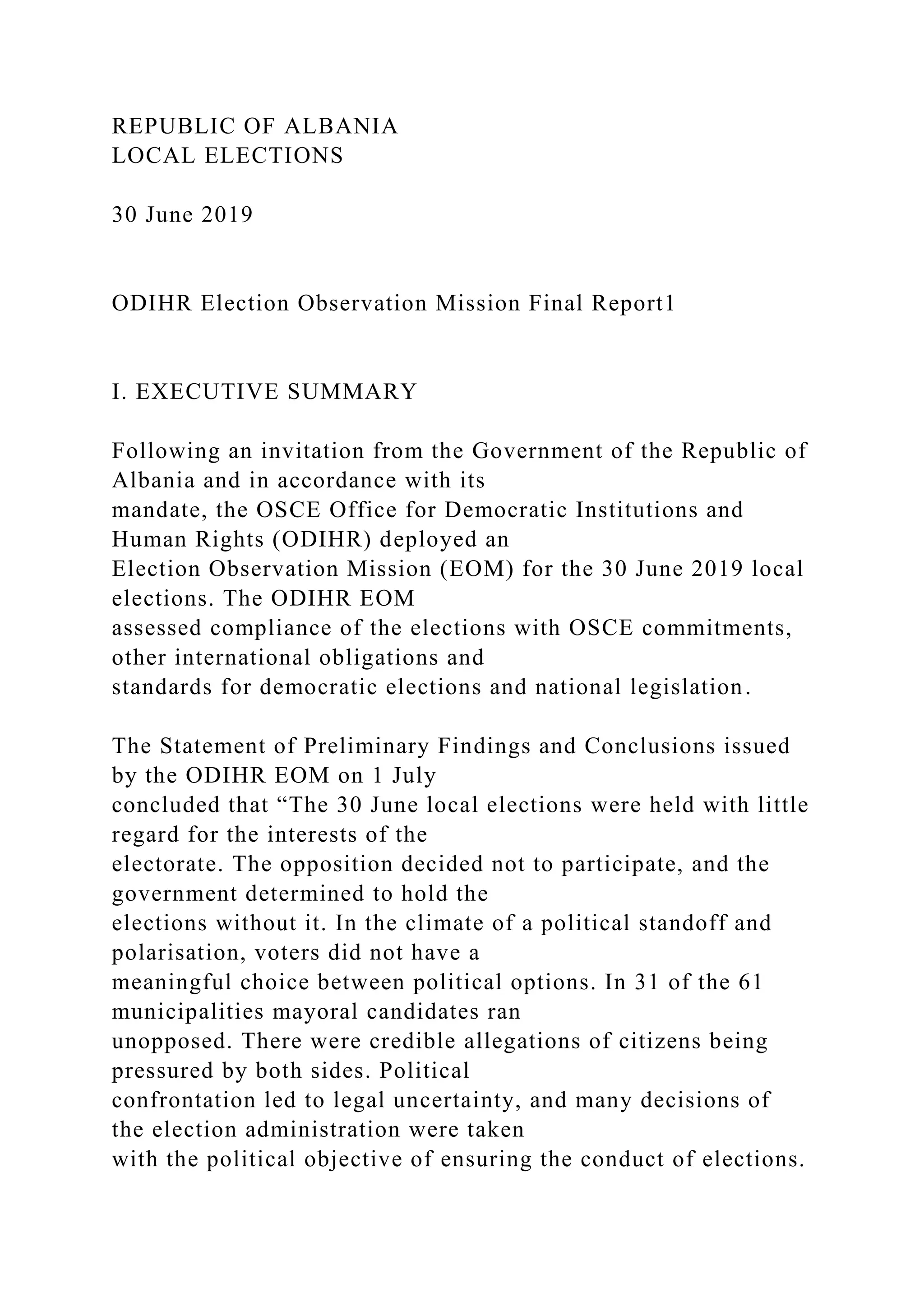







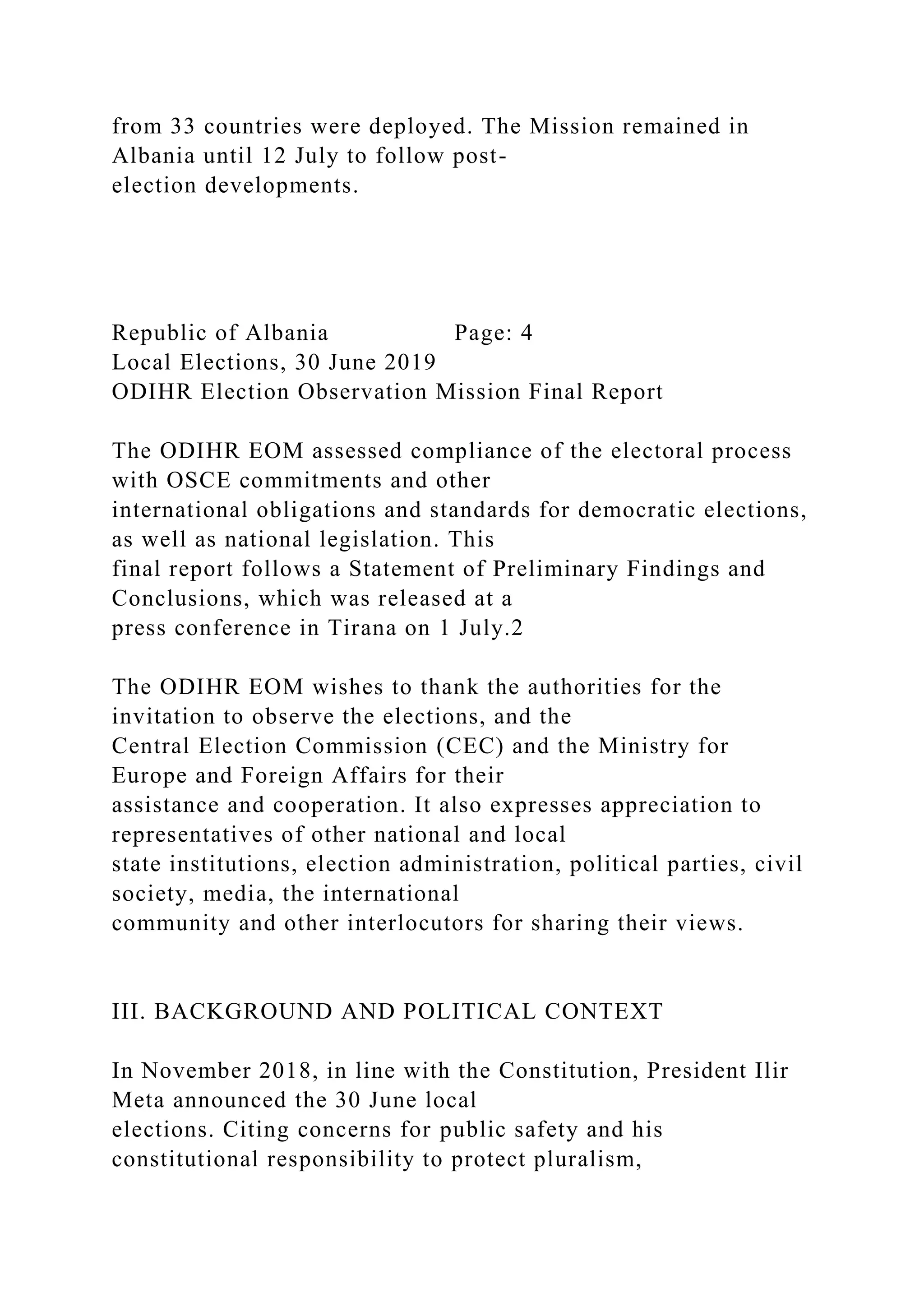

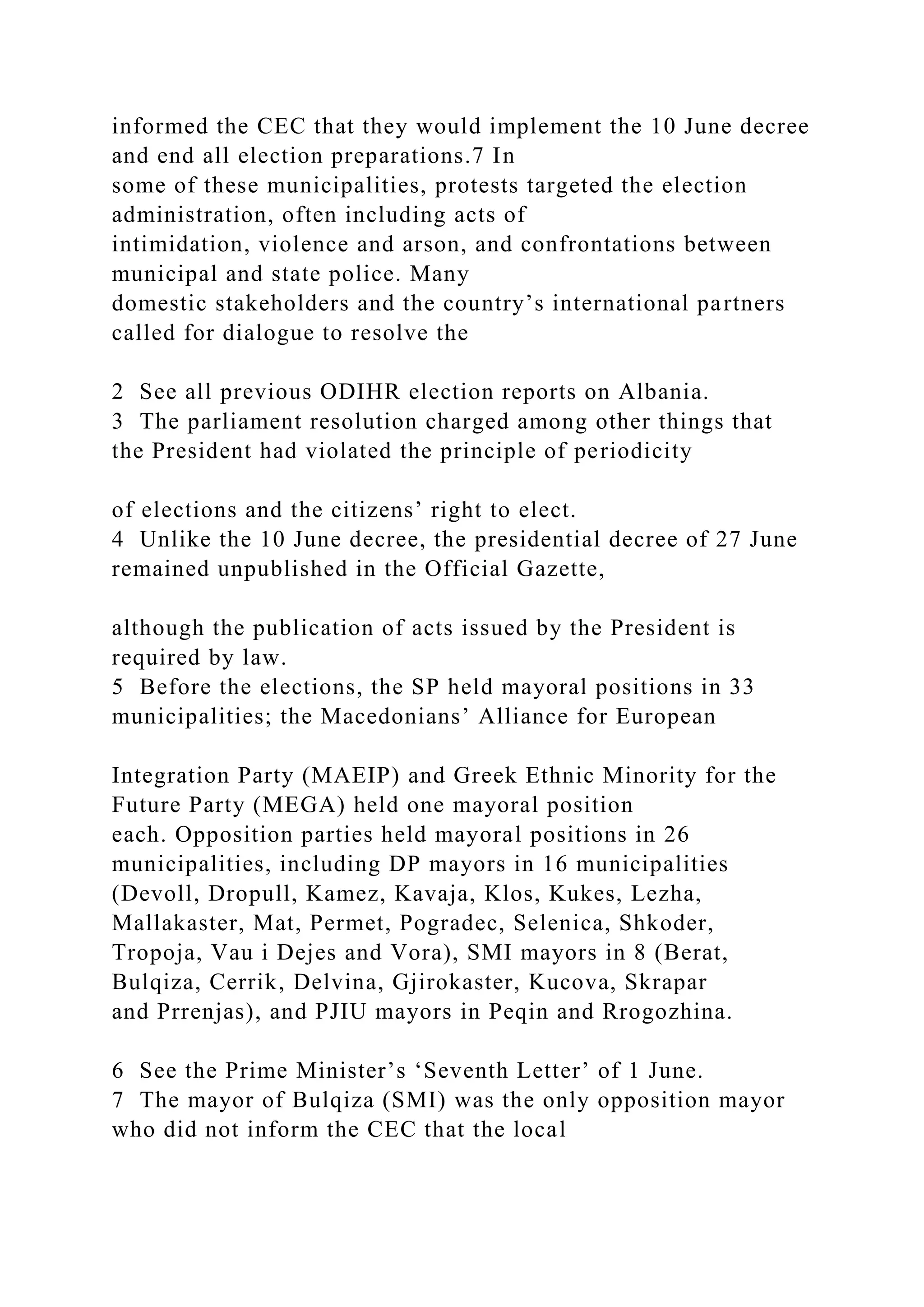

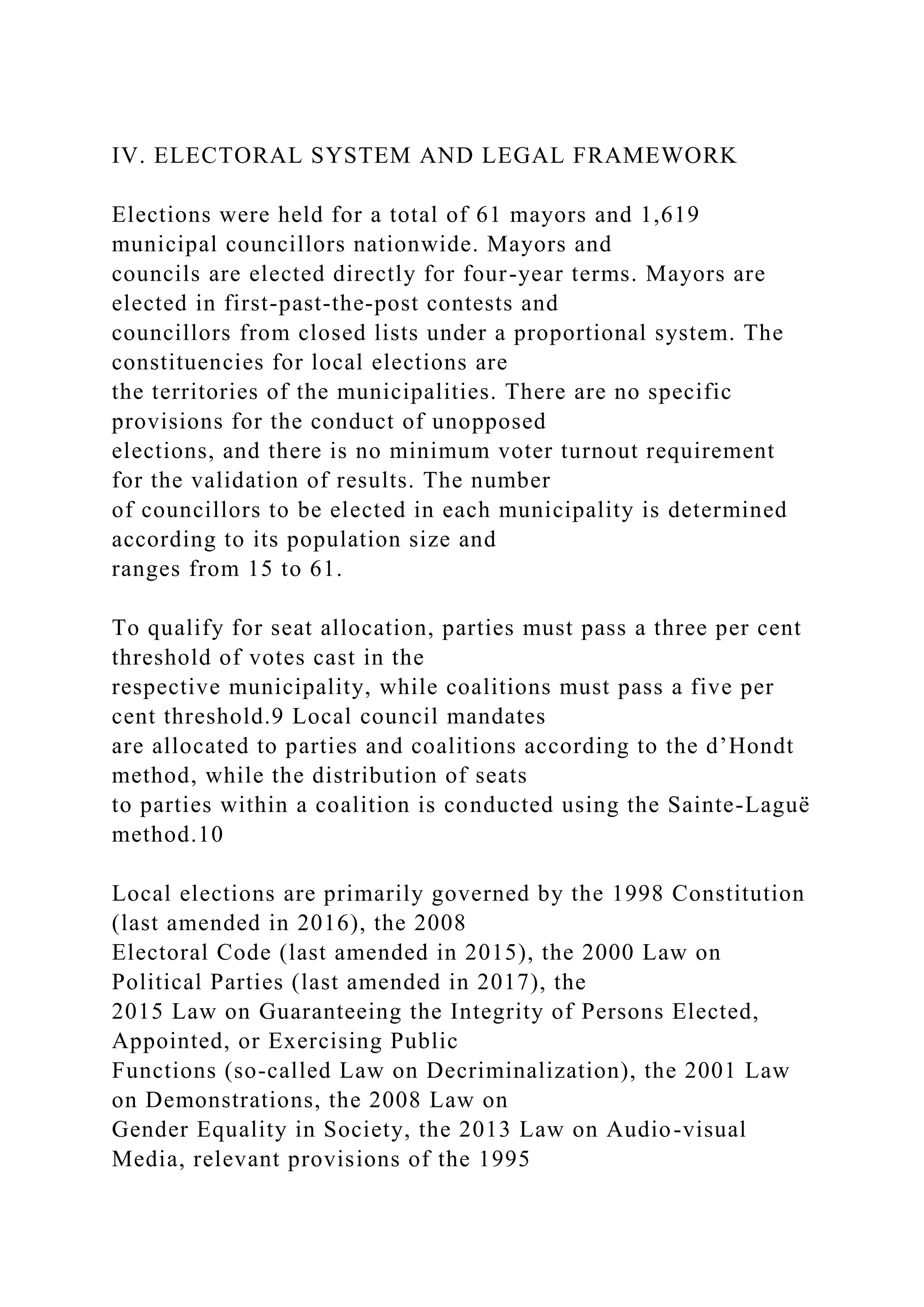


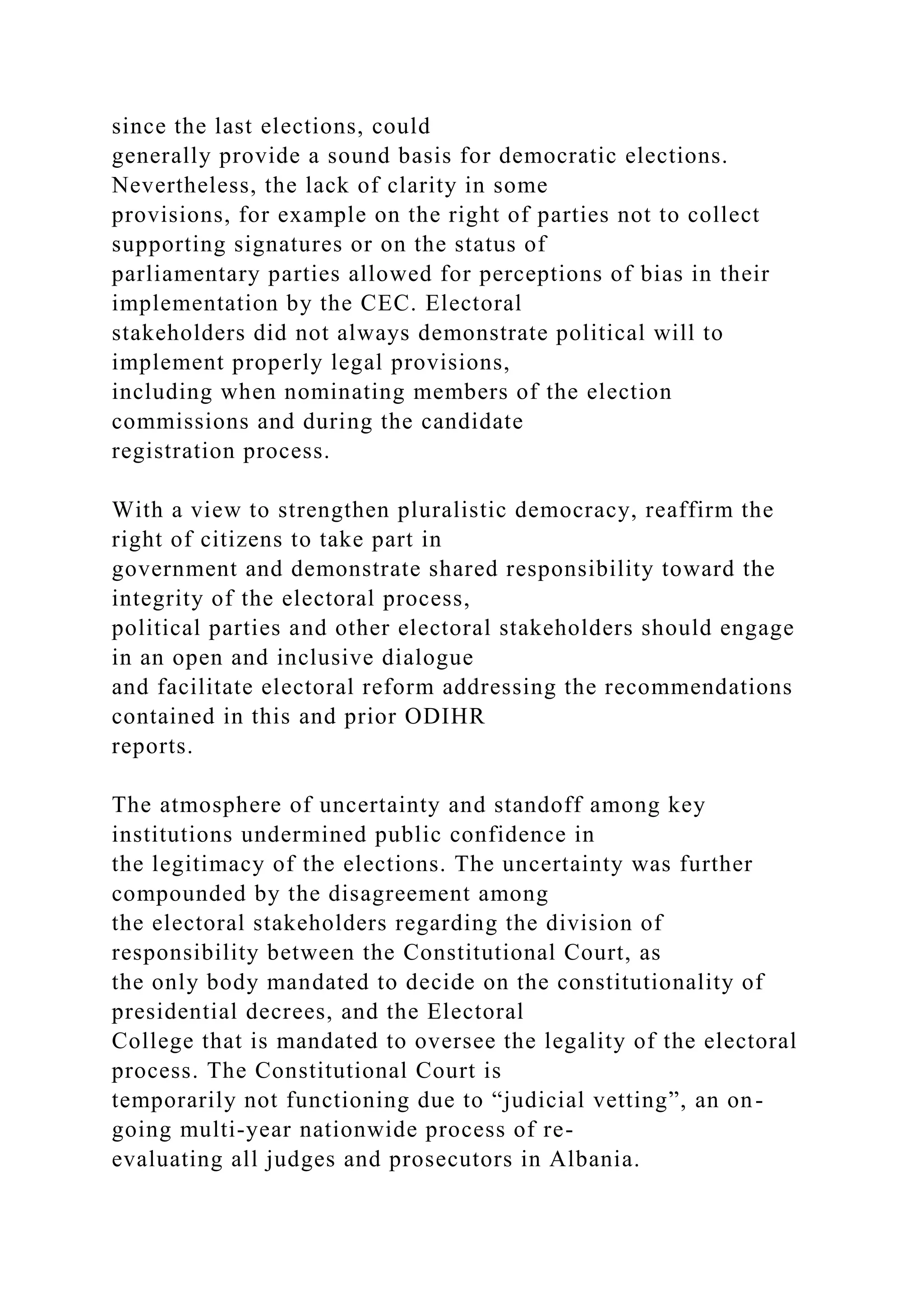





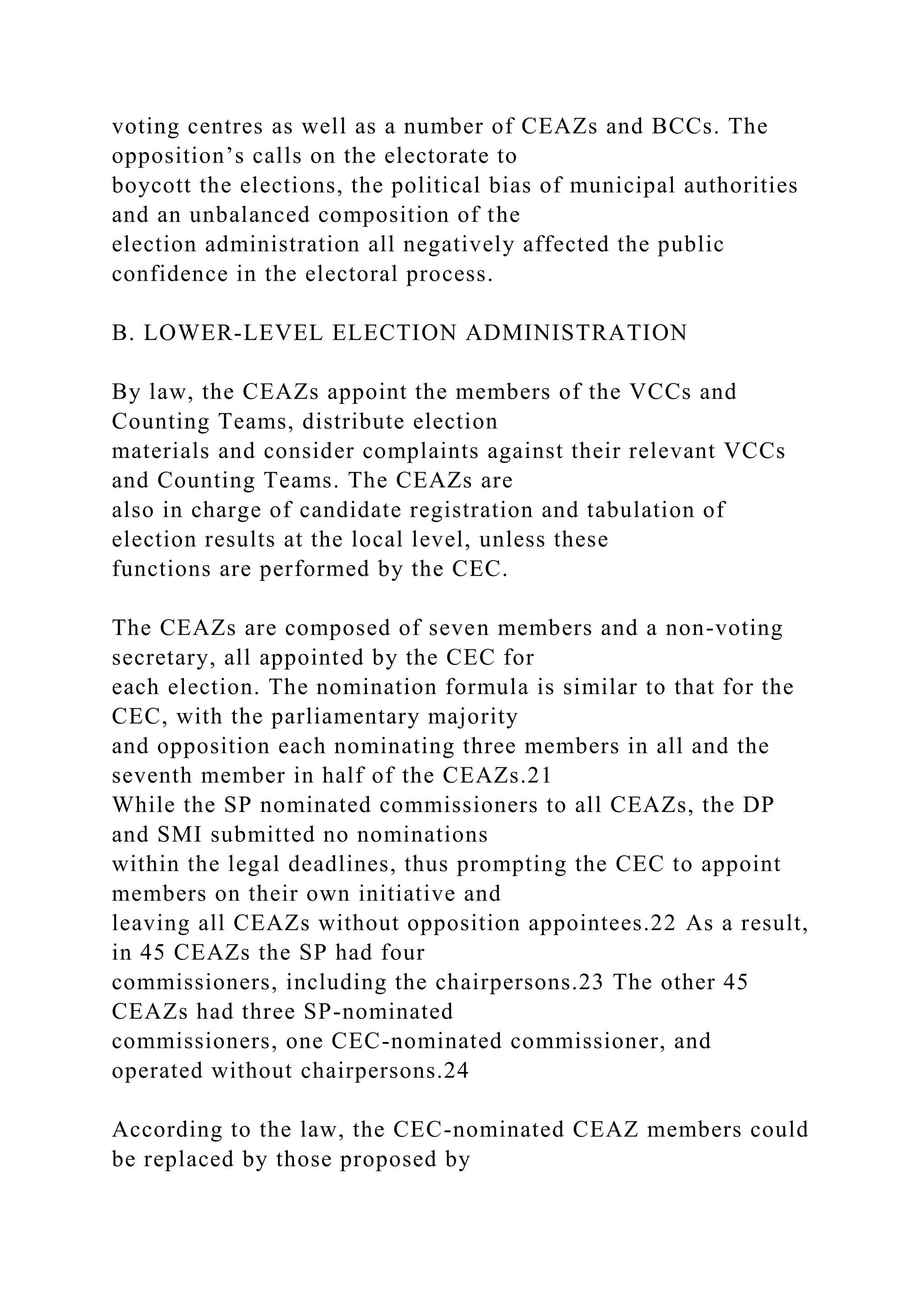




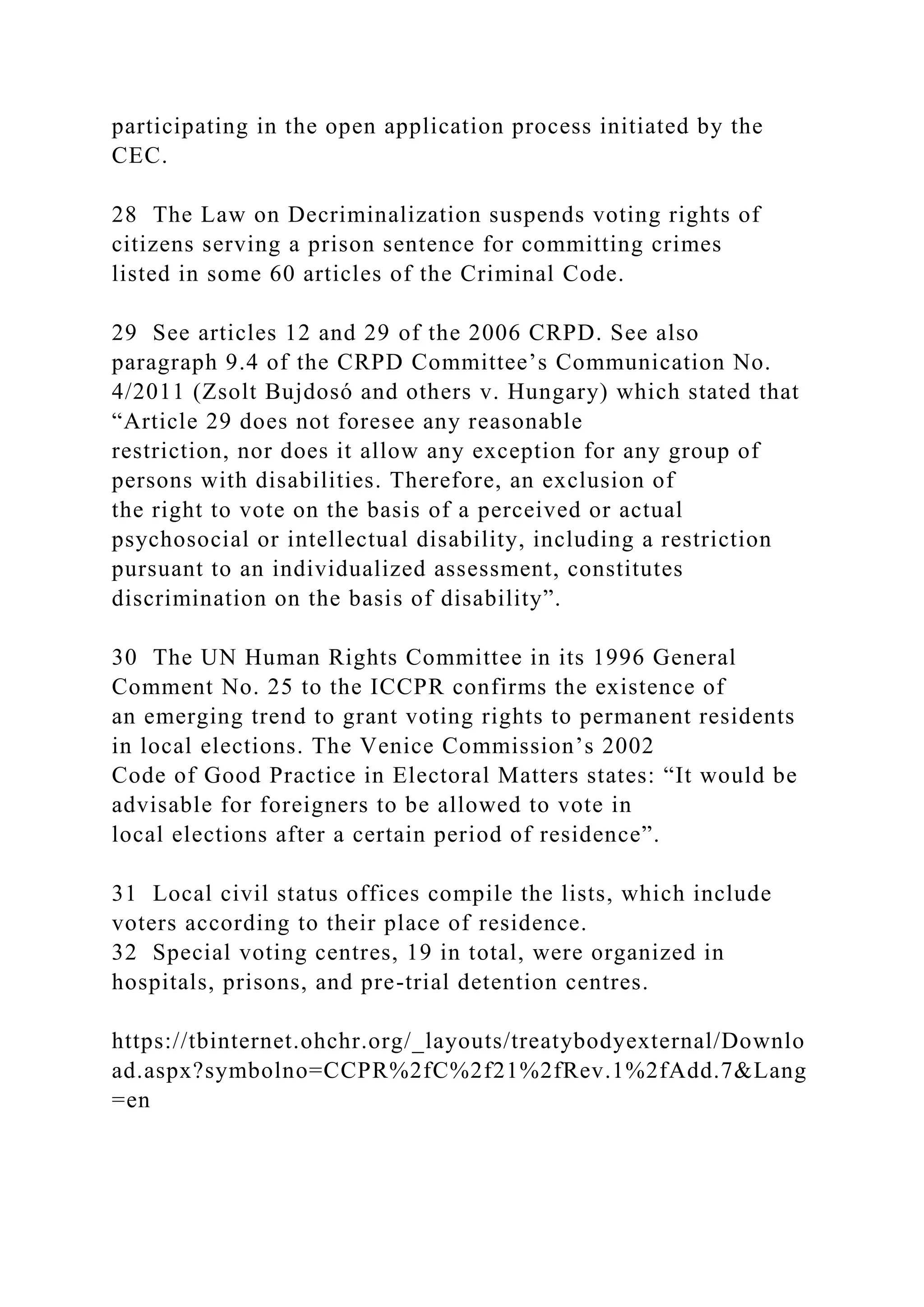
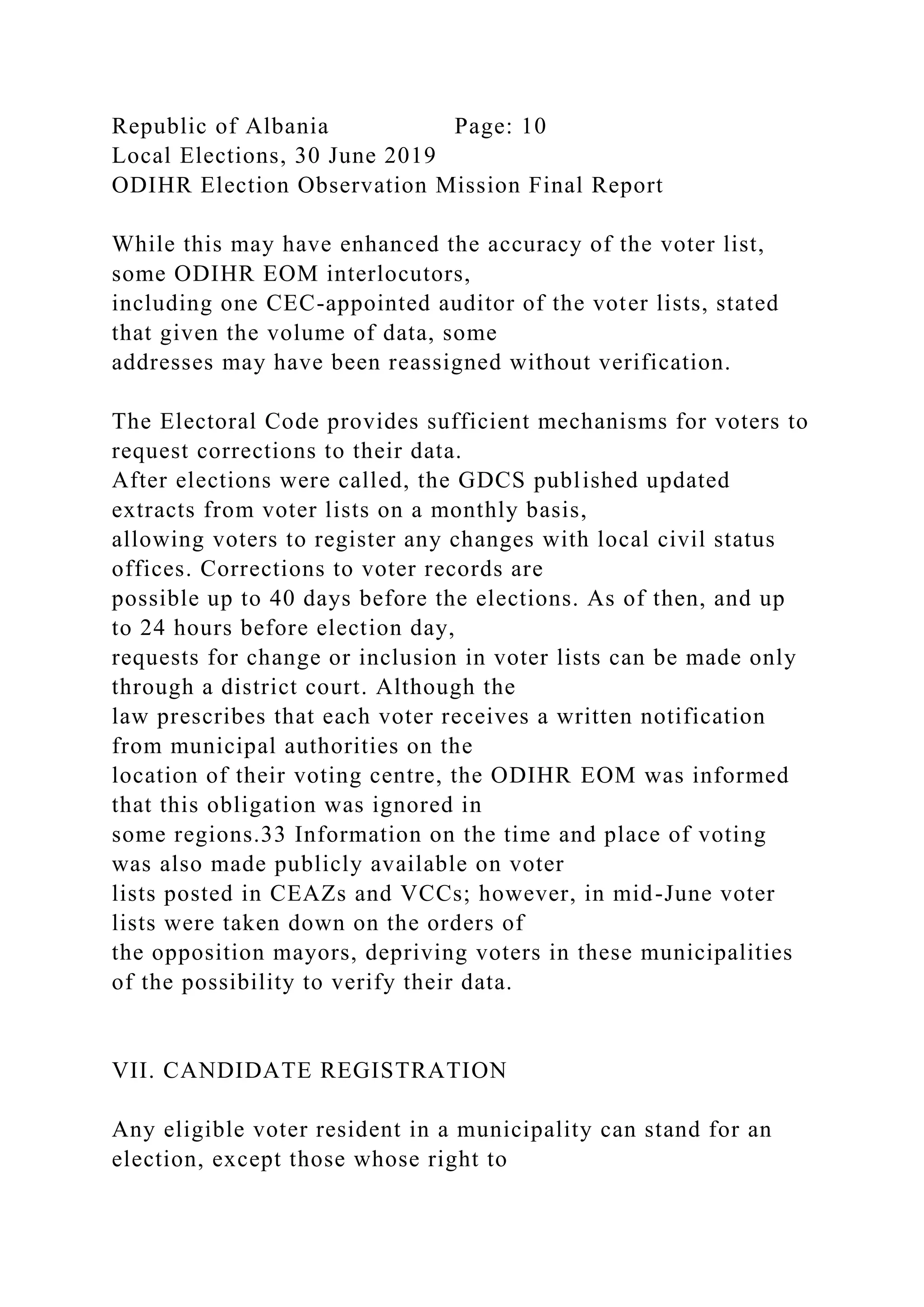

![34 This includes citizens convicted of certain crimes or
deported, even in the absence of a final court decision, from
an EU member state, Australia, Canada and the United States,
as well as those under an international warrant.
35 This includes the president, high state officials, judges,
prosecutors, military, national security and police staff,
diplomats and members of election commissions.
36 In 2013 and 2015, the CEC rejected the registrations of
Civil Party of Albania and Shkoder 2015 Party that did
not provide final court decisions on their registrations as
political parties.
37 The Electoral Code does not specify how the period of six-
months tenure in parliament, council or mayor post
should be calculated, which facilitated the CEC’s circumventing
of this requirement. The CEC registered the DCP
as a parliamentary party on the basis of certificates issued by
parliament that defined the six-month period
backwards from the anticipated expiry of mandates of two DCP-
affiliated MPs in 2021. The ECtHR requires
eligibility conditions “to comply with a number of criteria
framed to prevent arbitrary decisions. […t]he
discretion enjoyed by the body concerned must not be
exorbitantly wide; it must be circumscribed, with sufficient
precision, by the provisions of domestic law”. See Podkolzina
v. Latvia case (application no. 46726/99, 6 July
2002), paragraph 35.
http://hudoc.echr.coe.int/eng?i=001-60417
Republic of Albania Page: 11
Local Elections, 30 June 2019](https://image.slidesharecdn.com/httpsifes-221015083553-d170a478/75/httpsifes-orgsitesdefaultfilesbrijuni18countryreport_fi-docx-36-2048.jpg)
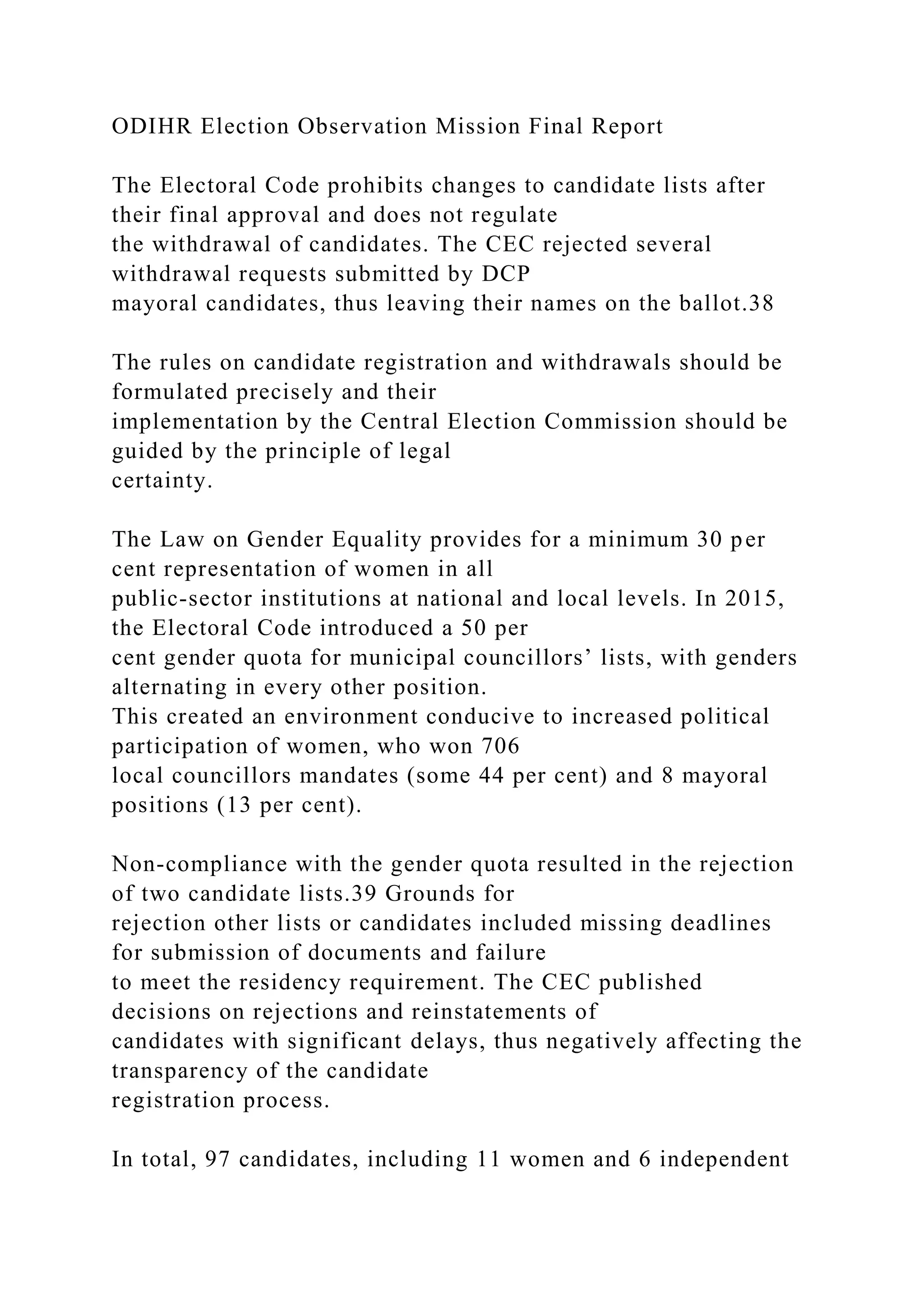
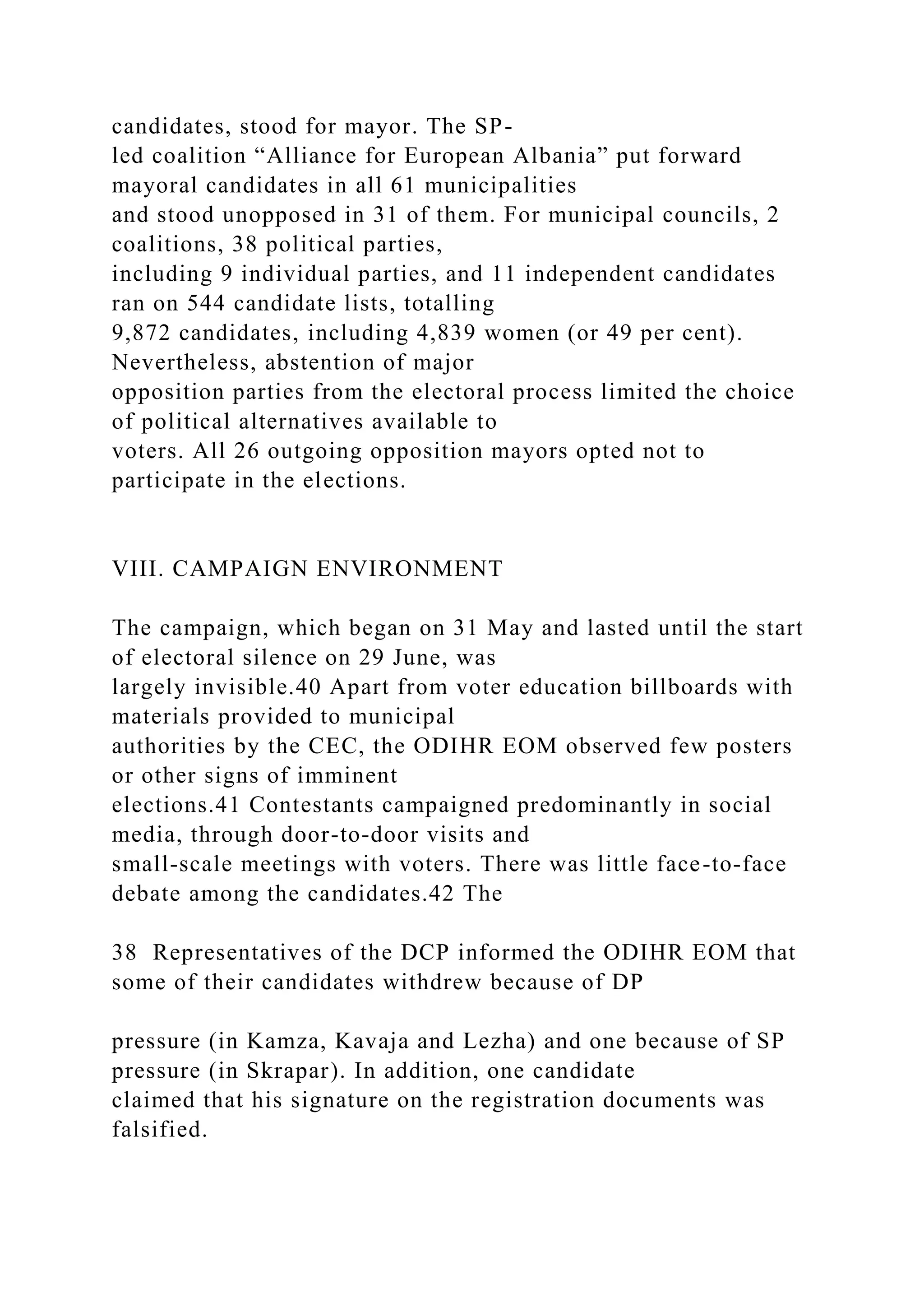
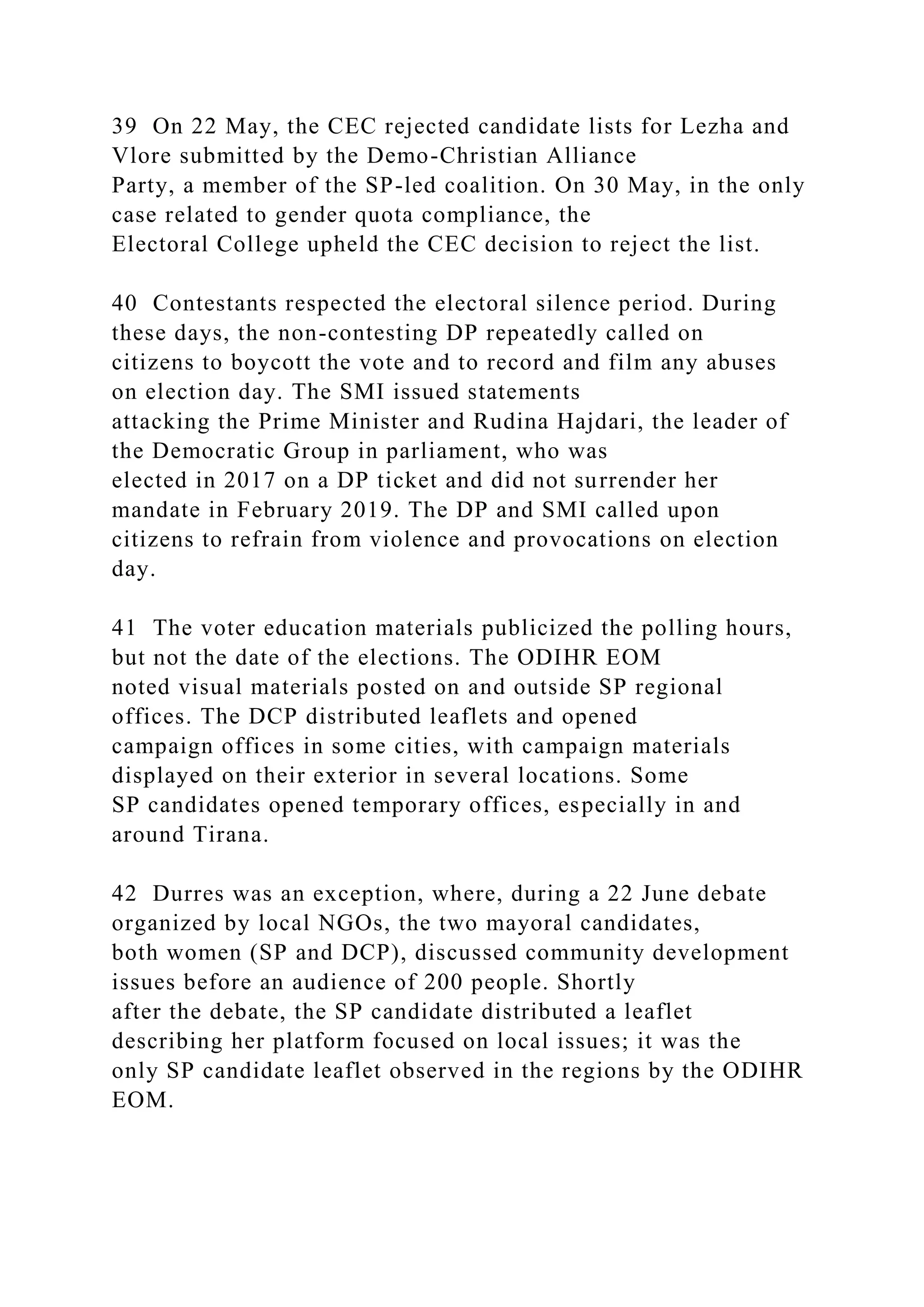


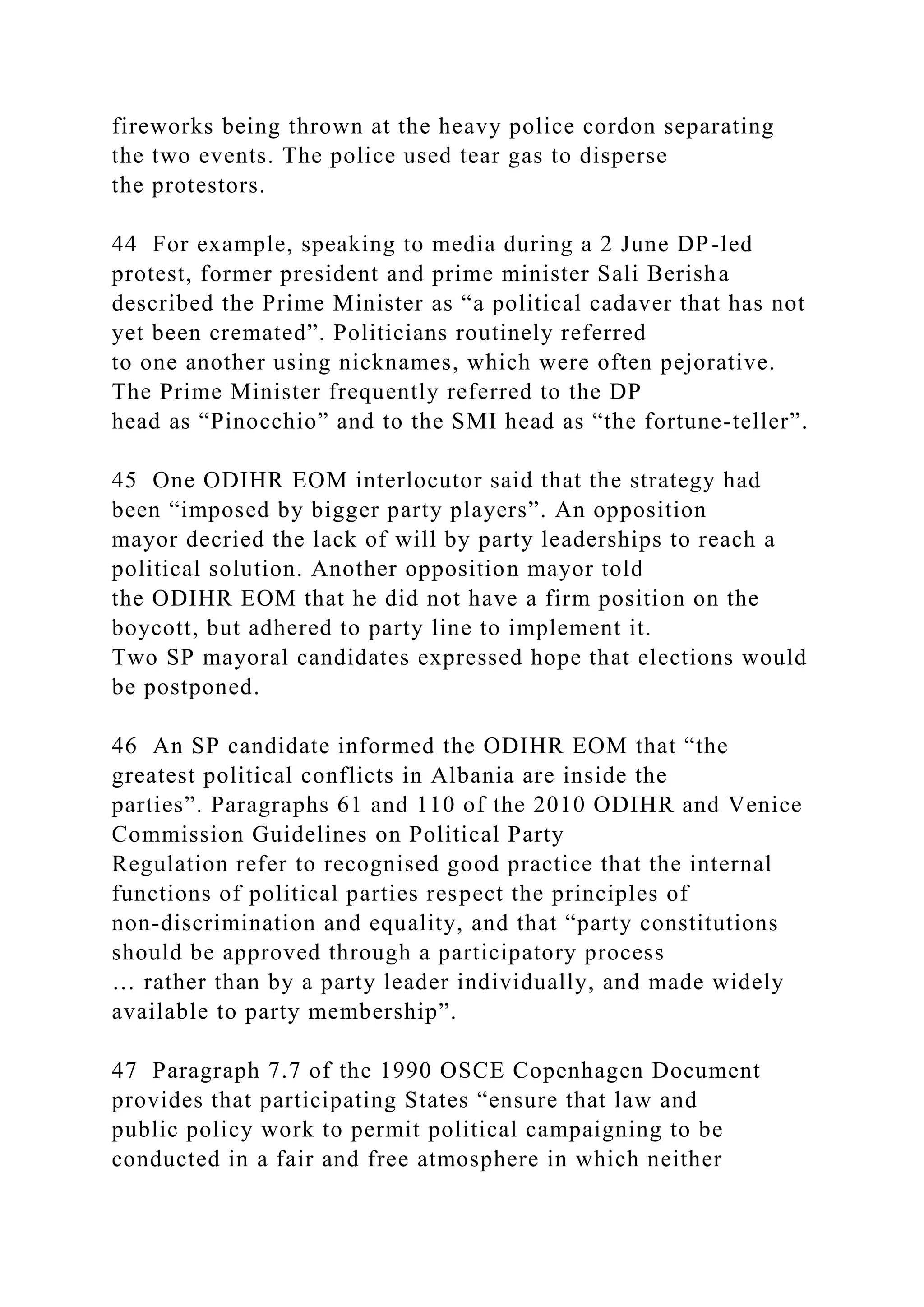





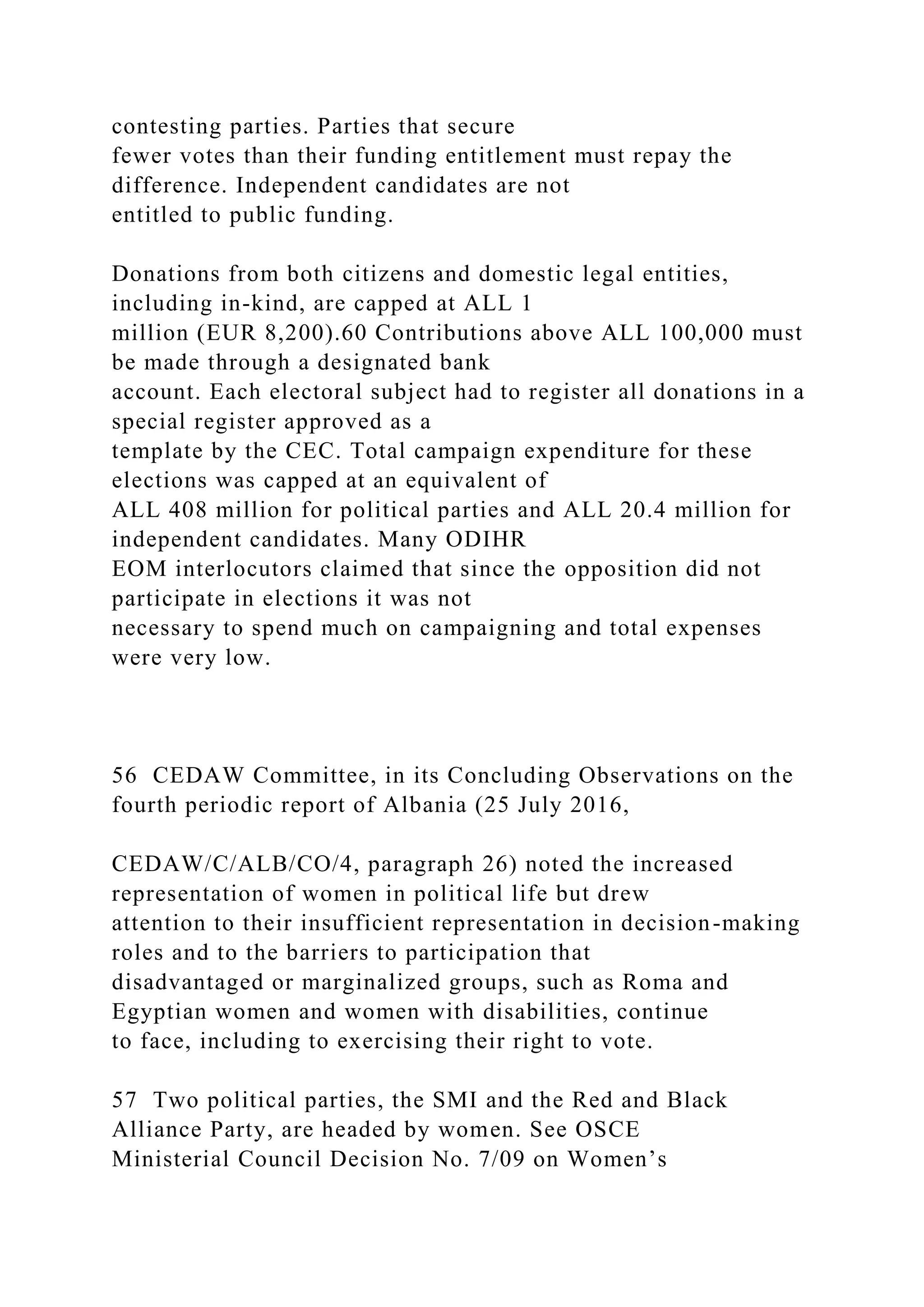




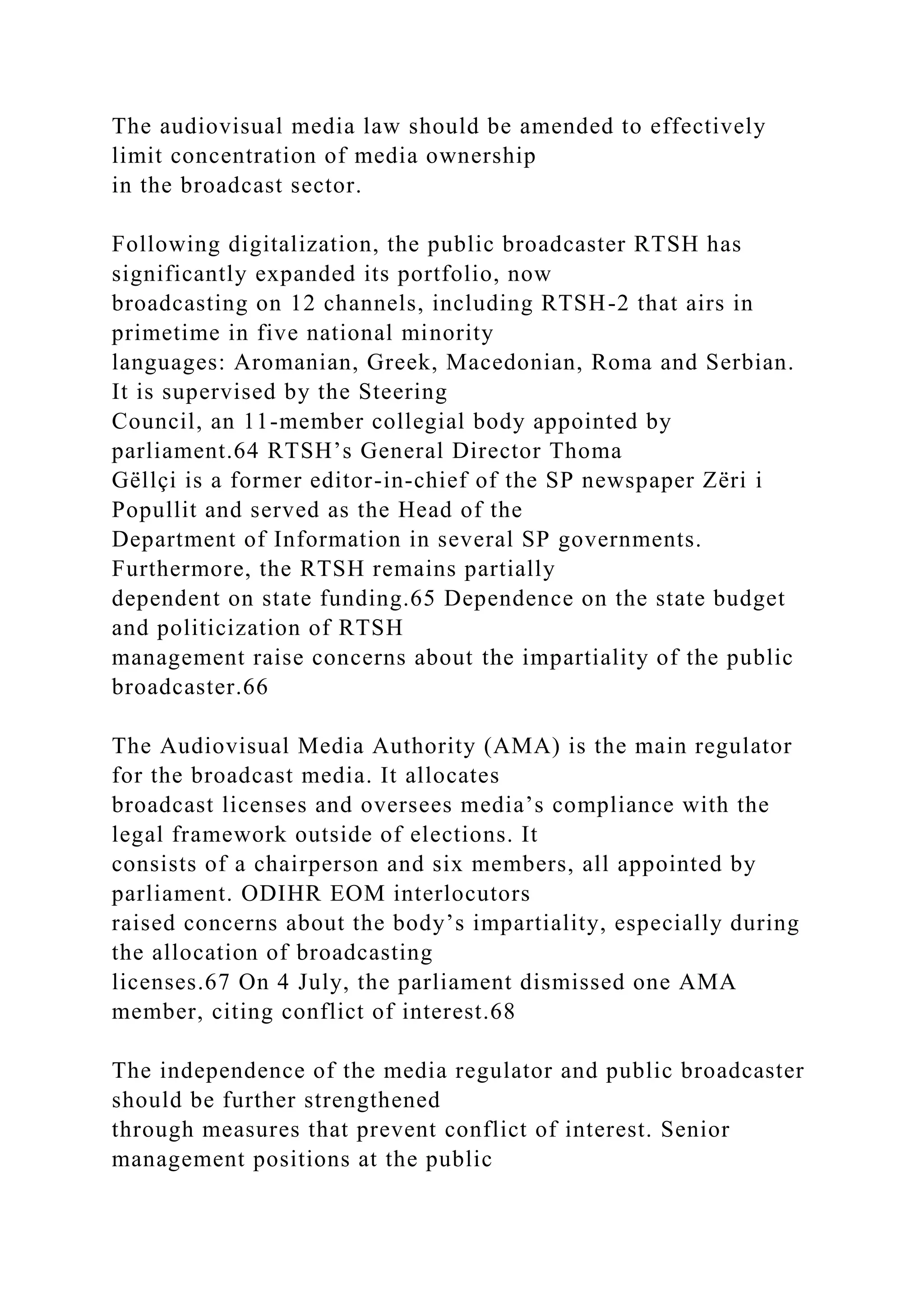
![broadcaster should not be accessible to people with clear
political affiliation.
B. LEGAL FRAMEWORK
The Constitution and legislation provide for freedom of
expression and prohibit censorship. Contrary
to previous ODIHR recommendations, defamation remains a
criminal offense, punishable with fines
up to ALL 3 million. Moreover, the proposed amendments to the
Law on Audiovisual Media and the
Law on Electronic Communications, approved and released for
public scrutiny by the government on
62 The OSCE Representative on the Freedom of the Media
(RFOM) concluded that the amendments “could in the
long term very negatively impact media plurality and therefore
media freedom in Albania”. The 2009 Declaration
of UN Special Rapporteur on Freedom of Opinion and
Expression (RFOE) and the OSCE RFOM calls states to
“put in place a range of measures, including […] rules to
prevent undue concentration of media ownership”.
63 According to the National Business Centre, the Hoxha
family owns 100 per cent of Top Channel and some 51 per
cent of DigitAlb. The latter owns 100 per cent of ADTN. Each
company holds one national license. Article 62.4
of the Law on Audio-Visual Media prohibits any physical or
legal person who owns a national license from
owning more than 20 per cent of a company that holds another
national license.
64 Six members are nominated by the ruling majority and five
by the opposition.
65 According to the RTSH, during 2018 some 30 per cent of its](https://image.slidesharecdn.com/httpsifes-221015083553-d170a478/75/httpsifes-orgsitesdefaultfilesbrijuni18countryreport_fi-docx-54-2048.jpg)

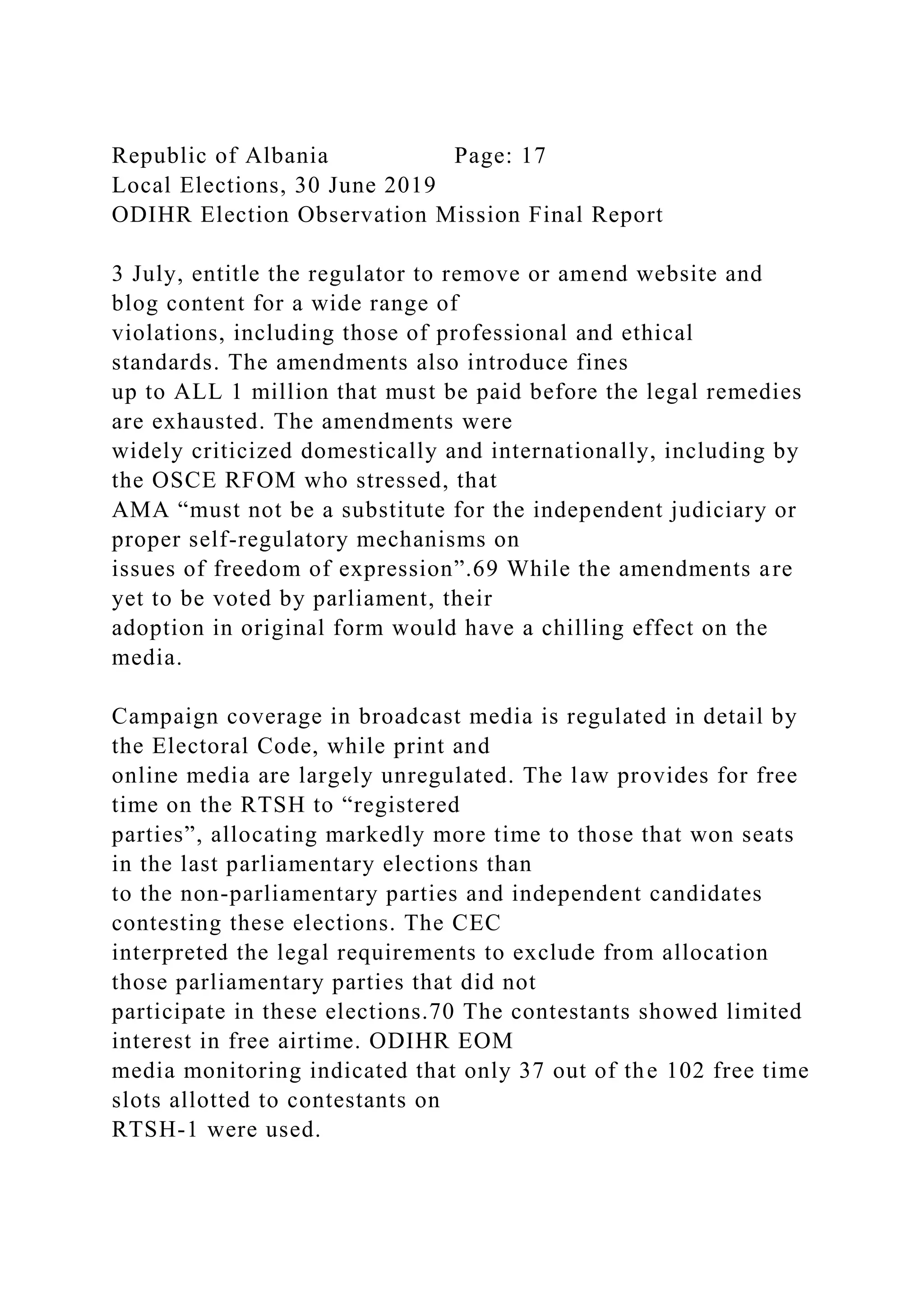
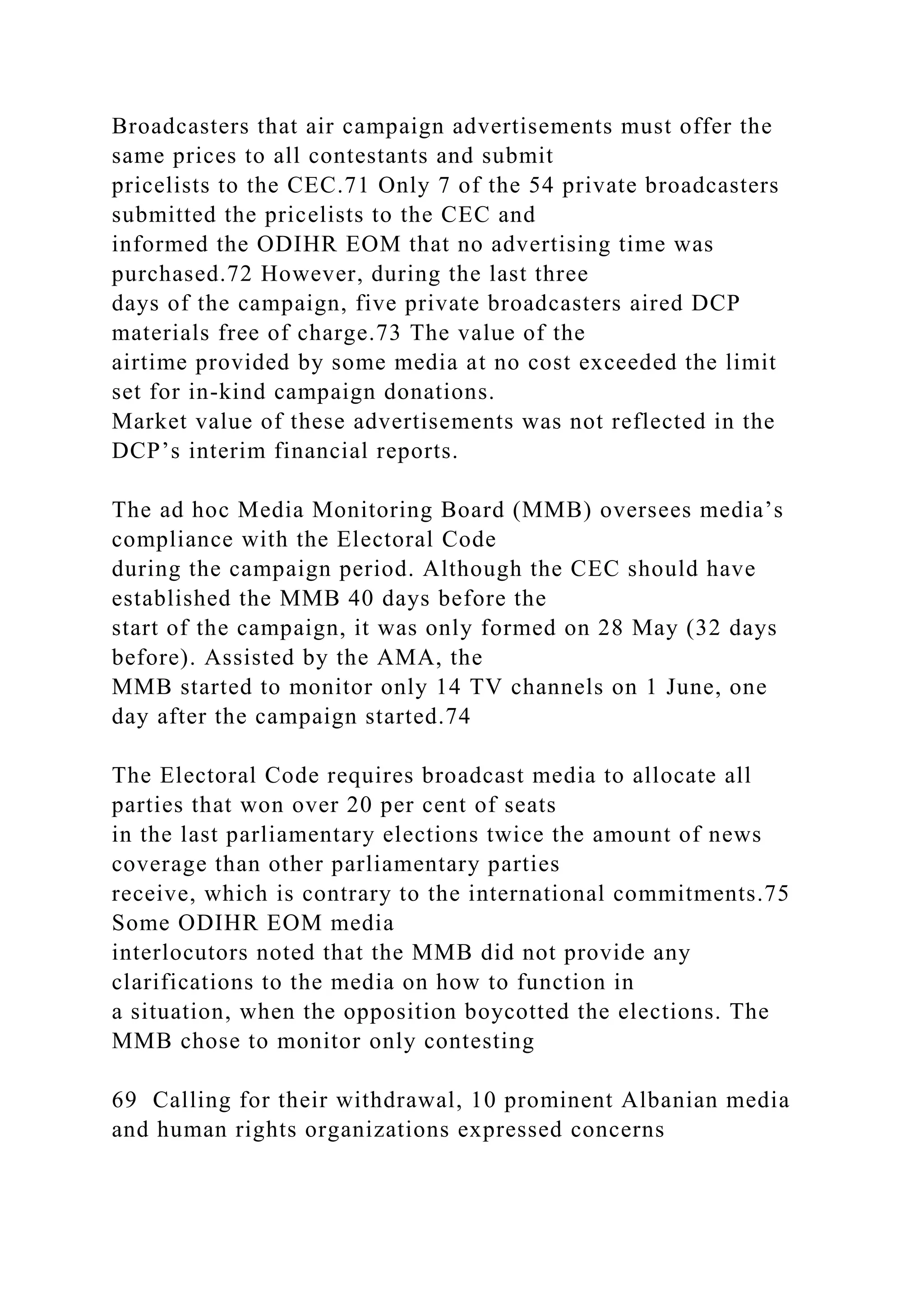
![that the amendments could “increase [the level] of censorship
and self-censorship in the local media and could
contribute to further setbacks on media freedom and freedom of
expression in Albania”. On 15 August, the
President issued a statement expressing his concerns over the
government-proposed anti-defamation draft law.
See also the statement and the legal review of the OSCE RFOM.
70 On 30 May, the CEC provided the SP with 60 minutes, SDY
with 30 minutes, all other non-parliamentary parties
contesting the elections with 10 minutes and independent
candidates with 5 minutes of free airtime on the RTSH.
71 The Electoral Code limits the amount of paid airtime for
each private broadcaster for the campaign to 90 minutes
for parliamentary and 10 minutes for non-parliamentary parties
and independent candidates. The 2007 Council of
Europe’s Committee of Ministers Recommendation
CM/Rec(2007)15 recommends to all participating states that
their “regulatory frameworks […] ensure that all contending
parties have the possibility of buying advertising
space on and according to equal conditions and rates of
payment”.
72 In these pricelists, most media outlets also offered pay-for
space in news and current affairs programmes.
73 Some media outlets informed the ODIHR EOM that the free
airtime was provided to the DCP as it did not have
sufficient resources to pay for advertisements. Some of these
media did not submit pricelists to the CEC.
74 The CEC did not approve the MMB’s 3 June request to
recruit more staff to monitor a larger sample.
75 Paragraph 7.8 of the 1990 OSCE Copenhagen Document
requires the participating States to “Provide that no legal](https://image.slidesharecdn.com/httpsifes-221015083553-d170a478/75/httpsifes-orgsitesdefaultfilesbrijuni18countryreport_fi-docx-58-2048.jpg)


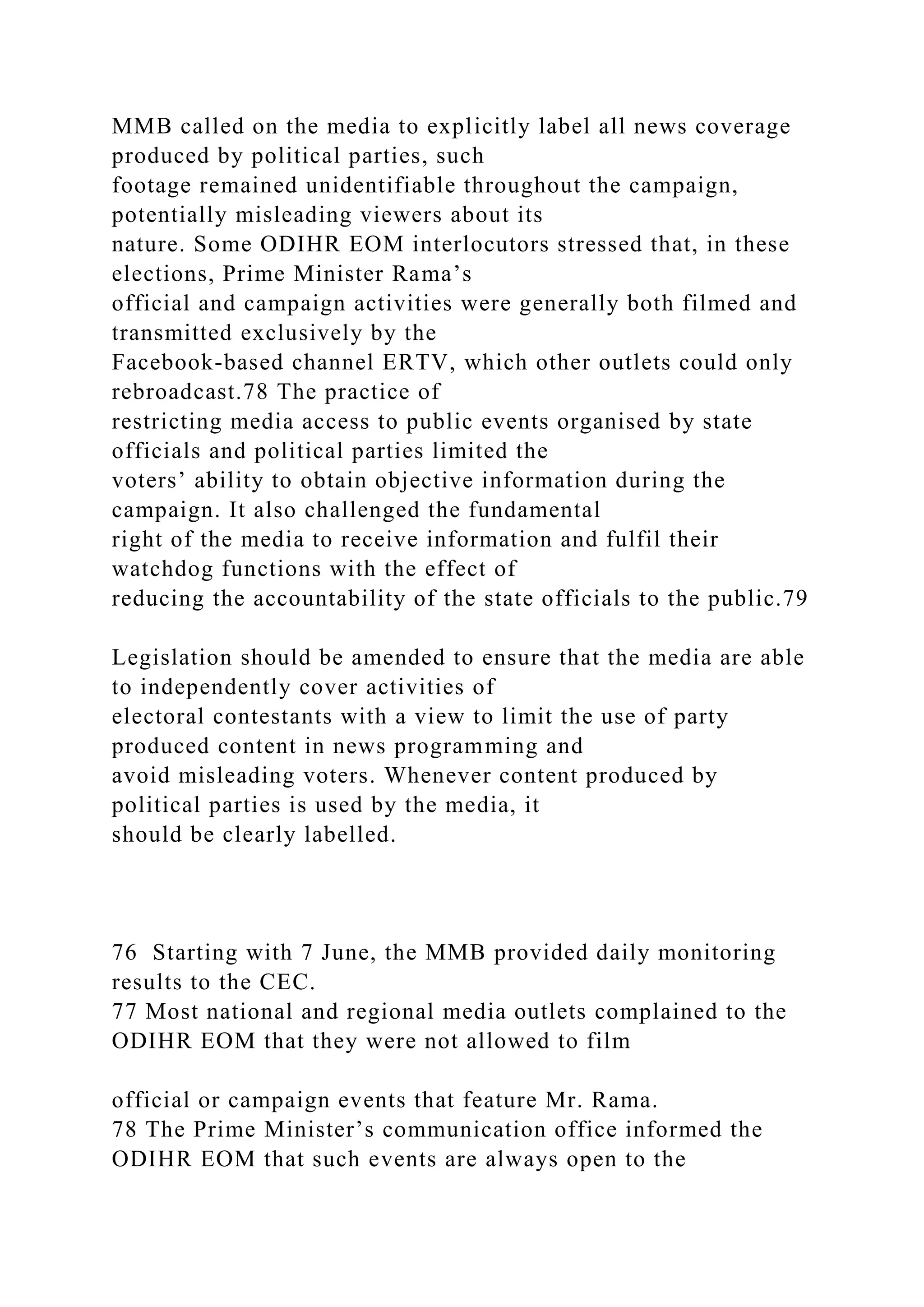
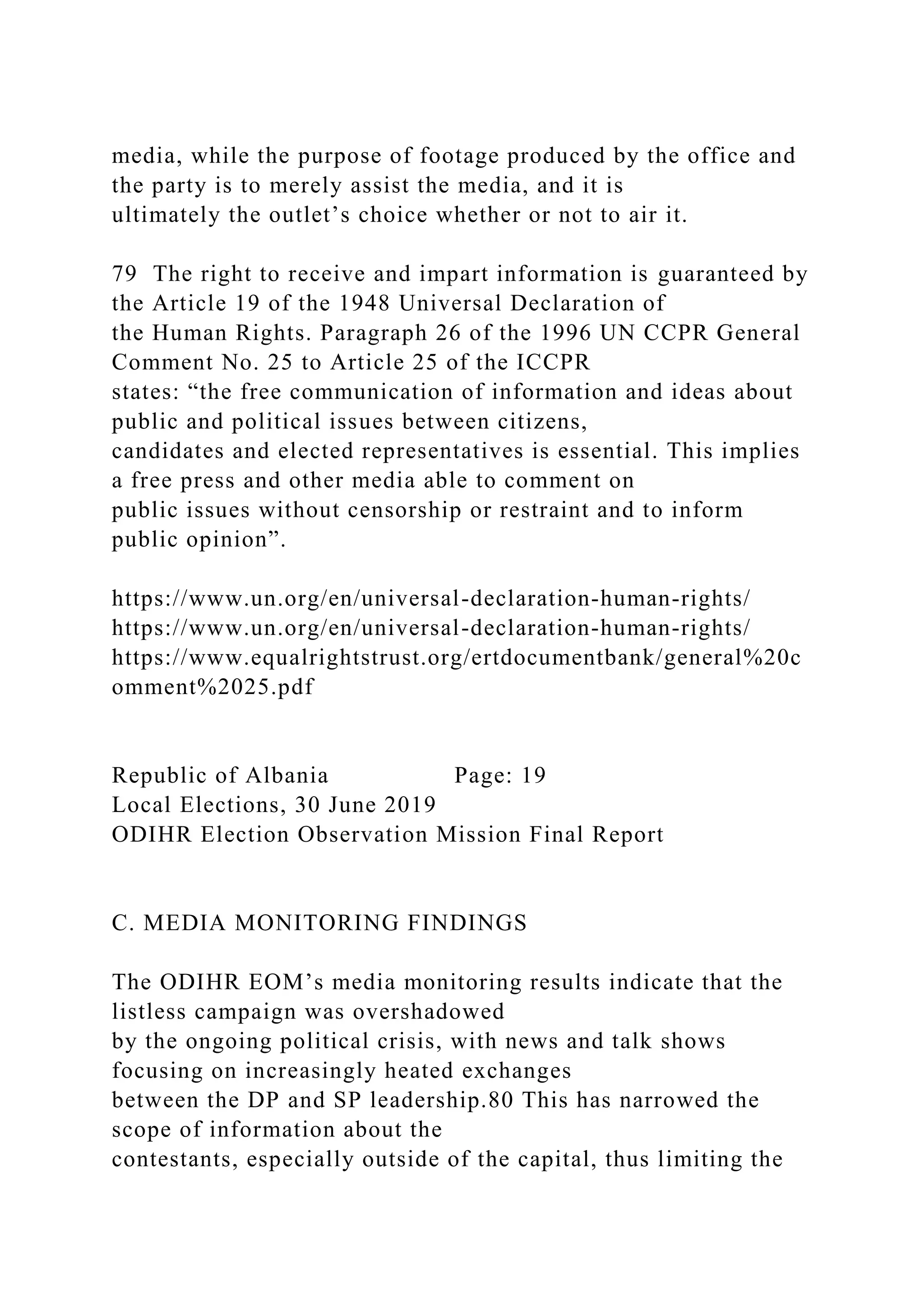



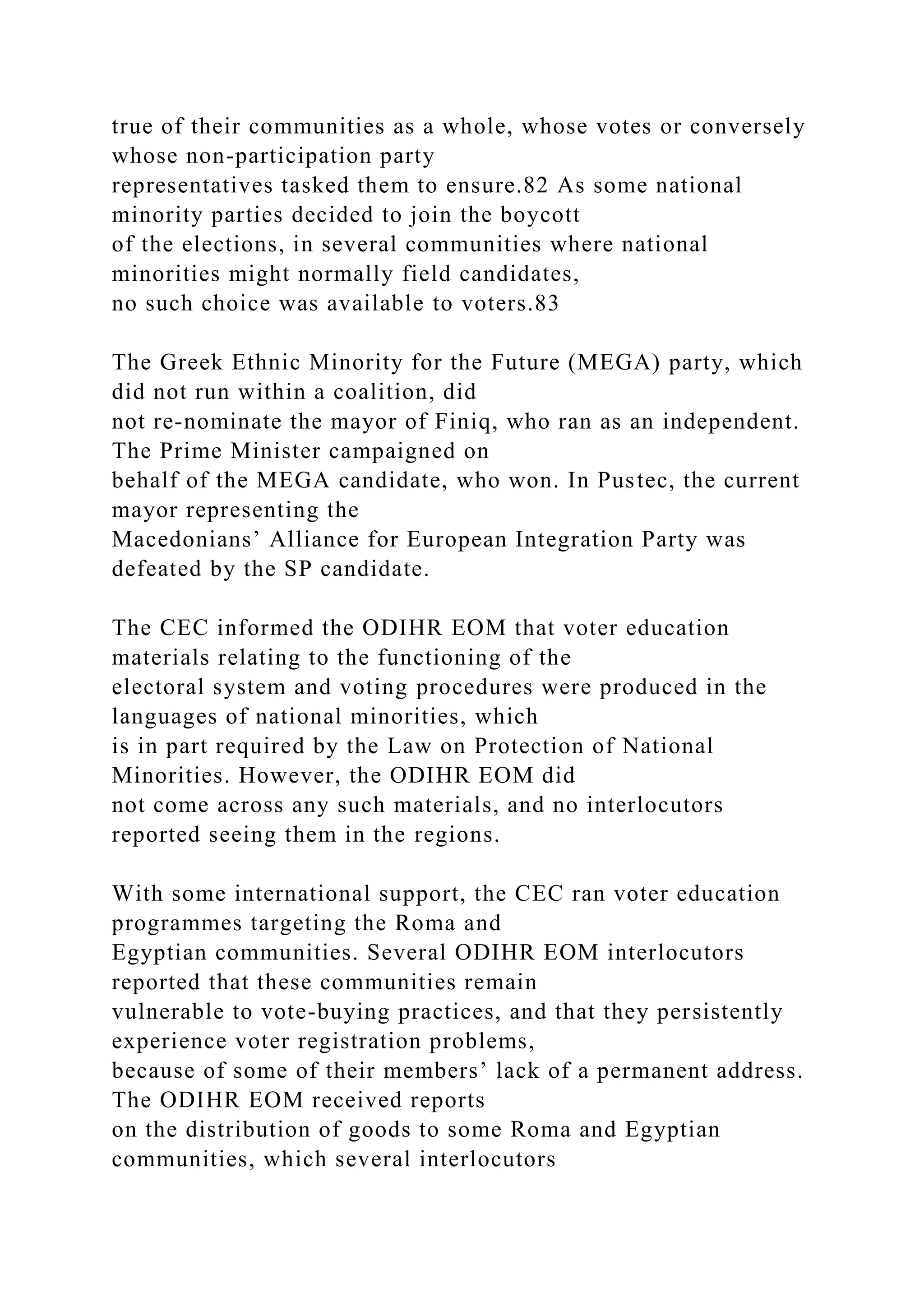
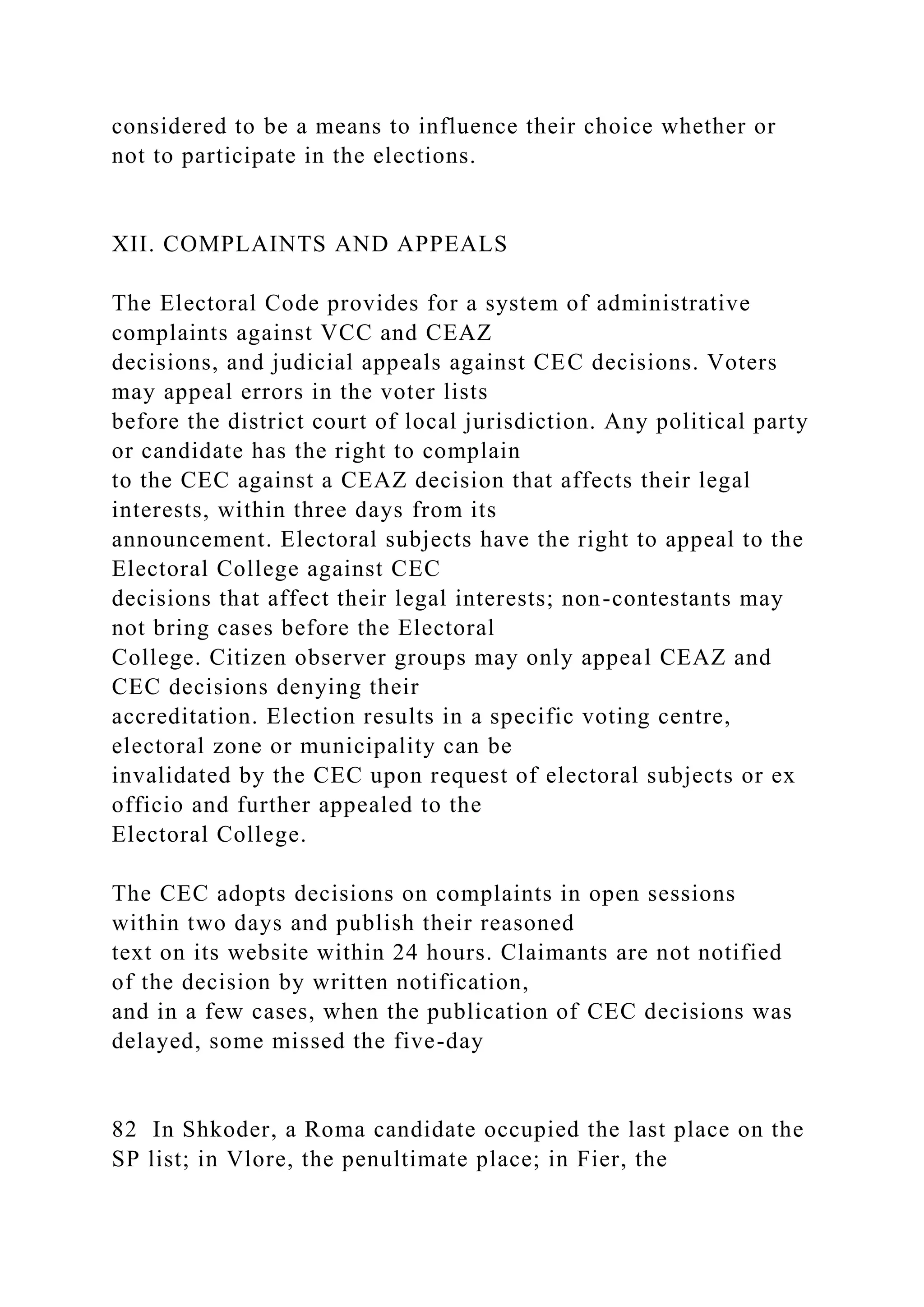


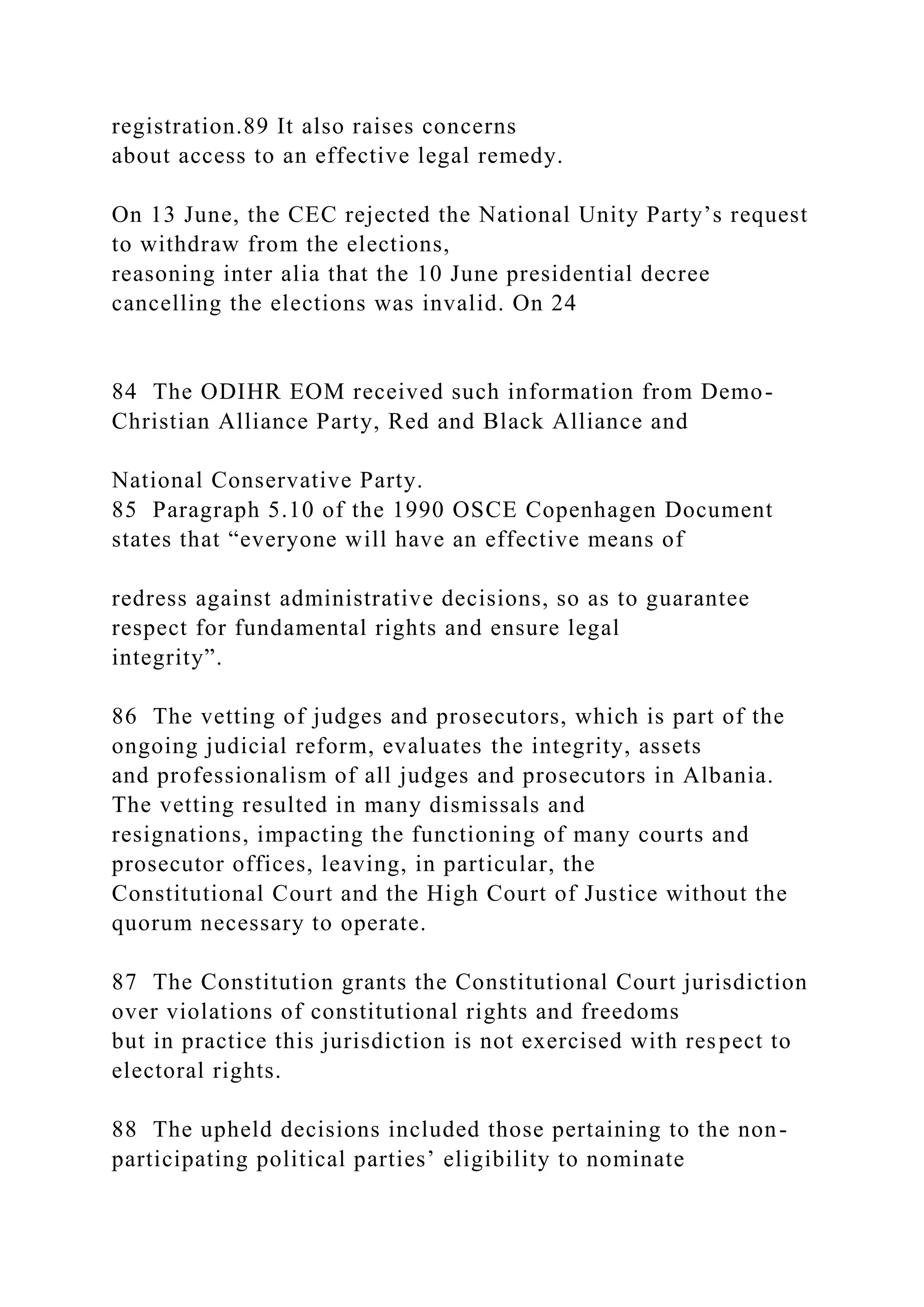
![members of election administration, political parties’ standing
in cases challenging other contestants’ registration,
candidate registration, rejection of candidate withdrawal
requests and the location of voting centres.
89 In its 9 May decision on the appeal against registration of
the DCP, the Electoral College found that the
complainant Albanian Democrat Union Party and other
contestants have no legitimate interest in challenging the
legality of registration of other contesting parties and therefore
cannot appeal relevant CEC decisions. Section
3.3.f of the 2002 Venice Commission Code of Good Practice in
Electoral Matters recommends that “All
candidates […] registered in the constituency concerned must be
entitled to appeal”.
Republic of Albania Page: 22
Local Elections, 30 June 2019
ODIHR Election Observation Mission Final Report
June, the Electoral College rejected the appeal against this CEC
decision also ruling the 10 June
presidential decree as invalid.90
Some ODIHR EOM interlocutors expressed concerns about the
CEC’s lack of impartiality, pointing
to instances in which majority of CEC members voted along
party lines.91 While the Electoral College
judges enjoy immunity and cannot be subject to disciplinary
proceedings during the entire term for
which the College is constituted, they are subject to the ongoing
“vetting process”, which could affect
the security of their tenure and thereby potentially impact their
independence.](https://image.slidesharecdn.com/httpsifes-221015083553-d170a478/75/httpsifes-orgsitesdefaultfilesbrijuni18countryreport_fi-docx-71-2048.jpg)




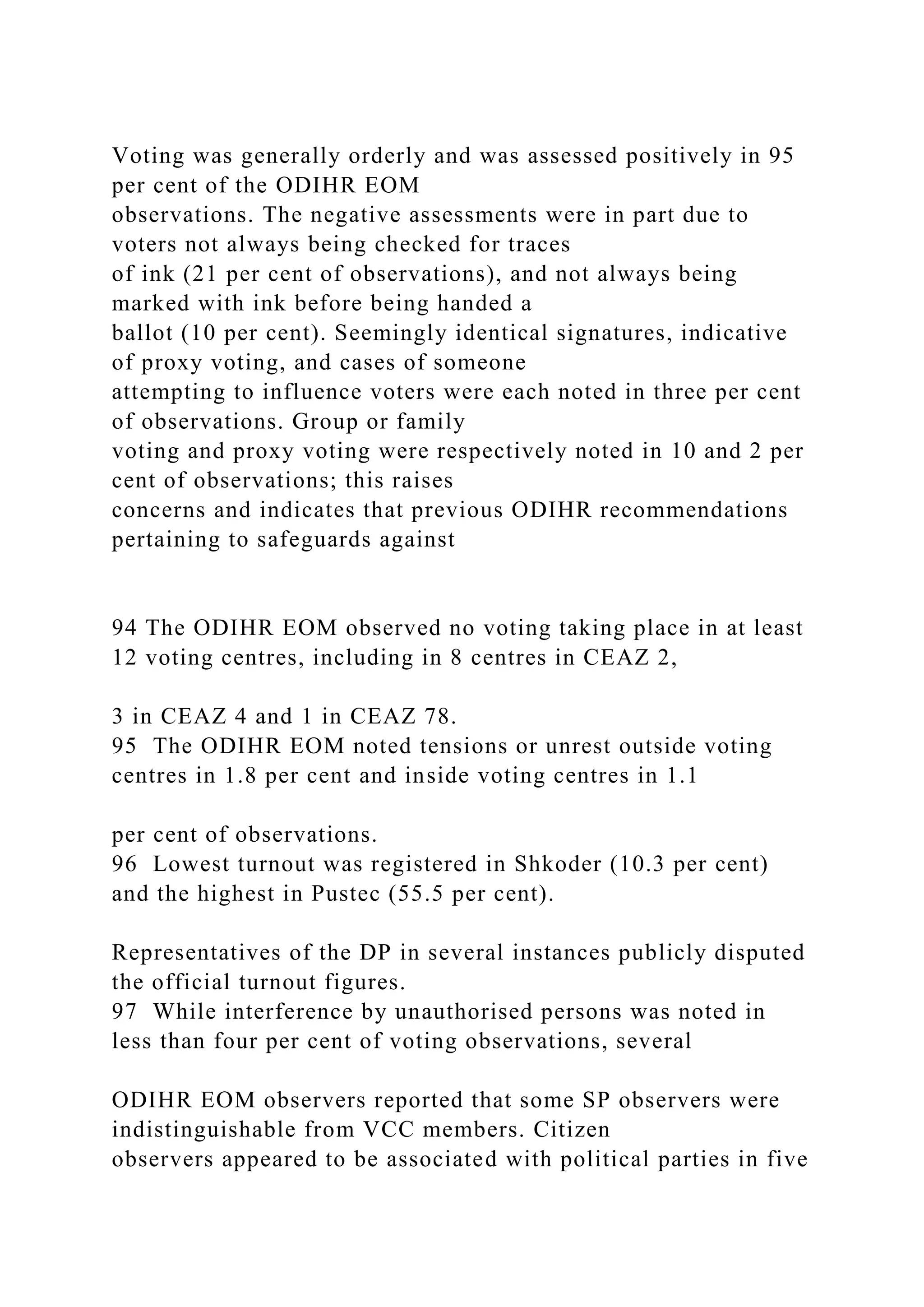



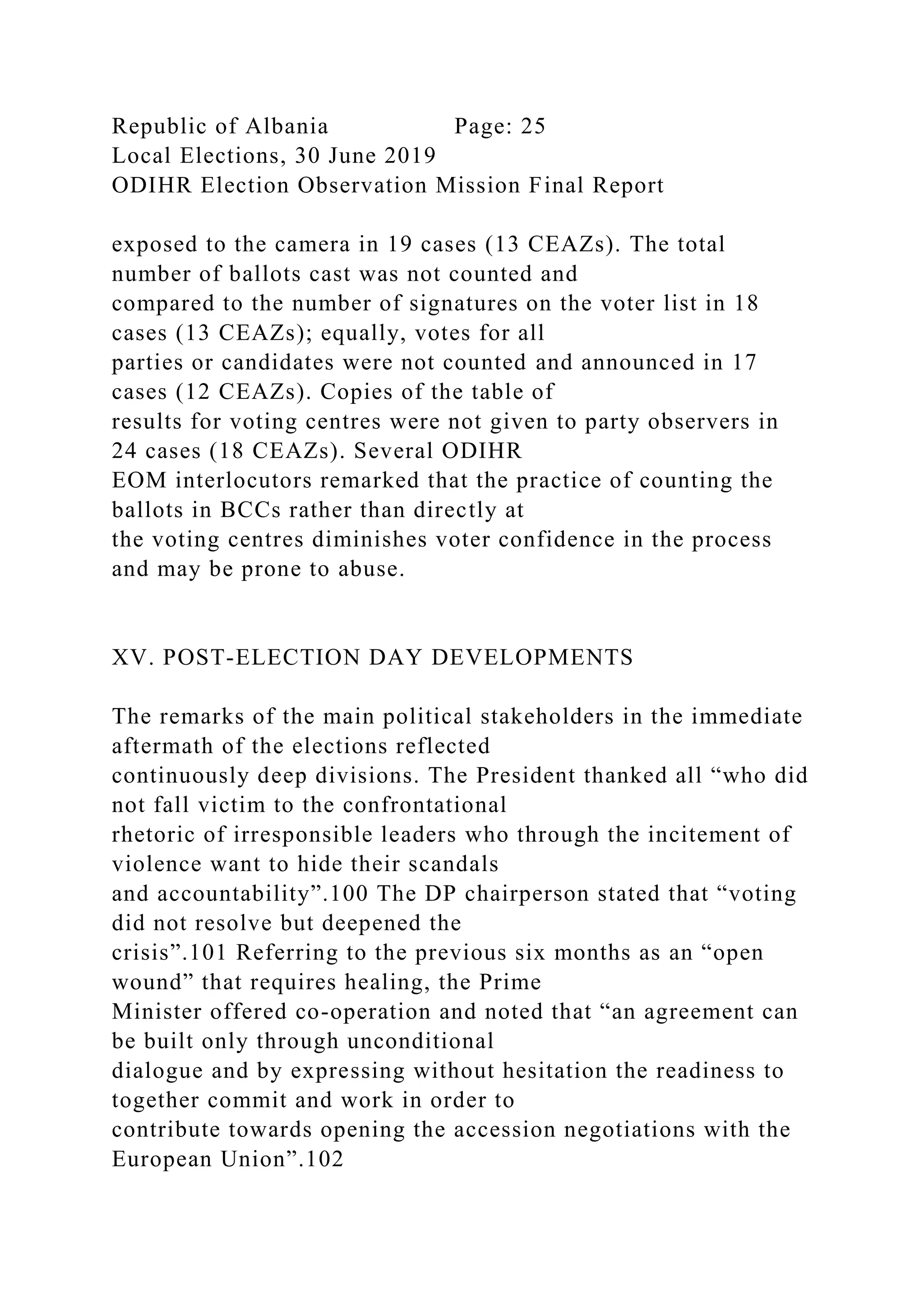

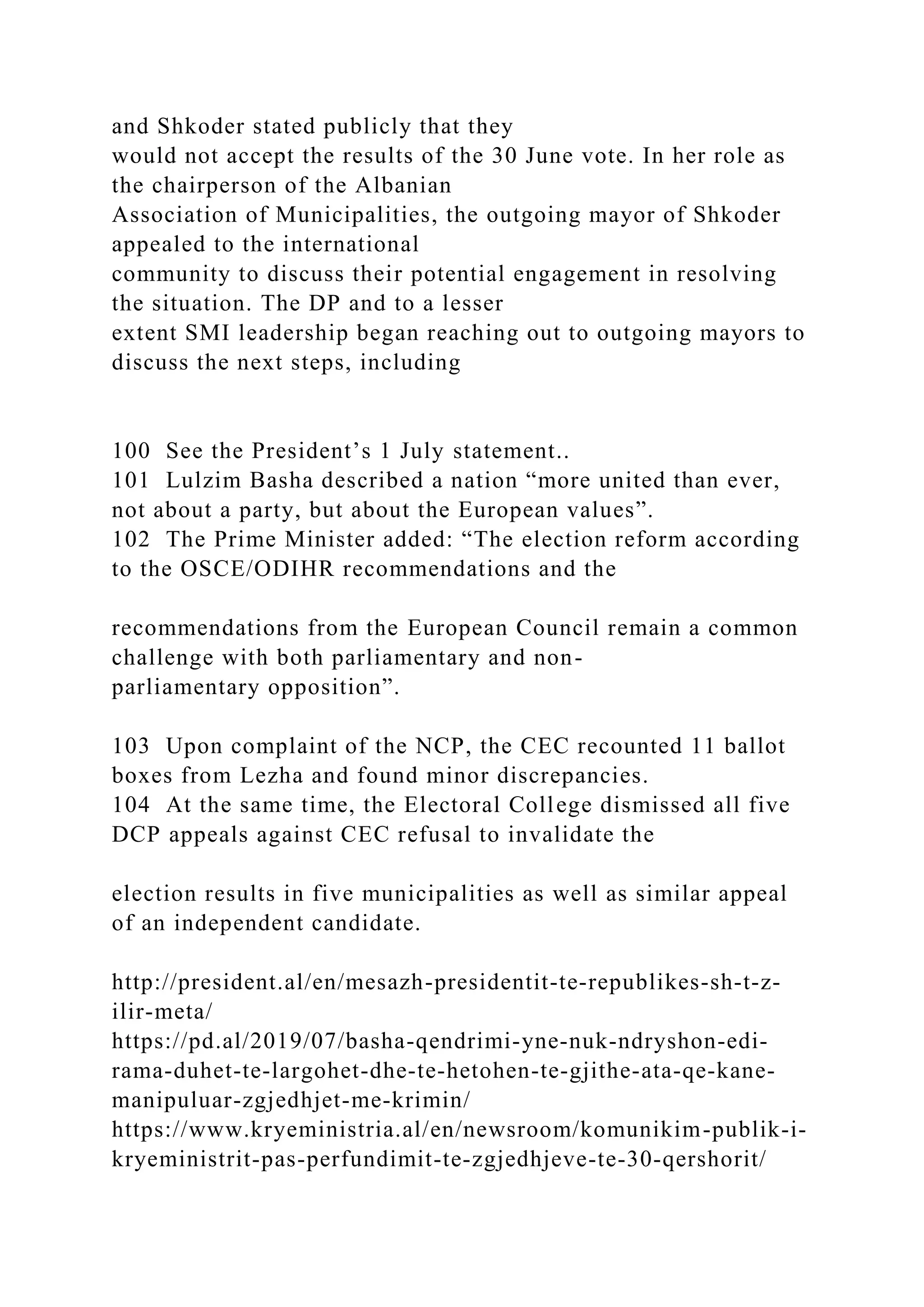
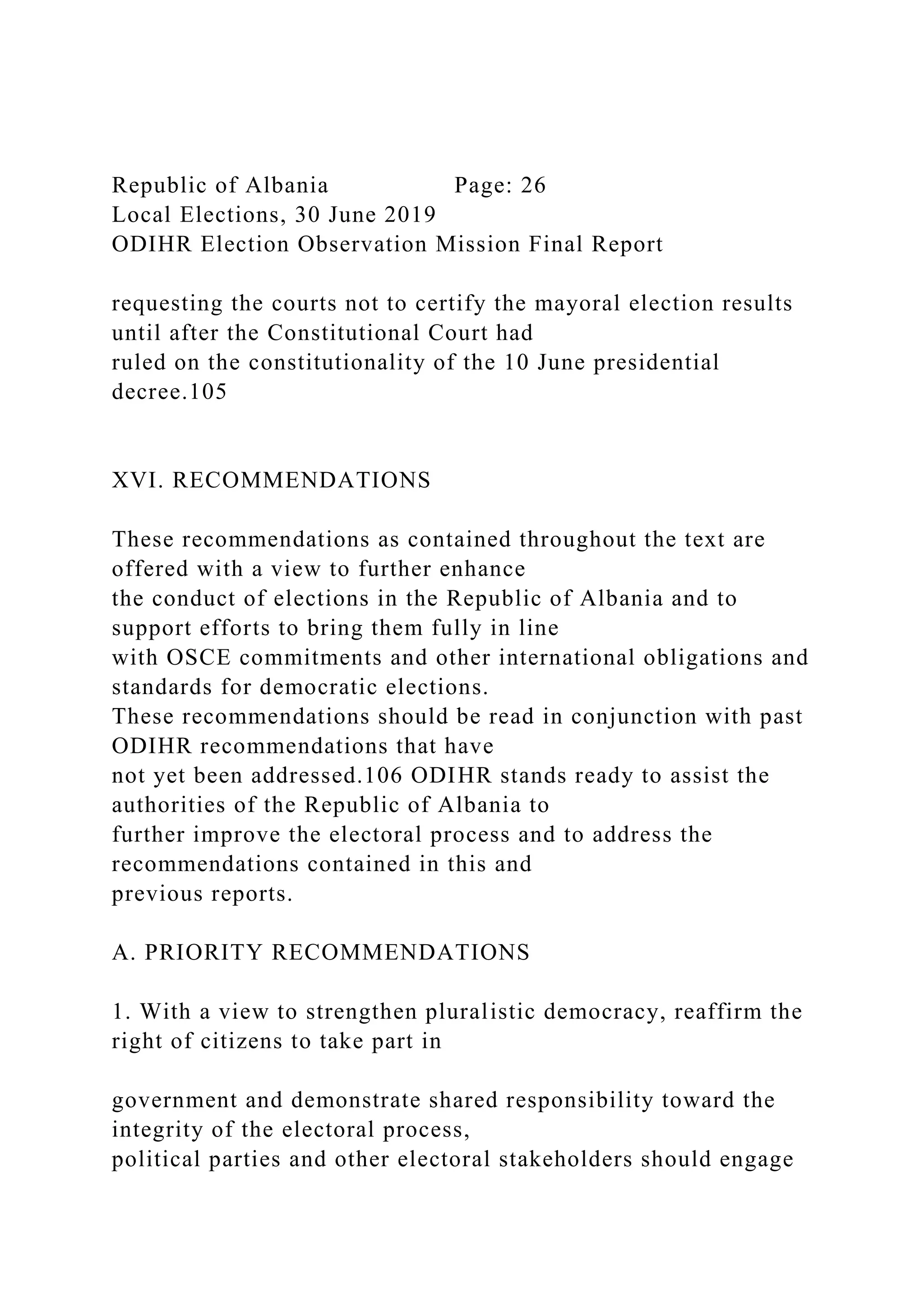



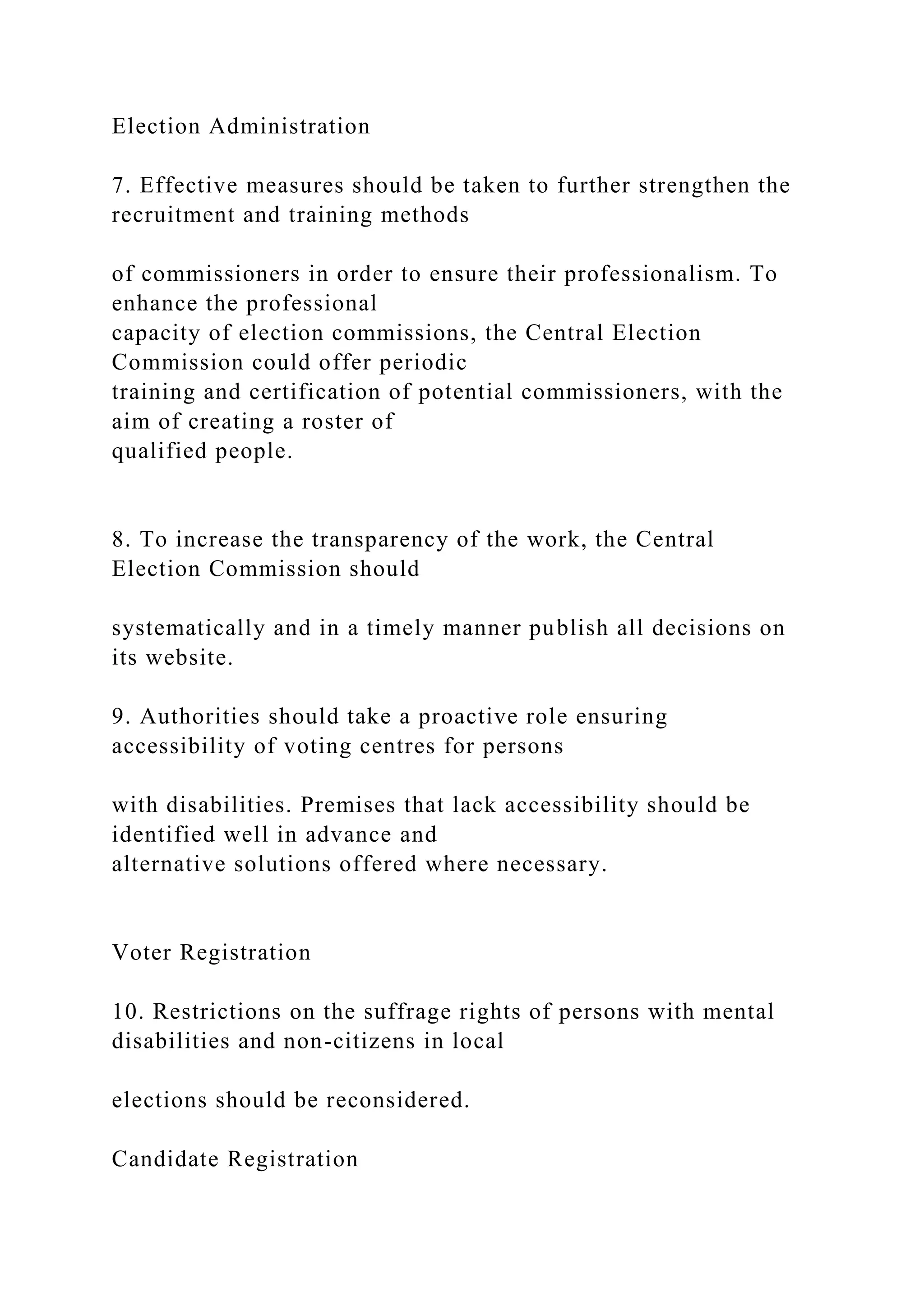







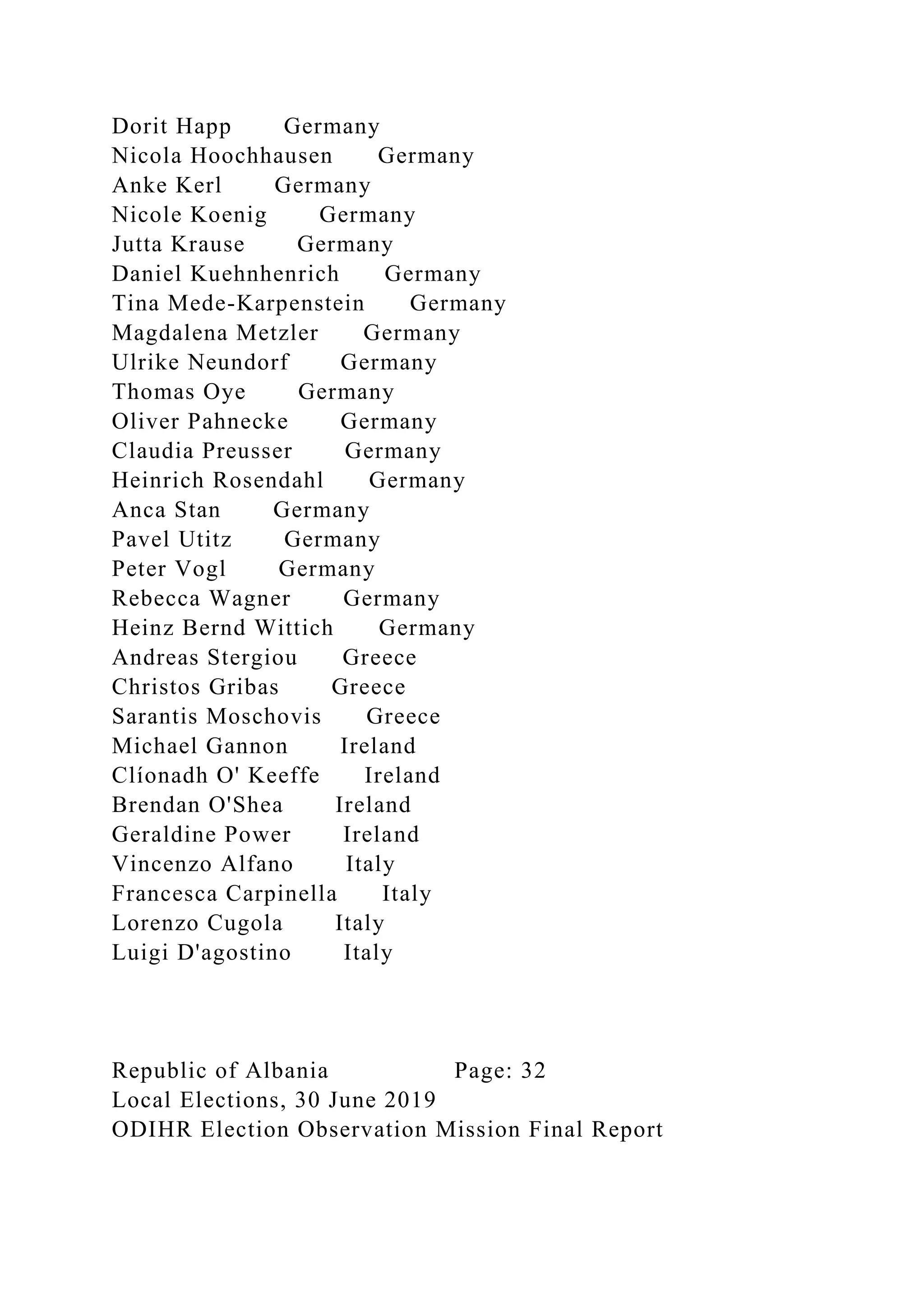


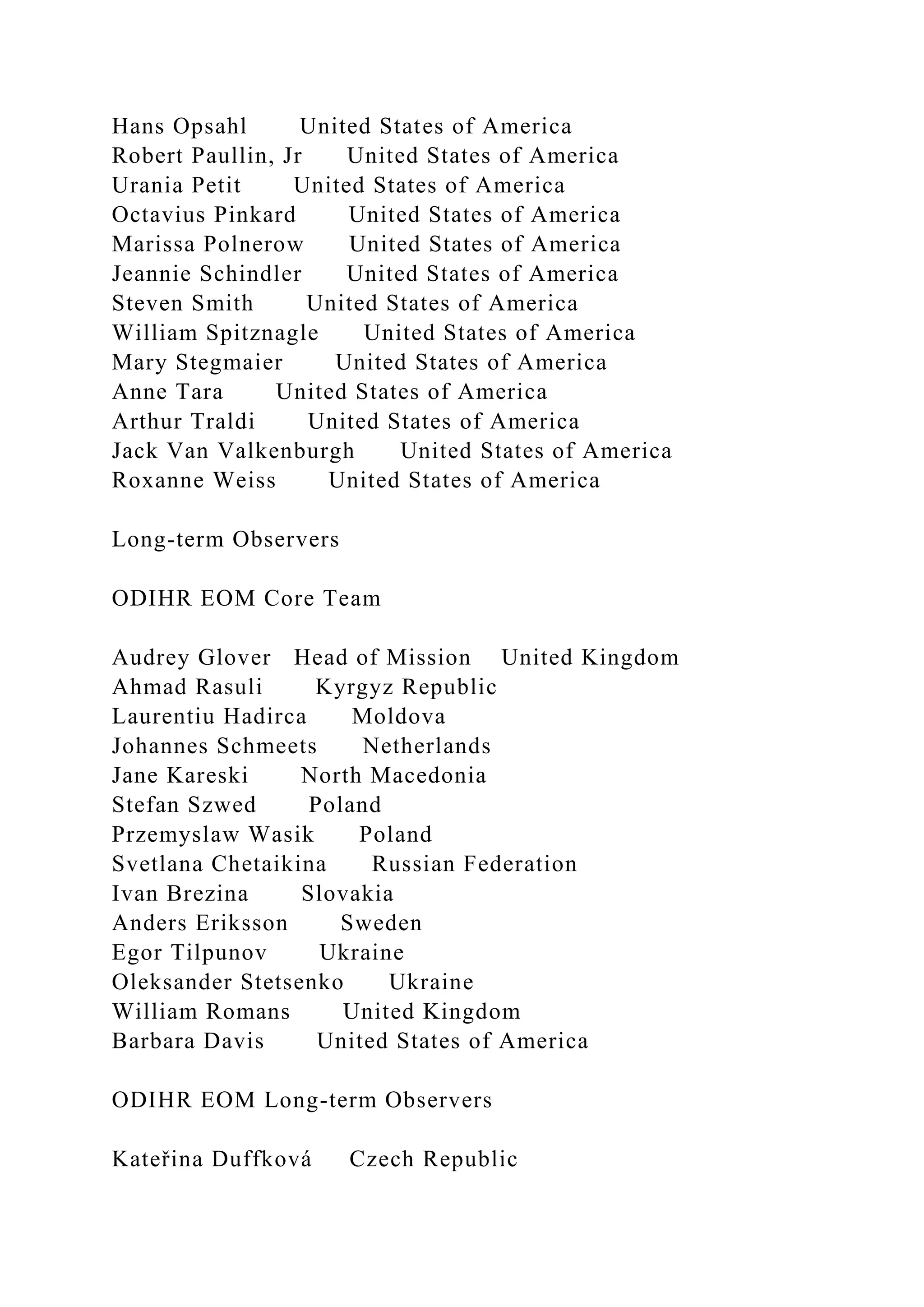



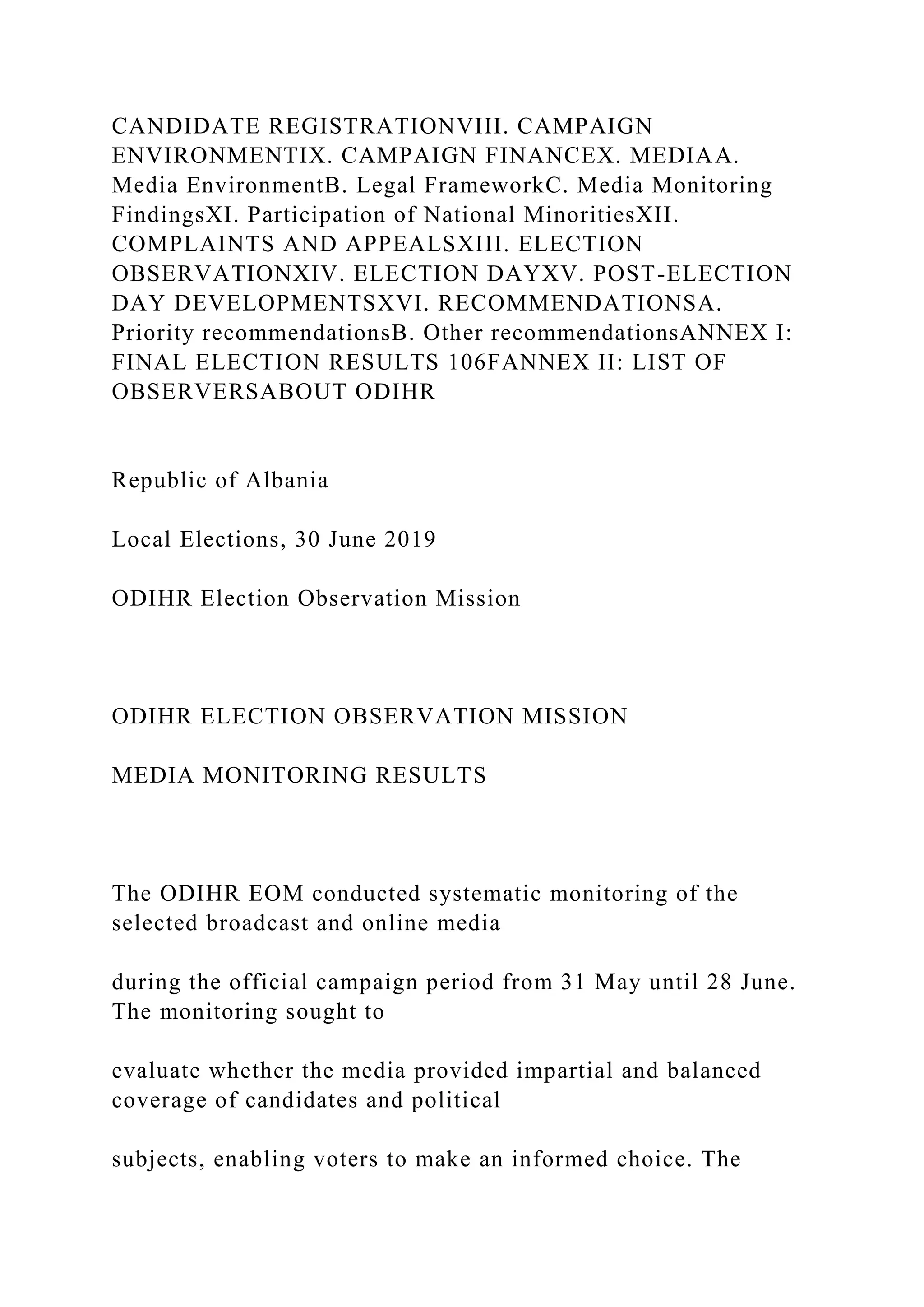





![3%
President
18%
Government
13%
Socialist Party
29%
Local SP
Government
7%
Democratic Party
21%
Local DP
Government
5%
Socialist Movement
for Integration
2%
Other Opposition
Parties
[PERCENTAGE]
Democratic](https://image.slidesharecdn.com/httpsifes-221015083553-d170a478/75/httpsifes-orgsitesdefaultfilesbrijuni18countryreport_fi-docx-108-2048.jpg)
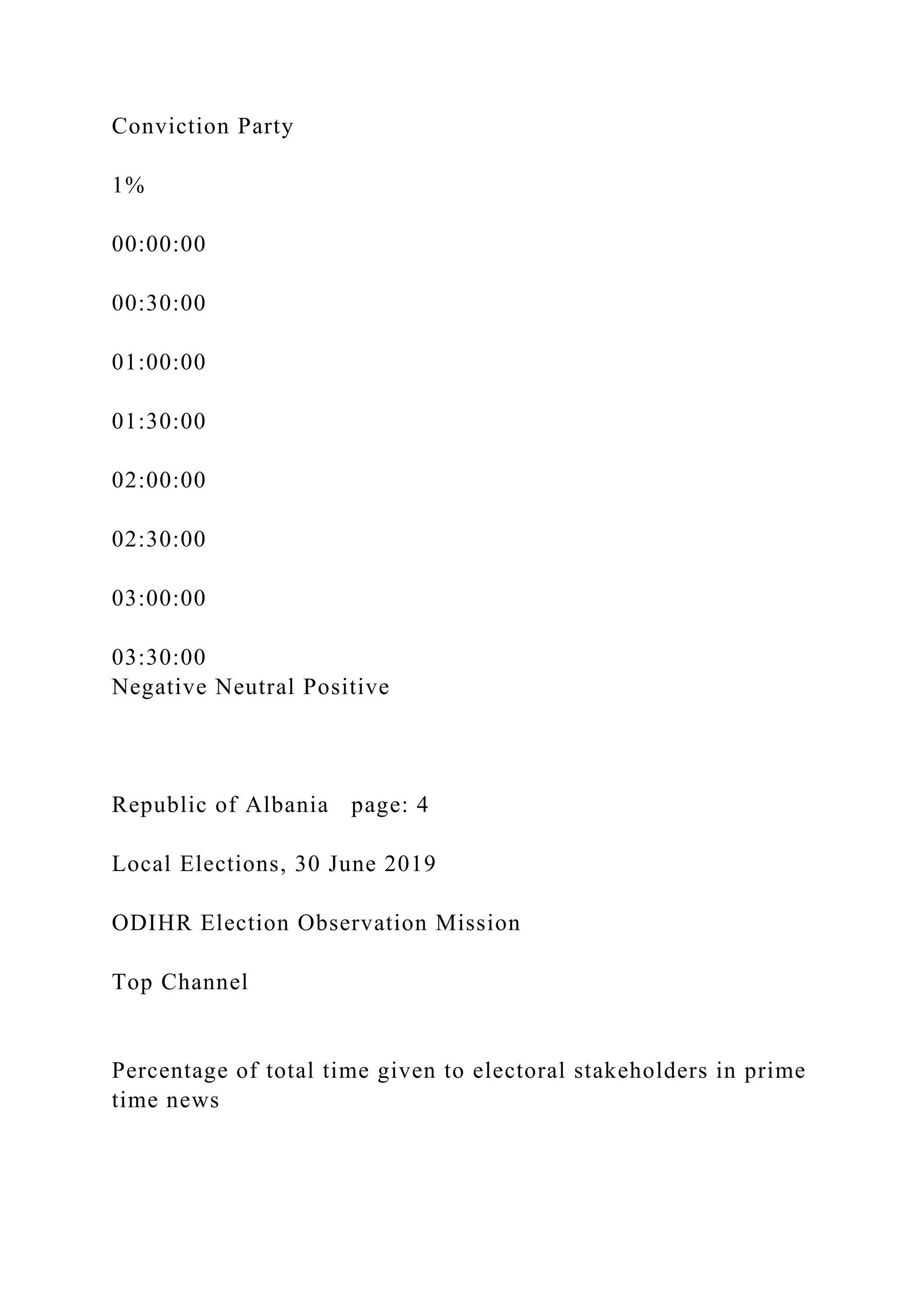


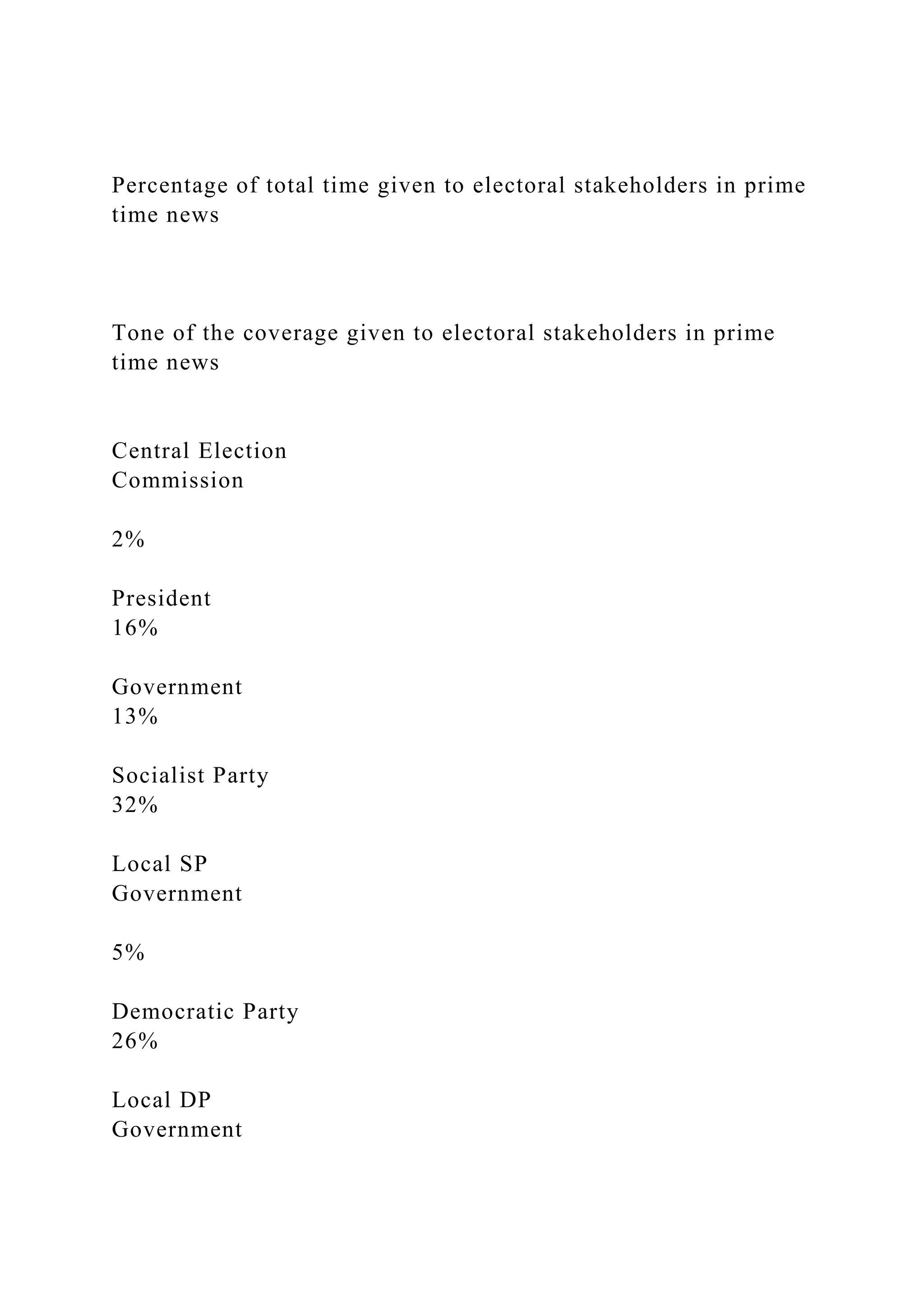
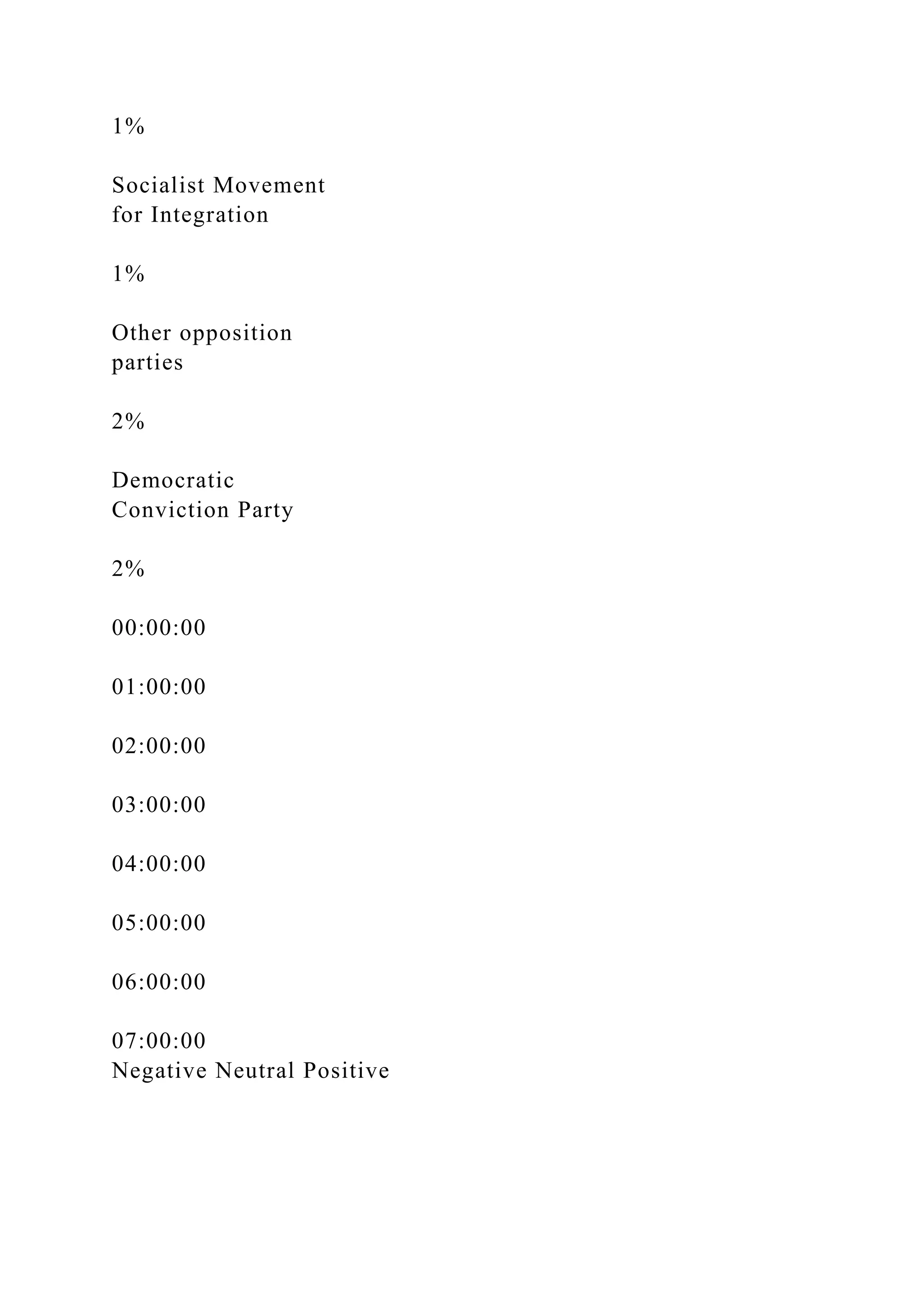


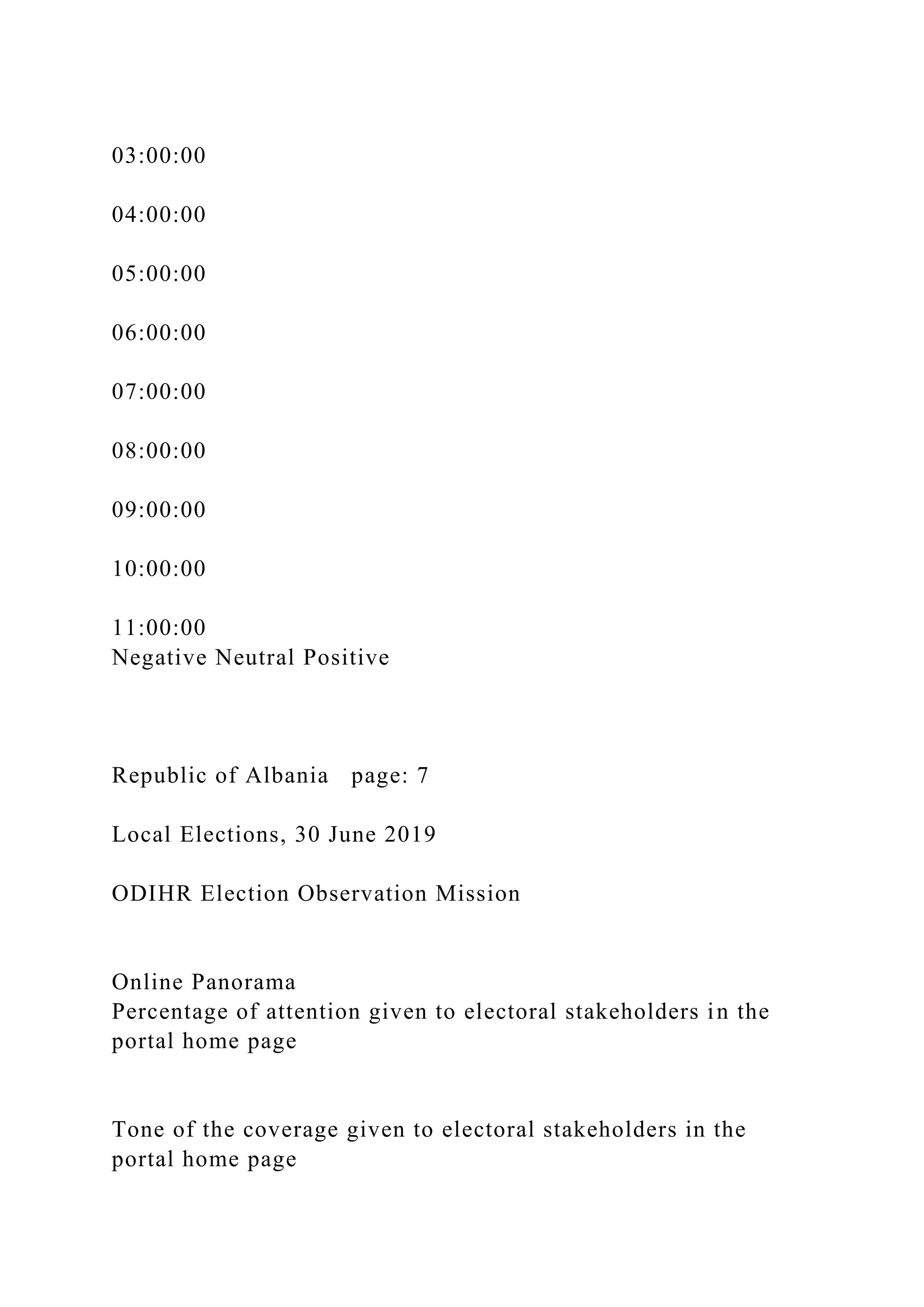



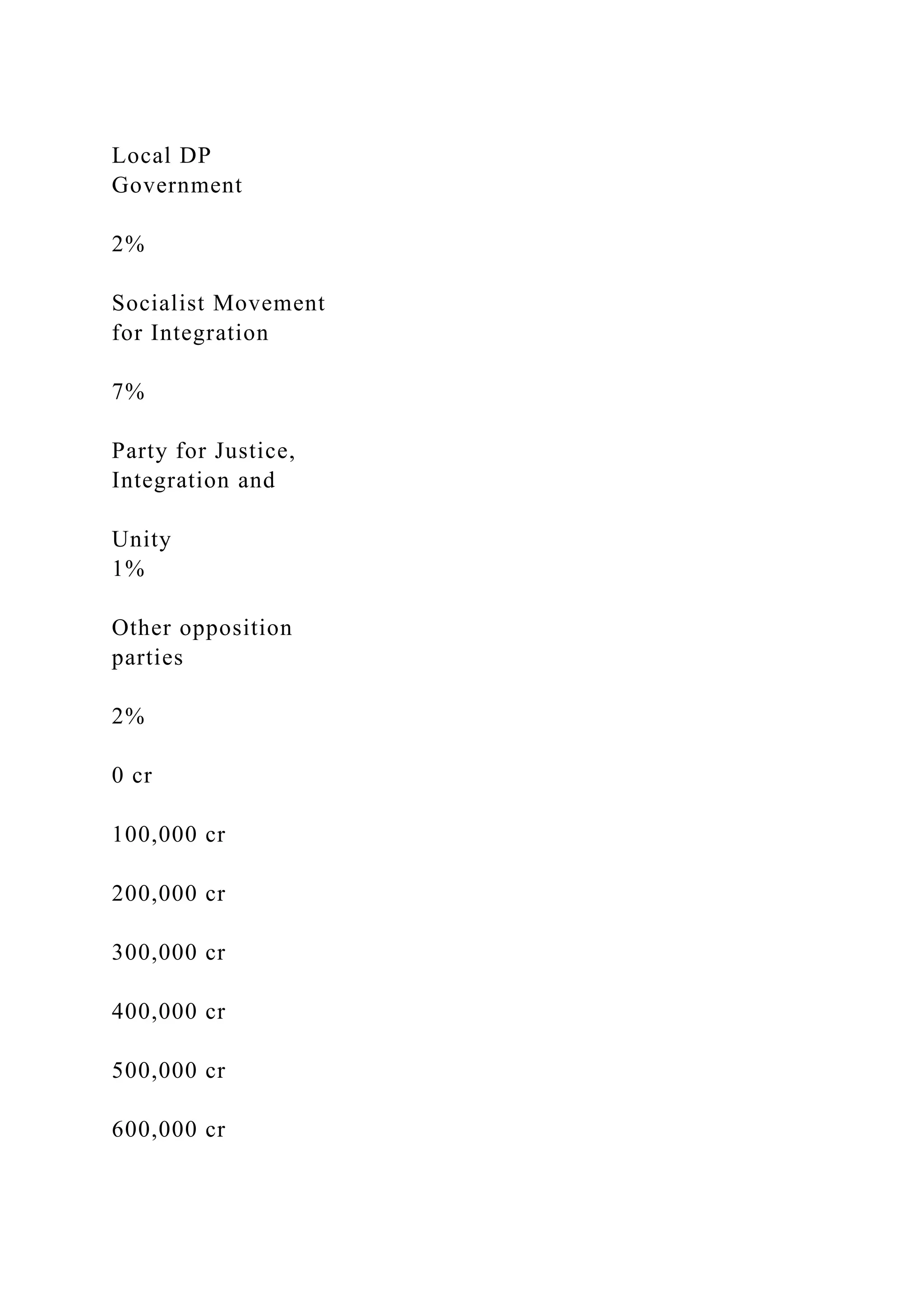


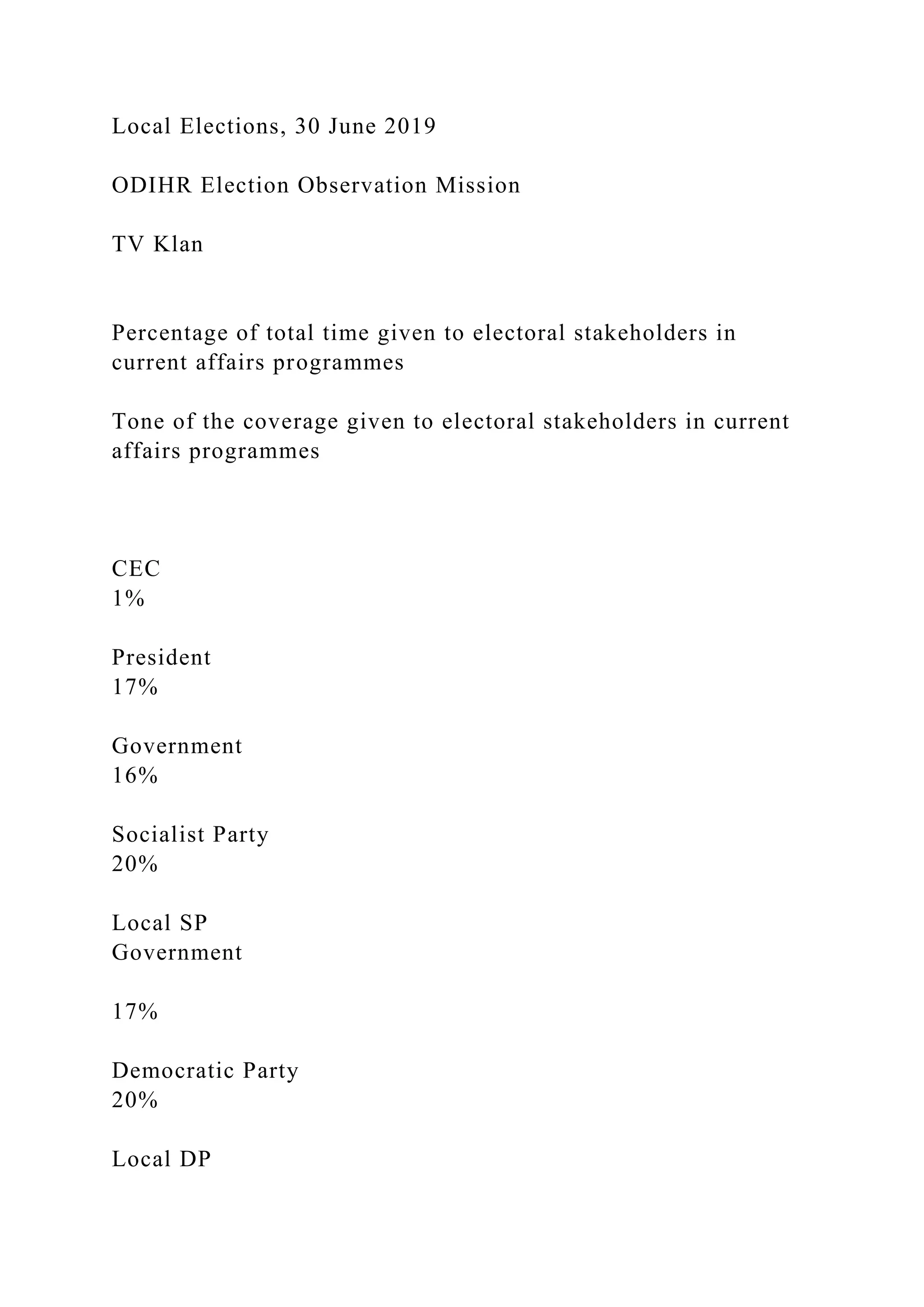
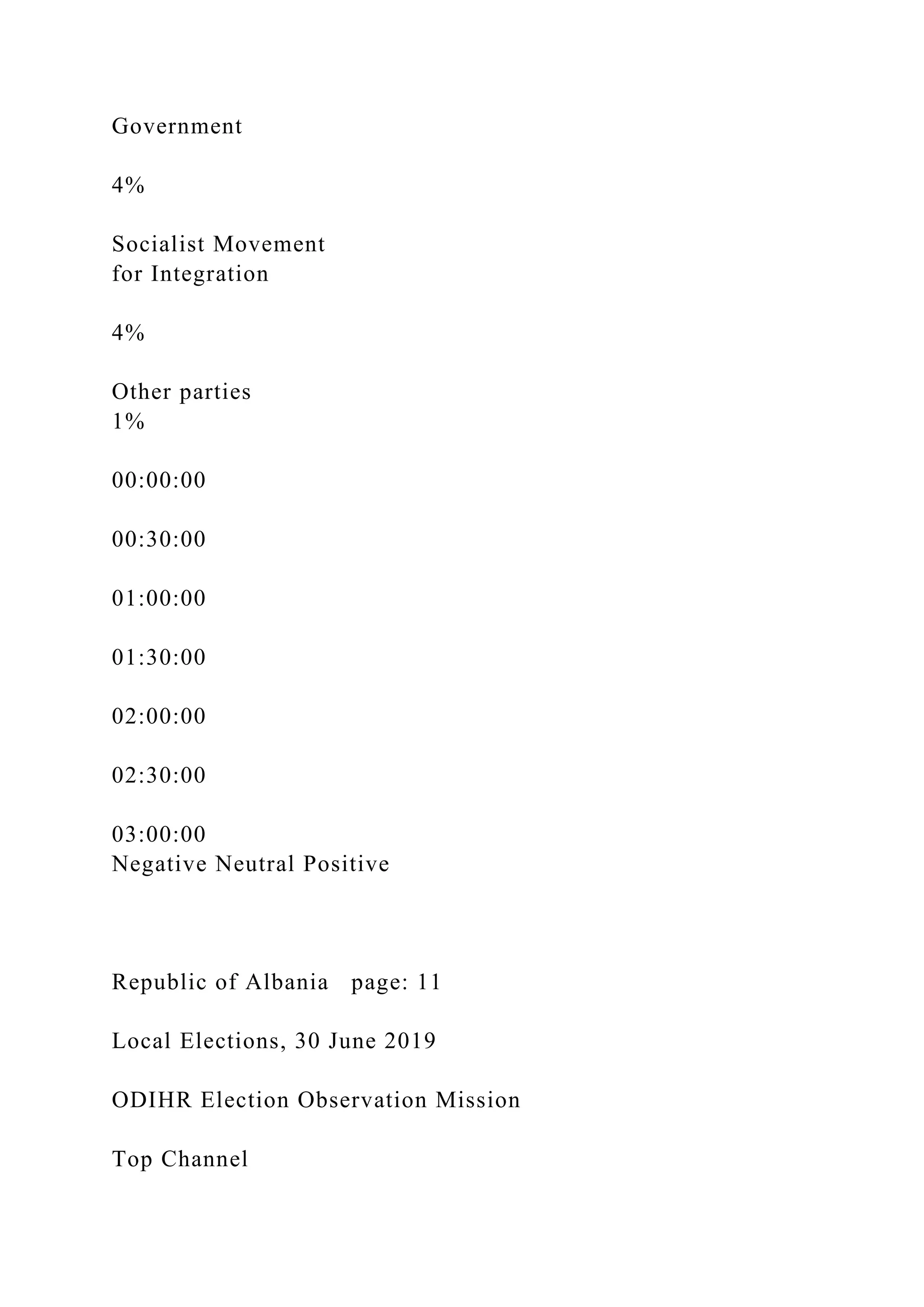


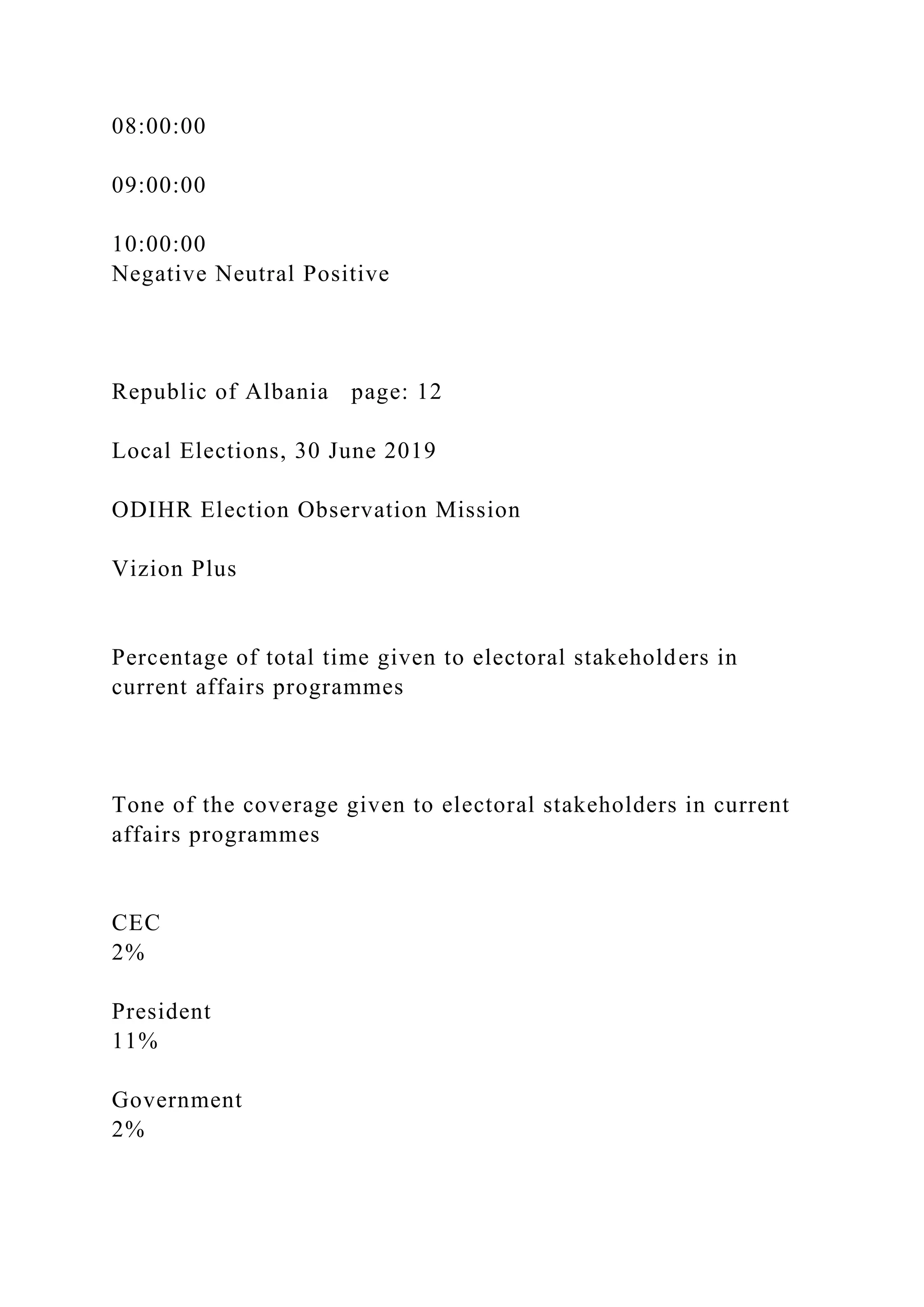


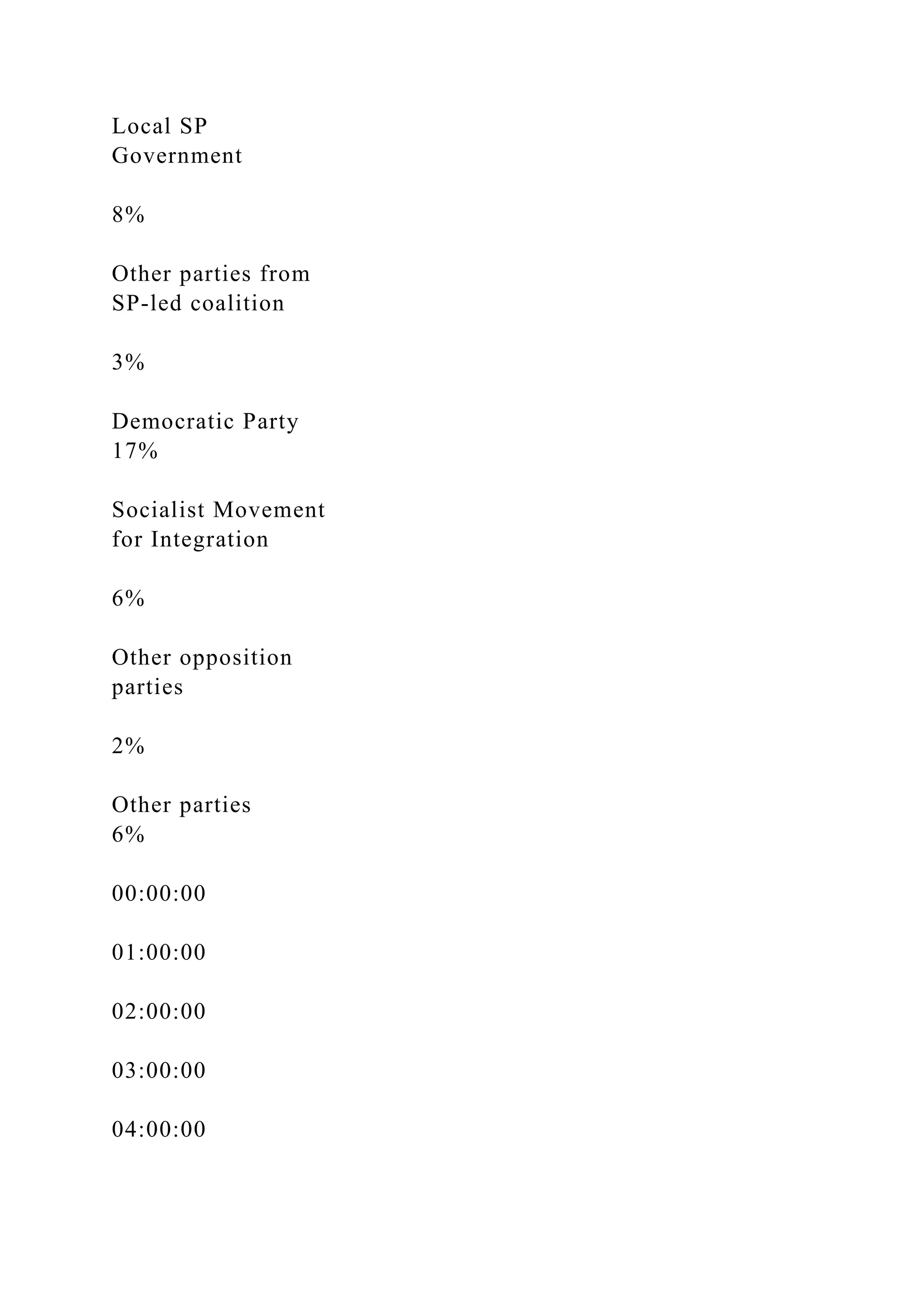




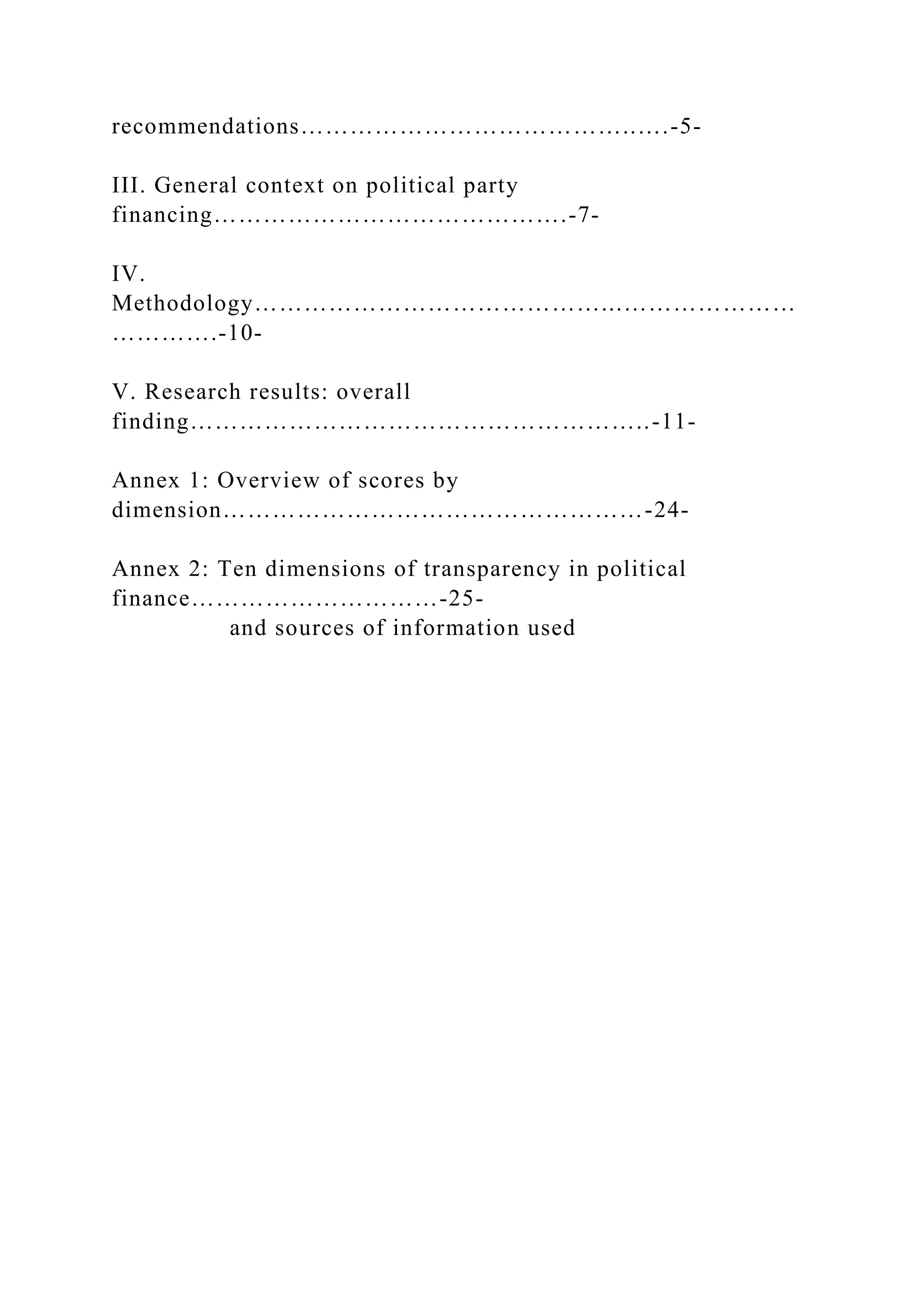



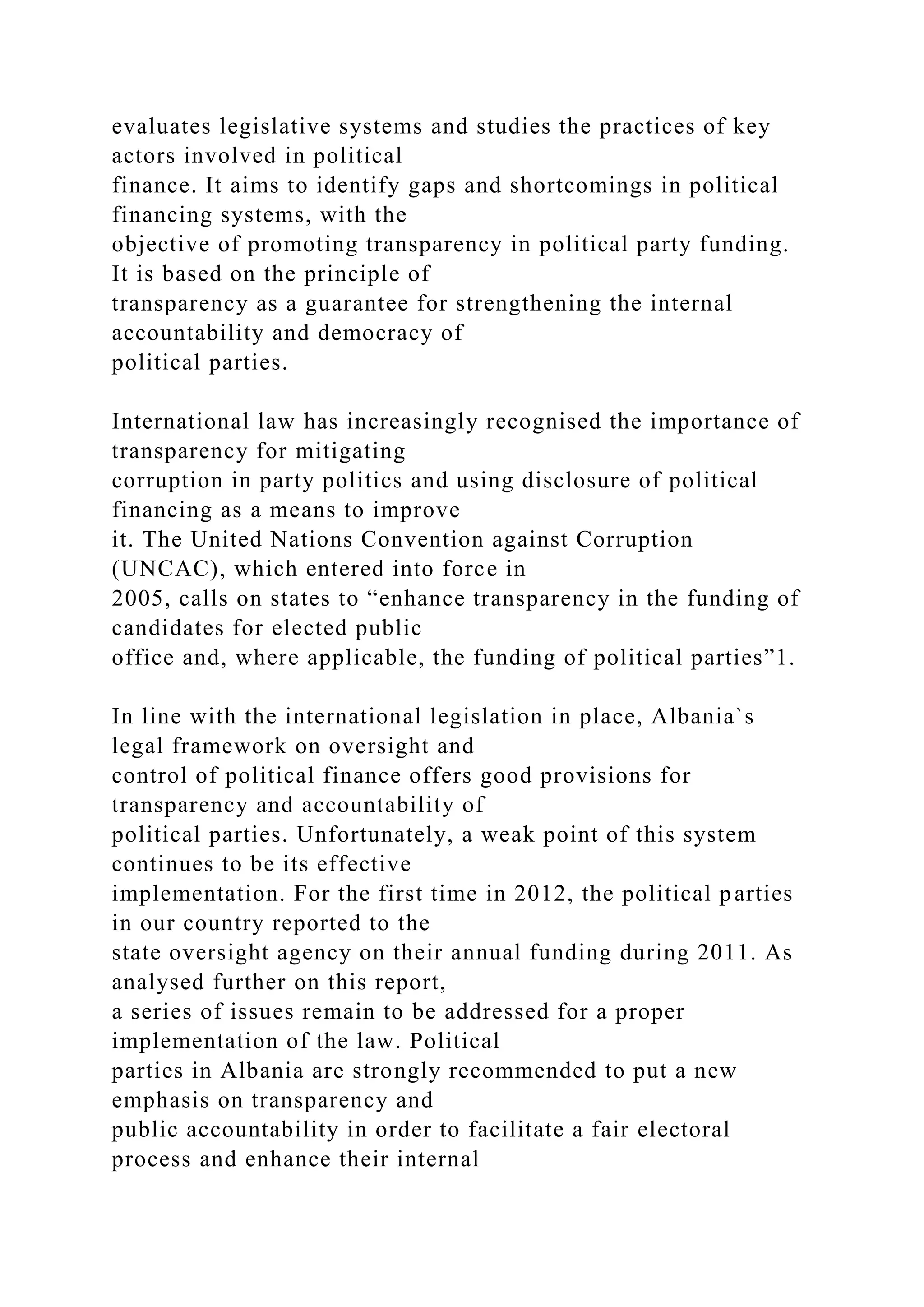





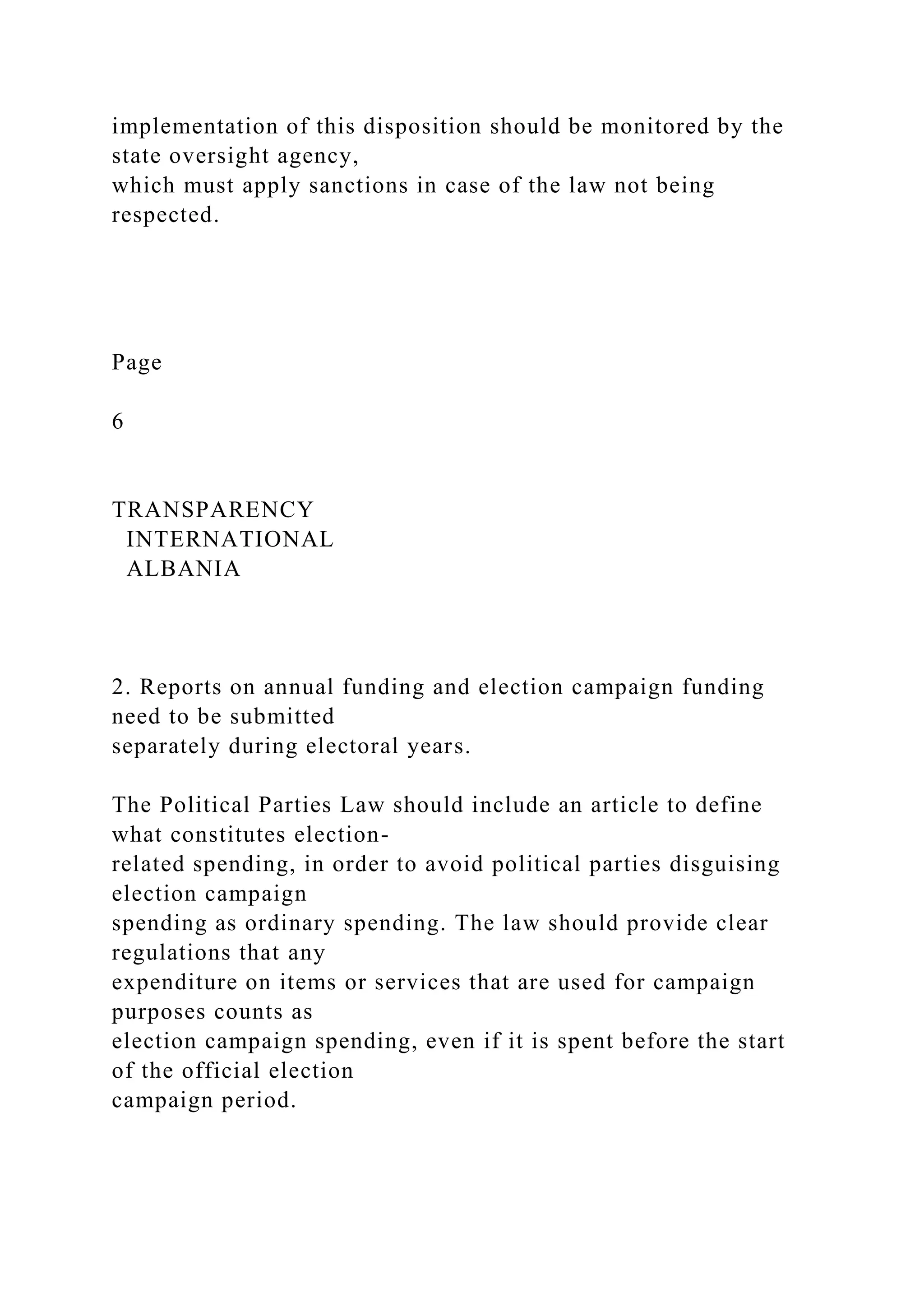
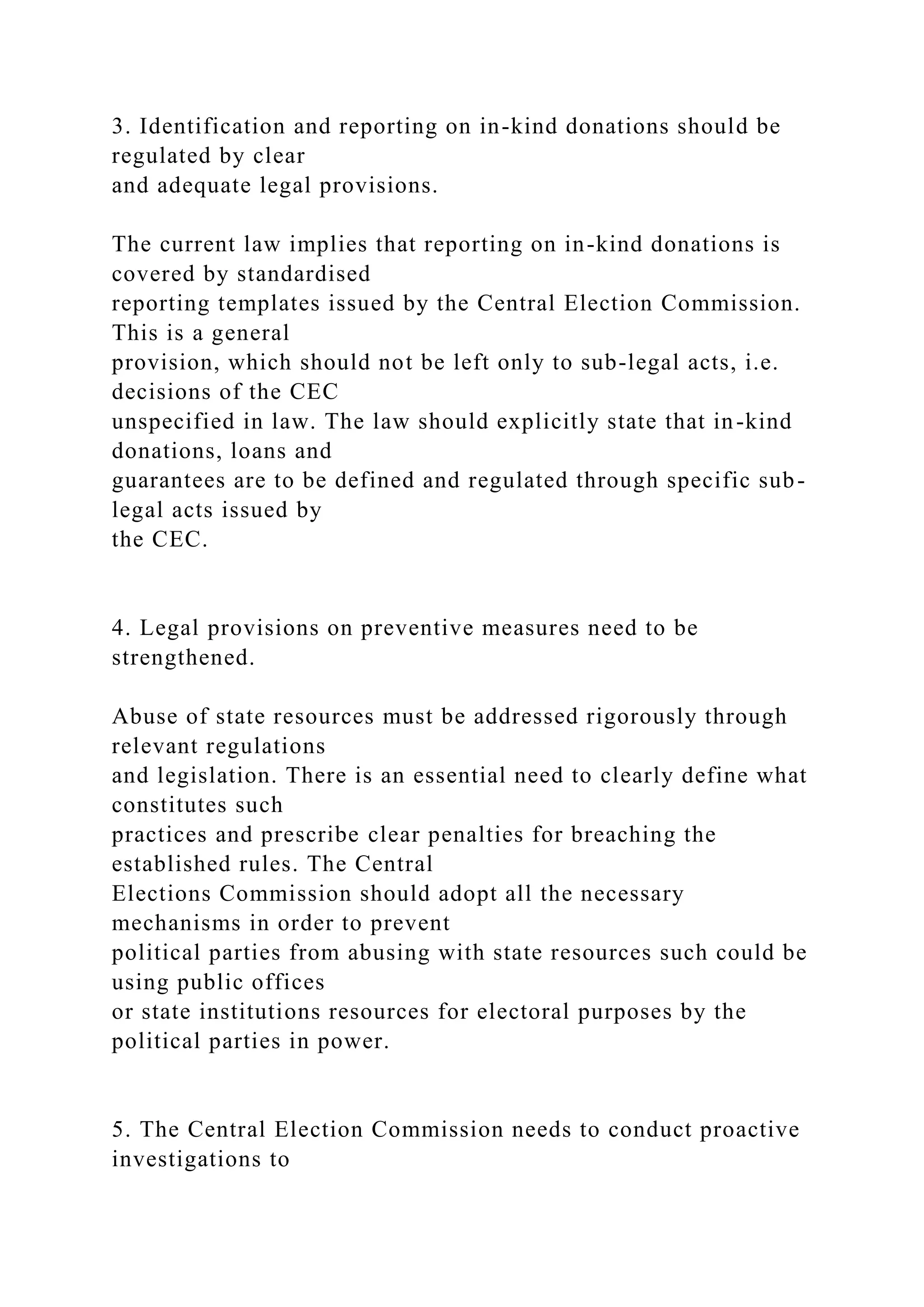













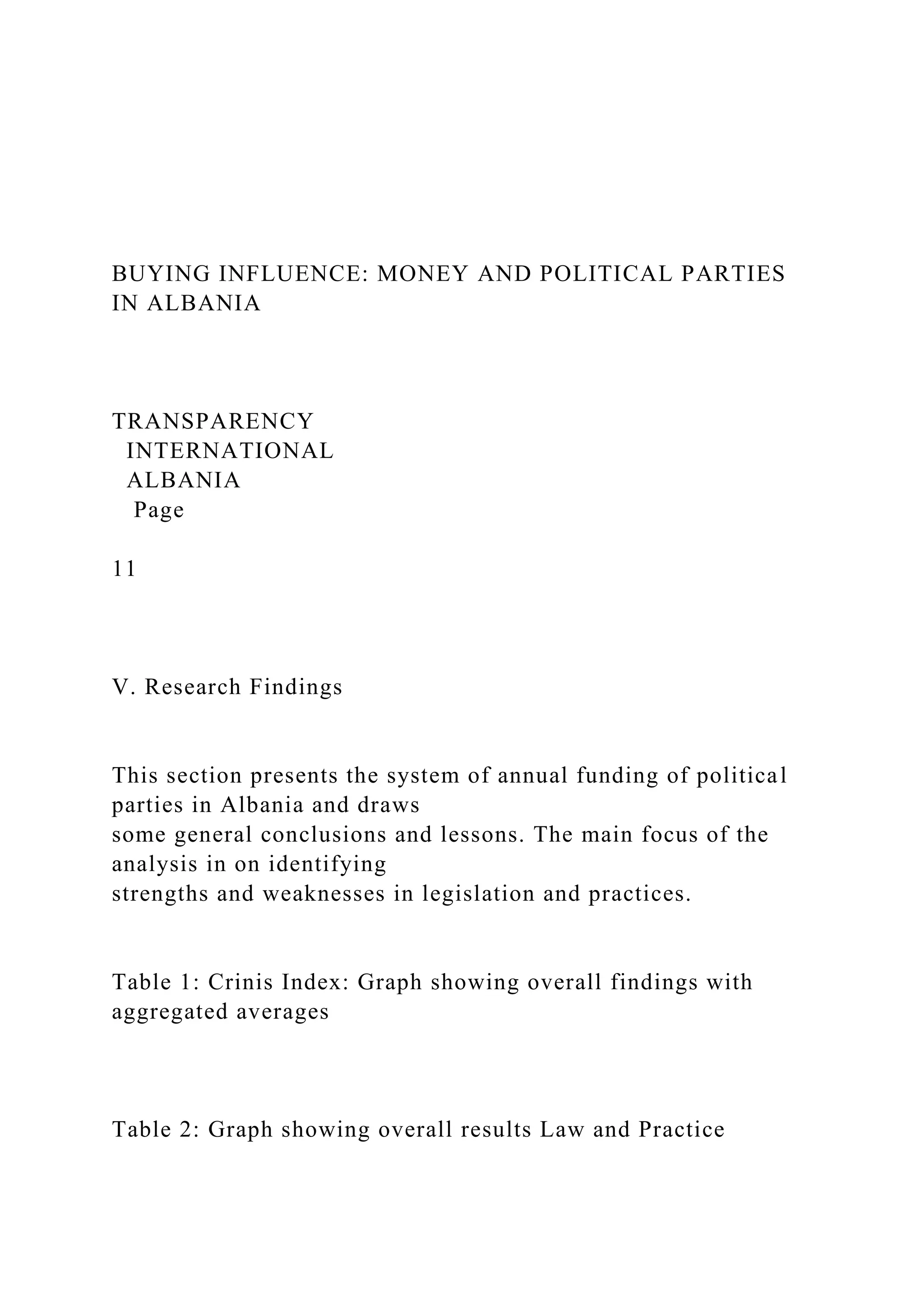





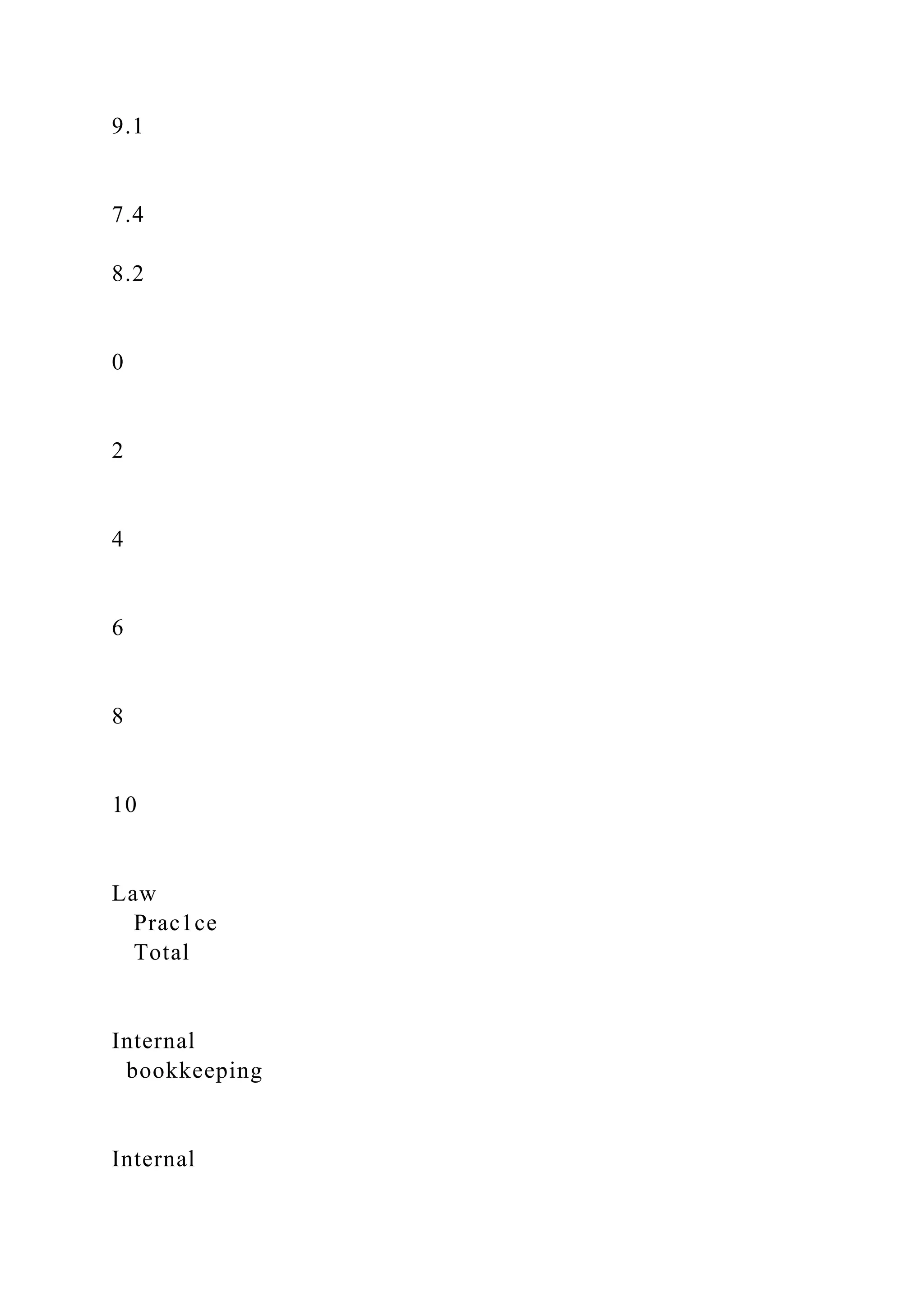







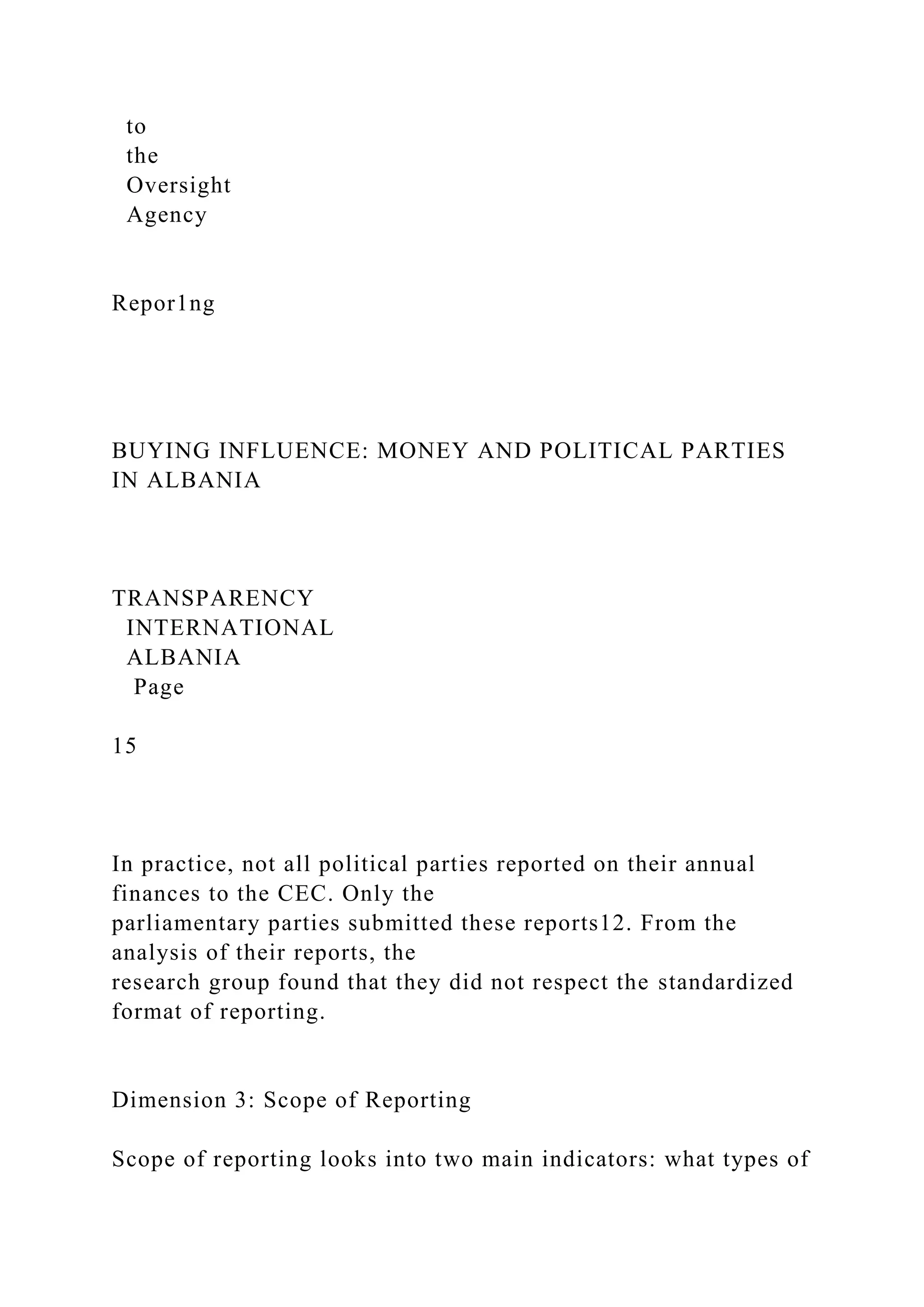



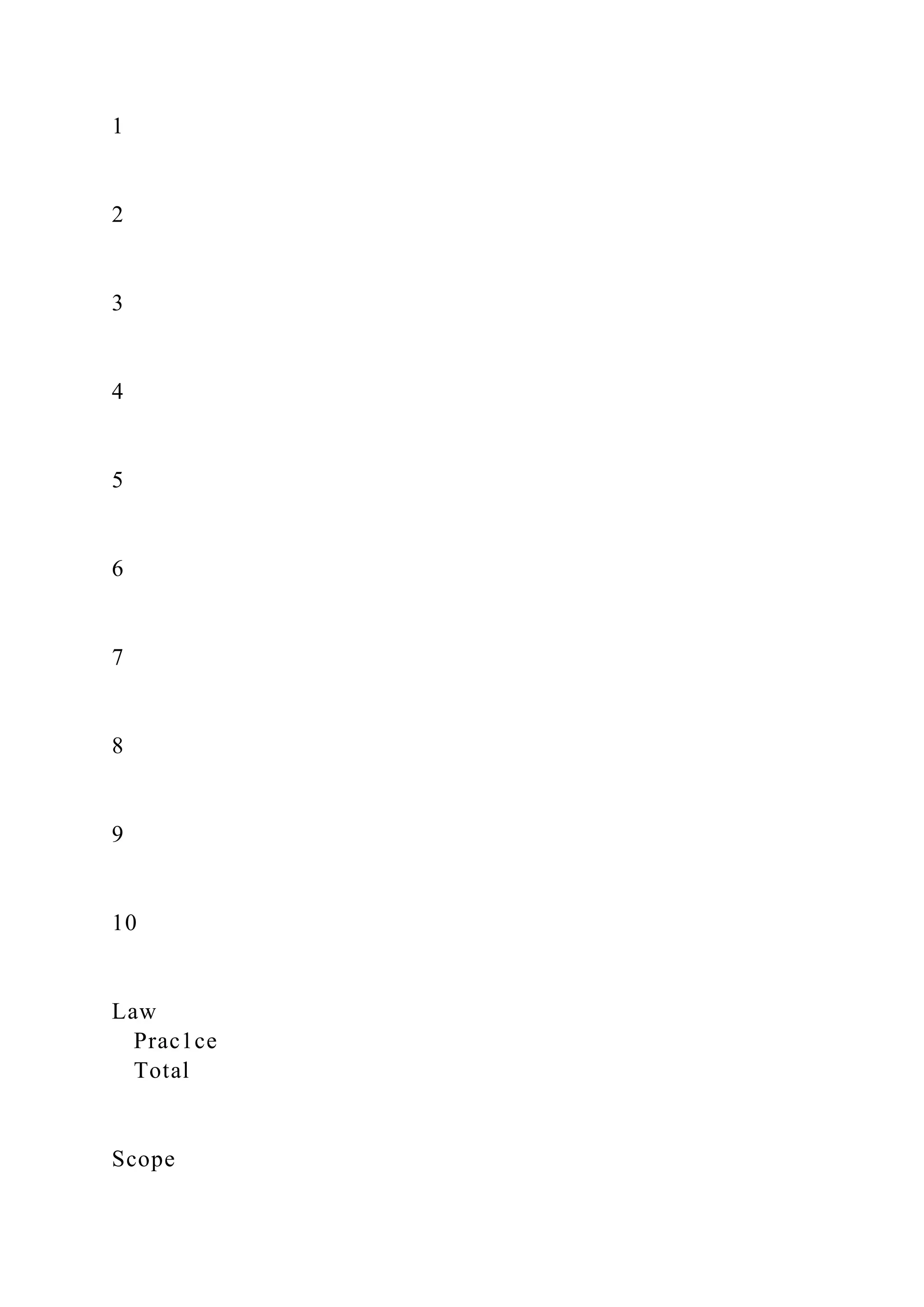
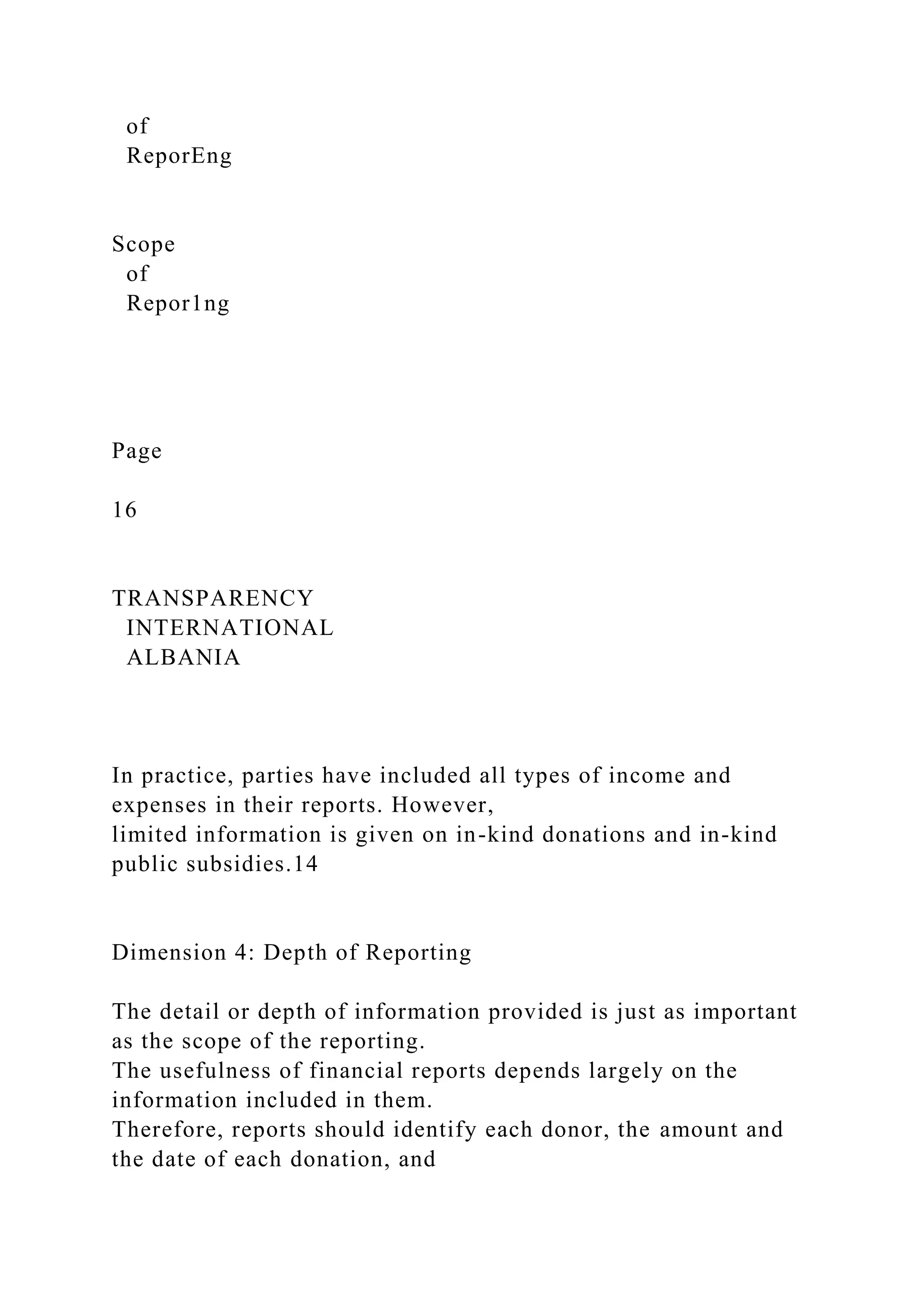





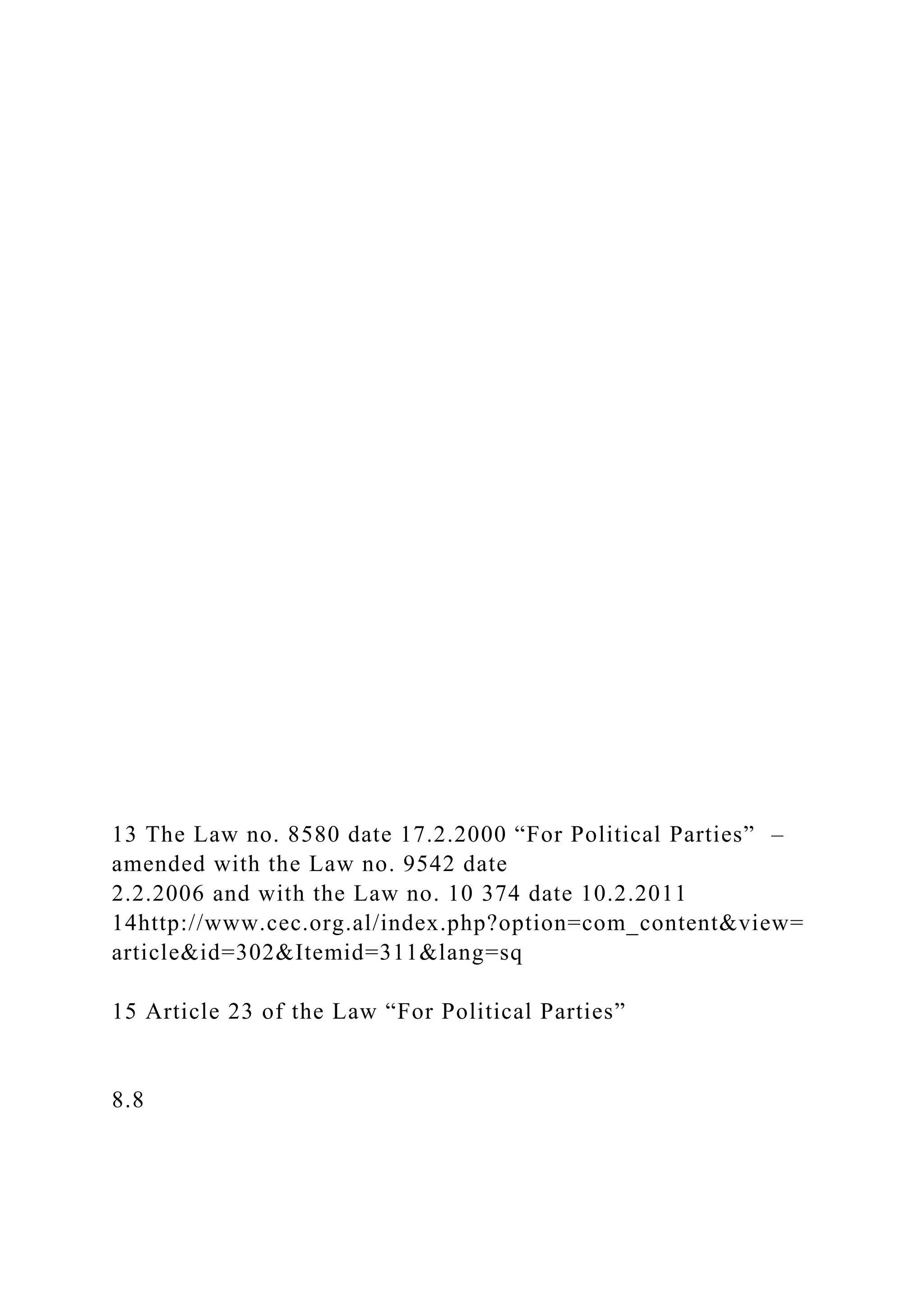

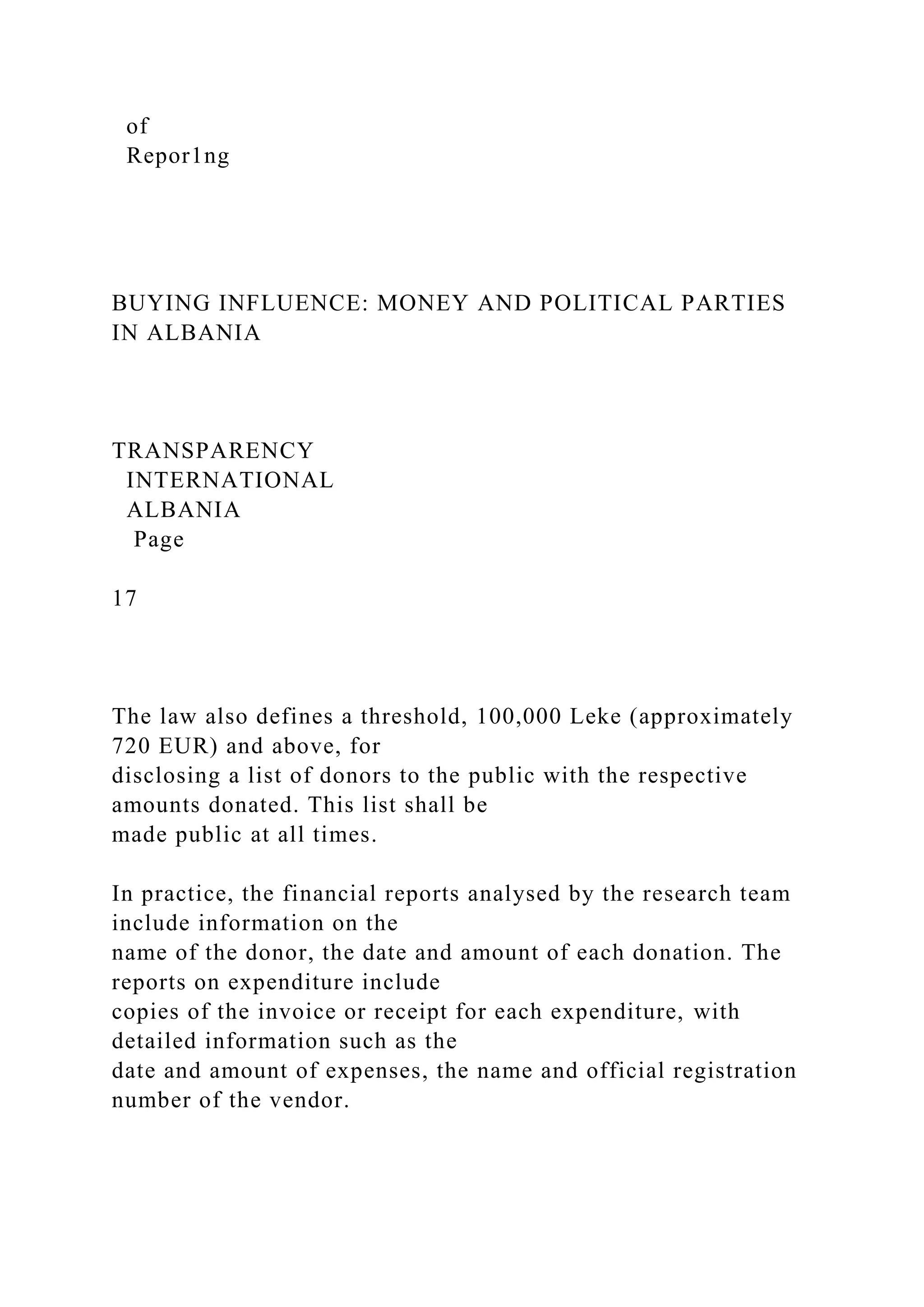





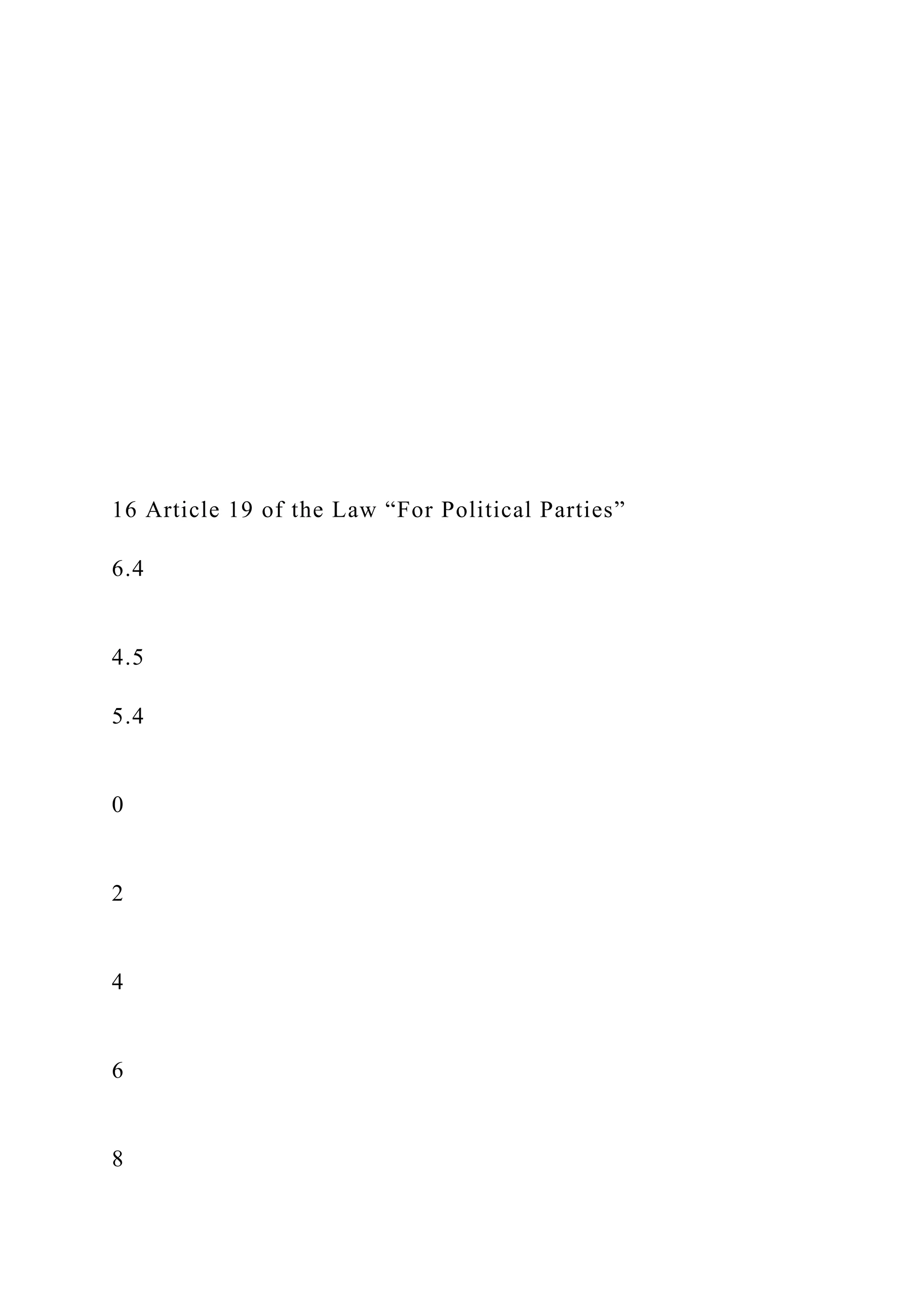
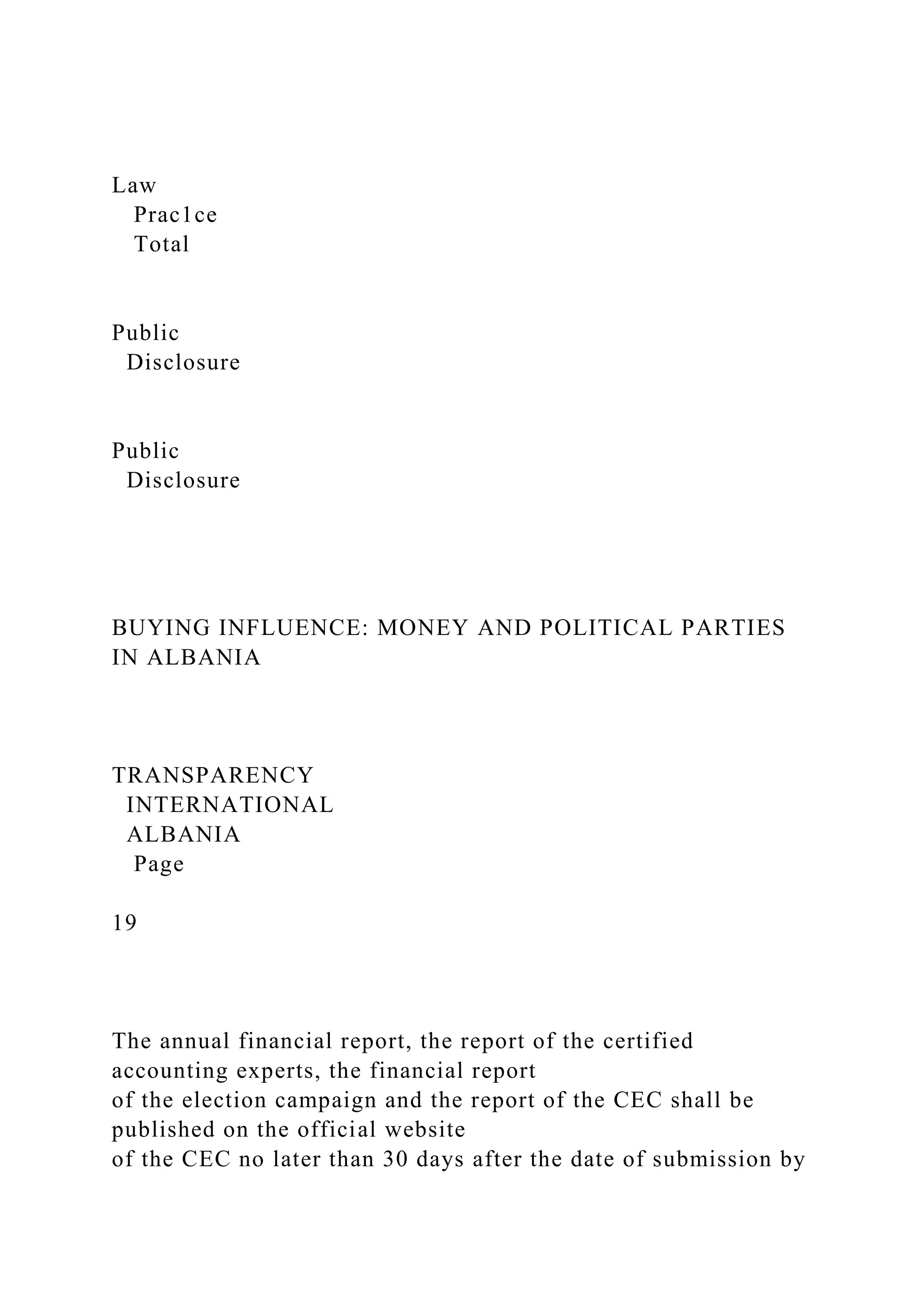





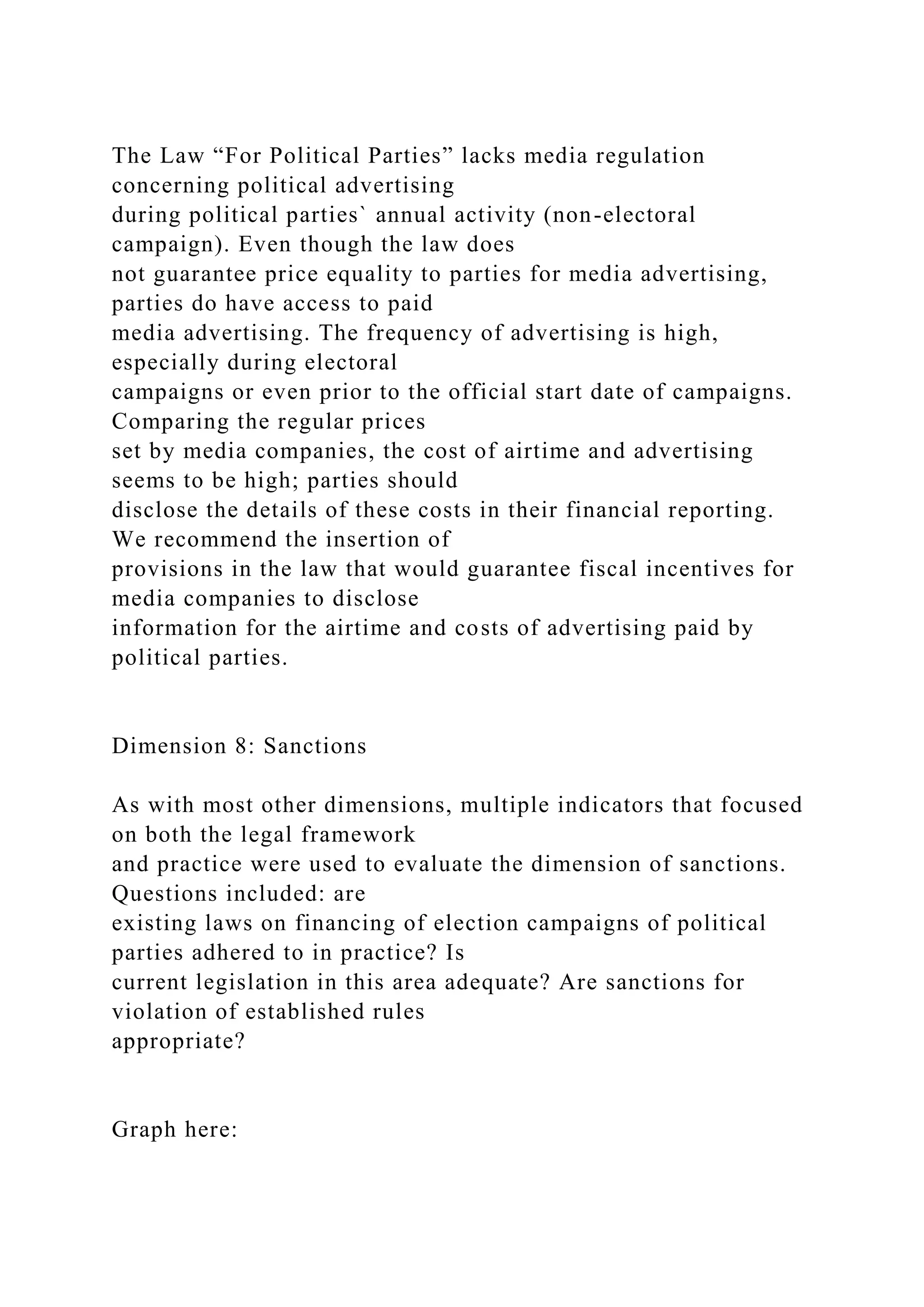

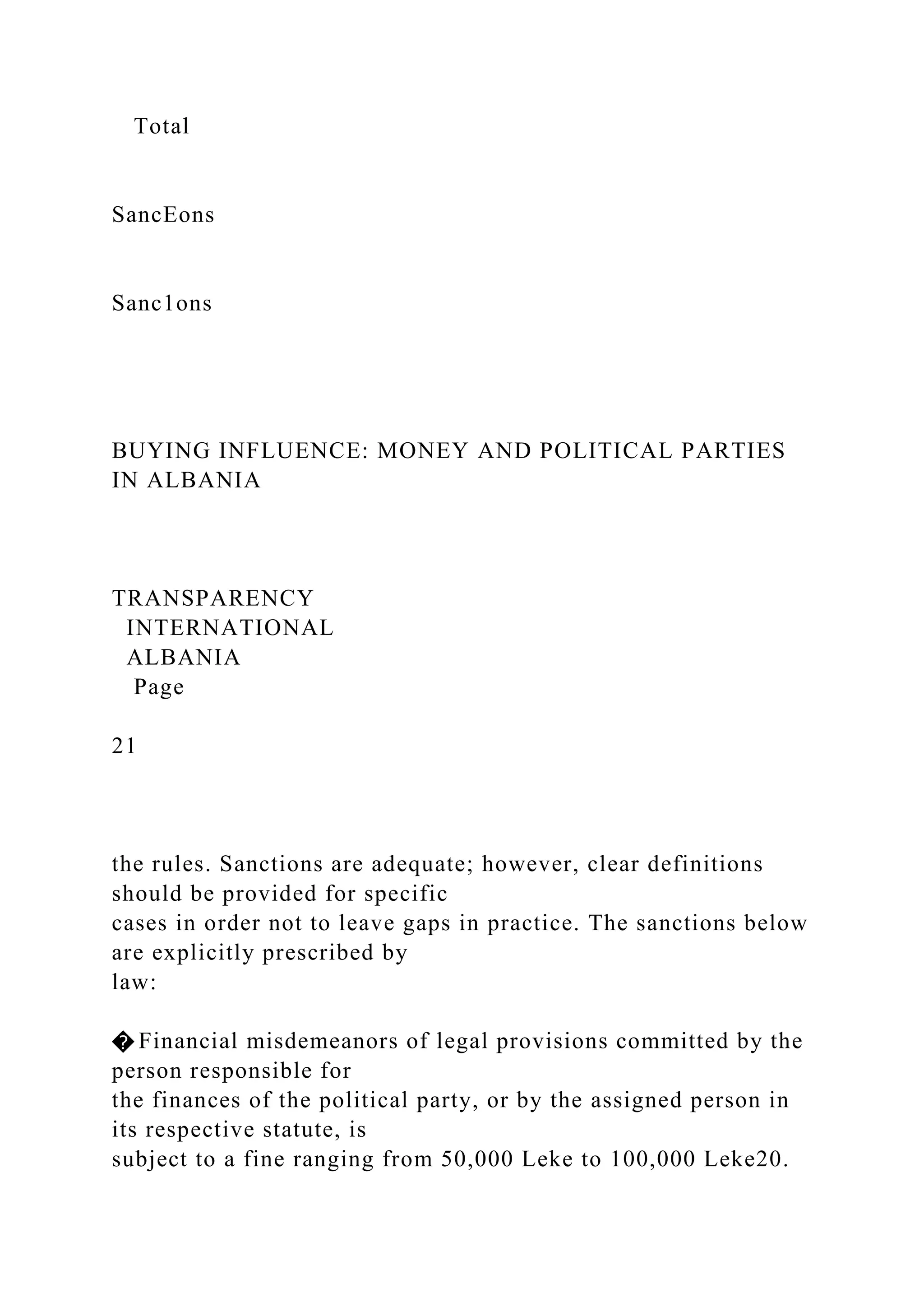





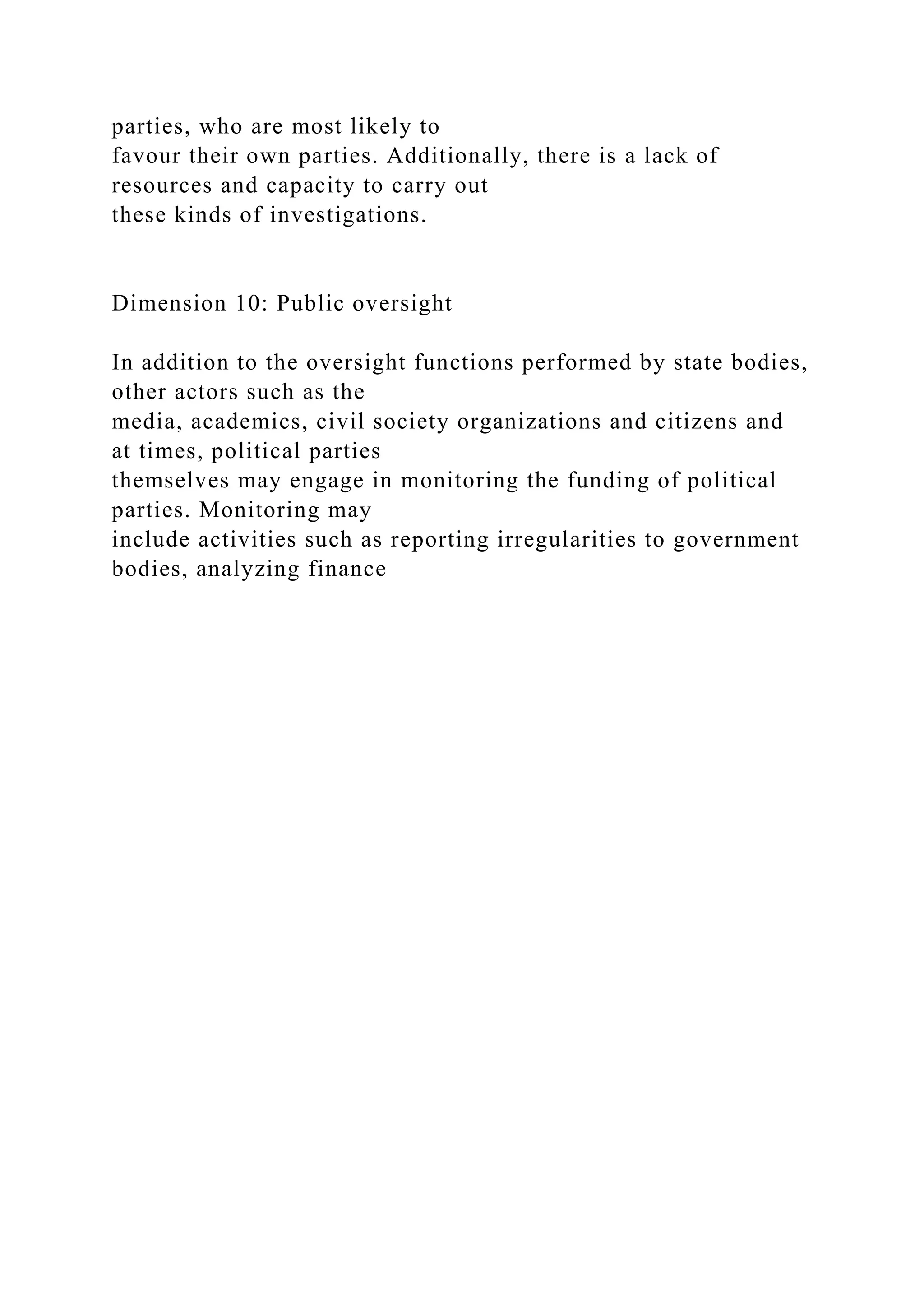




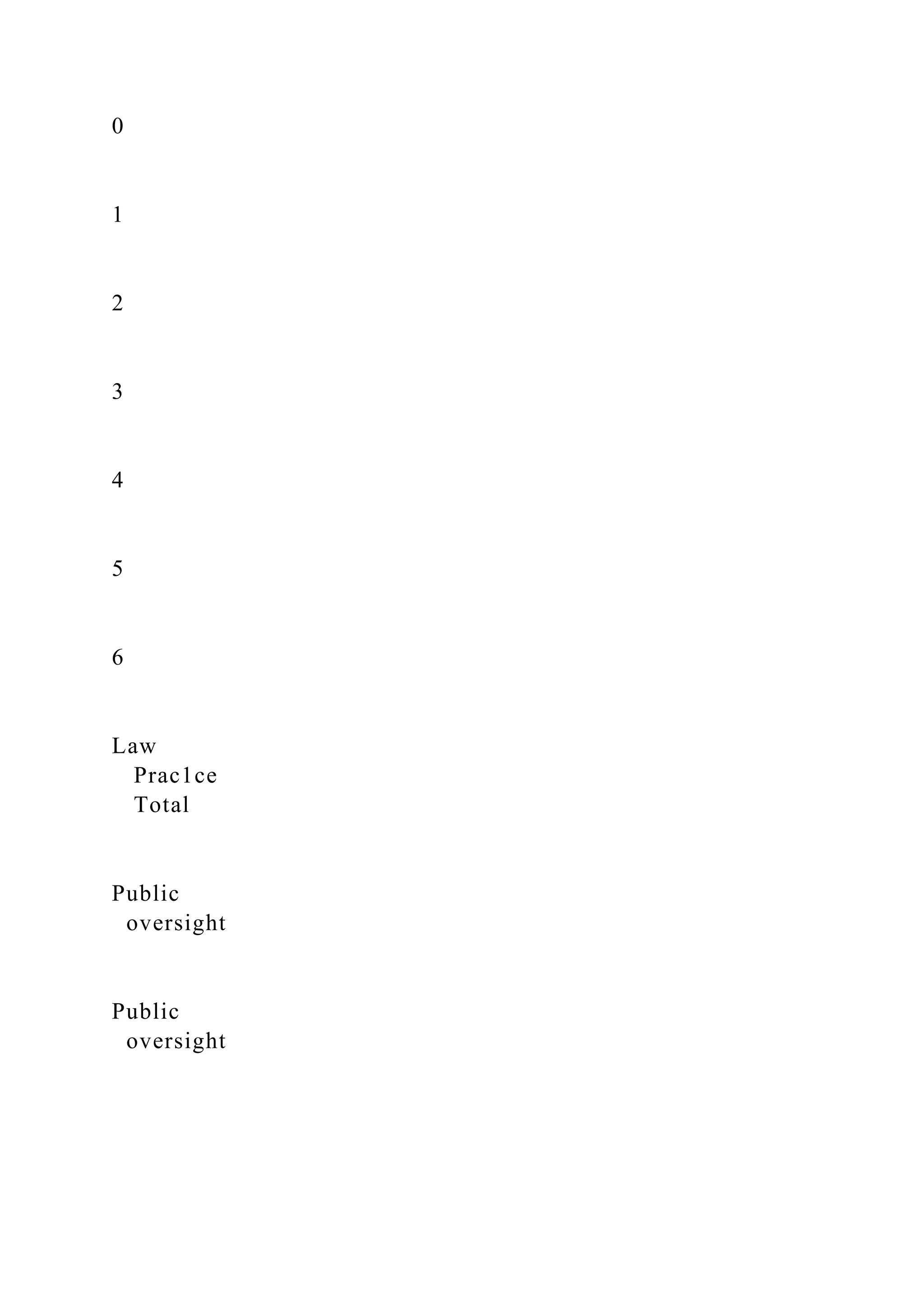


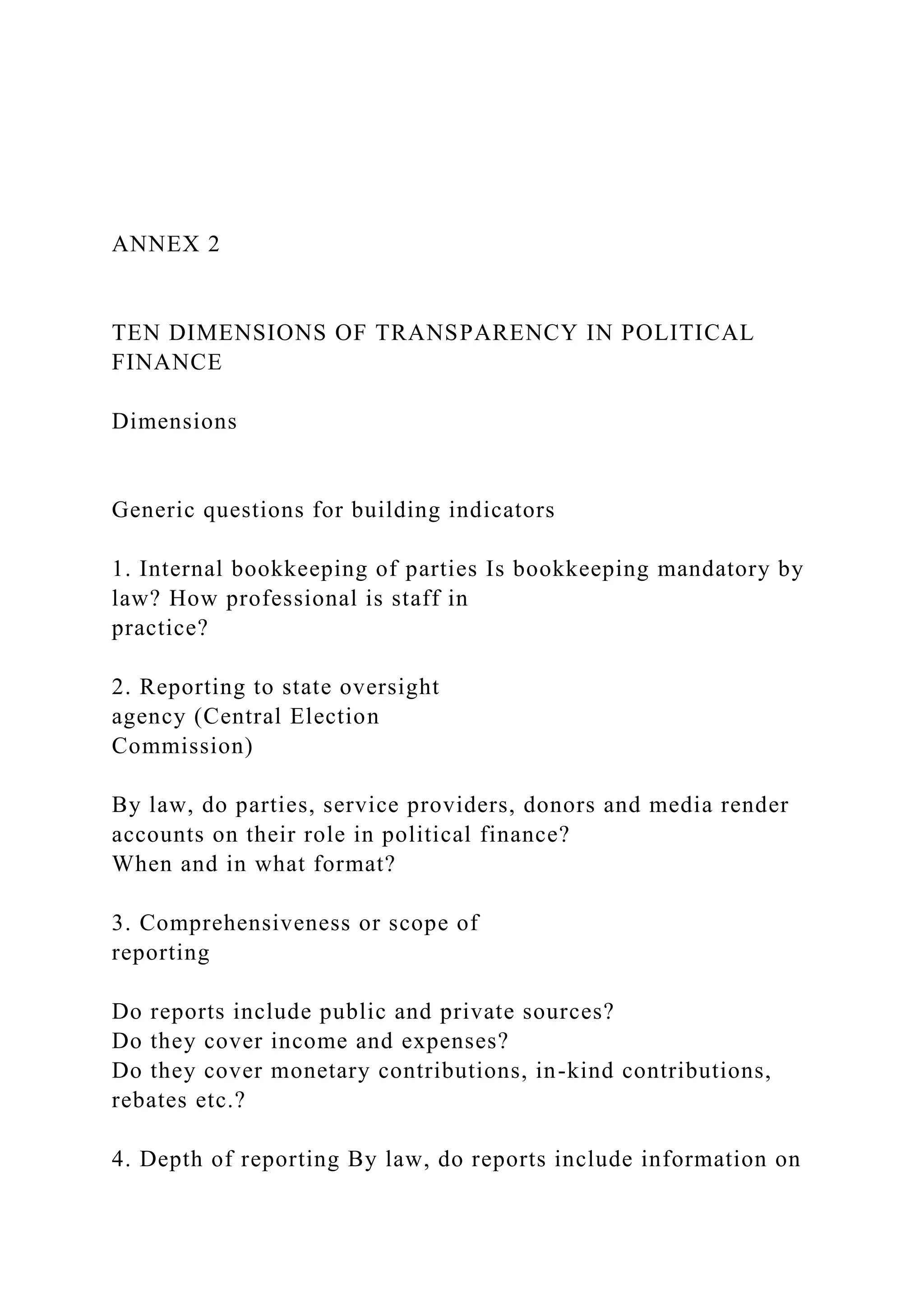

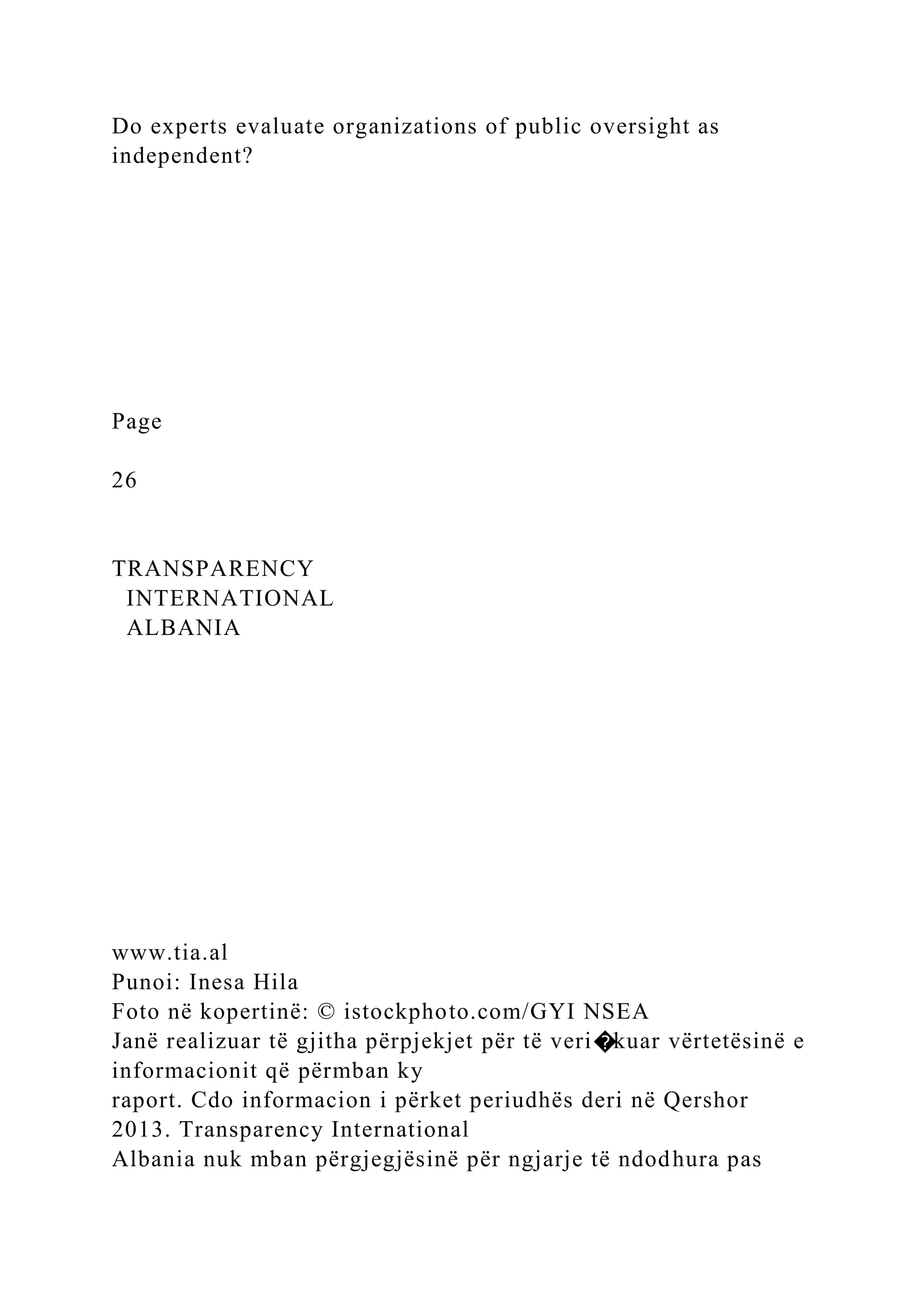







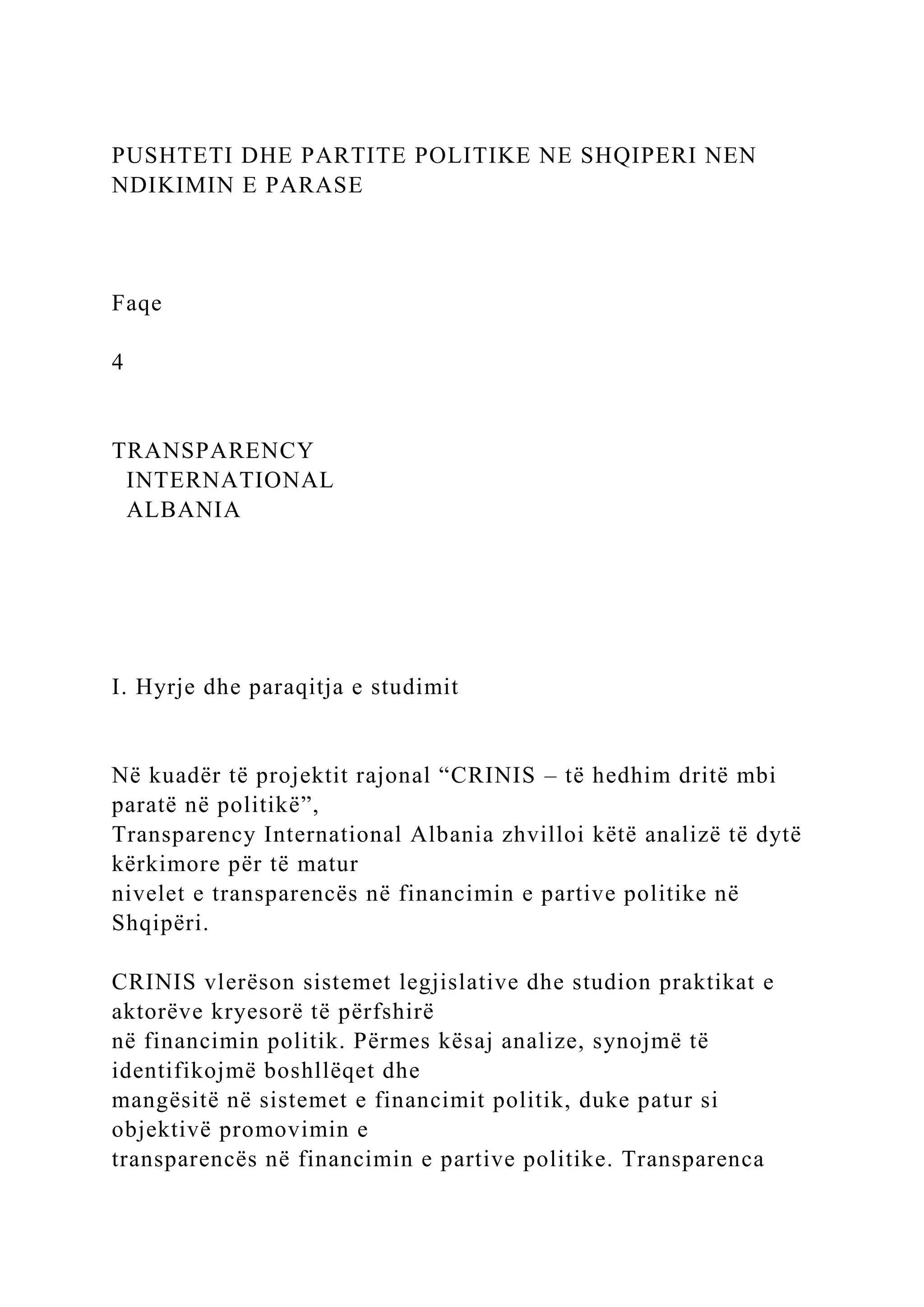

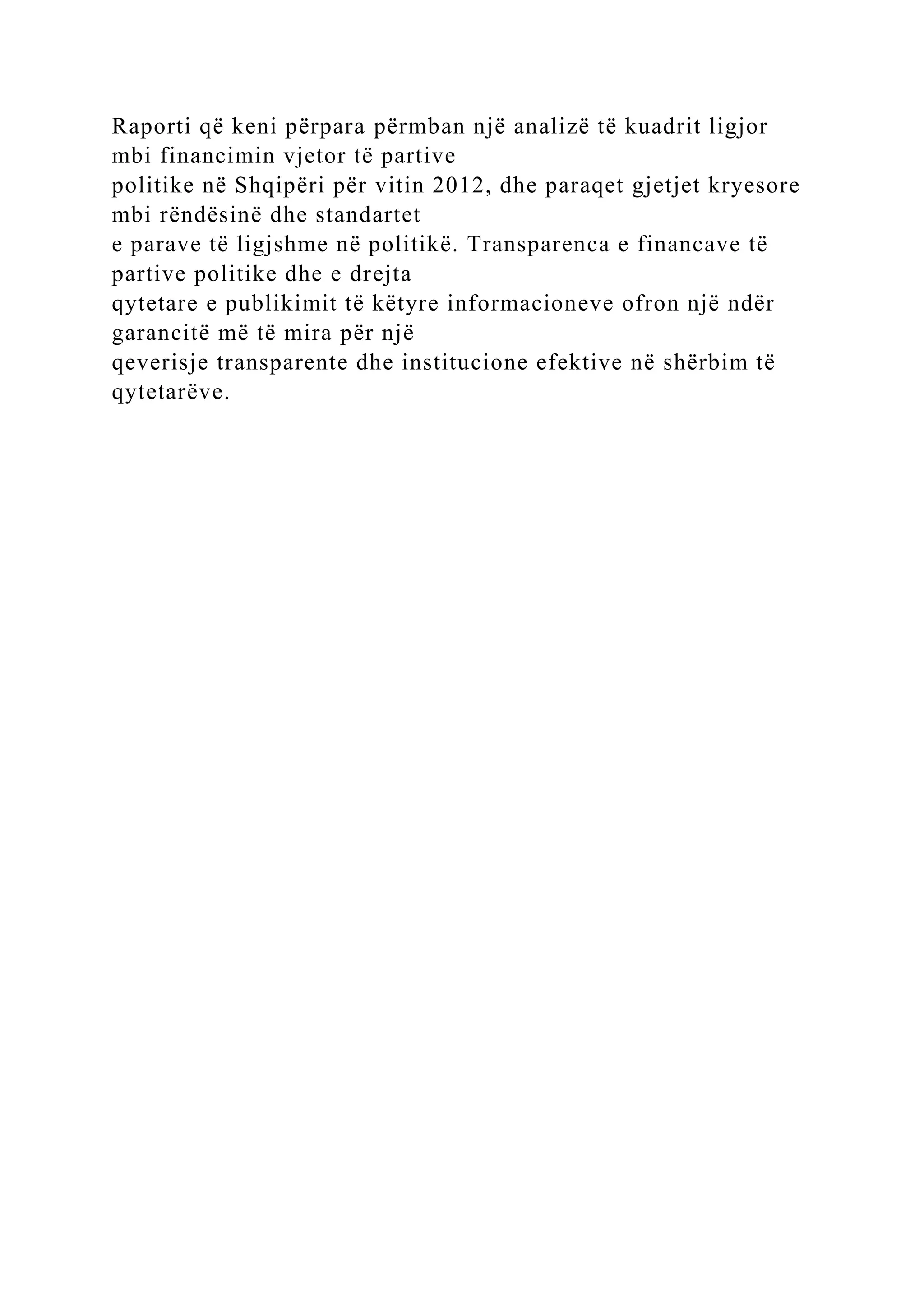





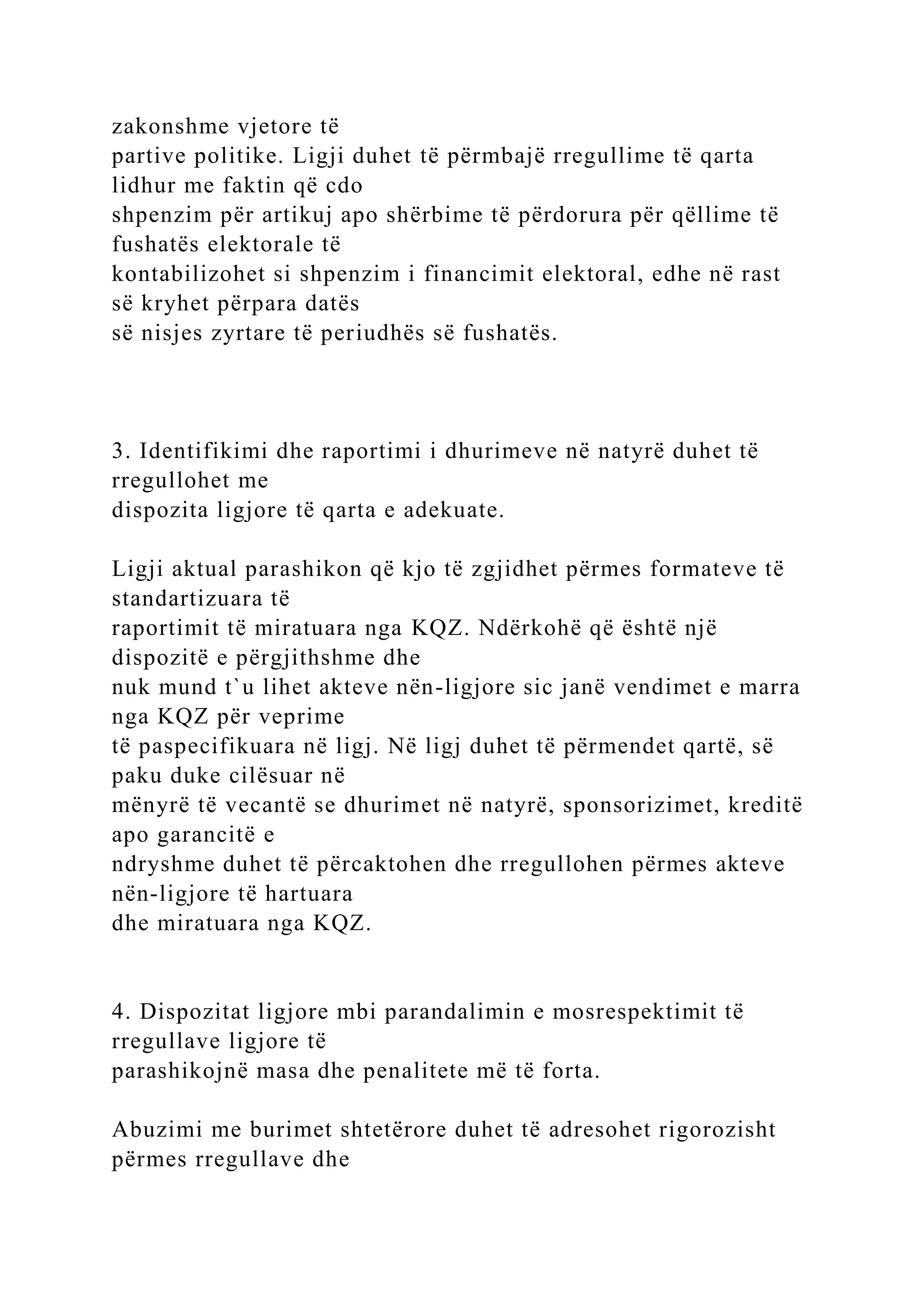


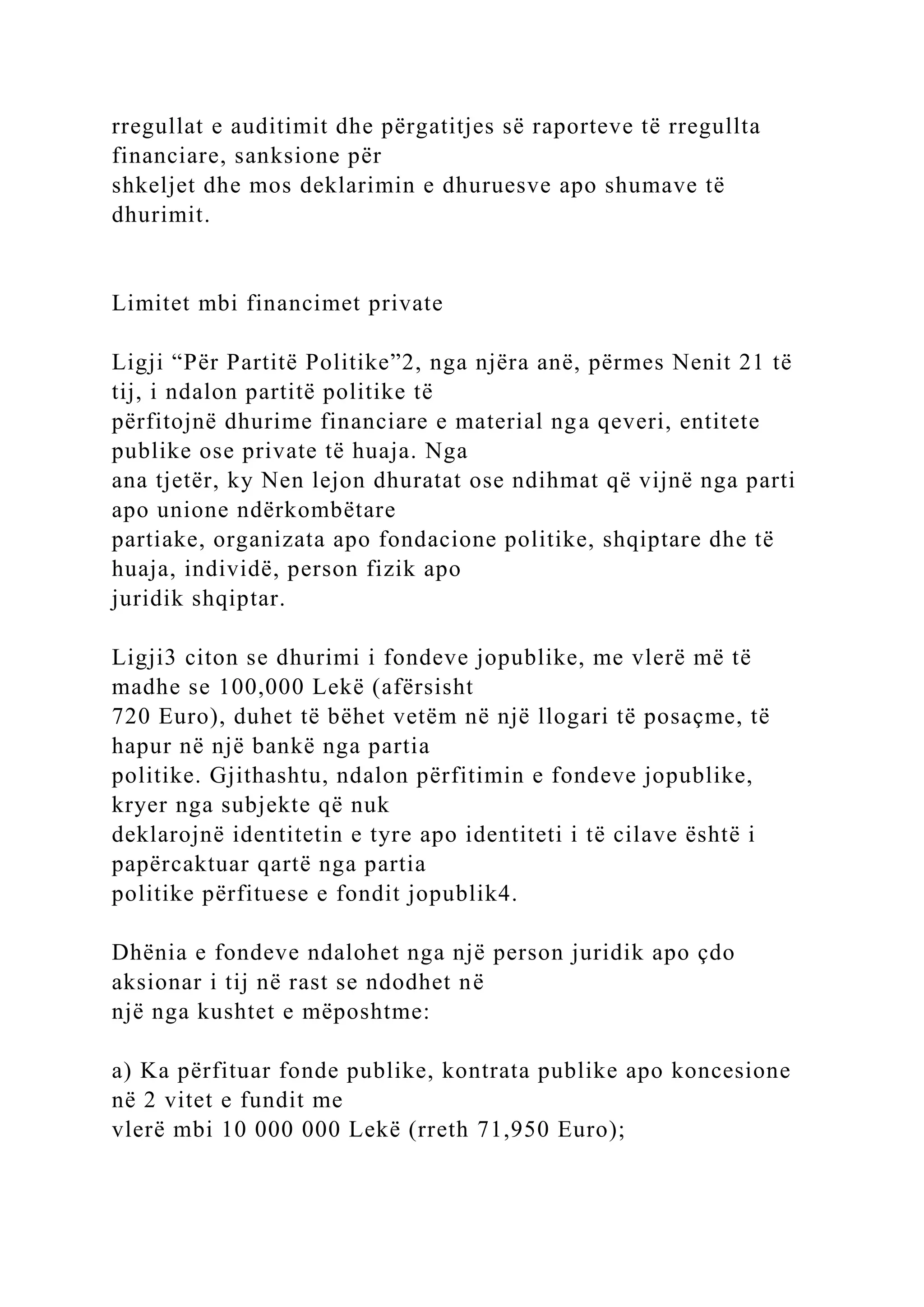










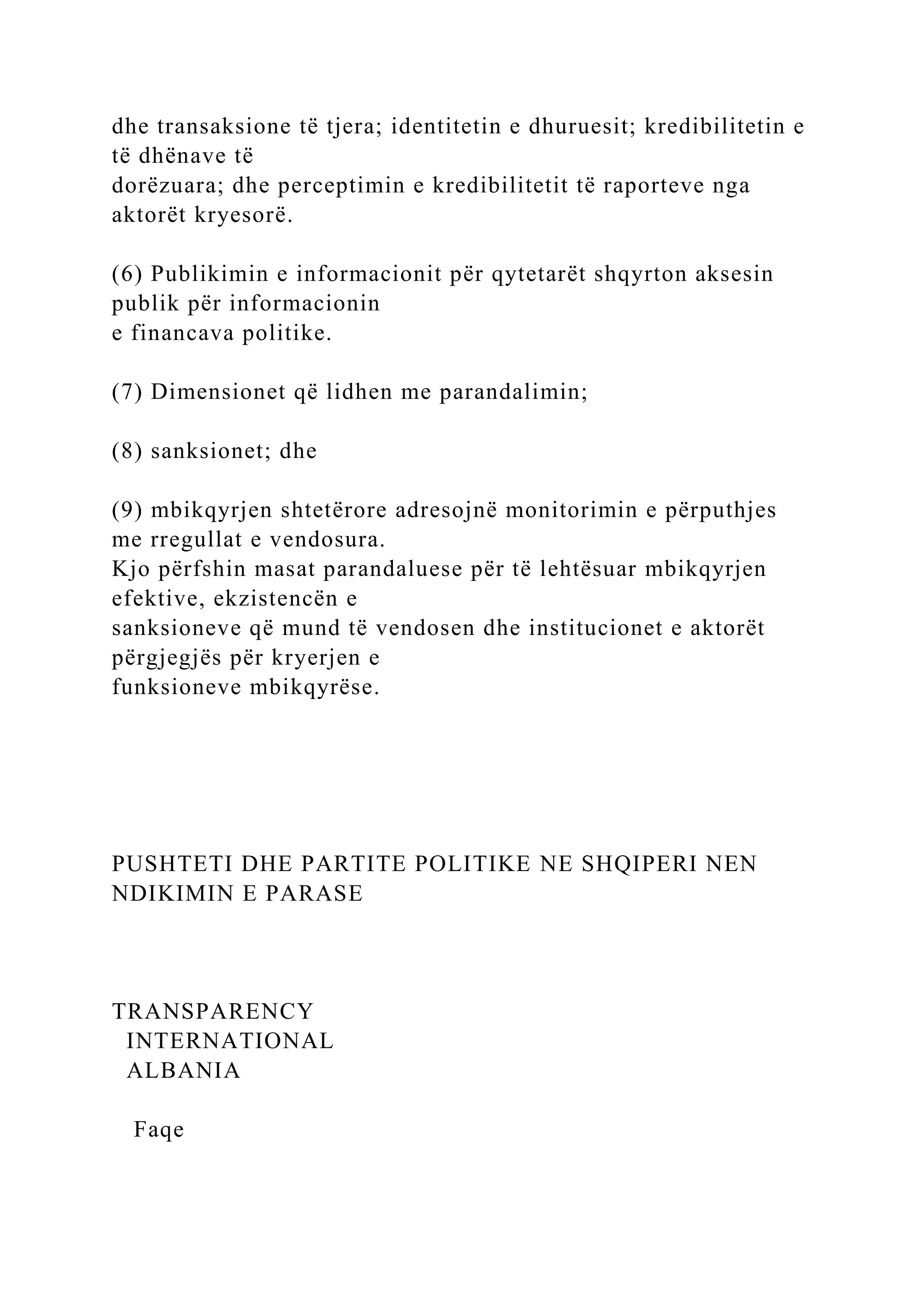

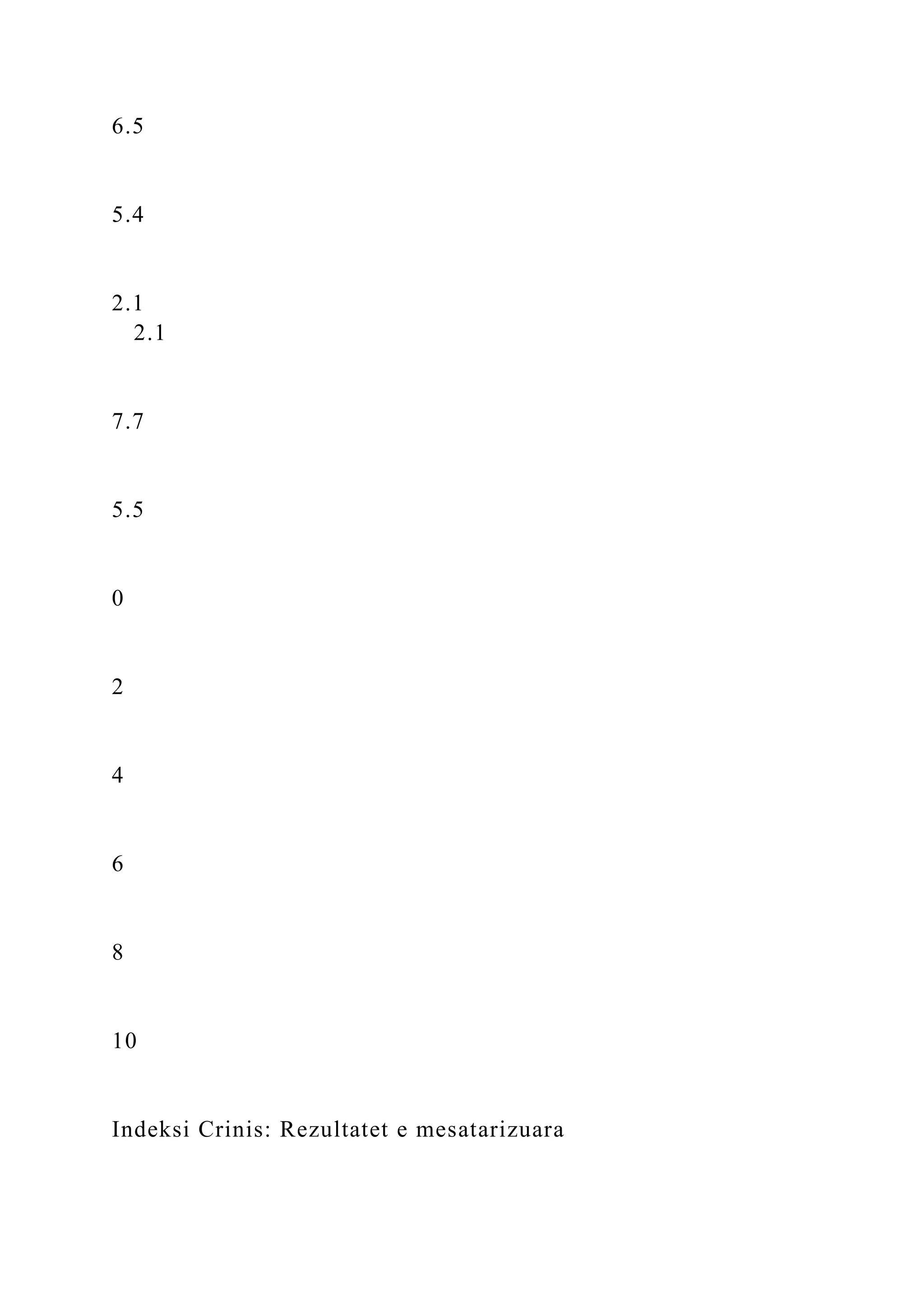



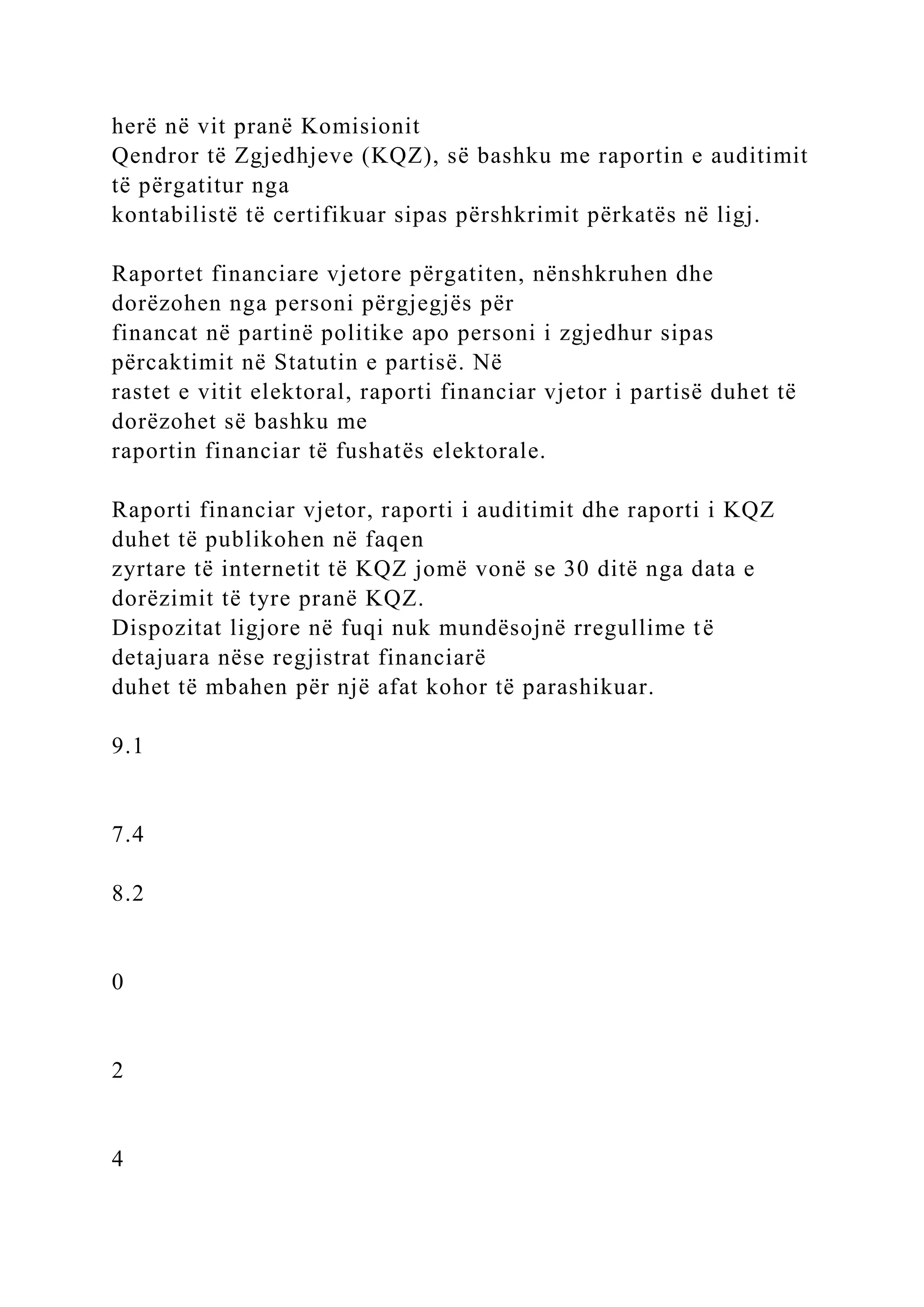
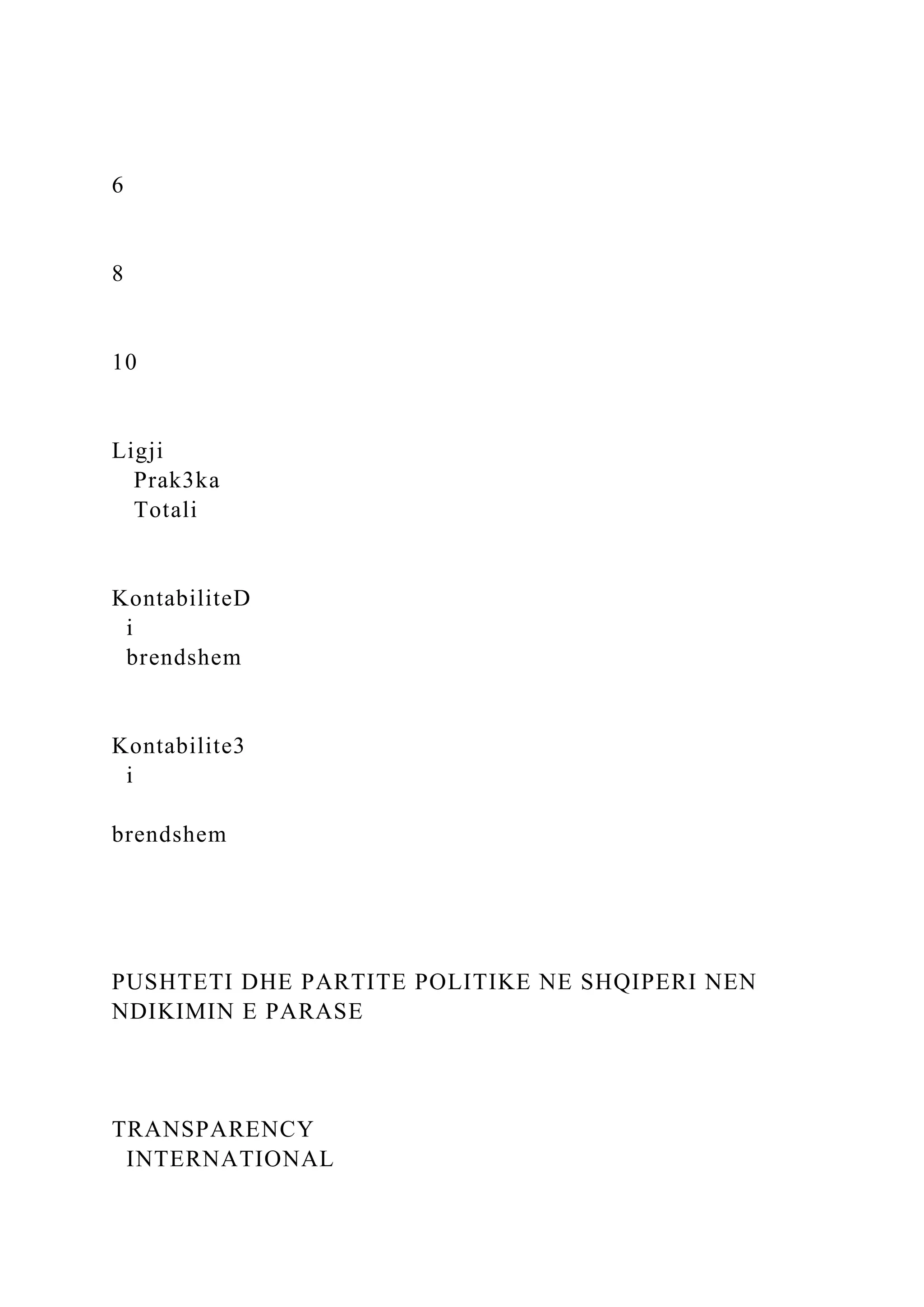







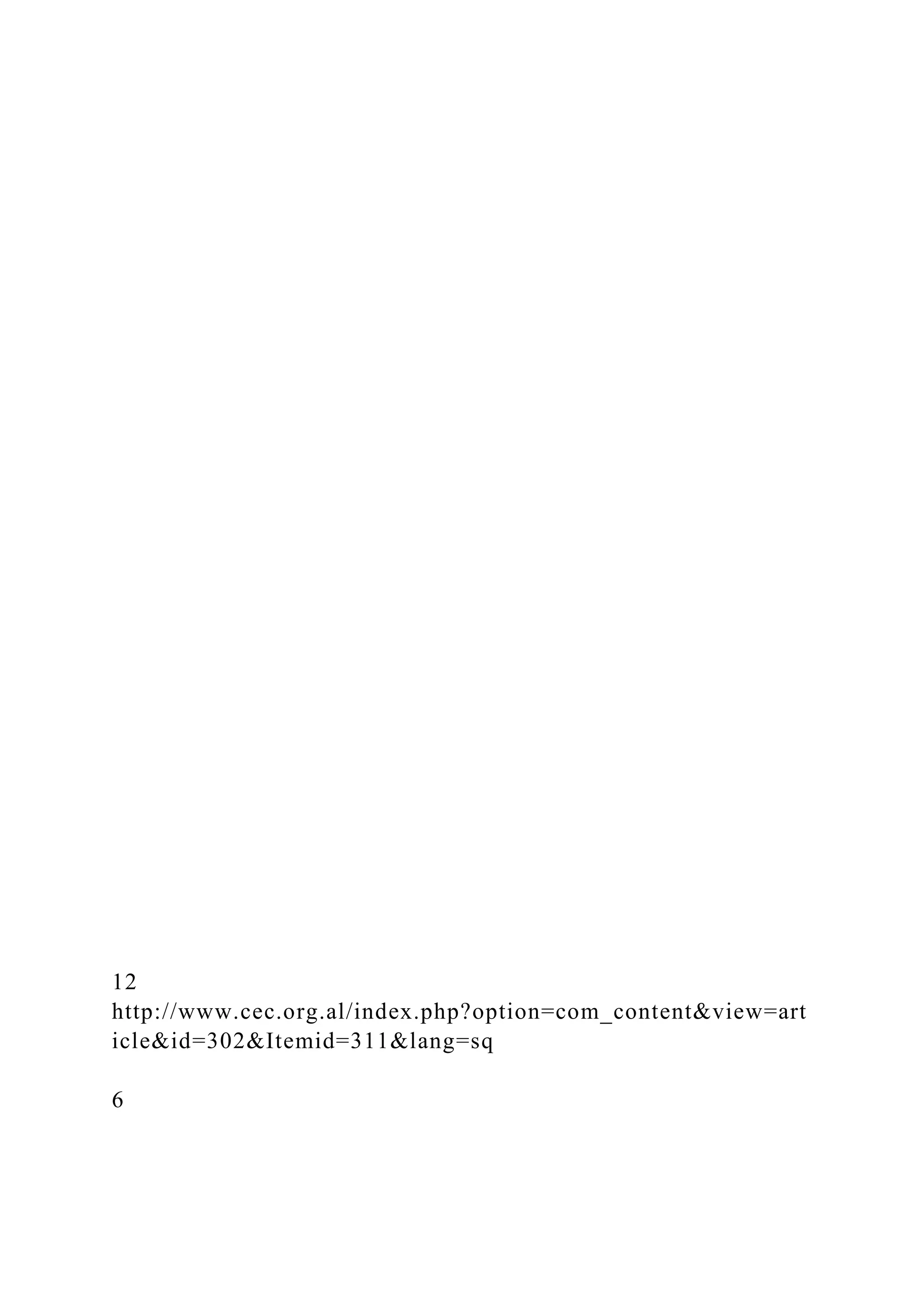


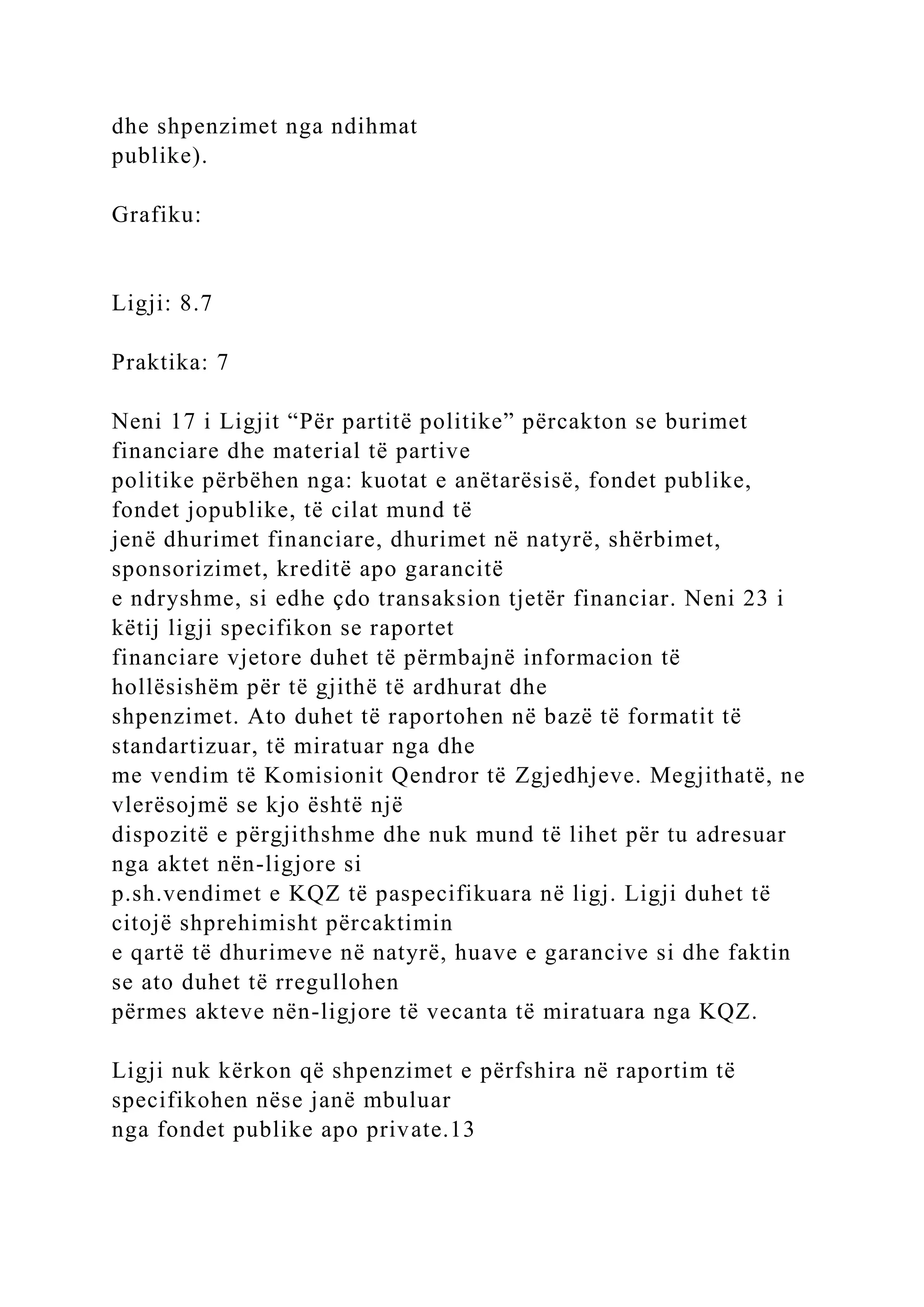

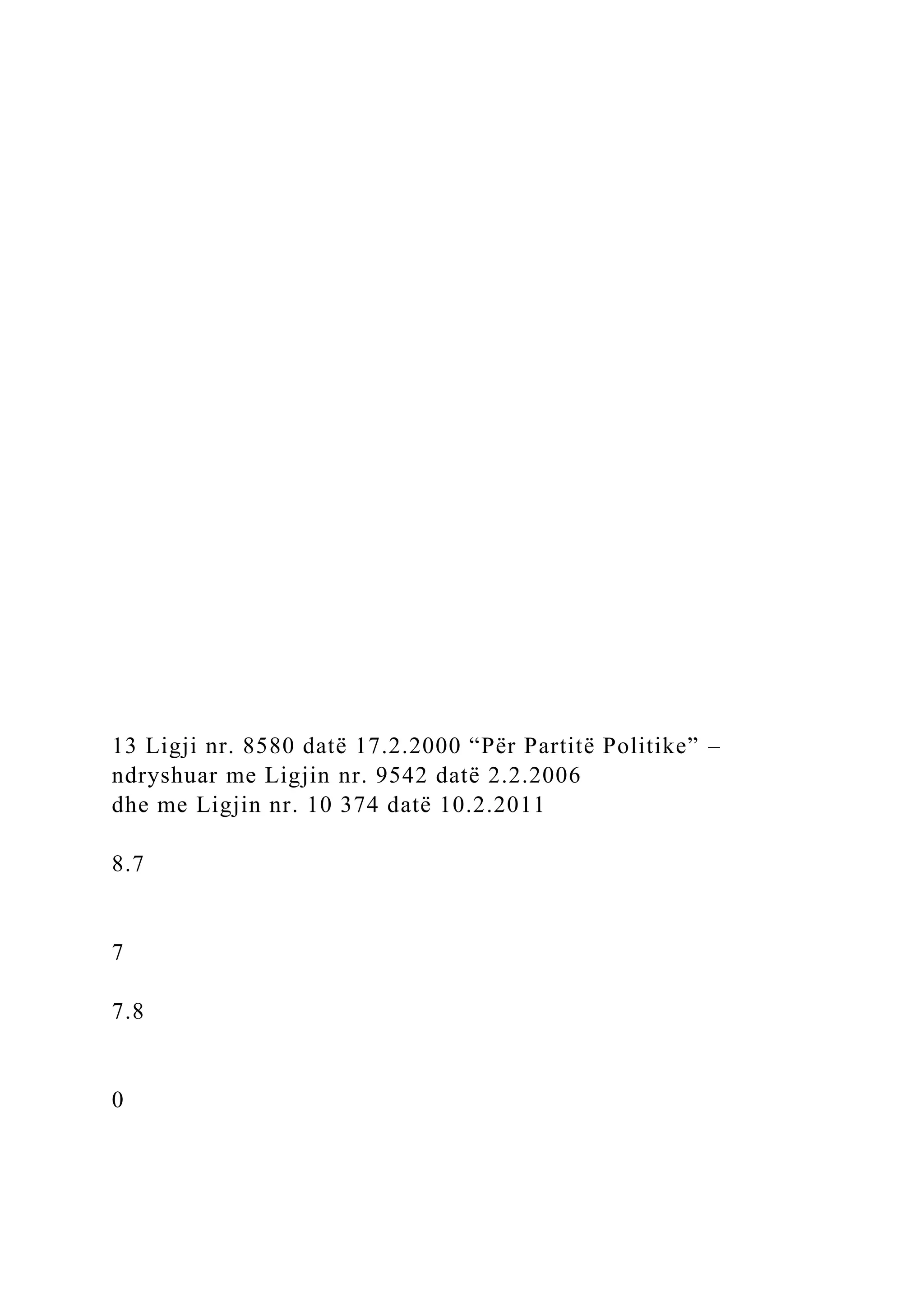



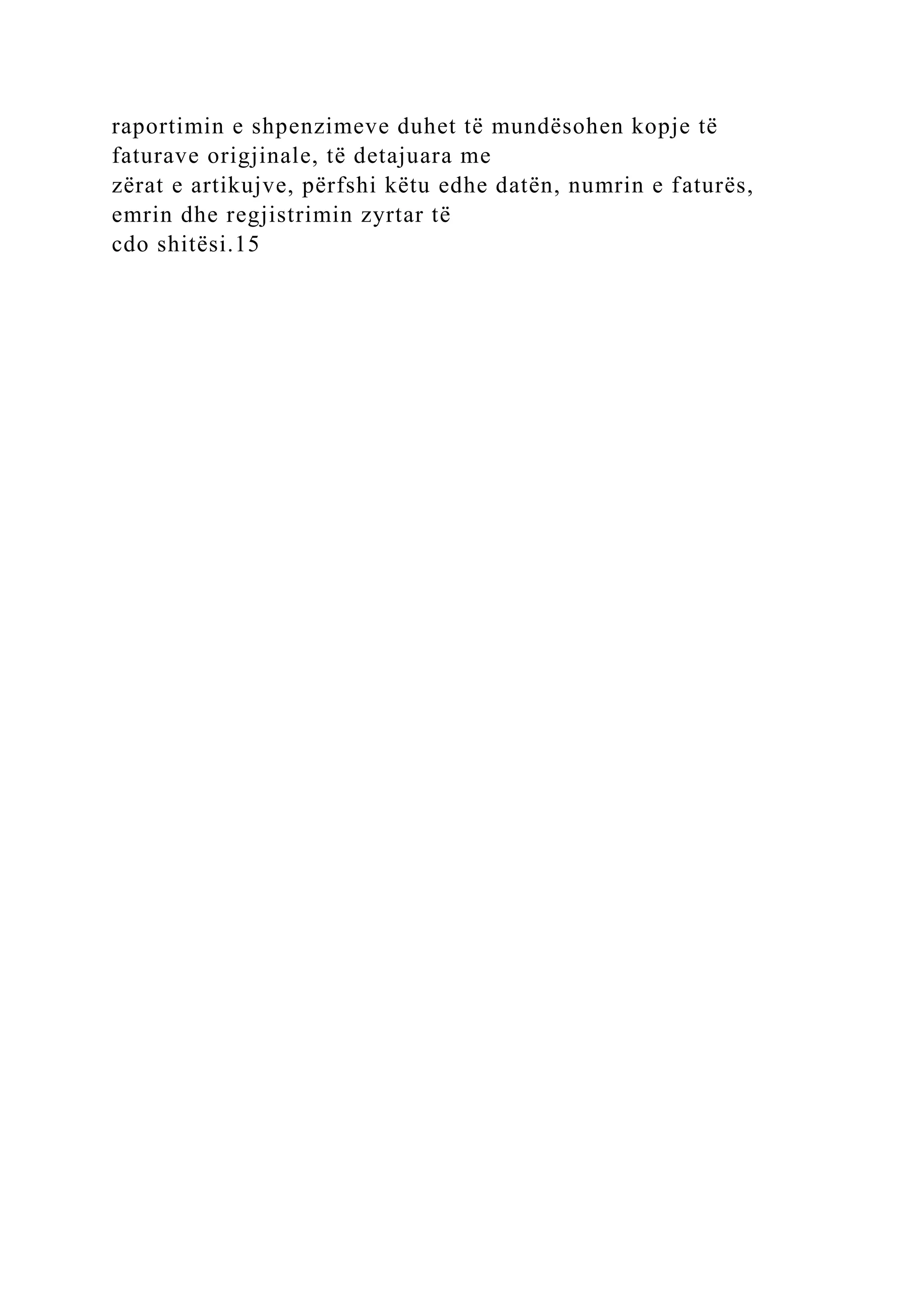


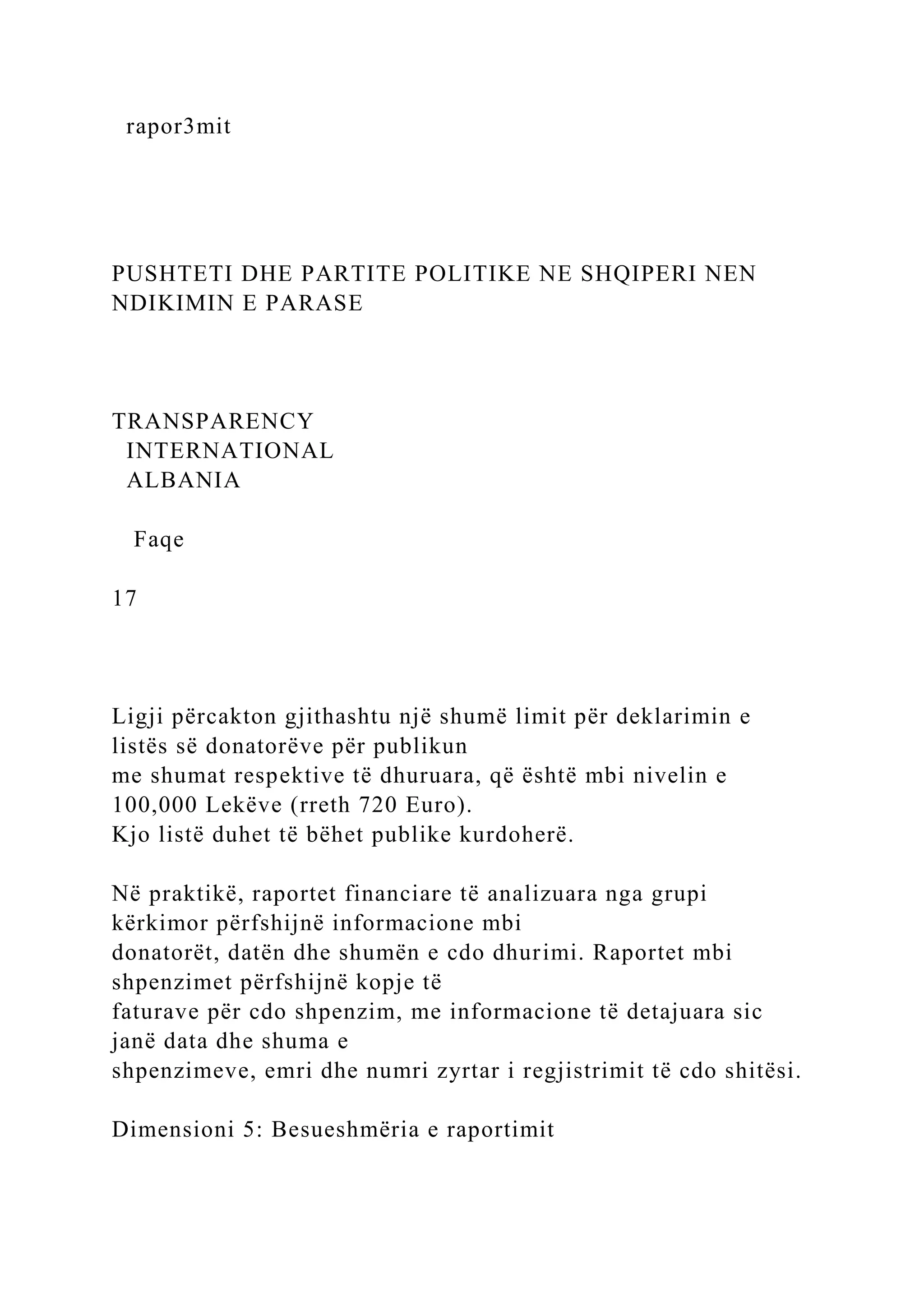




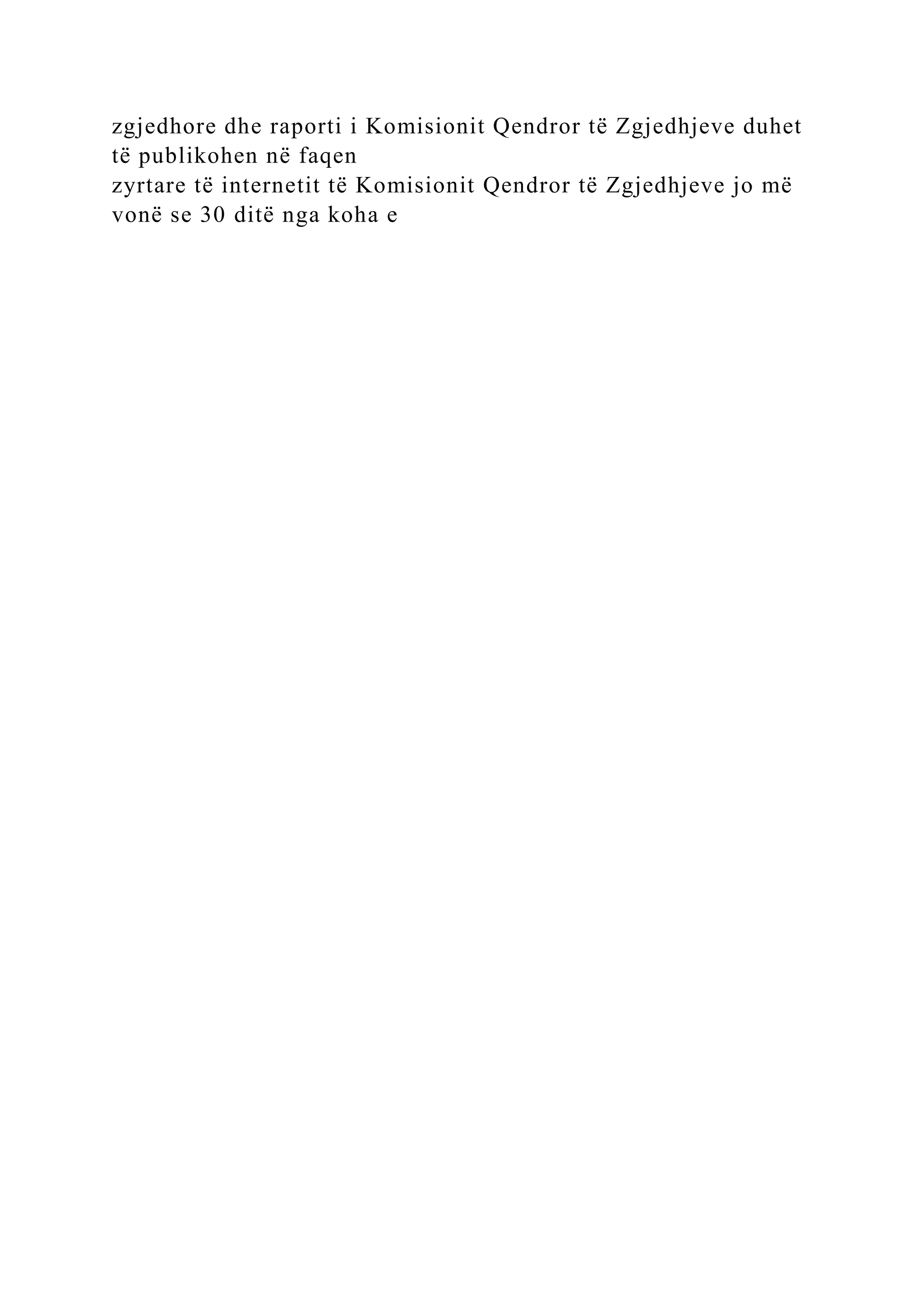

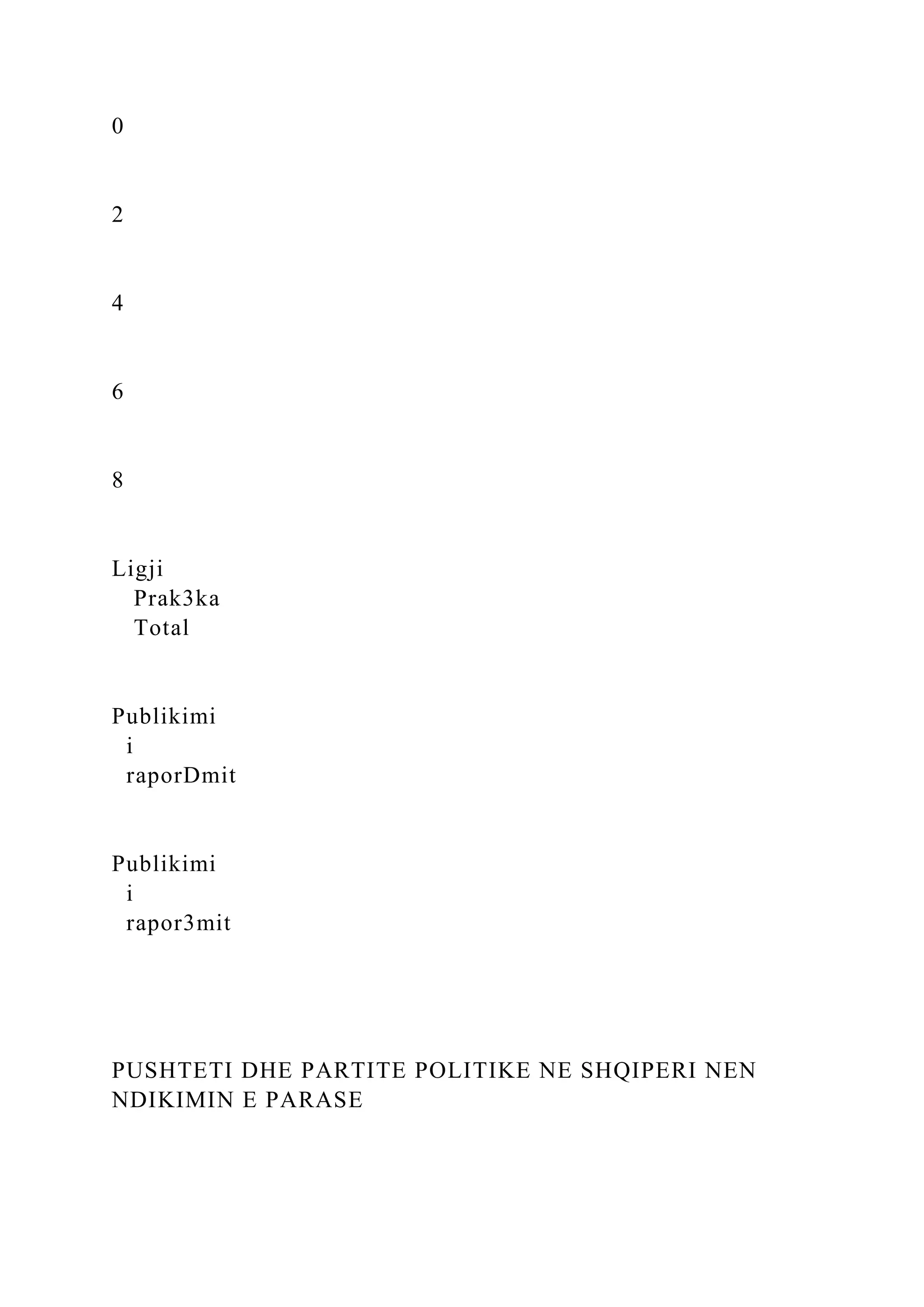



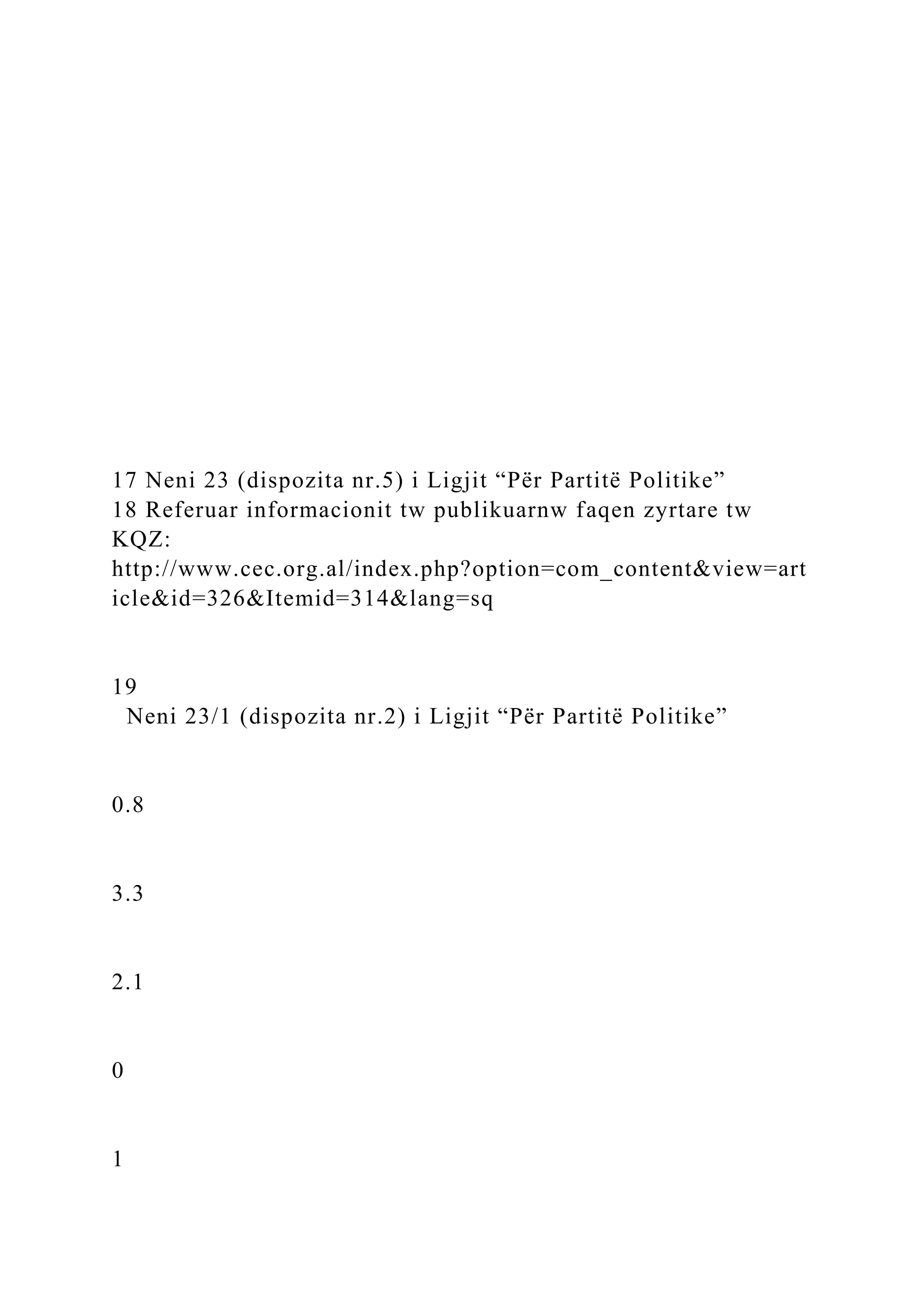
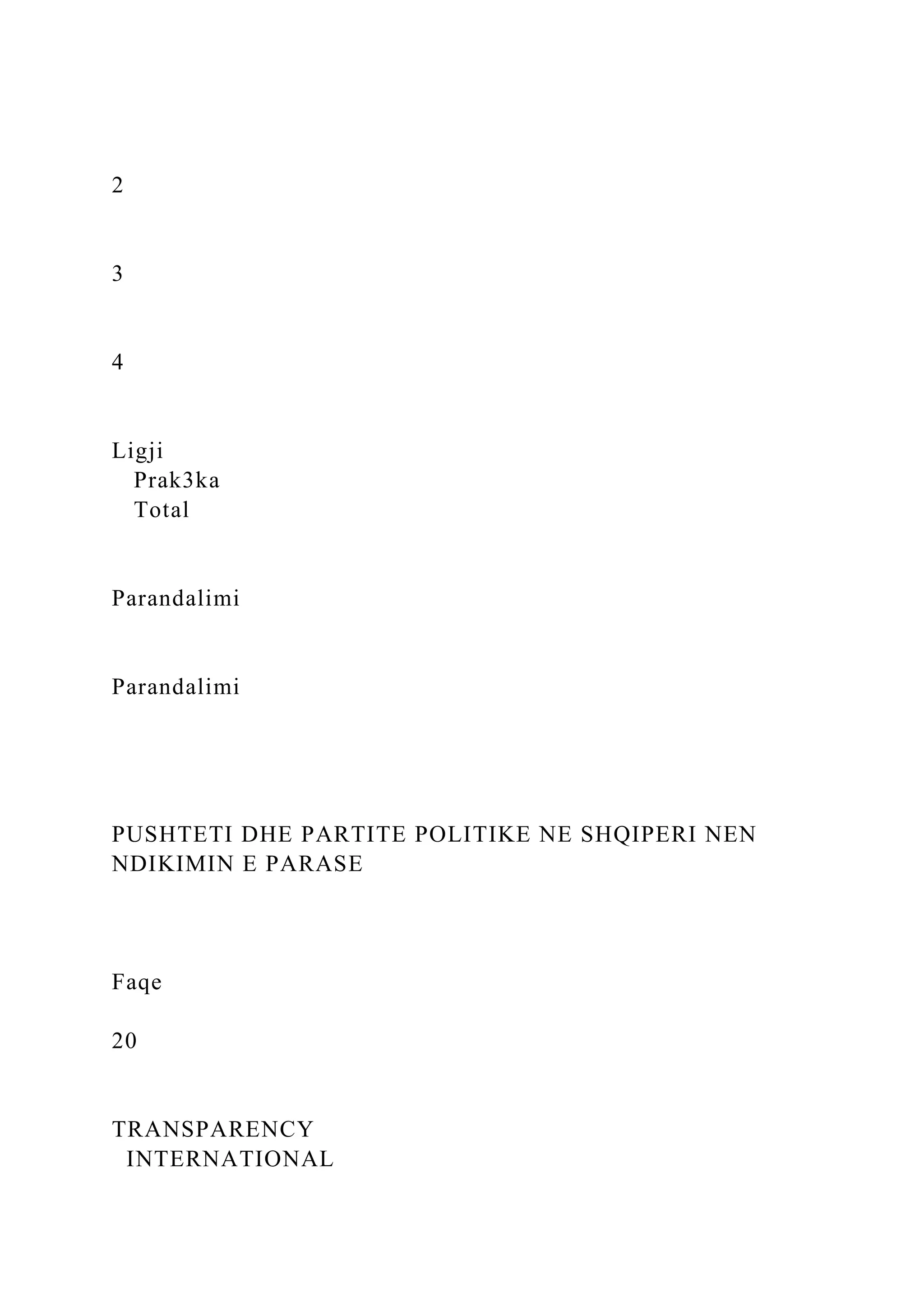






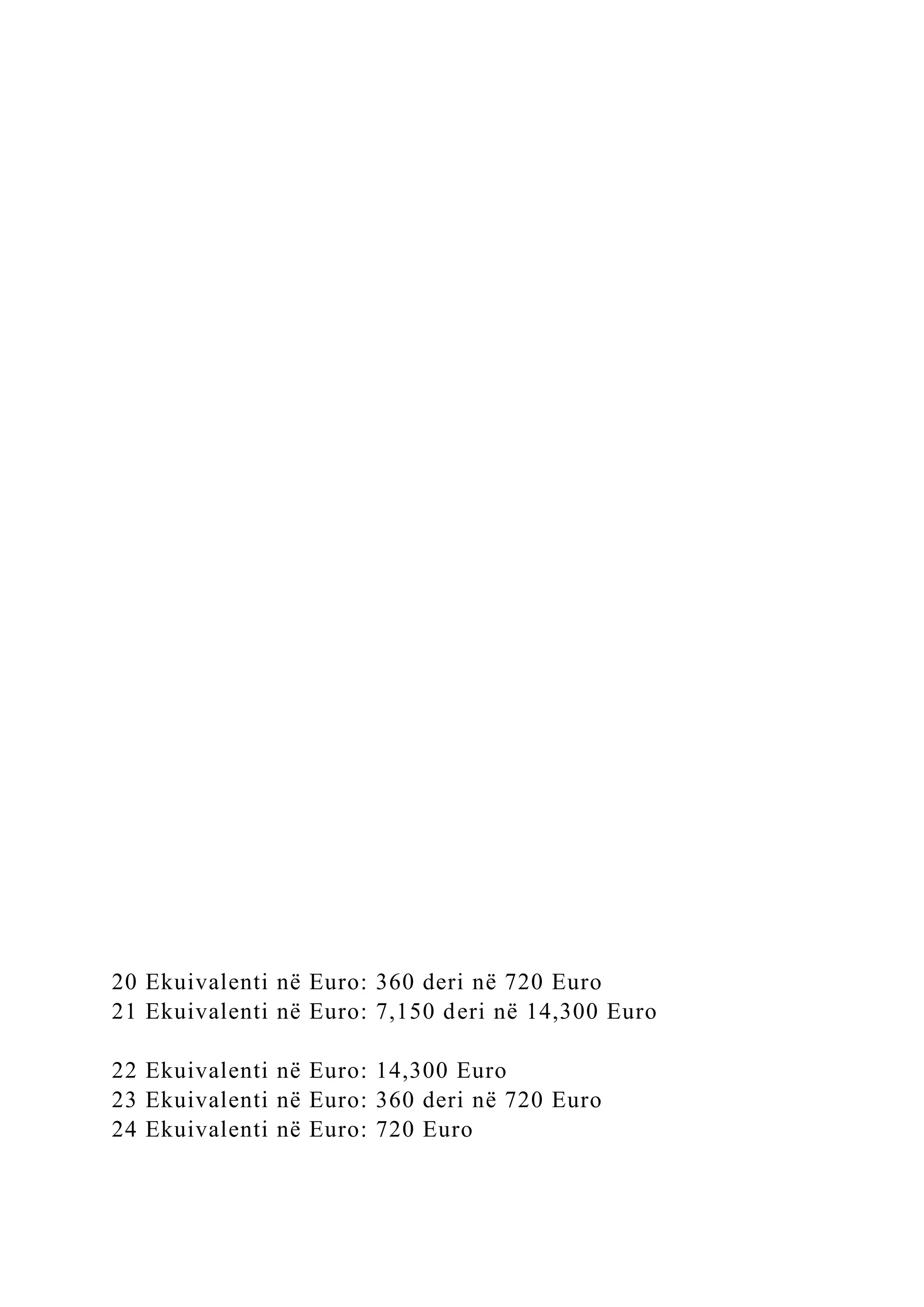






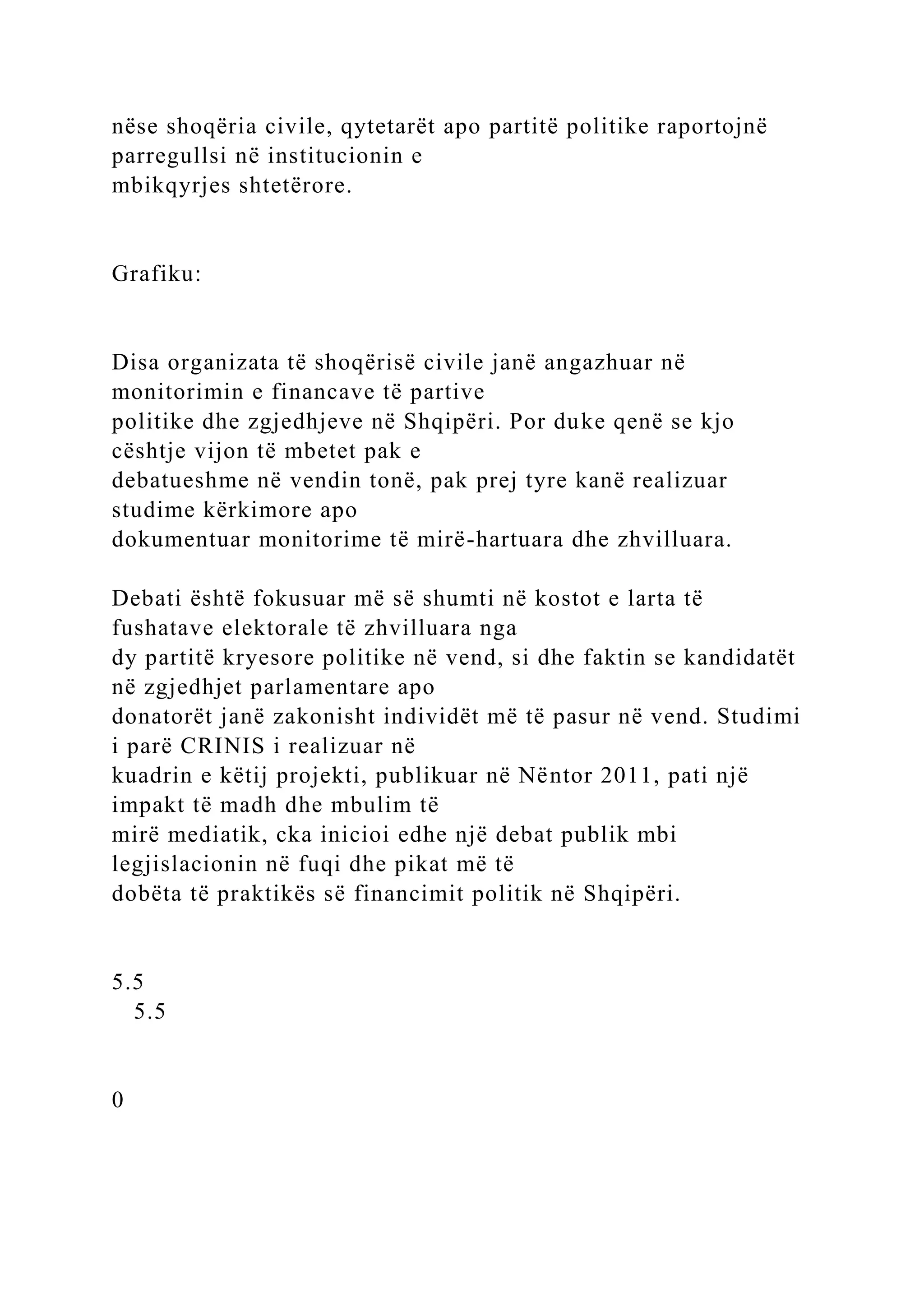


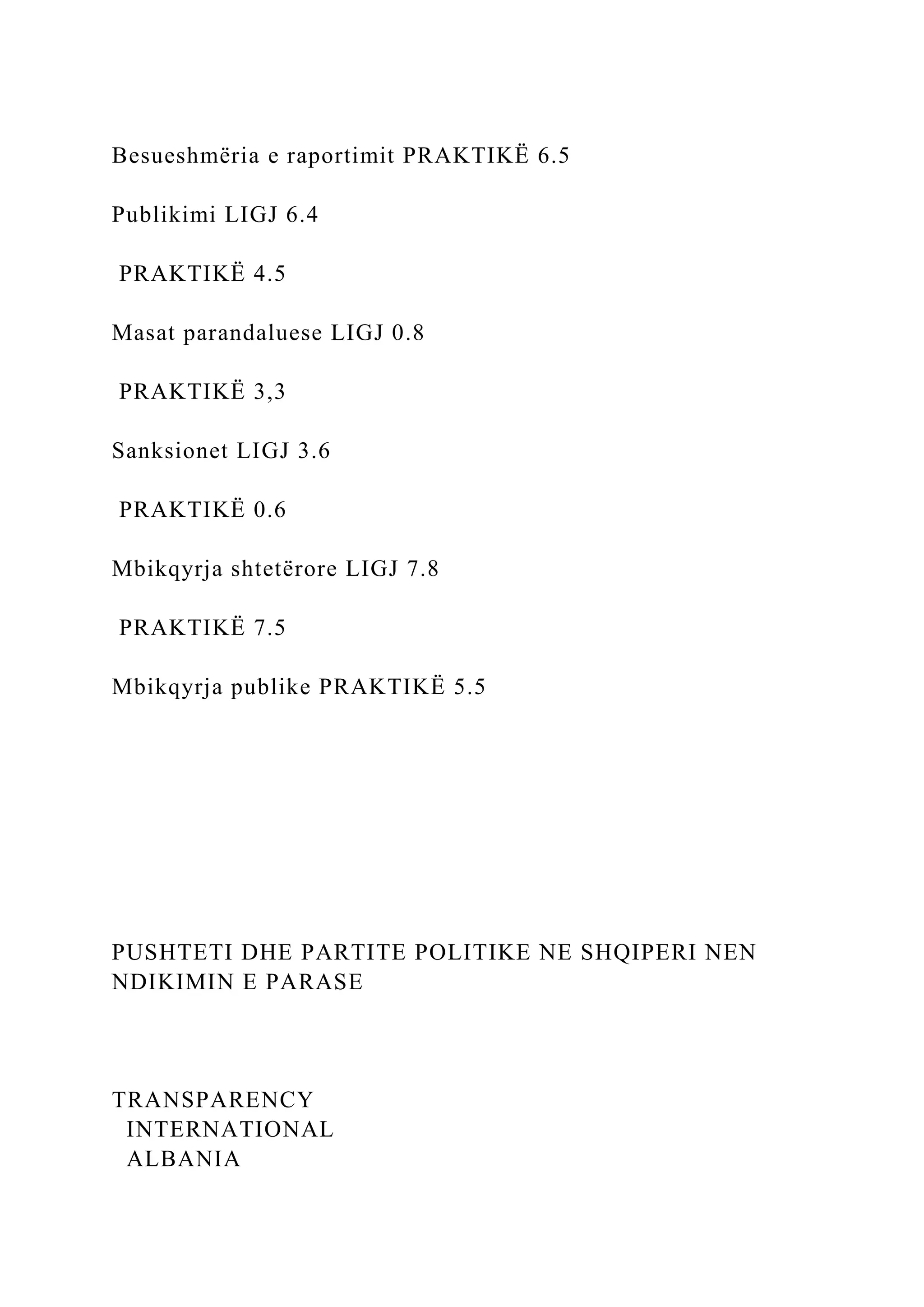


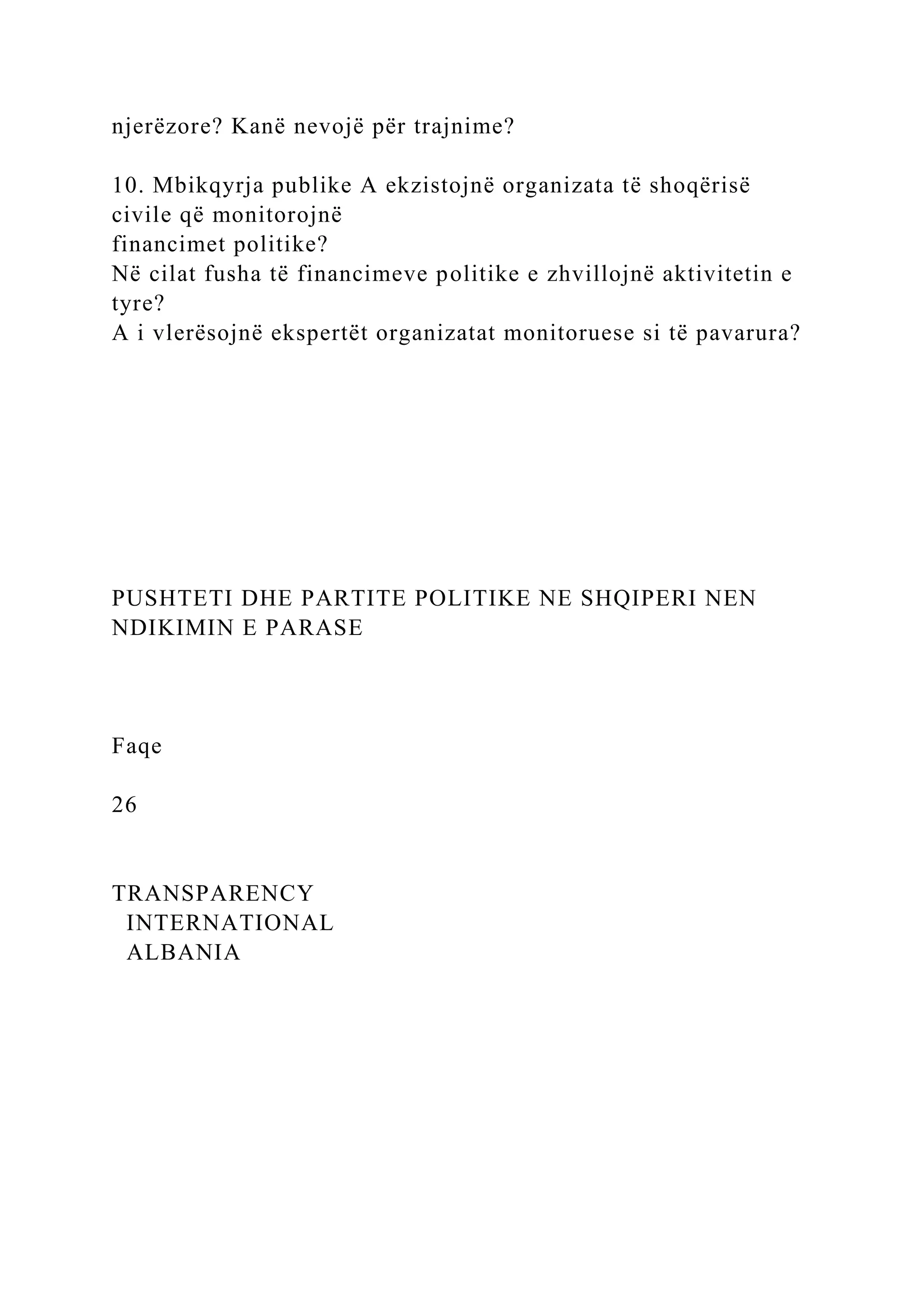

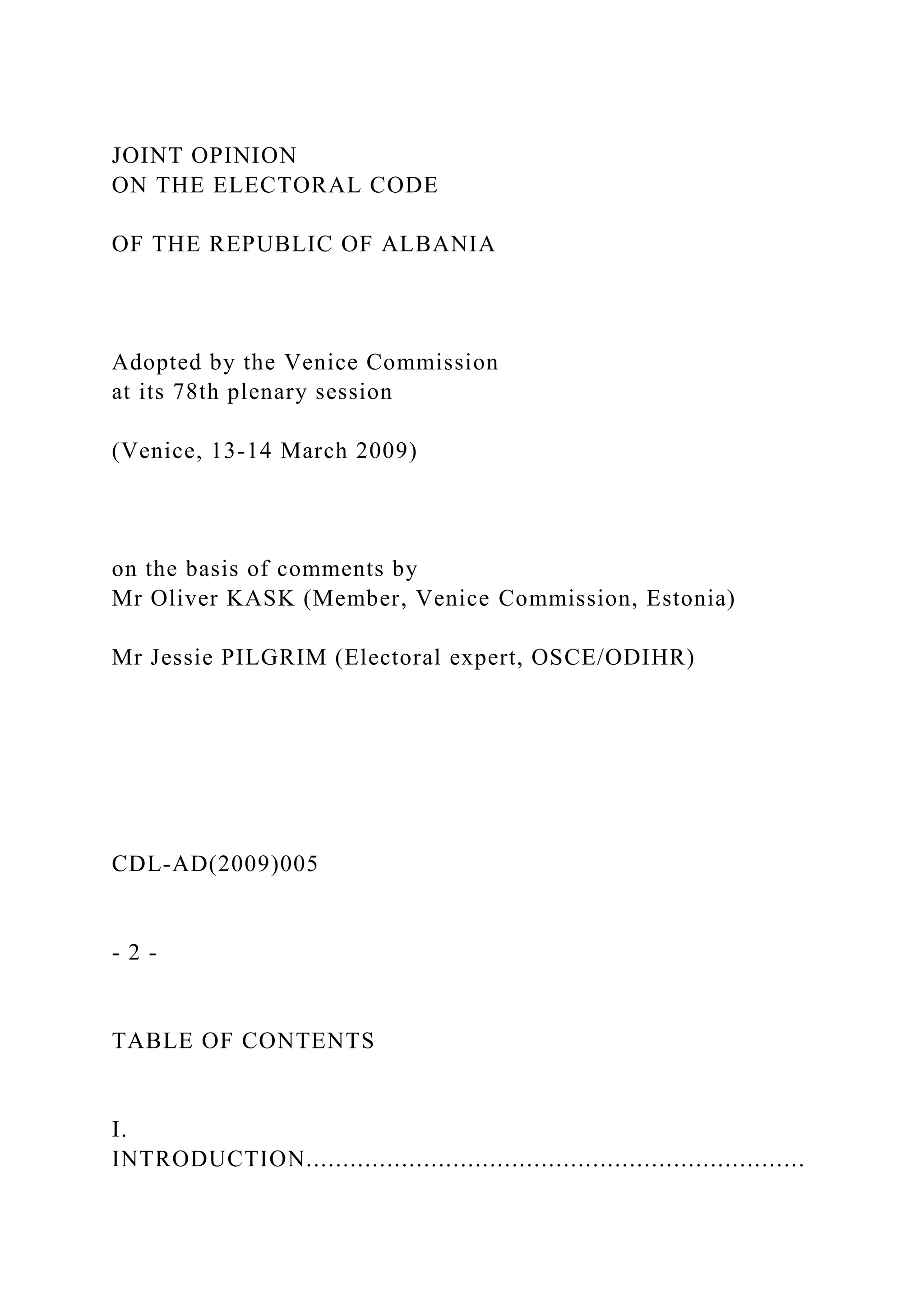





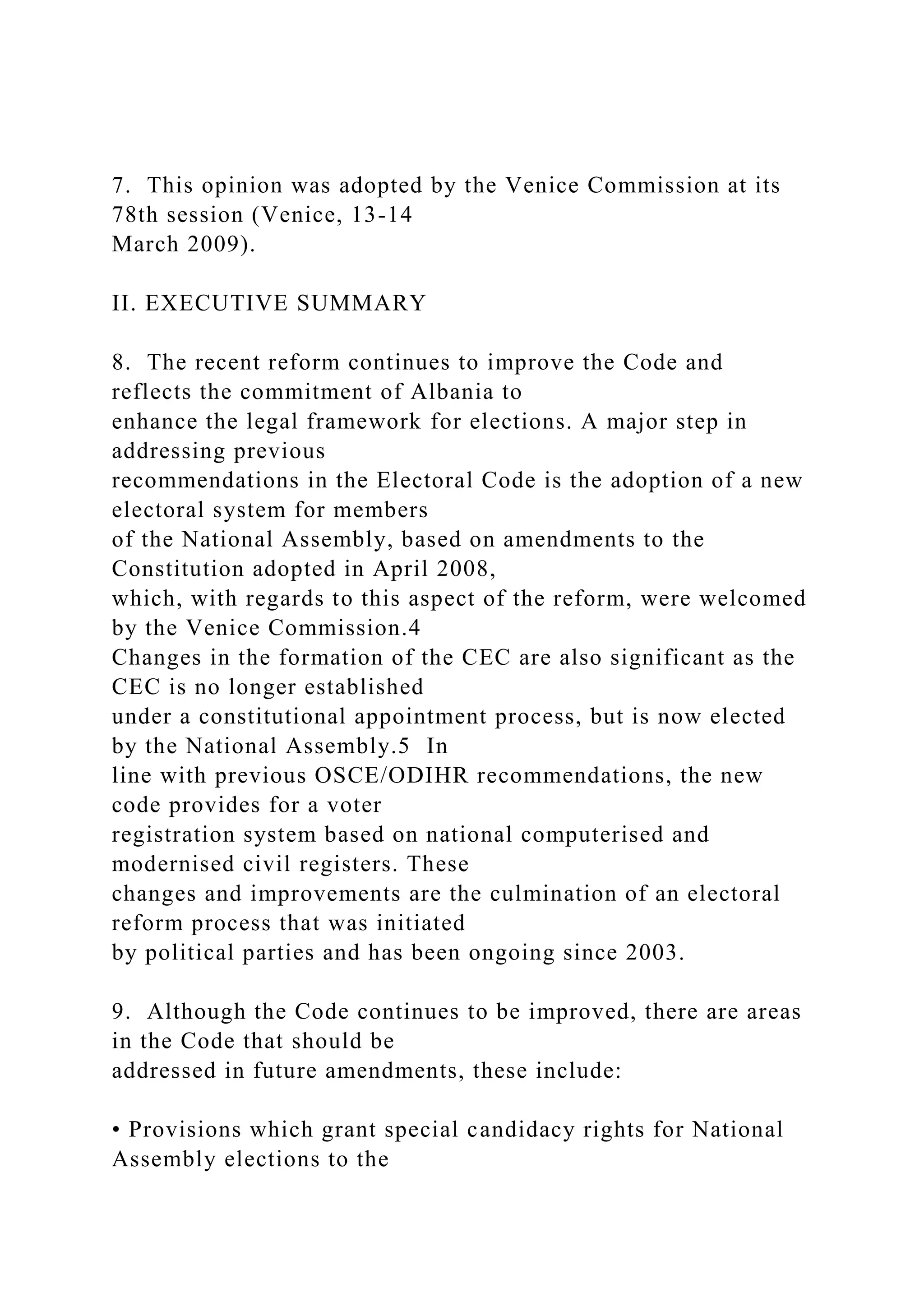
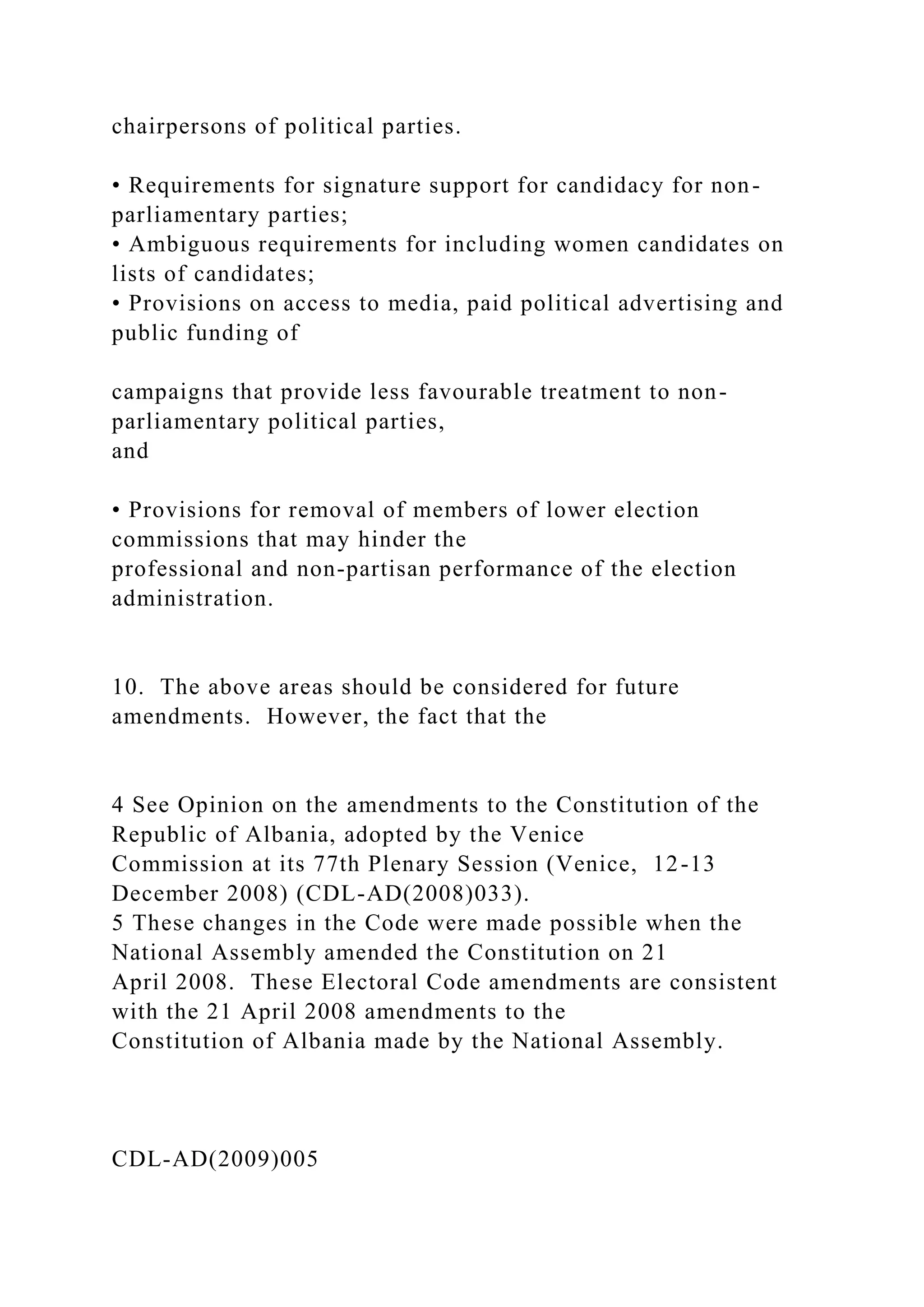
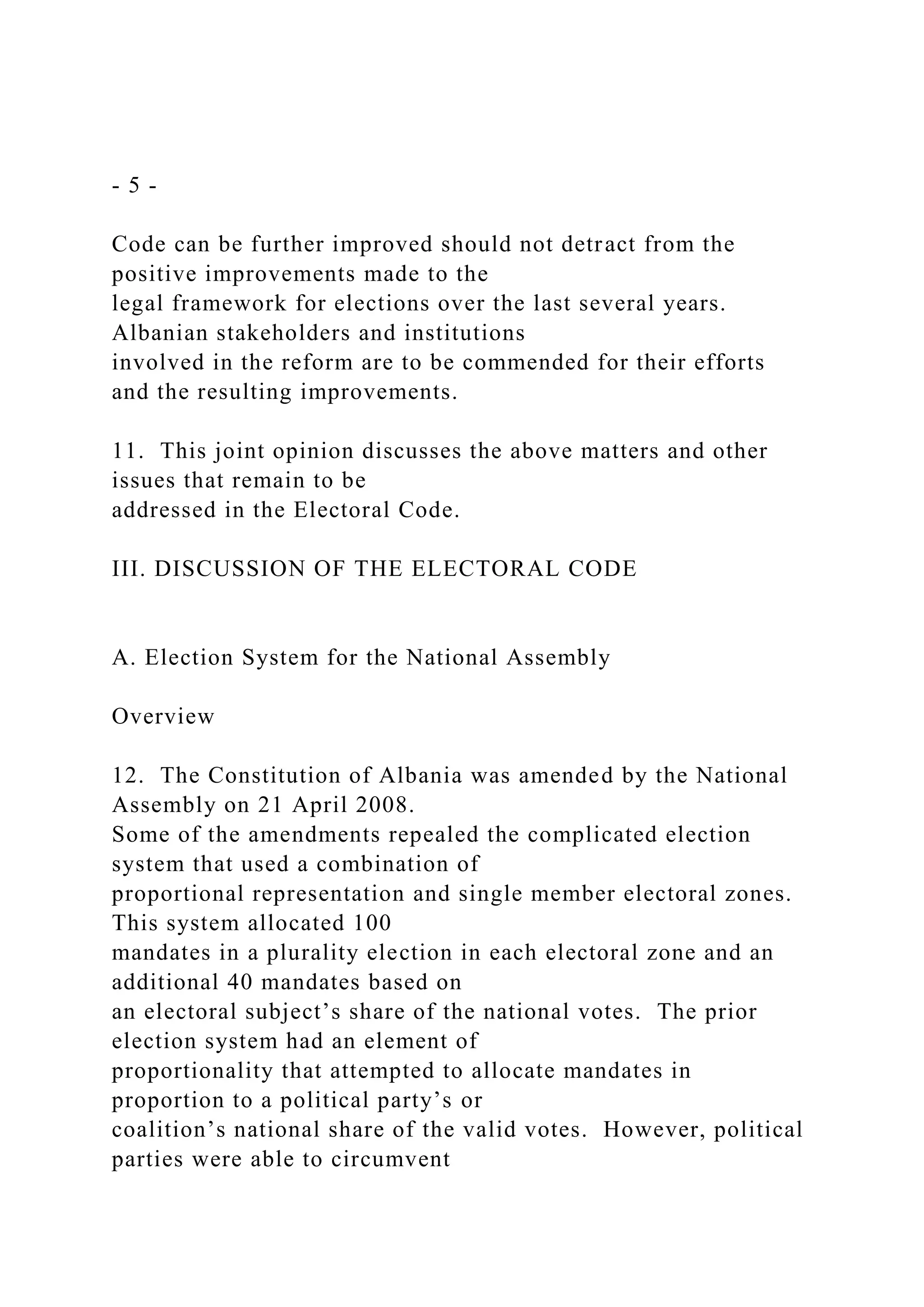

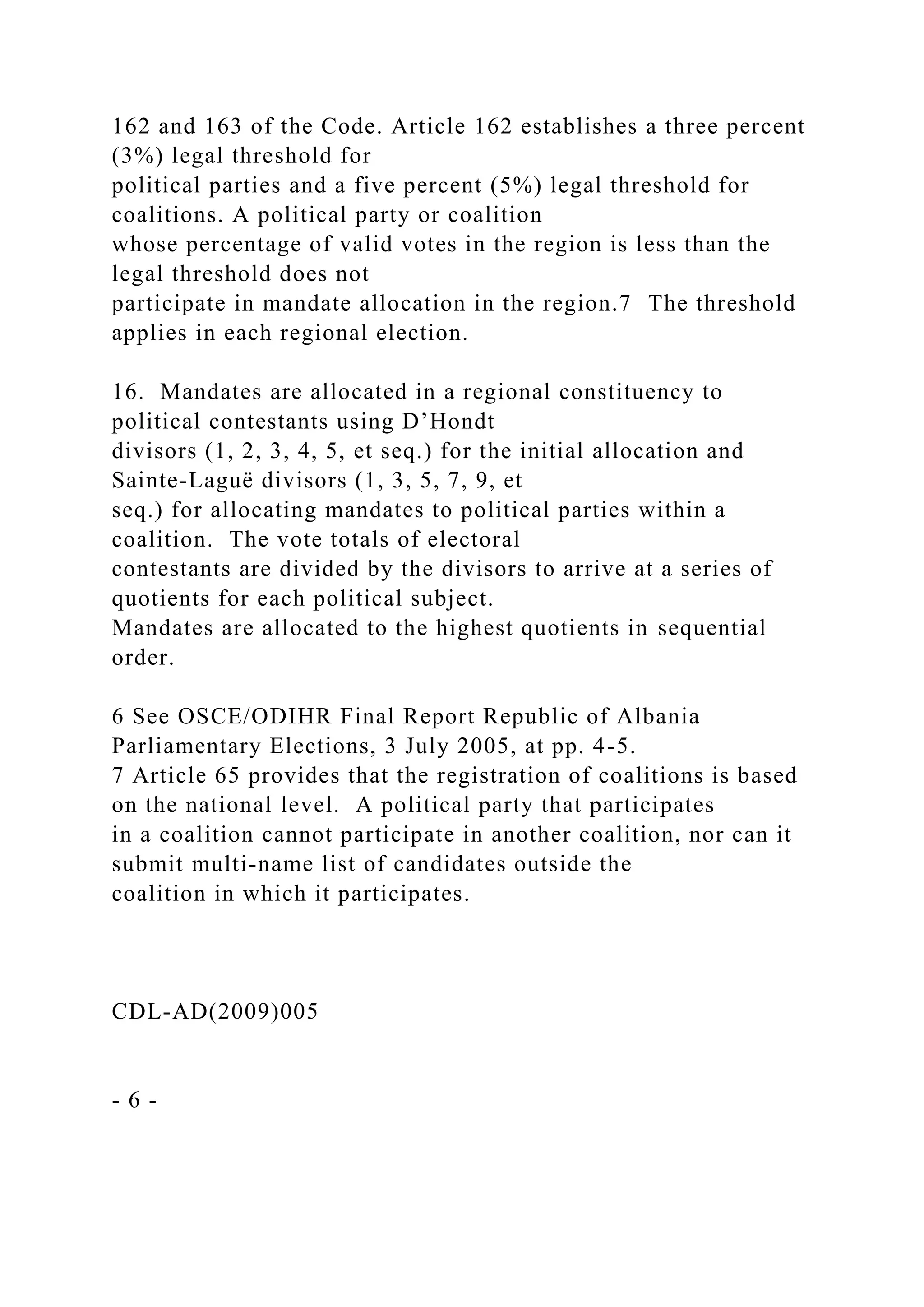
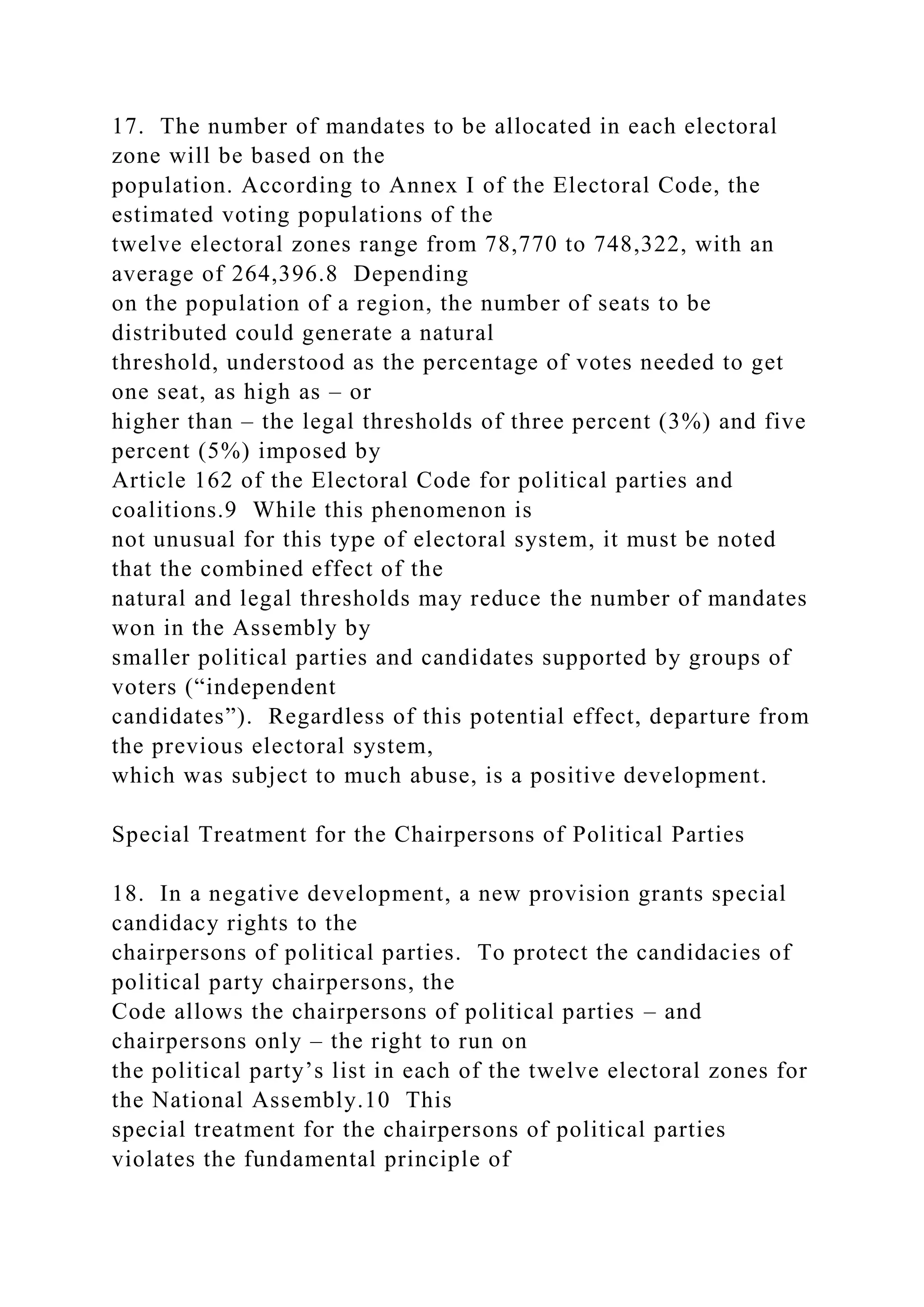





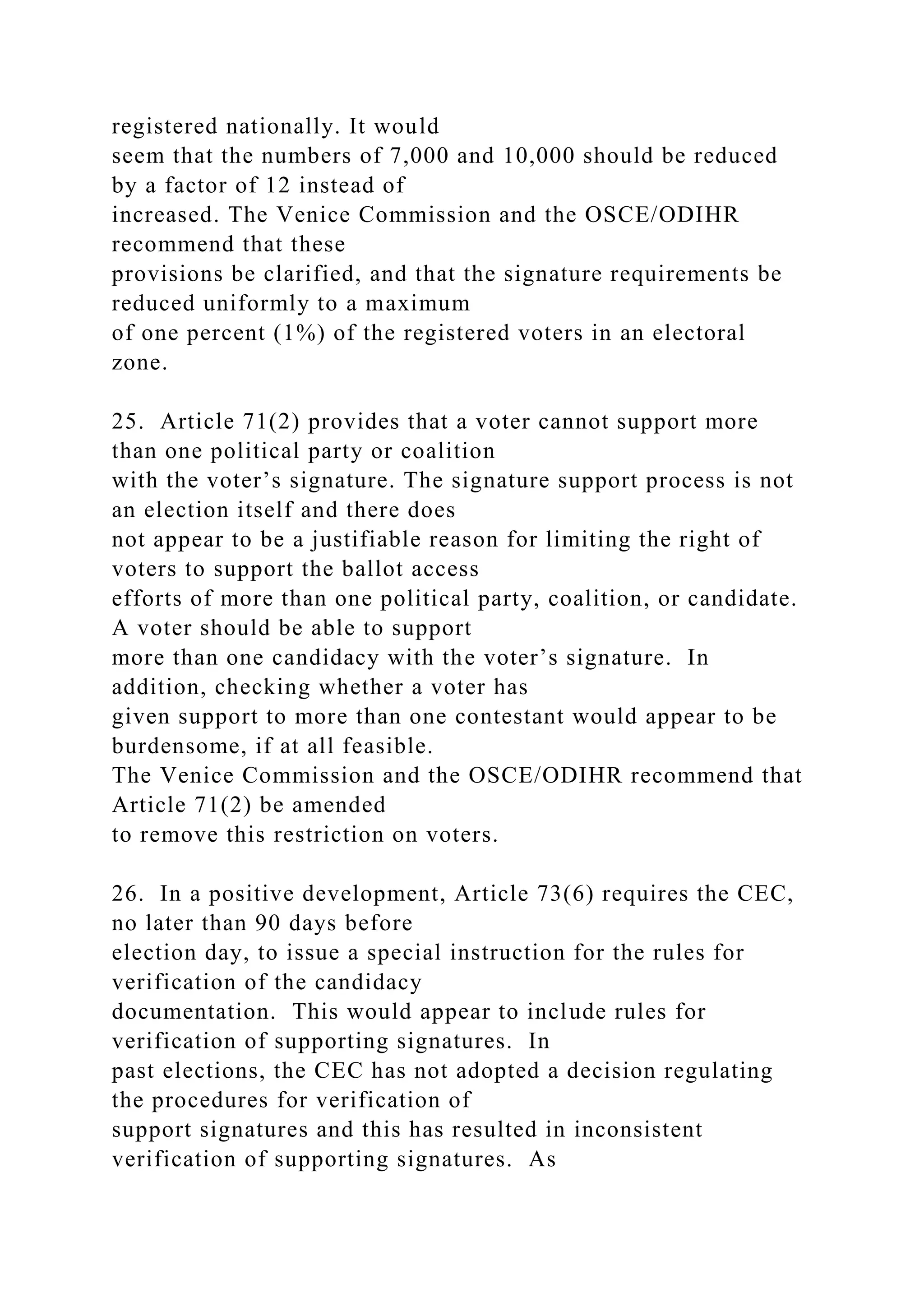





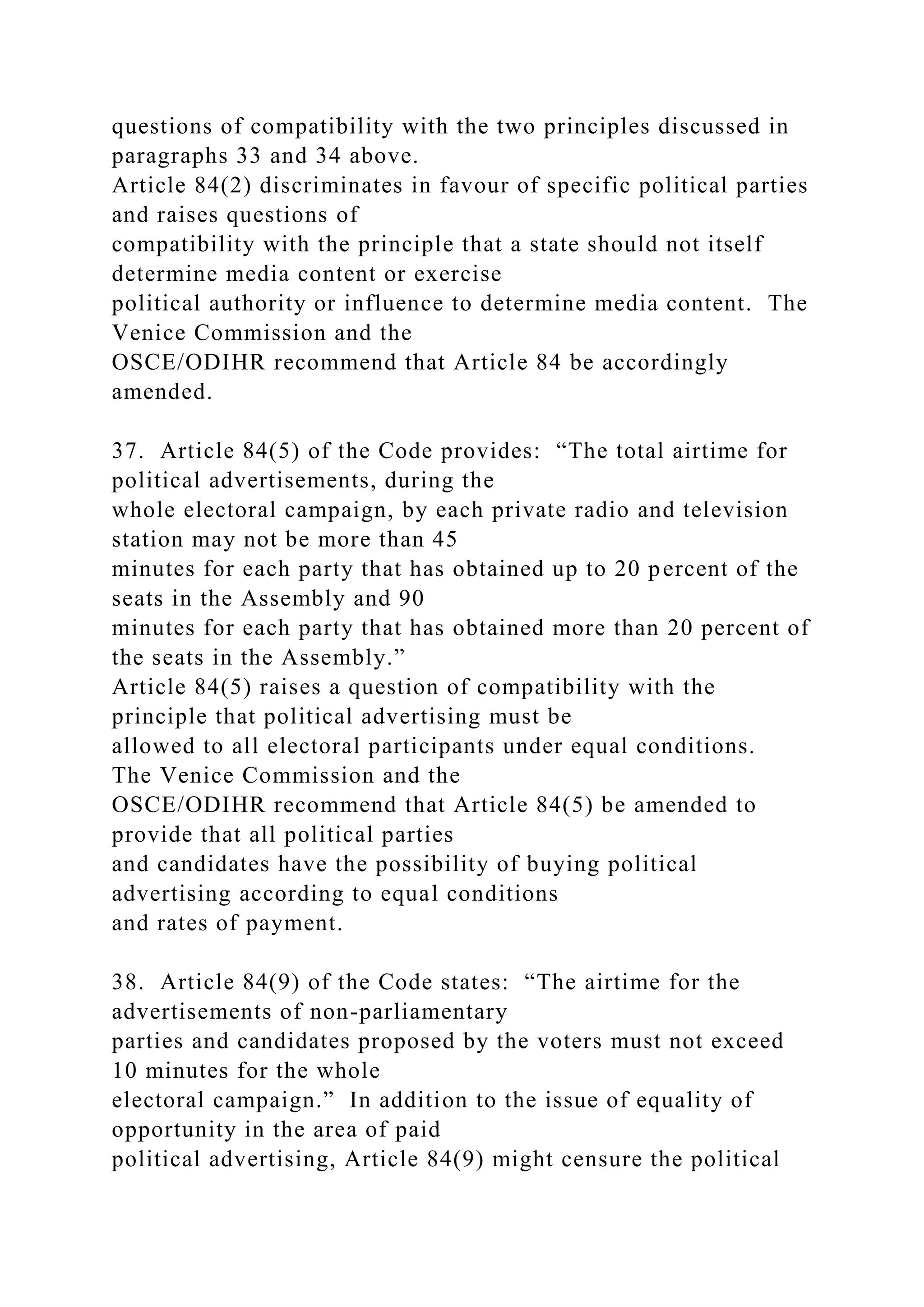

![87(2) states that fifty percent (50%) of the public campaign
funds is “to be distributed among
political parties registered as electoral subjects and having seats
in the Assembly” “on the basis
of the number of mandates won in the elections for the
Assembly”. The remaining fifty percent
(50%) of public campaign funds “is to be distributed among
political parties registered as
electoral subjects and which have obtained not less than 2 seats
in the Assembly in the
preceding elections for the Assembly, in proportion with the
votes obtained by them
nationwide”. This text means that only parliamentary parties
are allocated public funds for the
elections. It is questionable whether the parliamentary parties
in the Assembly should give all
of the public funds for the electoral campaign to themselves.
The Venice Commission and
CDL-AD(2009)005
- 11 -
the OSCE/ODIHR recommend that these provisions be amended
to provide some public
funding mechanism for non-parliamentary parties.
42. Moreover, the second allocation is given to award the
winners by forcing the losers - those
who did not obtain any seat but had at least two seats in the
previous Assembly - to pay back
their initial allocation to the CEC [Article 87(2)b and 87(3)],
which re-allocates these funds](https://image.slidesharecdn.com/httpsifes-221015083553-d170a478/75/httpsifes-orgsitesdefaultfilesbrijuni18countryreport_fi-docx-334-2048.jpg)
![among the winners [Article 87(5)]. This raises an issue of
concern since, ideally, it is hoped that
there are sufficient campaign funds for all electoral contestants
so that voters are fully informed.
It is unavoidable that some electoral subjects, who met the legal
requirements to be placed on
the ballot, will not be successful in the elections and will fail to
secure a mandate. These
electoral subjects should not now be punished. The system of
public funding for campaigns
fulfils the public policy objective of providing information to
voters about all electoral
contestants, even those that ultimately fail to win a mandate.
The Venice Commission and
the OSCE/ODIHR recommend that Articles 86 and 87 be
accordingly amended so that the
campaign funds of losers are not withheld and distributed
among the victors.
43. Articles 89 and 90 regulate the use of private funds for
electoral campaigns. Parliamentary
parties already have campaign funds due to the largess of the
Assembly under Article 86 and
87 of the Code. As noted above, non-parliamentary parties are
excluded from receiving public
funds and must rely solely on private donations. As a result,
parliamentary parties are not
impacted by Articles 89 and 90 as much as non-parliamentary
parties are impacted by these
articles. Article 90(3) limits campaign expenditures by tying
the expenditure limit to ten times
the largest amount of public funds given to a parliamentary
party. The problem with this
formula is that parliamentary parties can establish an
unreasonable expenditure limit by
reducing the amount of public funds parliamentary parties take](https://image.slidesharecdn.com/httpsifes-221015083553-d170a478/75/httpsifes-orgsitesdefaultfilesbrijuni18countryreport_fi-docx-335-2048.jpg)
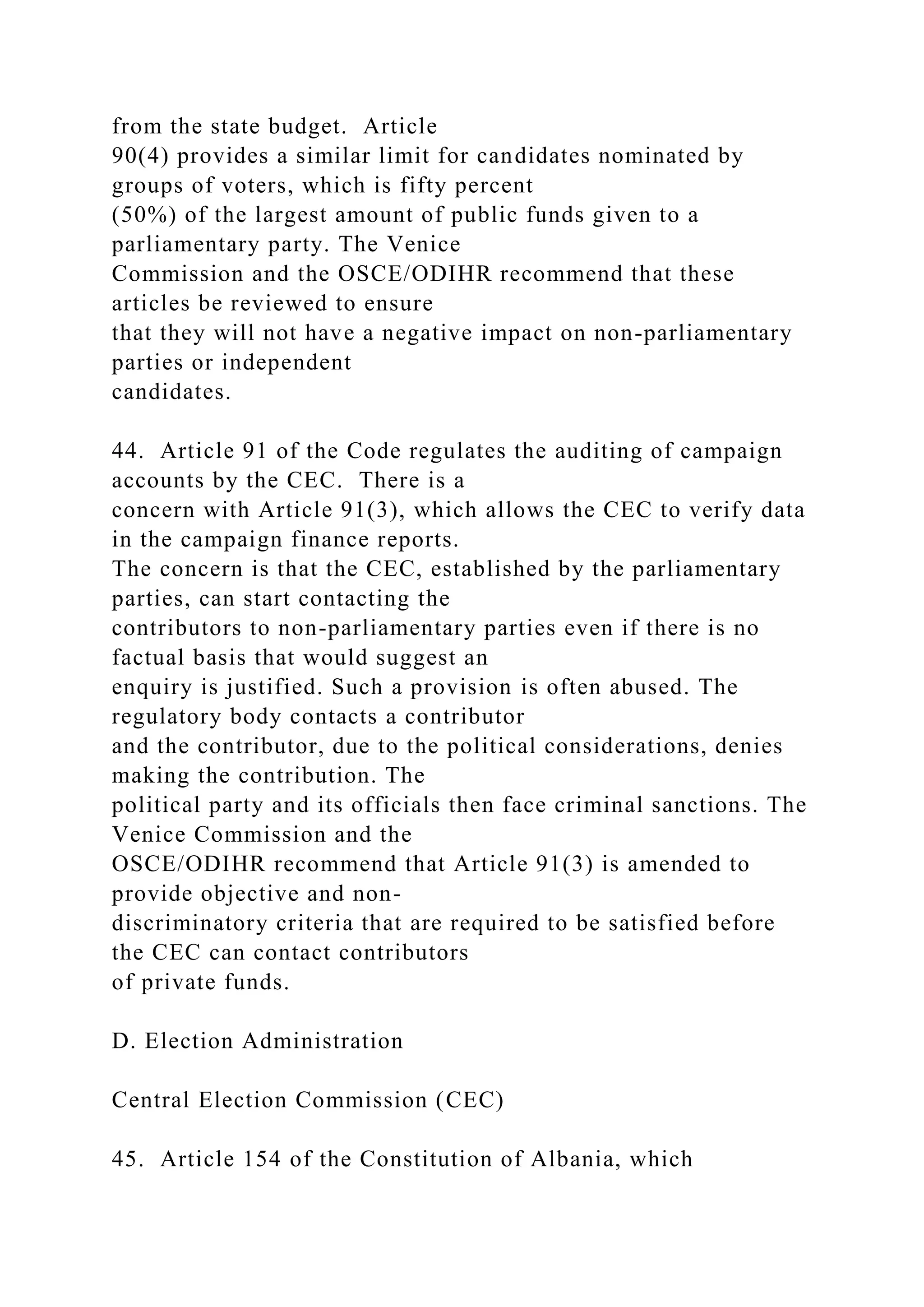



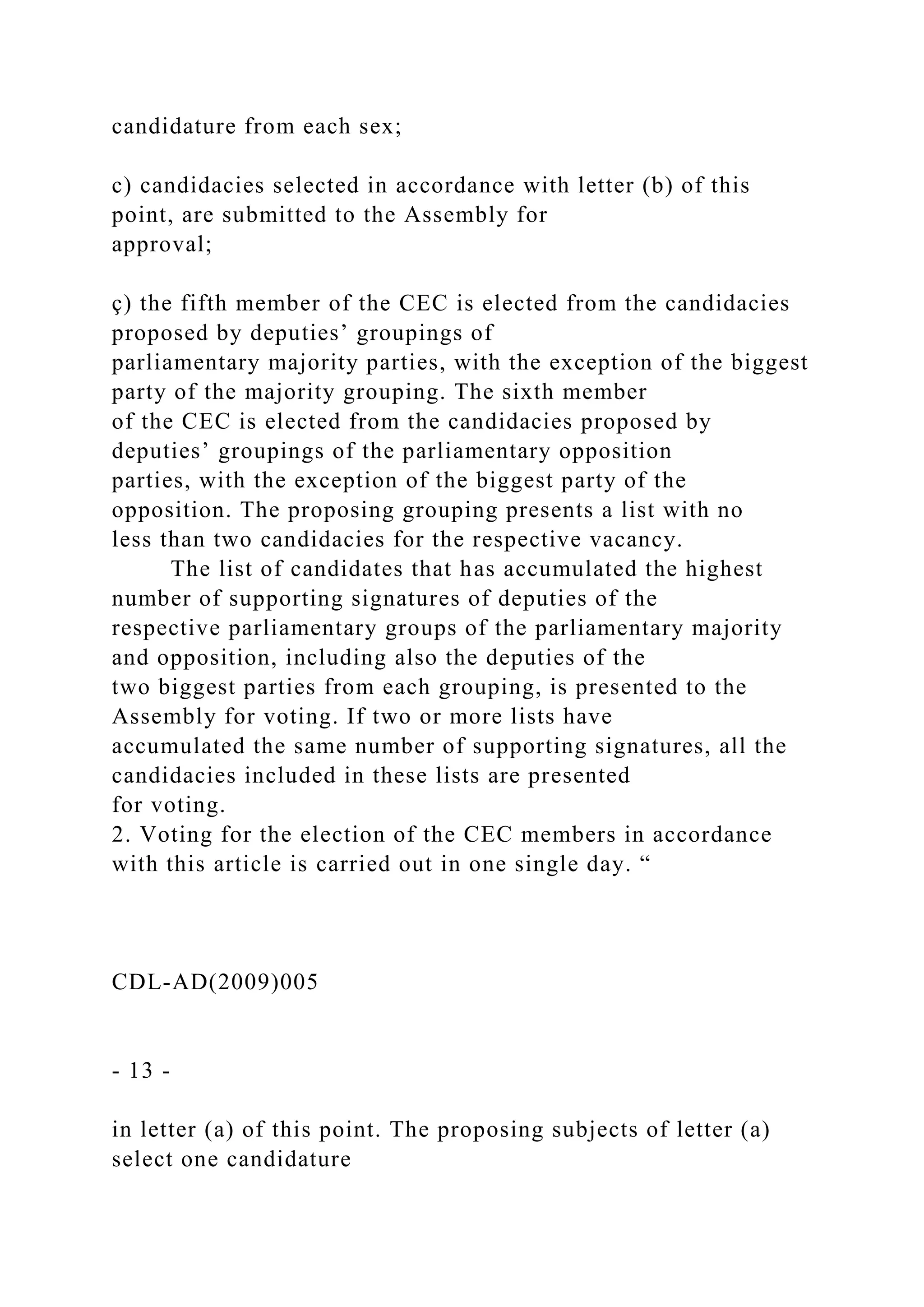
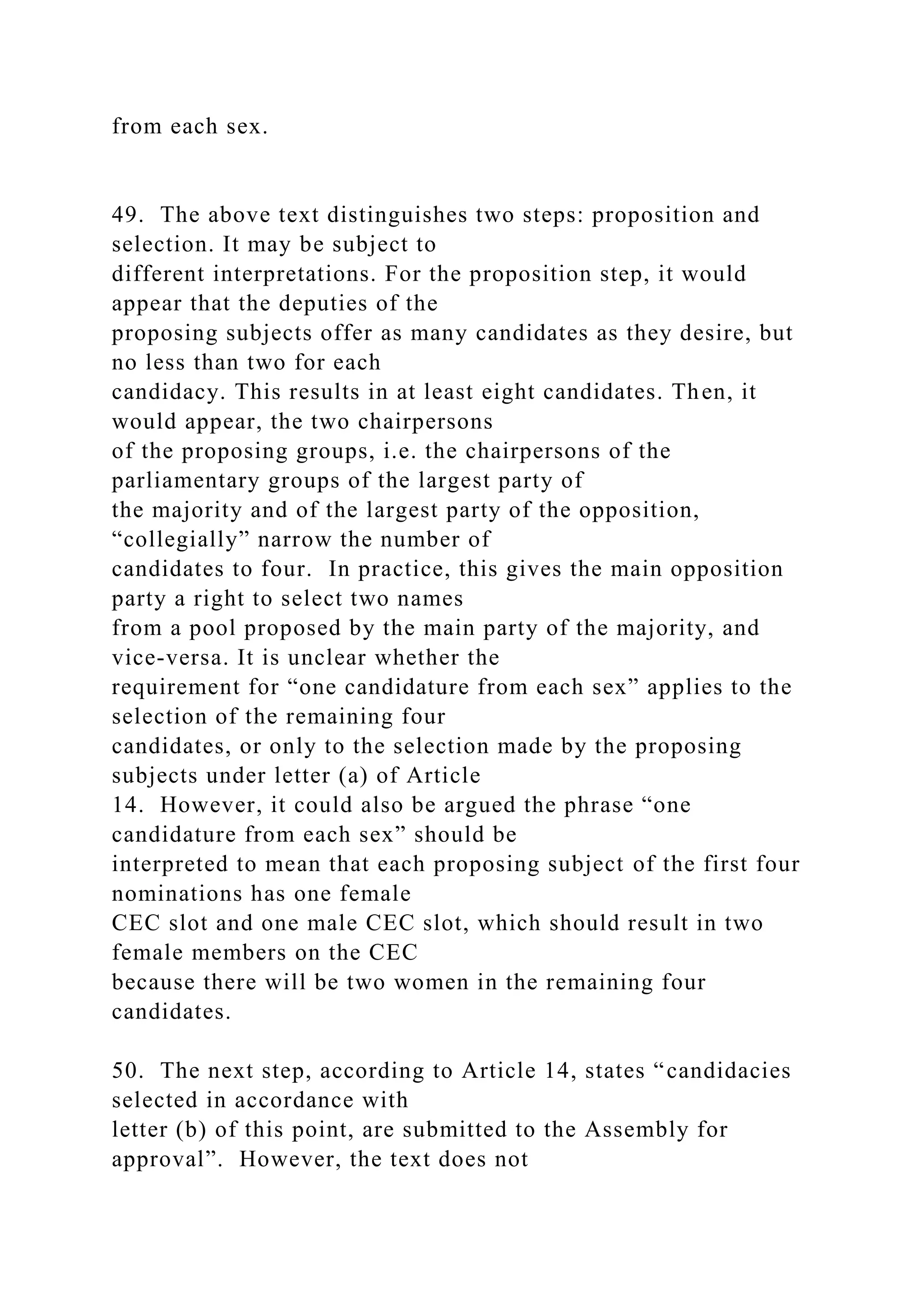
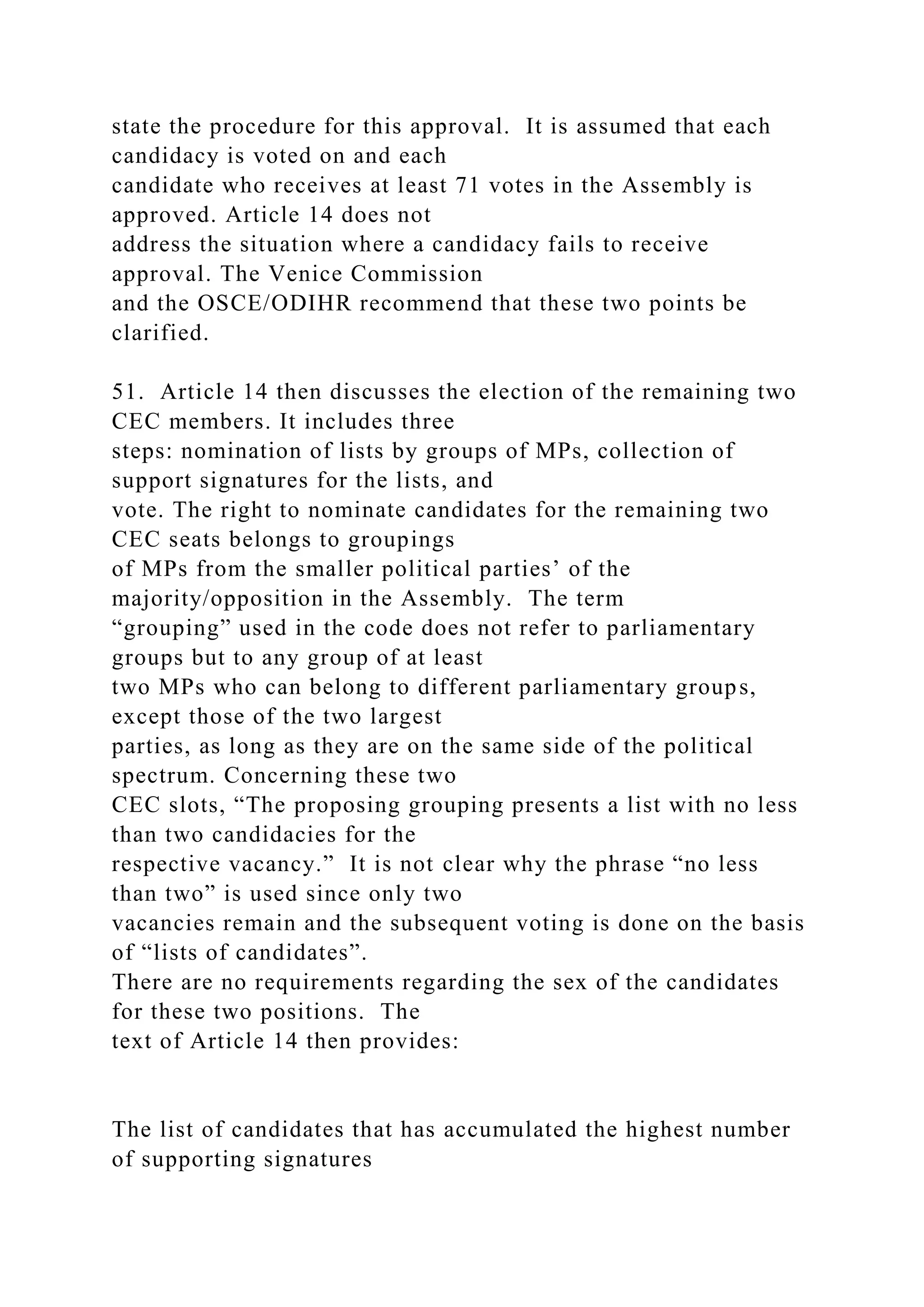



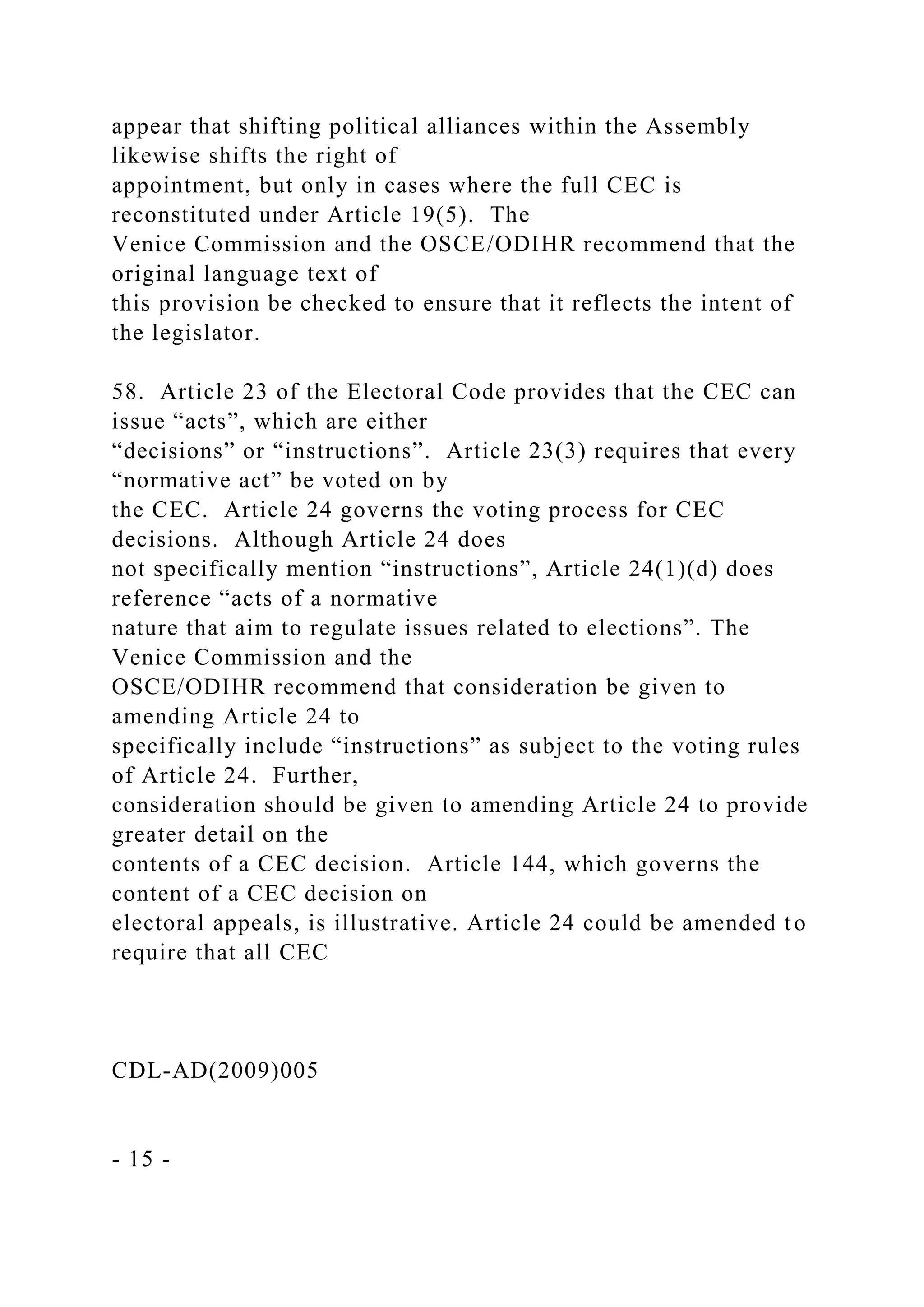





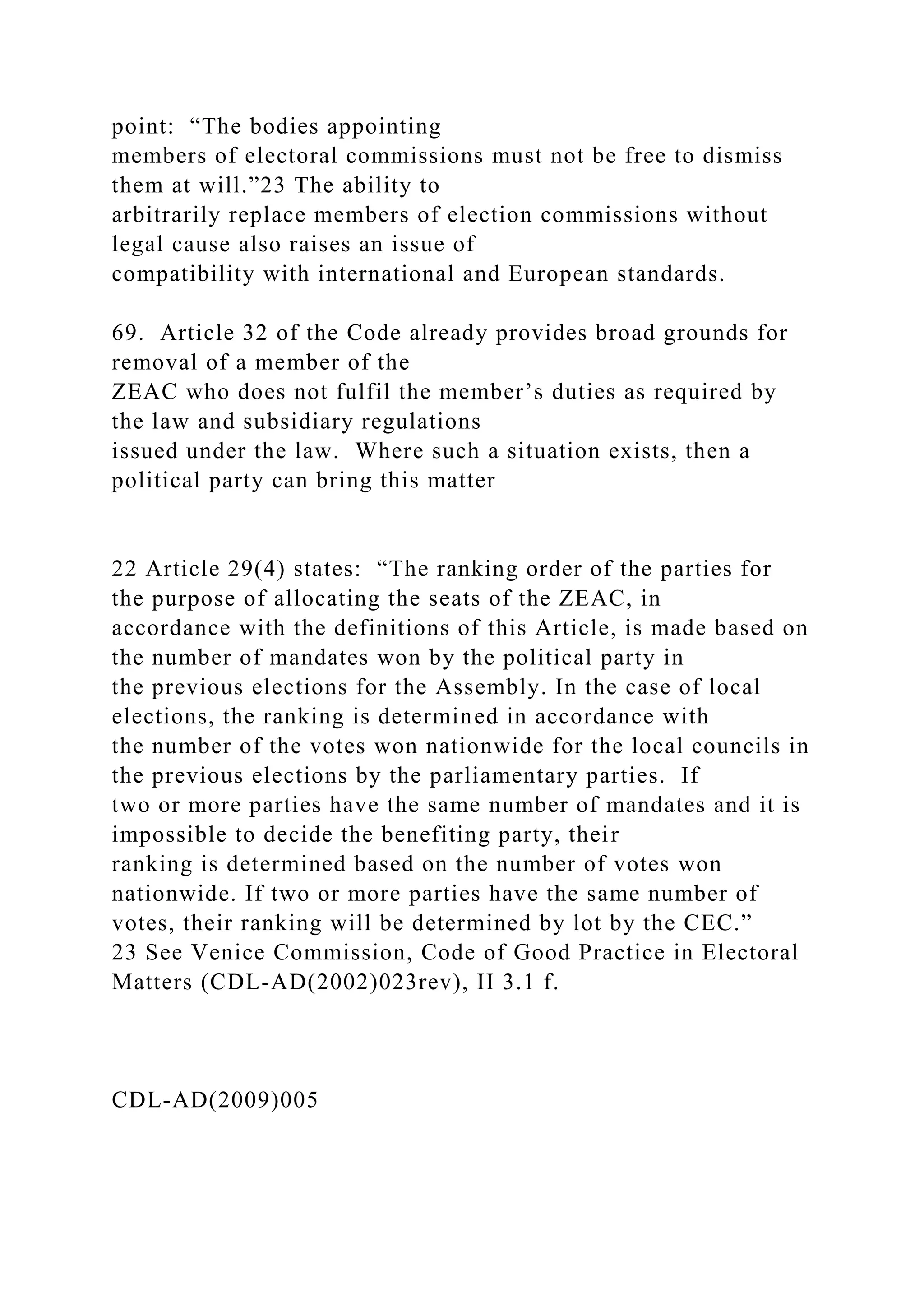



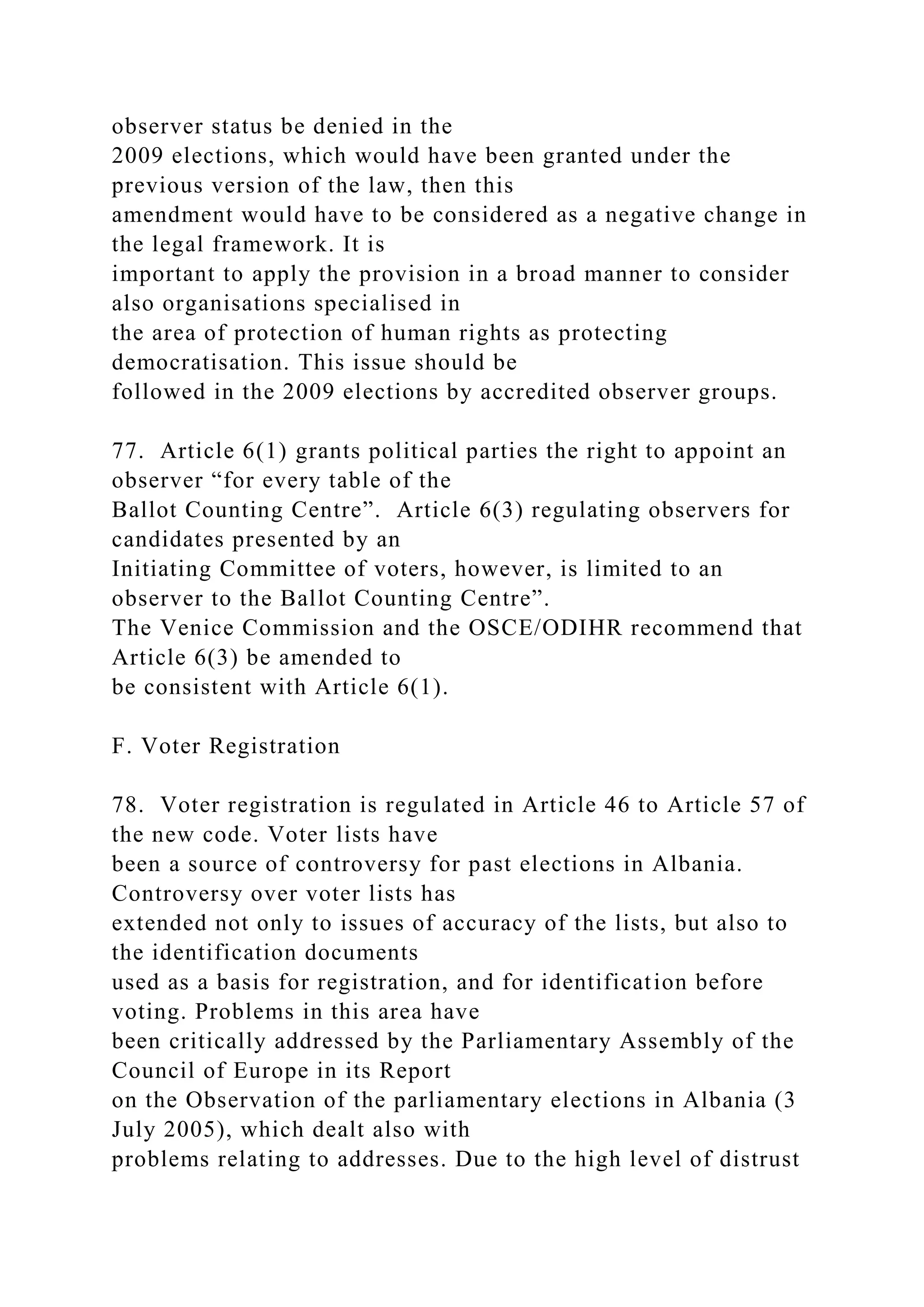



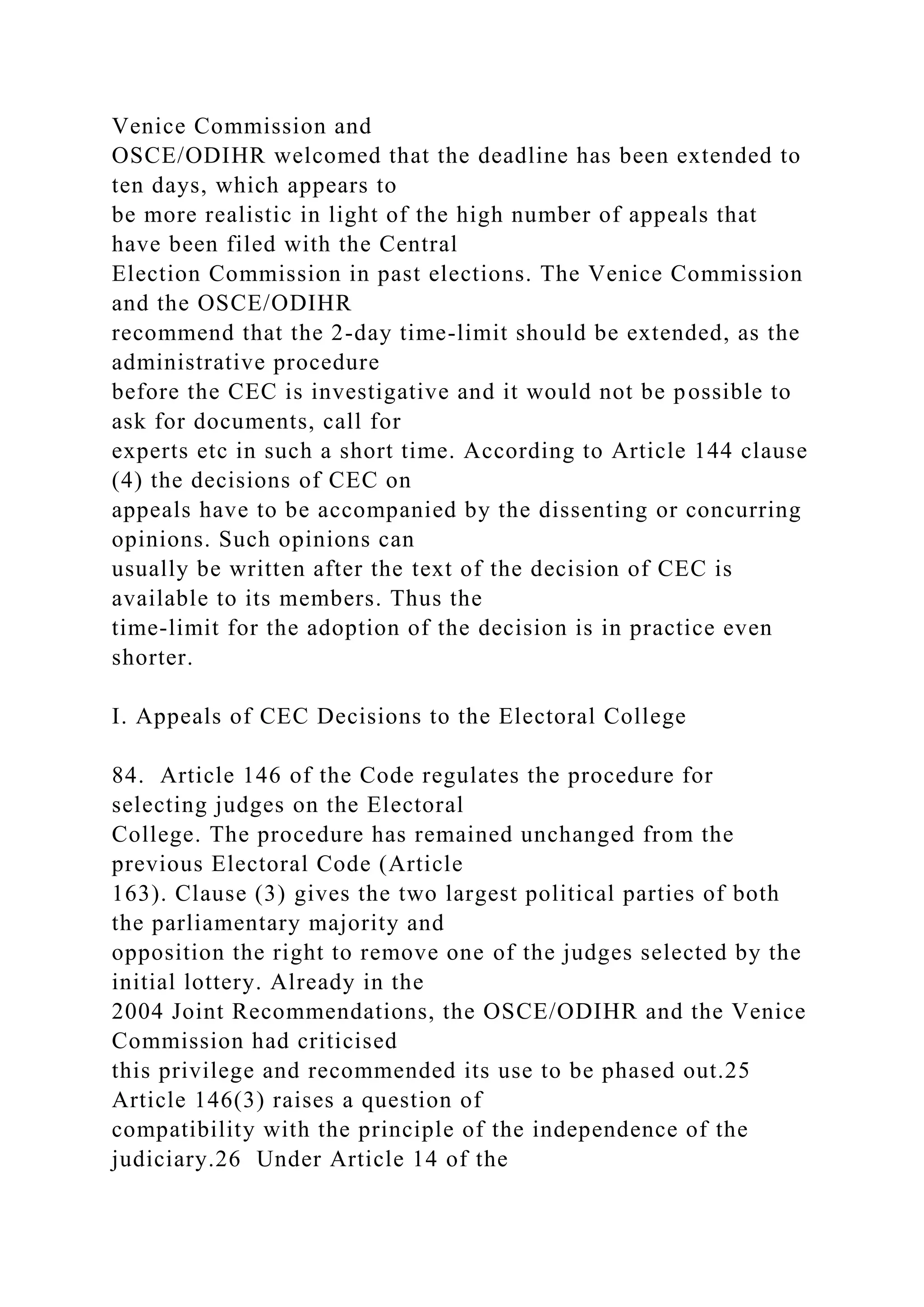


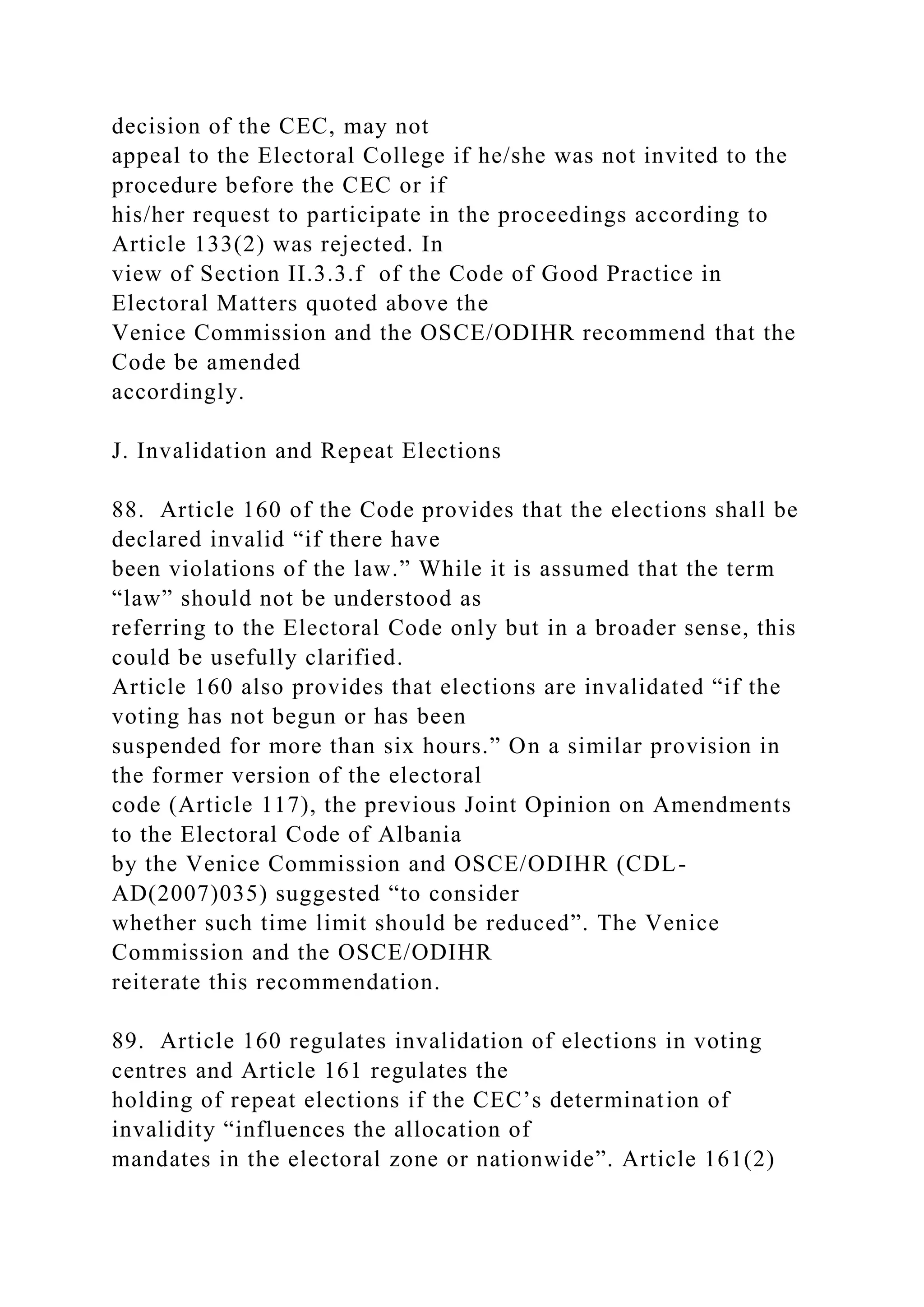




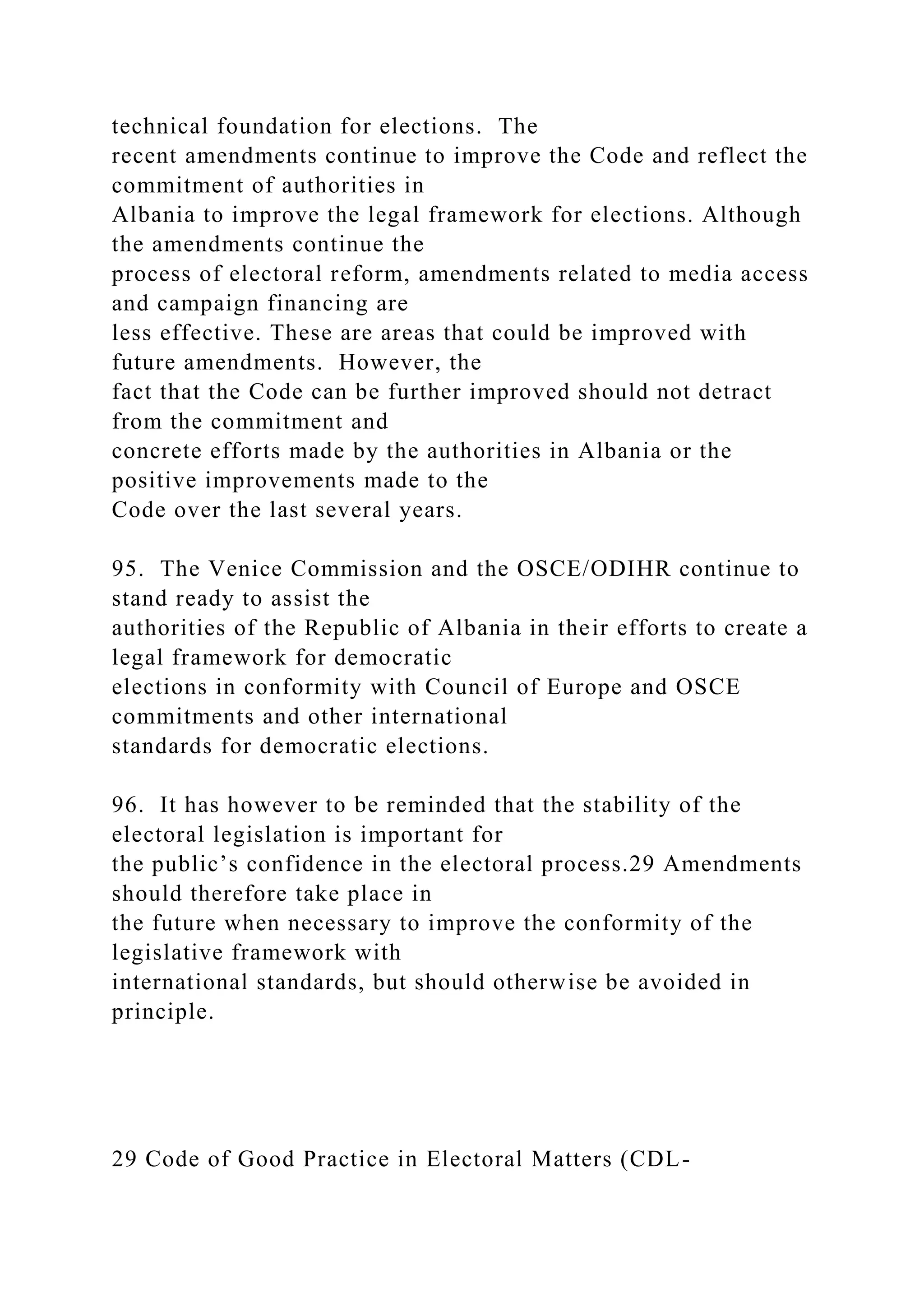



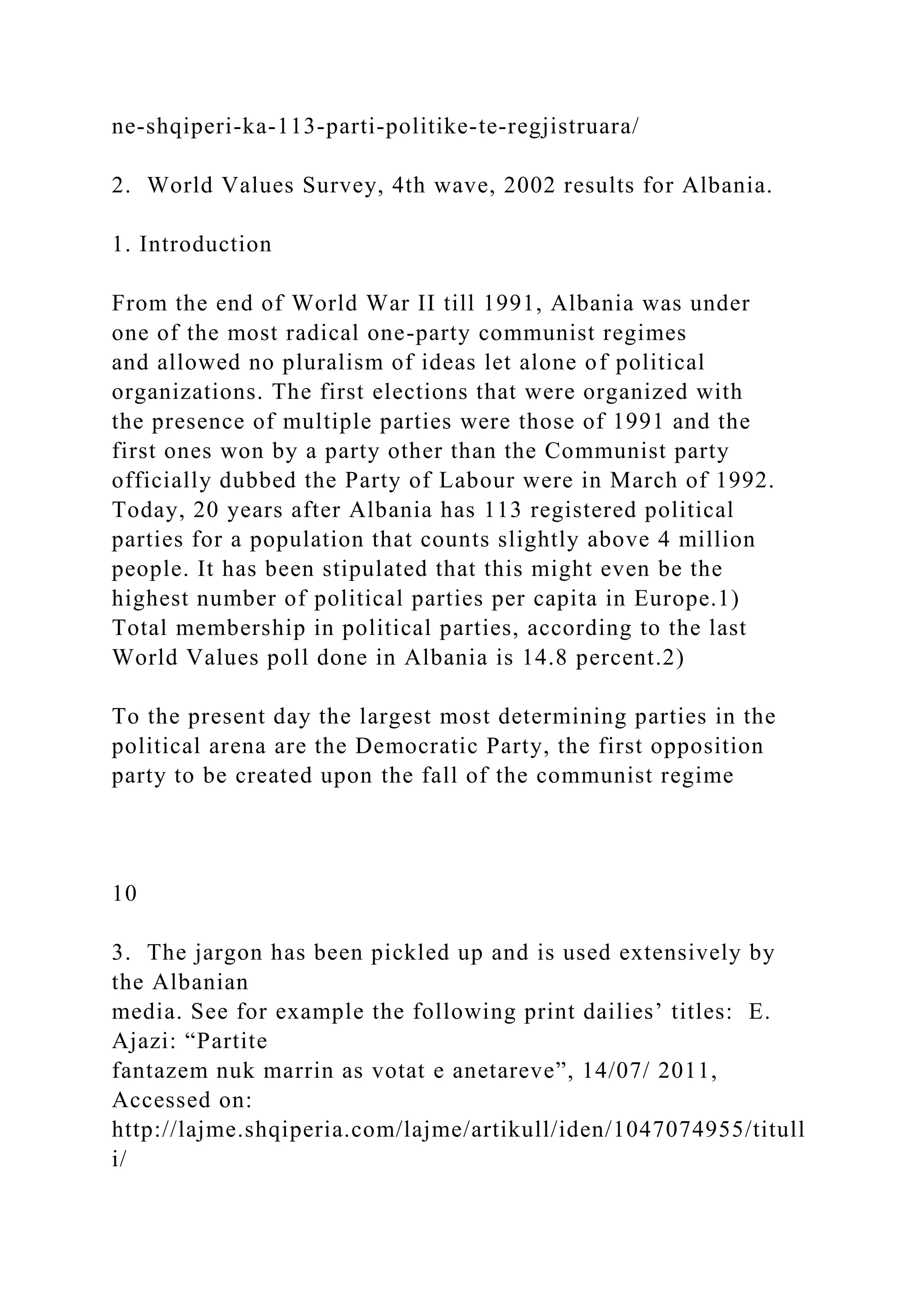





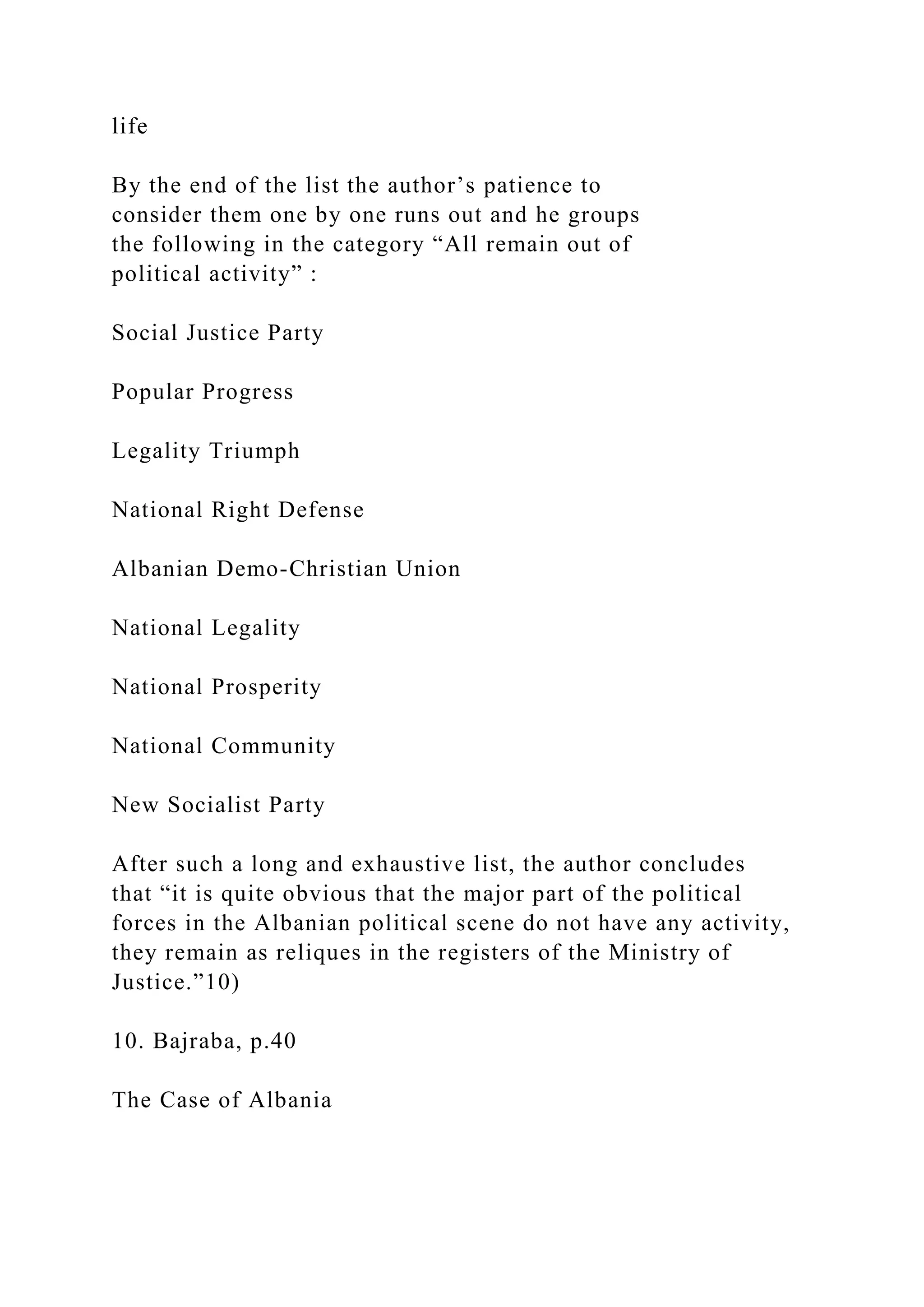





![19. Wolfgang Merkel, “Embedded and defective democracies”,
in
Democratization, Vol. 11, No 5, December 2004, p.51.
20. Merkel, p.49.
3. the state of Albanian
democracy
In a 2002 classification of democracies all over the world
Wolfgang Merkel, a well known political science scholar
for having coined the term ‘embedded democracies’ lists
Albania in the column of illiberal democracies19), pertaining
to his definition that illiberal democracies are:
Democracies with… “incomplete and damaged
constitutional state, where the executive and
legislative control of the state are only weakly
limited by the judiciary[…],constitutional norms
have little binding impact on government actions
democracies where the principle of rule of law
is damaged affecting the actual core of liberal
self-understanding, namely equal freedom of all
individuals.”20)
22
21. Democracy index ‘The Economist’ 2011; FRIDE (Fundación
para las
Relaciones Internacionales y el Diálogo Exterior) and Open
Society
Foundation , 2010.](https://image.slidesharecdn.com/httpsifes-221015083553-d170a478/75/httpsifes-orgsitesdefaultfilesbrijuni18countryreport_fi-docx-384-2048.jpg)


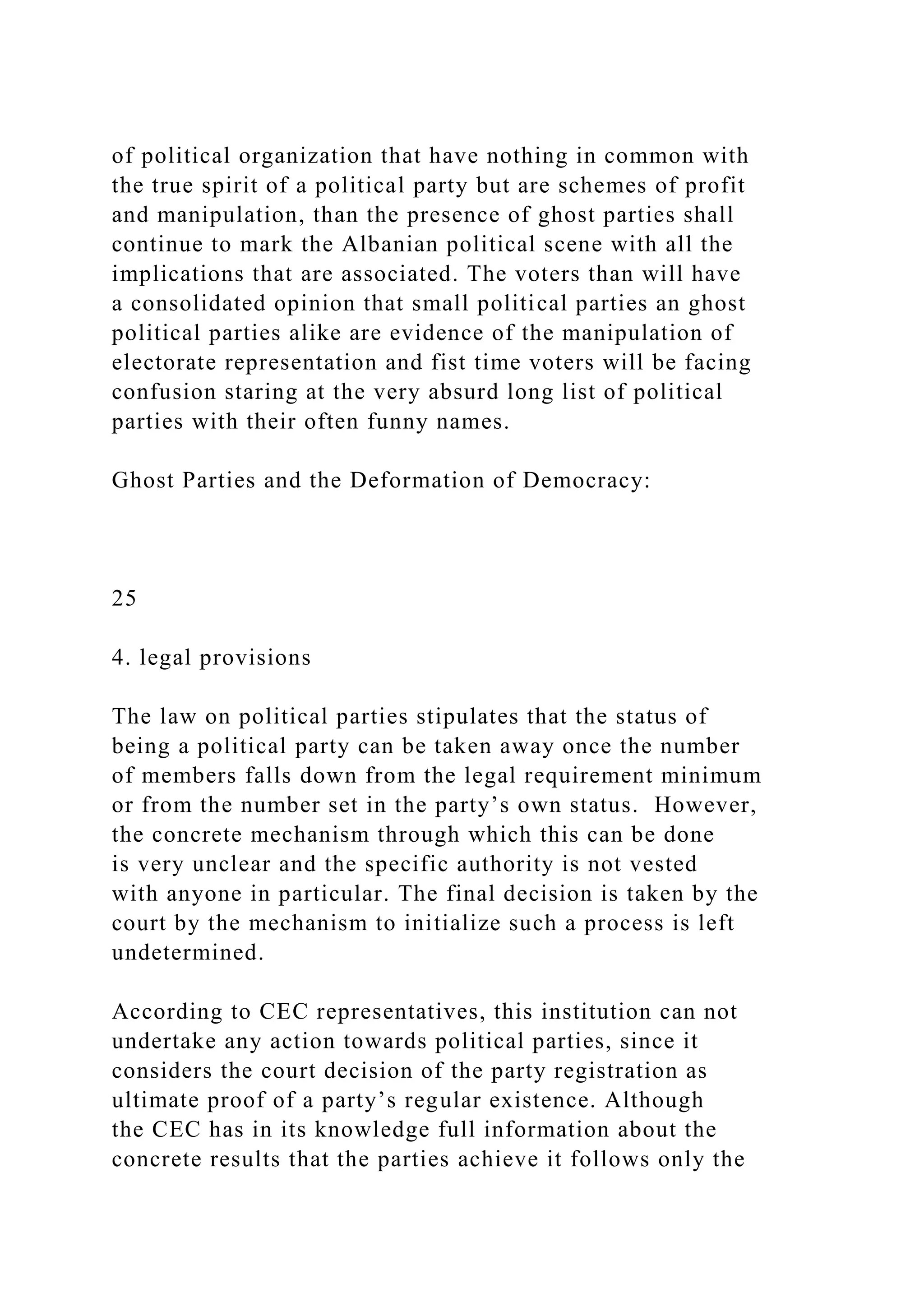

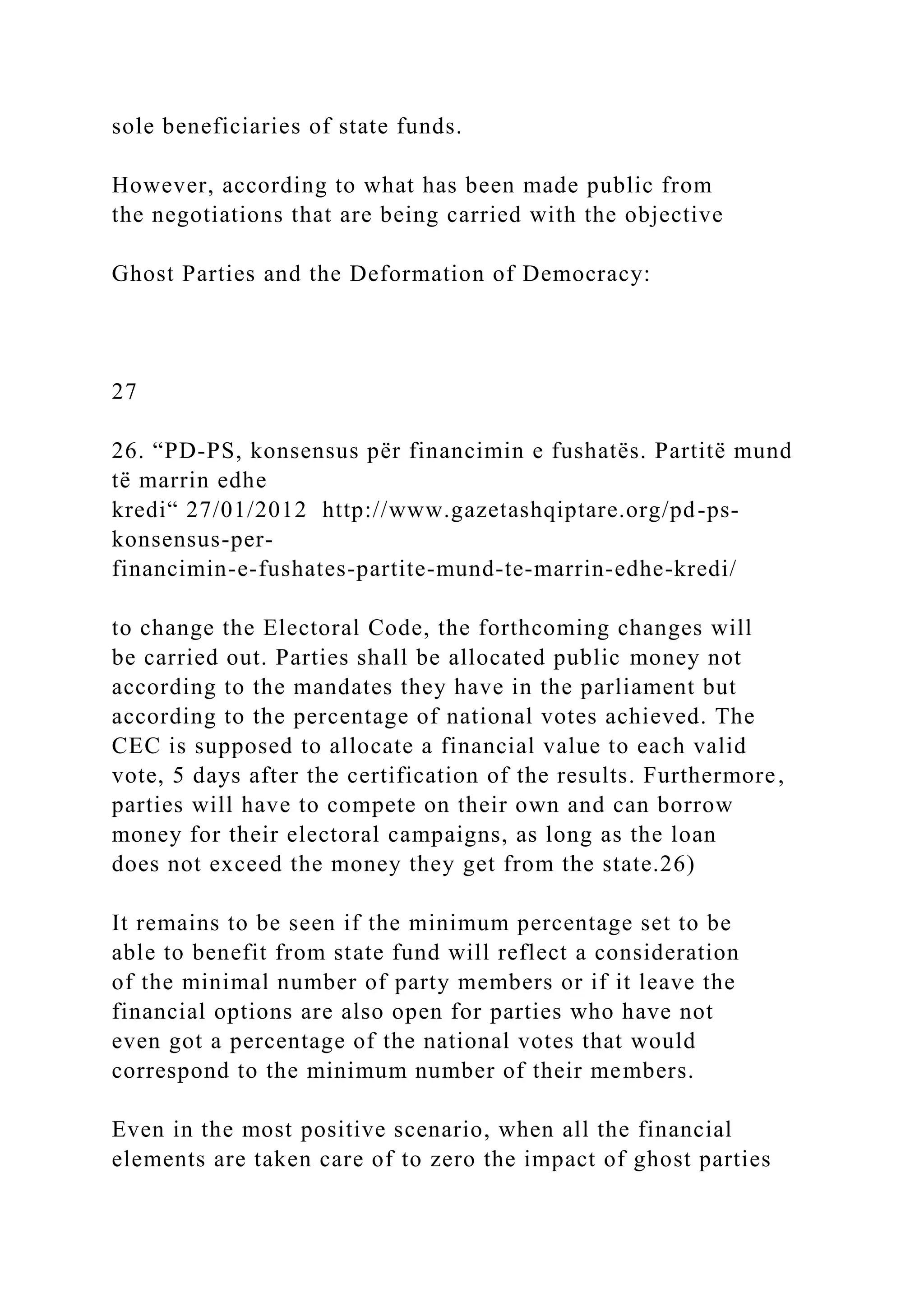




![times as well as by the way they are financed, the way
they mange institutionalized membership, etc.. Hence
the large quantity of these political parties in Albania
is directly connected to the ease that the Law offers.
For their large number, small electorate and the lack of
their representation both in parliament and at the local
[level] they display a lack of efficiency but I wouldn’t
say deformation. Deformation might be the case of the
law which offers this high degree of ease for them to be
created, but as long as ‘party’ means ‘piece’ then maybe
we have the desire to be in many ‘pieces’.
As long as the legal framework makes it possible for
political parties to be created and then go on without
institutionalized control, which would check if they have
a fixed office , without the institutional infrastructure,
register of members or even auditing for their funds,
this will act as a catalyst for ghost parties or parties that
appear only during election times. In the meantime, a
good part of them are simply one-man-party and don’t
have elected structures. From the legal perspective
opportunities should be created for parties to exert their
functions however there should be set some limits in
order for the process not to be rendered so ridiculous.
Geron Kamberi, expert on domestic political and
development issues
The Case of Albania
33
“Political parties are a national asset; the right to assemble
is an unlimited constitutional right. Some say we have too](https://image.slidesharecdn.com/httpsifes-221015083553-d170a478/75/httpsifes-orgsitesdefaultfilesbrijuni18countryreport_fi-docx-394-2048.jpg)




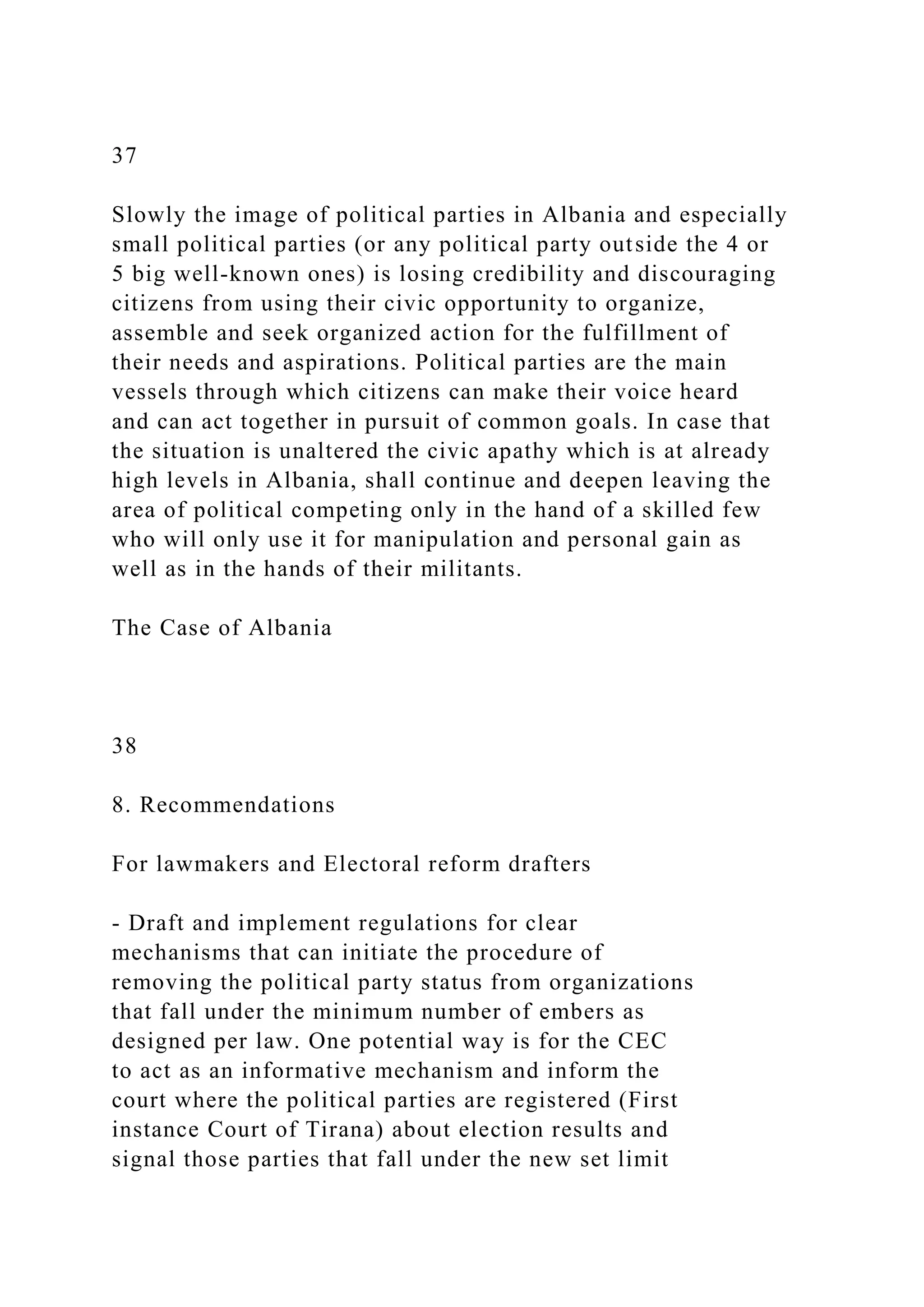








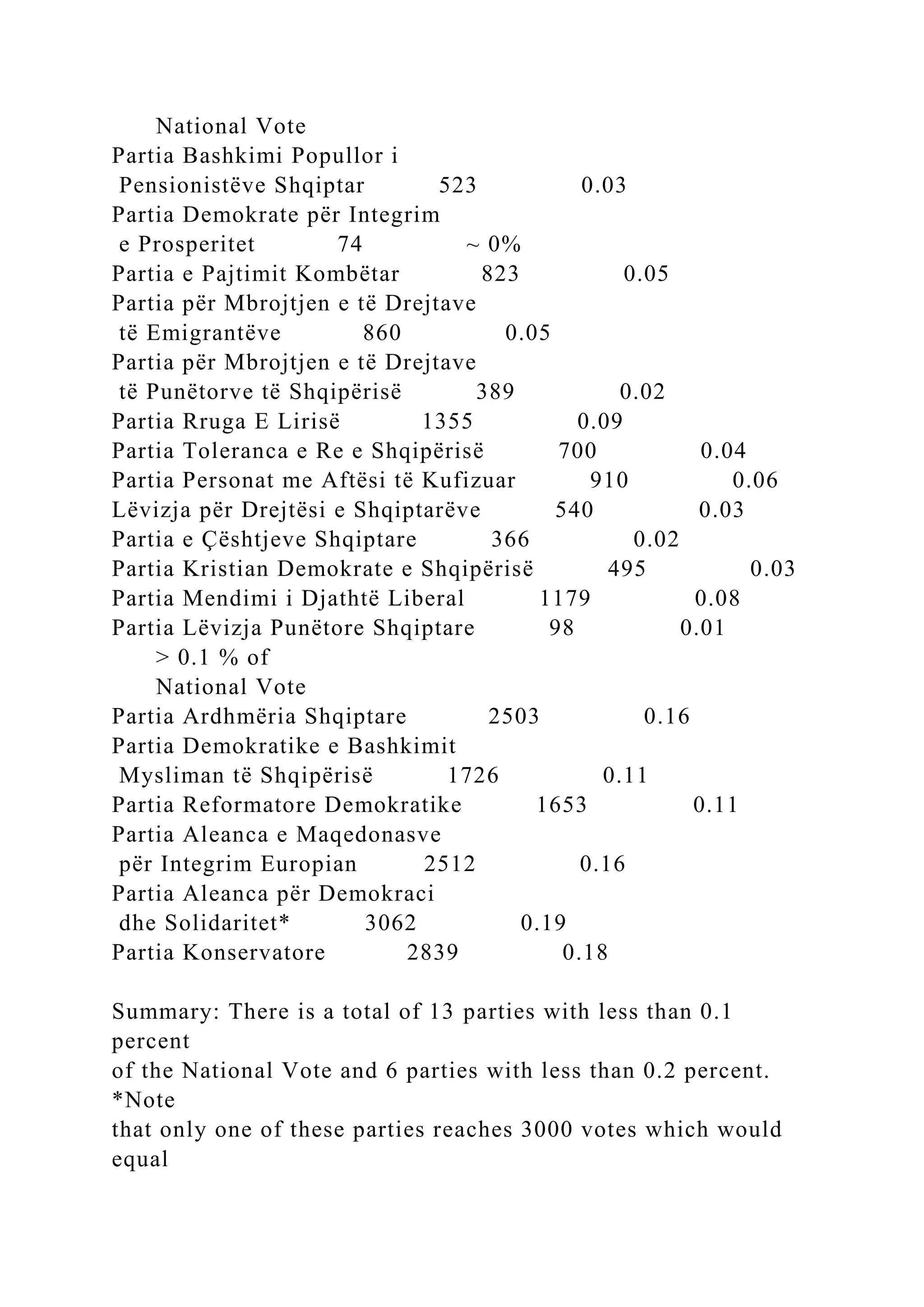
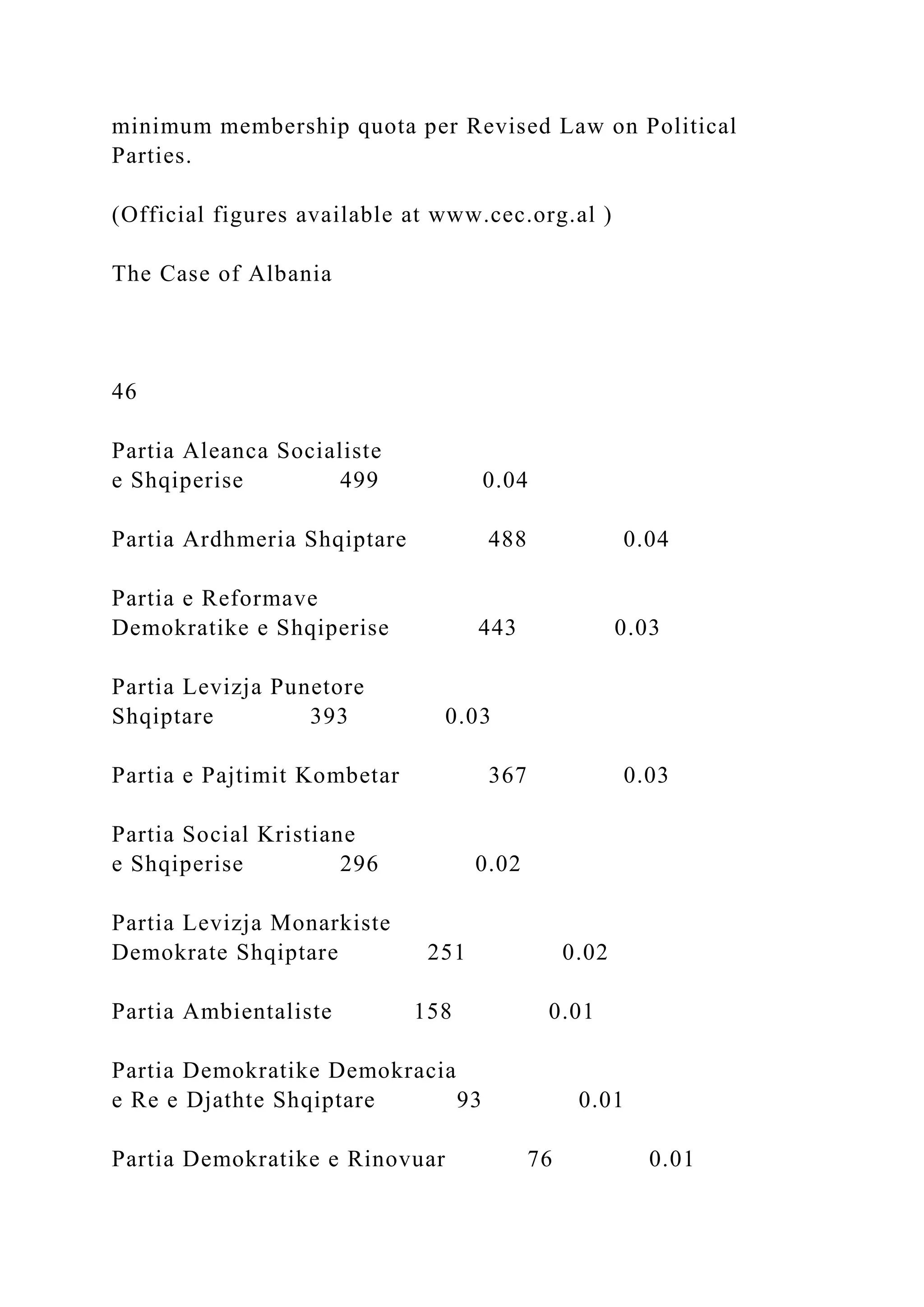

![48
Mišo Dokmanović, PhD
Assistant Professor, Faculty of law, Ss. Cyril and Methodius
University, Skopje, Macedonia,
[email protected], [email protected]
www.pf.ukim.edu.mk
49
Political pluralism exists in Macedonia for
over 20 years. The country has experienced 7
parliamentary elections and as a result of that
the multi-party system has evolved over the
years with its own specifics.
The phenomenon of invisible ghost parties
existed in Macedonia for a considerable period
of time. In that direction, this paper makes an
attempt to analyze the role of the invisible,
ghost parties and their impact on election
results in the country.
A special emphasis will be put on the
case study of the Social Democratic Party
of Macedonia, its specific approach in the
parliamentary elections in 2006 and 2008 and
the lessons learned.](https://image.slidesharecdn.com/httpsifes-221015083553-d170a478/75/httpsifes-orgsitesdefaultfilesbrijuni18countryreport_fi-docx-411-2048.jpg)
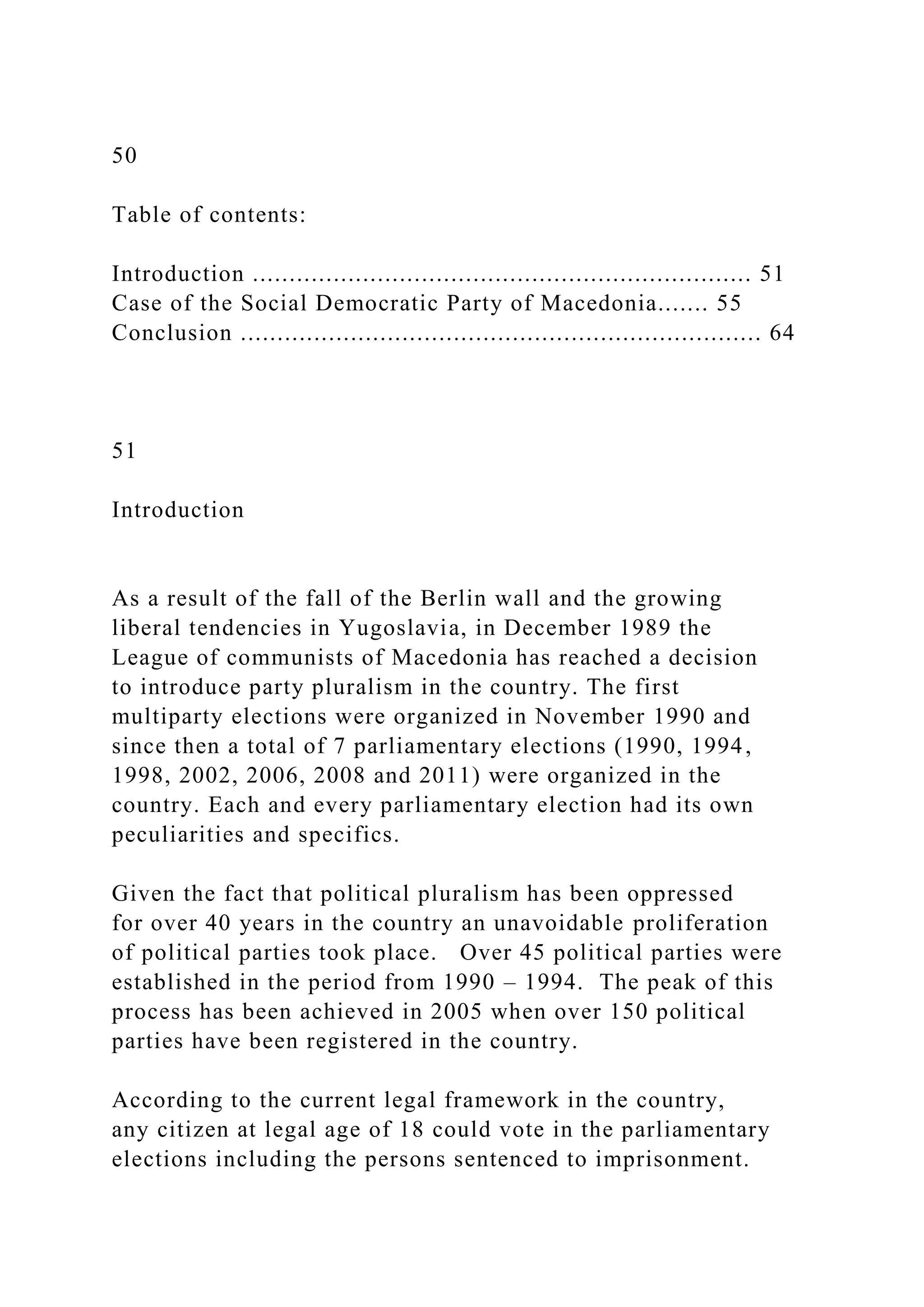





![SDPM
5. State Electoral Commission. (2006). Final results of the
Parliamentary
elections in 2006. Available at: http://www.sec.mk/arhiva/2006_
parlamentarni/Rezultati_poIE_konecni.pdf. [Accessed on 15
April 2012].
During the parliamentary election in 2006 the SDPM
has decided to nominate persons as lead candidates of the
party lists that had the same name and surname with the
candidates of the Social Democratic Union of Macedonia
(SDSM), the leading governmental party at the time of
elections. In that direction, it should be underlined that
the name and surname of the candidates of the leading
governmental party SDSM and the “ghost party” SDPM in
the electoral district 3 were the same – Nikola Popovski. At
the same time, the name and surname of the frontrunner
of the lists of both parties were almost identical – Ilinka
Mitreva for SDSM and Ilinka Mitevska for SDPM.
Explaining the role of the ghost parties in Macedonia
57
As a result of the similar party names and the almost
identical names of the party lead candidates, SDPM has
scored considerably better results than in the other electoral
districts. SDPM party score in electoral district 1, 2, 4 and
6 was at average level of 507 votes. On the other hand, in
the districts were the party had selected frontrunners with
almost identical names with the ruling party’ candidates
(electoral district 3 and 5) SDPM scored an average of 3098
votes.](https://image.slidesharecdn.com/httpsifes-221015083553-d170a478/75/httpsifes-orgsitesdefaultfilesbrijuni18countryreport_fi-docx-418-2048.jpg)
![Further analysis of this new emerging feature of the
Macedonian political systems has demonstrated that this
approach of the SDPM has not been limited to the number
of votes won only. In that direction, it should be emphasized
that this election score of SDPM has also affected the
distribution of the MP mandates in these two electoral
districts.
2006 Parliamentary Elections Results of SDPM by
electoral districts 6)
District 1 2 3 4 5 6
Votes 306 691 3564 775 2632 258
6. State Electoral Commission. (2006). Final results of the
Parliamentary
elections in 2006. Available at: http://www.sec.mk/arhiva/2006_
parlamentarni/Rezultati_poIE_konecni.pdf. [Accessed on 15
April 2012].
Explaining the role of the ghost parties in Macedonia
58
Given the fact that 20 mandates in each electoral district
are distributed according to the standard D’Hondt formula,
according to the final results the ruling party SDSM won 7
seats in the electoral district 3 and 6 seats in the electoral
district 5. However, if we added the surplus of the average
votes won by the SDPM in the other electoral districts, we
come to the conclusion that in the both cases, SDSM would
have won an additional seat in the parliament.](https://image.slidesharecdn.com/httpsifes-221015083553-d170a478/75/httpsifes-orgsitesdefaultfilesbrijuni18countryreport_fi-docx-419-2048.jpg)


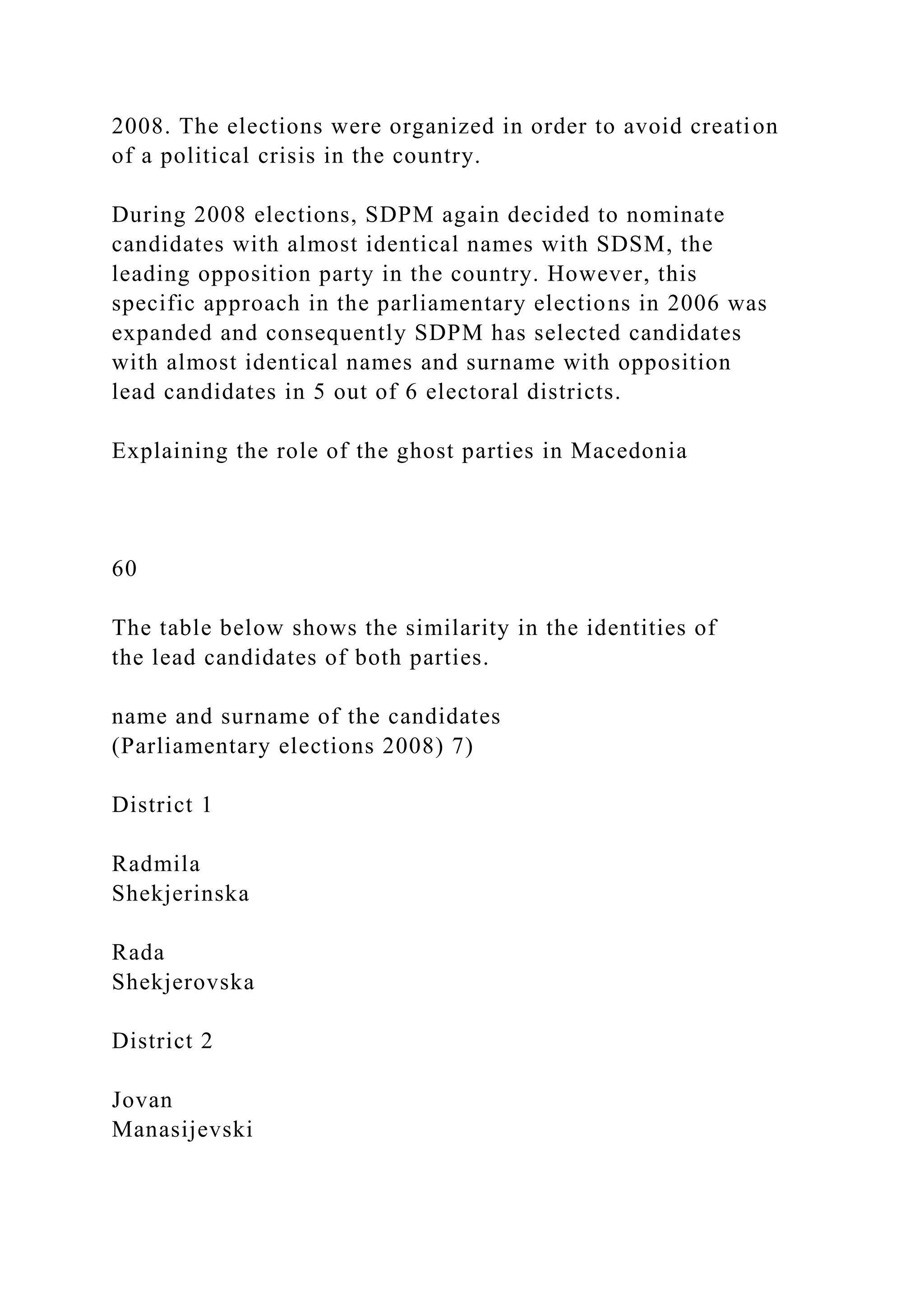

![of twin candidates had the sole purpose to confuse SDSM
voters.8) Besides that, several TV stations have attempted to
interview the candidates of the SDPM, but in most cases,
when addressed, the candidates were not aware that
they were selected as lead candidates or declined media
interviews.
Given the fact that this approach of the SDPM
represented a clear manipulation of the election process,
the leading opposition party SDSM has filed a complaint to
the State Electoral Commission (SEC) against the registration
7. State Electoral Commission (2008). Early Parliamentary
Election 2008
– List of candidates. Available at:
http://www.sec.mk/arhiva/2008_
predvremeniparlamentarni/index/listinakandidati.htm.
[Accessed on 16
May 2012].
8. Utrinski Newspaper, 4 May 2008. Twins to Confuse SDSM
voters. Available
at:
http://www.utrinski.com.mk/?ItemID=CFFEFAF8FE0BE34D9D
83B52A31
5ED2B6. [Accessed on 21 May 2012].
Explaining the role of the ghost parties in Macedonia
61
of SDPM candidate list. As a result of that this approach
of SDPM became one of the main issues discussed during
the candidate registration and campaign period of the](https://image.slidesharecdn.com/httpsifes-221015083553-d170a478/75/httpsifes-orgsitesdefaultfilesbrijuni18countryreport_fi-docx-424-2048.jpg)
![elections.
However, while regarding SDPM’s candidate list
was perceived as an attempt to confuse voters, the SEC
concluded that the Election Code did not provide grounds
for its rejection. Consequently, SDSM filed an appeal to
the Supreme Court of Macedonia. The Supreme Court has
dismissed the appeal on the grounds that “there was no
explicit right to such an appeal in the Election Code”.
The information that some of the candidates had not
been consented to be nominated was further investigated
by the Public Prosecutor office in Skopje. In that direction,
the Prosecutors office has requested from the police to
obtain information from the SDPM candidates. Given the
fact that no such information was received before Election
Day, the Skopje Prosecutor concluded that the candidates
in question had agreed to their candidacy. This incident has
been mentioned in the OSCE Election Observation Mission
Final Report.9)
Having in mind that the selection of lead candidates
of SDPM during the parliamentary elections in 2006 has
9. OSCE Office for Democratic Institutions and Human Rights.
(2008). Early
Parliamentary Elections – 1 June 2008 – Election Observation
Mission
Final Report. Available at
www.osce.org/odihr/elections/fyrom/33153.
[Accessed on 11 May 2012].
Explaining the role of the ghost parties in Macedonia](https://image.slidesharecdn.com/httpsifes-221015083553-d170a478/75/httpsifes-orgsitesdefaultfilesbrijuni18countryreport_fi-docx-425-2048.jpg)
![62
affected the election results, I have further explored whether
this was the case with the parliamentary elections in 2008.
SDPM has won votes ranging from 465 – 1816 votes in the
six electoral districts in Macedonia. In that direction, after
the comparison of SDPM election results and the elections
results of the political parties that won a seat in the
parliament, a conclusion could be reached that the SDPM
votes did not affect the distribution of the seats in any of
the electoral districts in Macedonia in this parliamentary
election.
results of sdpm in the electoral districts
(Parliamentary elections 2008) 10)
District 1 2 3 4 5 6
Votes 1816 1203 1029 1300 593 465
10. State Electoral Commission (2008). Early Parliamentary
Election
2008 – Final Results by Electoral Districts.
Availableat:http://www.
sec.mk/arhiva/2008_predvremeniparlamentarni/fajlovi/rez_kone
cni/
Konecni03072008poIE.pdf.[Accessed on 18 May 2012].
It should not be forgotten that to a large extent this
outcome was due to the efforts of the leading opposition
party to prevent the events that occurred in 2006 when a
considerable number of its voters were misleaded with the
identity of the lead candidates. In other words, during the
campaign SDSM was unavoidably forced to concentrate its
energy and time to the complaint and appeal proceedings as
well as to voters’ education in order not to make the same](https://image.slidesharecdn.com/httpsifes-221015083553-d170a478/75/httpsifes-orgsitesdefaultfilesbrijuni18countryreport_fi-docx-426-2048.jpg)




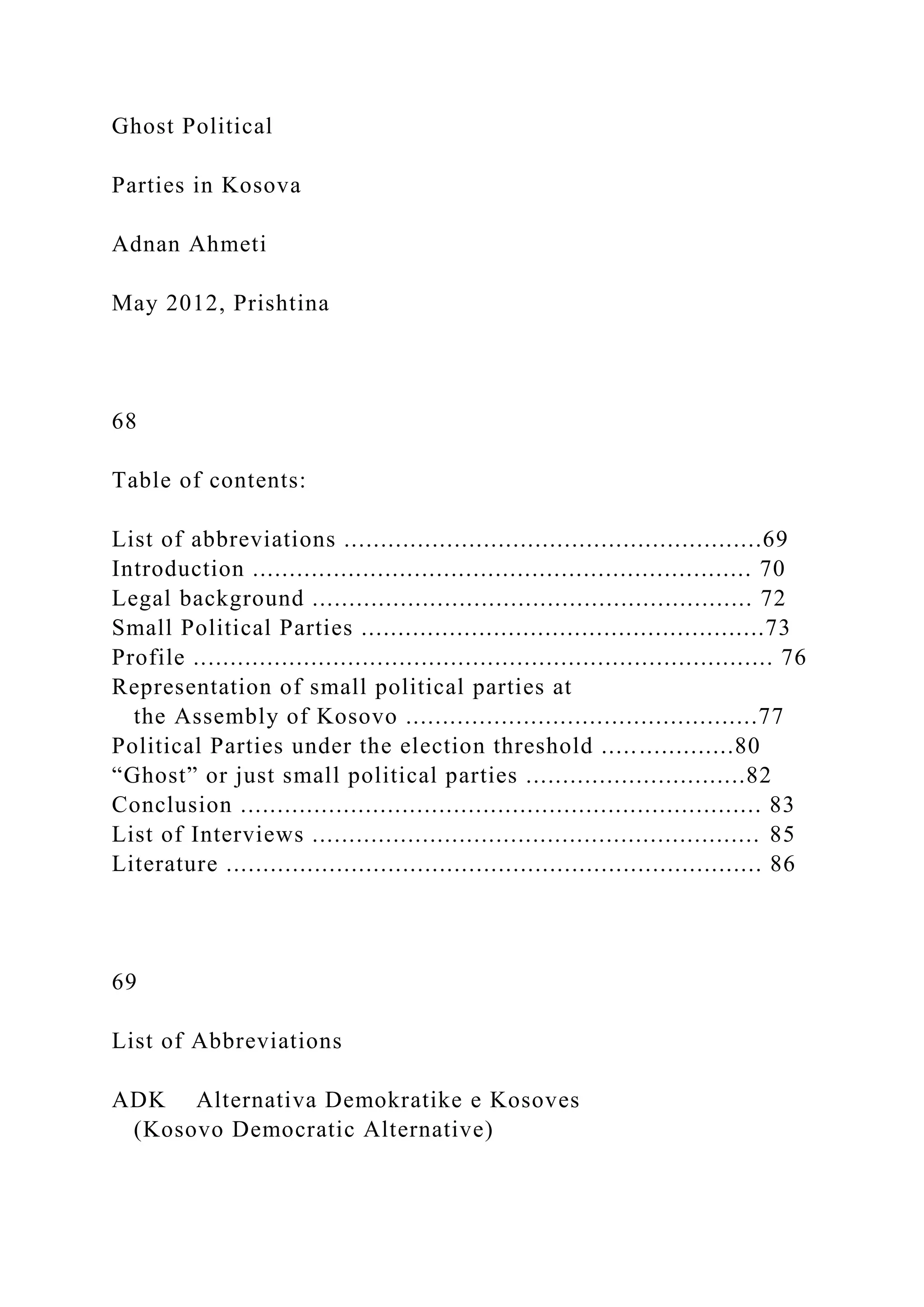

![political parties on democracy-building process in Kosovo.
I tried to make the difference between small political
parties and the parties as are called in political vocabulary
“Ghost Political Parties” 1). Small parties are indispensable
for democracy-building process or creating the basis for
democracy in an area that never experienced before the
democratic regime, and in no way they should be seen as
a single conglomerate. As you will see below, many SPPs
contribute a lot to the democracy and political landscape
of Kosovo.
Political parties are the engine of every democratic
endeavours, or better saying “the democracy is unimaginable
1. This term is borrowed from political parlance and it means
that “‘ghost
political parties’ are those political parties with dubious
membership
as questioned by their results in the elections (less votes than
minimum
number of members as required by law), little or no public
presence in
media and often not-to-be found headquarters/web pages/
leaders as well
as some other criteria.]”
Small and Ghost Political Parties in Kosova
71
without the existence of political parties”2). Therefore,
not only big political parties play or shall play a significant
role in emerging democracies, but also the small political
parties shall be very vigilant and proactive for promotion](https://image.slidesharecdn.com/httpsifes-221015083553-d170a478/75/httpsifes-orgsitesdefaultfilesbrijuni18countryreport_fi-docx-433-2048.jpg)





![close to the power. The closer to power, the more active
11. Interview with Leon Malazogu, ED, Democracy for
Development
12. Interview with Leon Malazogu, ED, Democracy for
Development
13. Based on the report of the Global Corruption Barometer
perceptions 2009
by Transparency International, the most corrupt institutions are
political
parties in Kosovo [Balkan Policy Institute -
http://policyinstitute.eu/alb/
areas/political_parties_and_elections/]
Small and Ghost Political Parties in Kosova
76
and more stable they are. Far away from the power their
existence increasingly is being called into question.
Profile
Small political parties in Kosovo are not grass-root parties14),
but they are parties more based on the cult of personality
of the leader – personalistic parties15). However, few of
them are well-structured in terms of their ideology and
programmes, but when it comes to run for power they forget
their ideology and programme and become part of coalition
to run for elections or part of government only according to
the slice of pie they get.
Profiling of political parties based on their ideological
orientation is not only a challenge for small political parties](https://image.slidesharecdn.com/httpsifes-221015083553-d170a478/75/httpsifes-orgsitesdefaultfilesbrijuni18countryreport_fi-docx-439-2048.jpg)


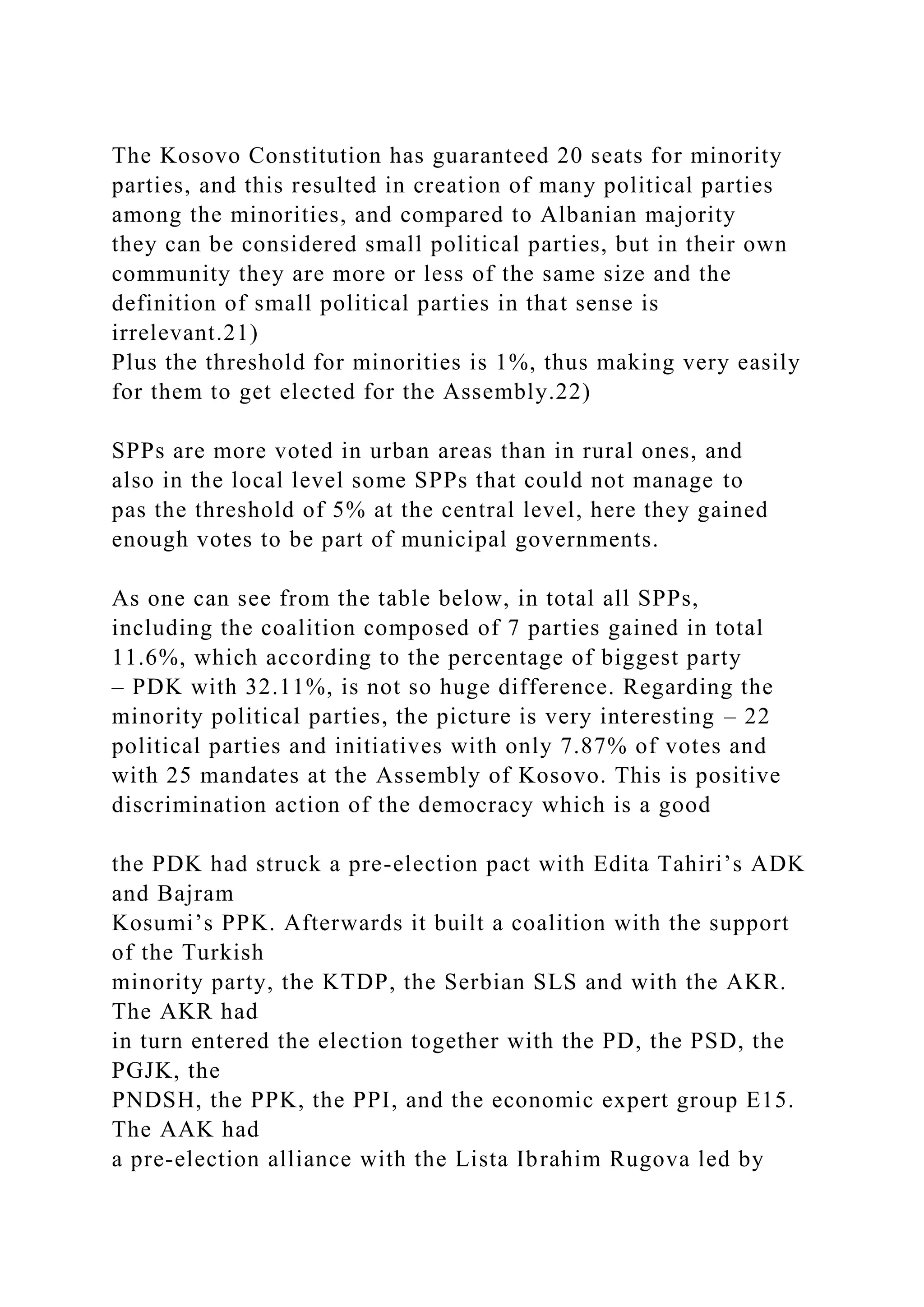

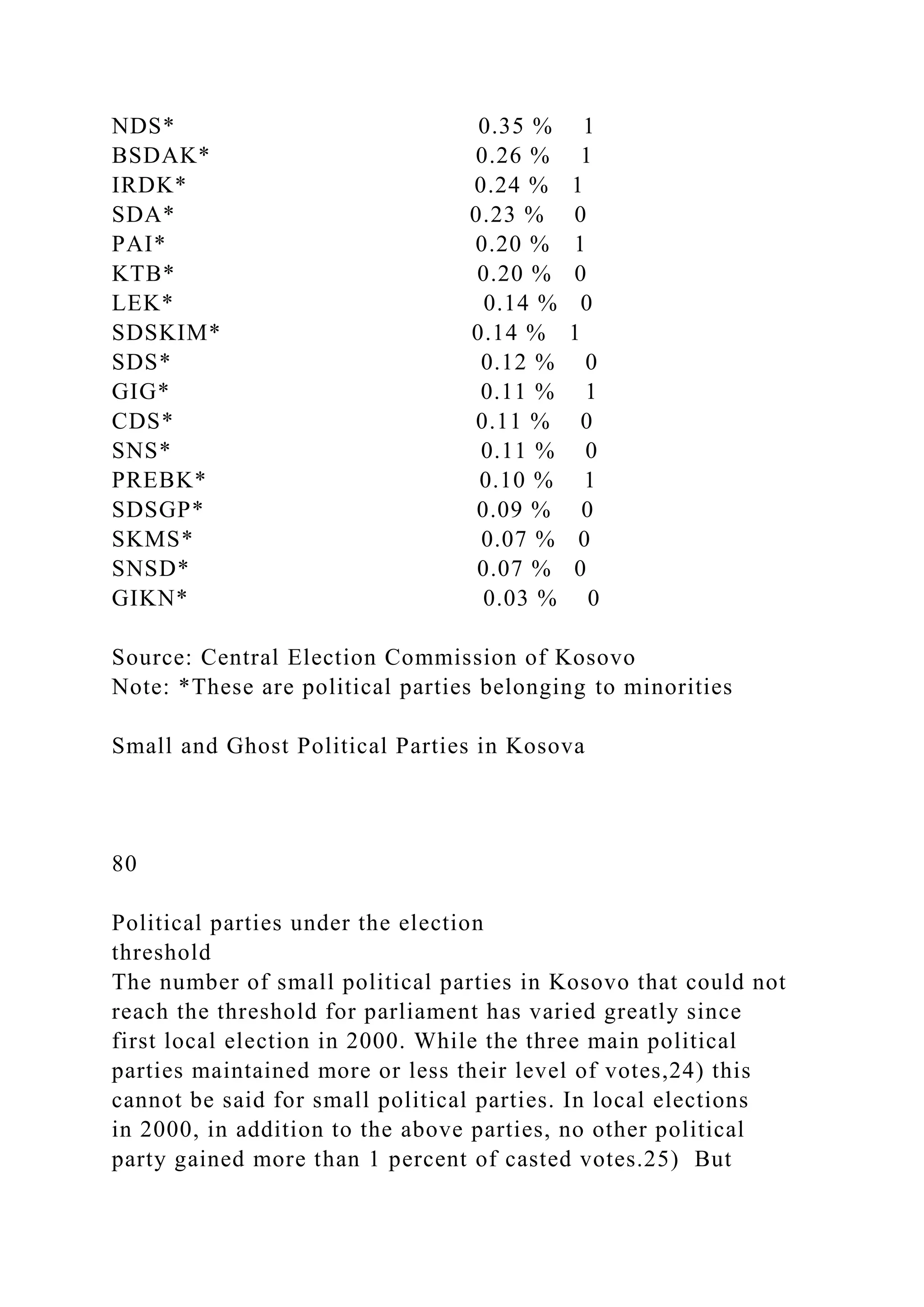
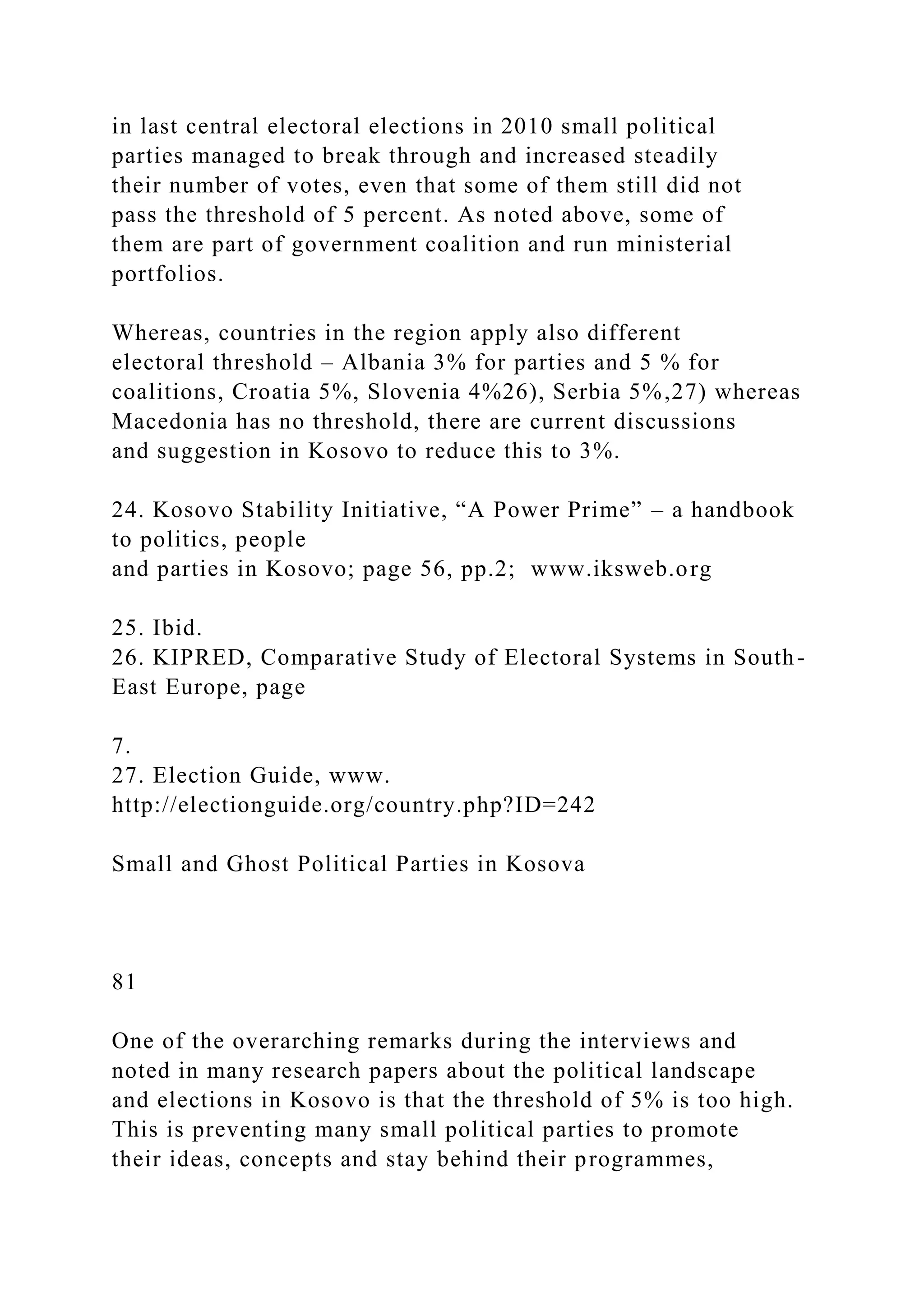


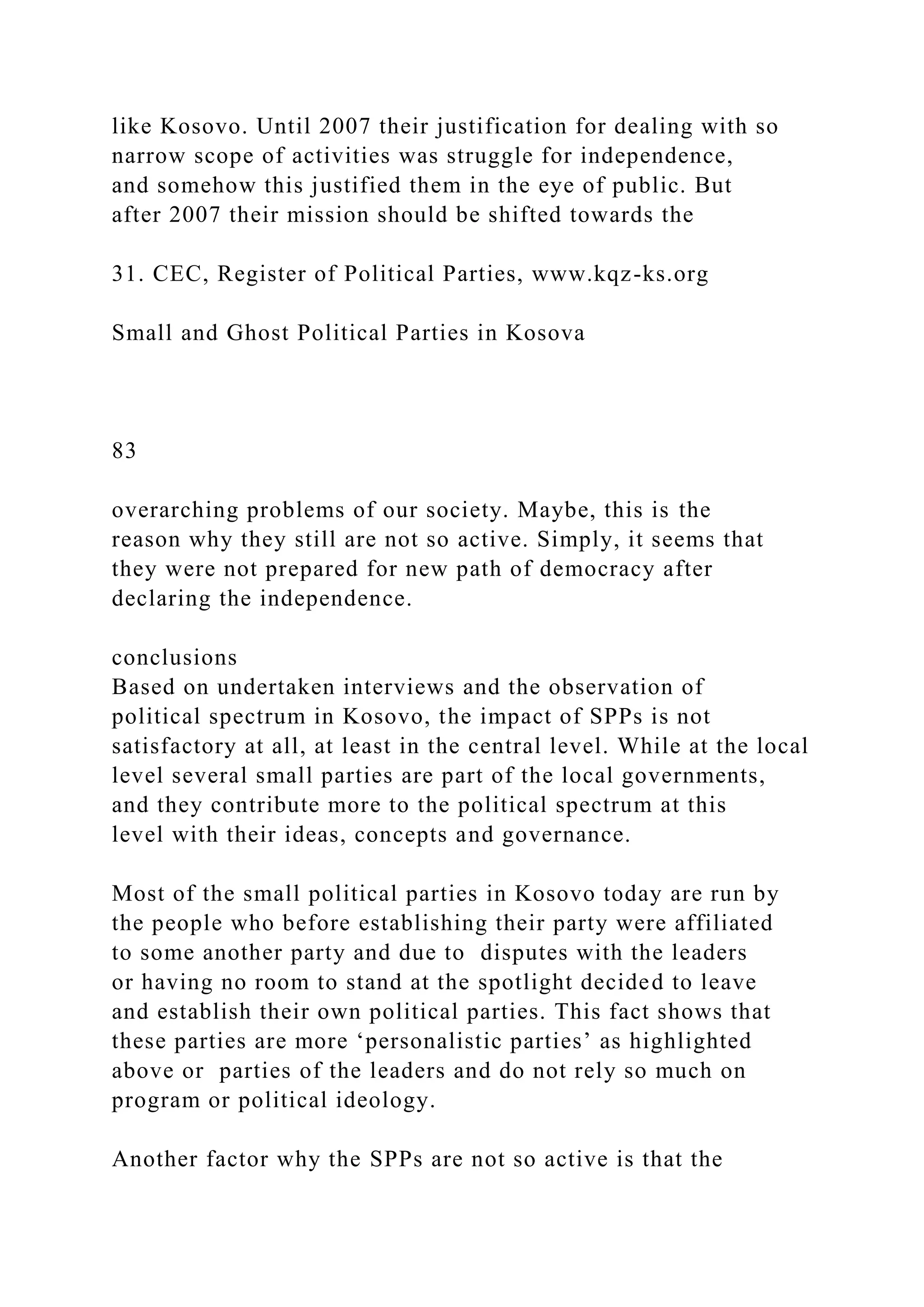


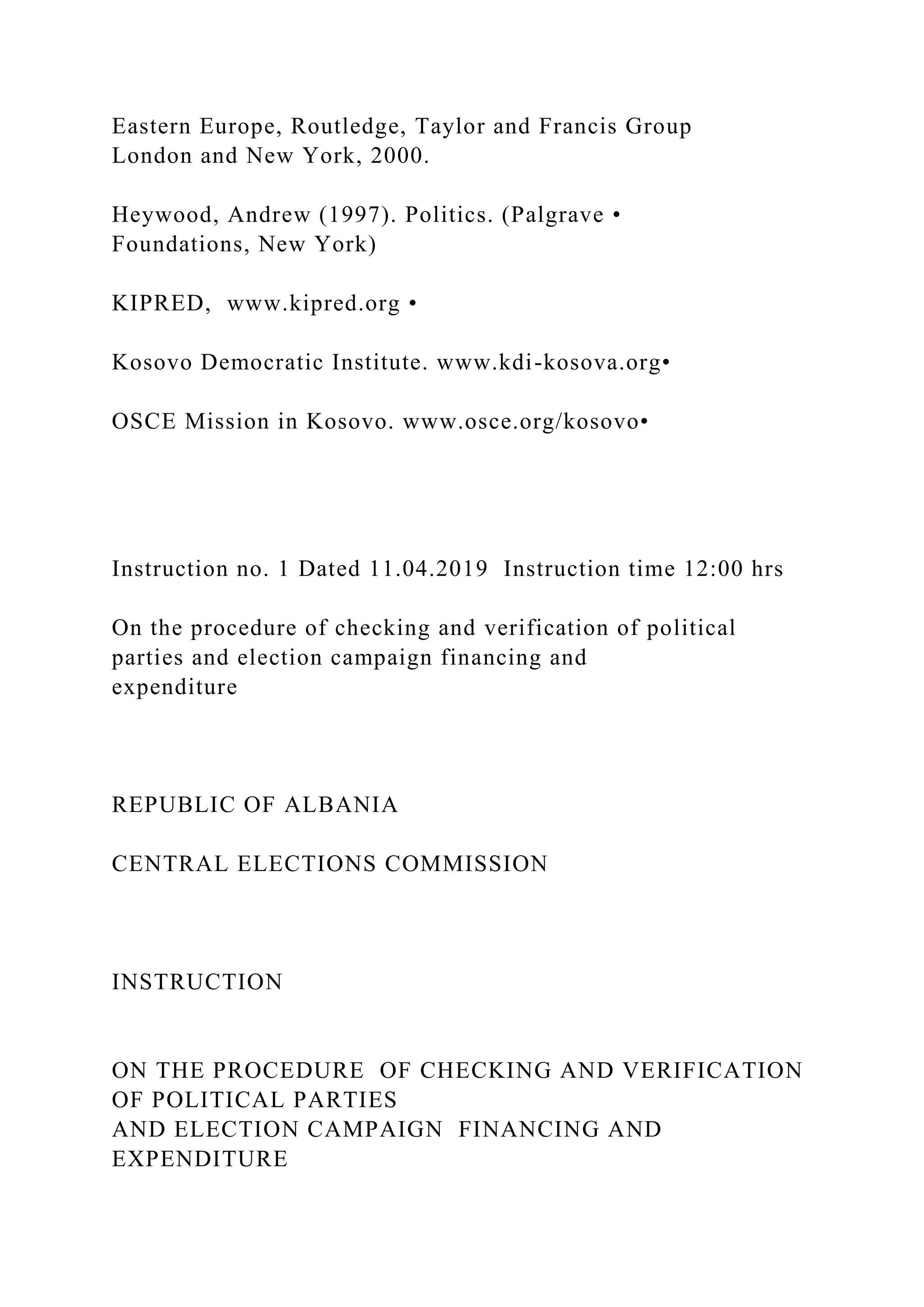
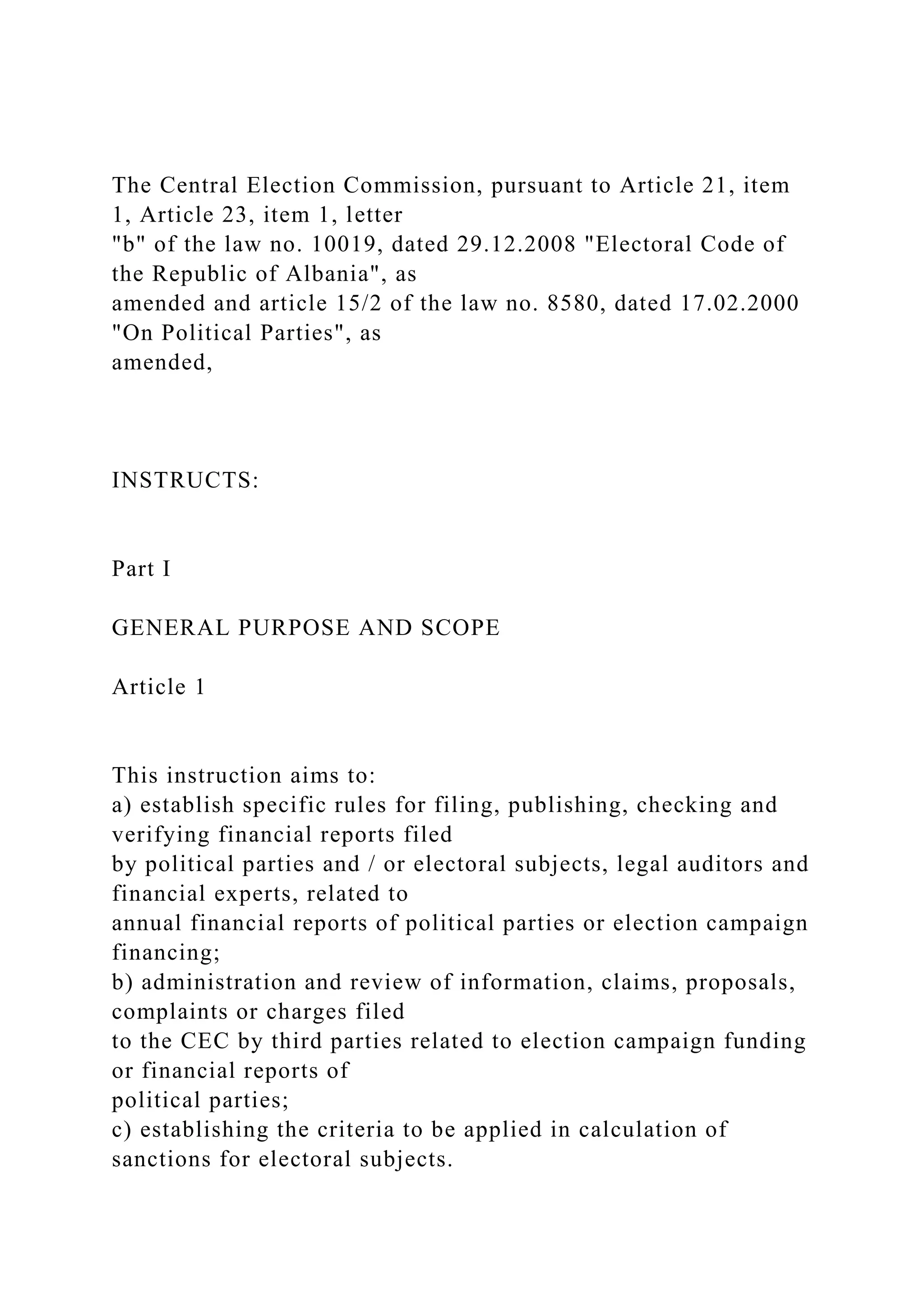
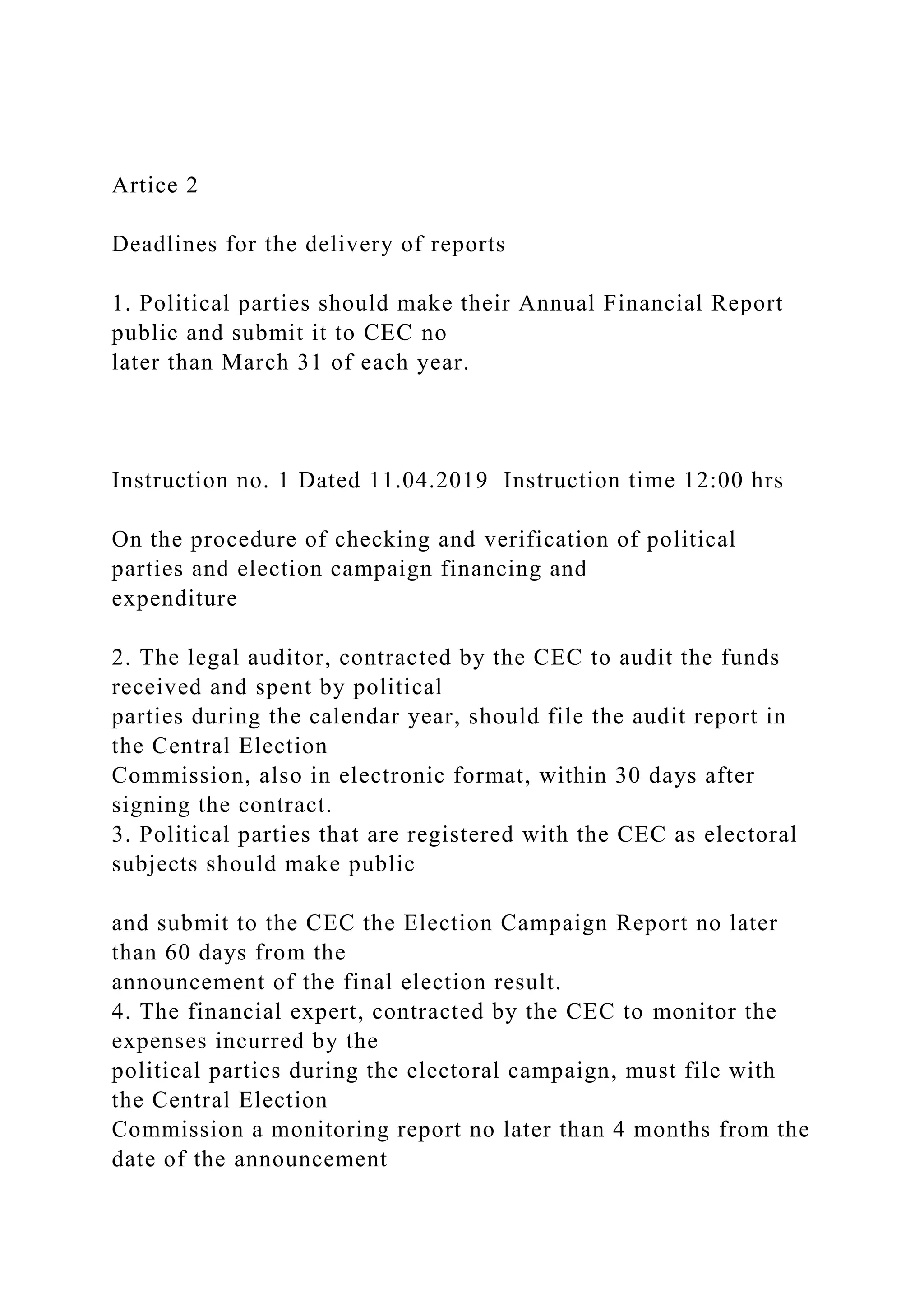



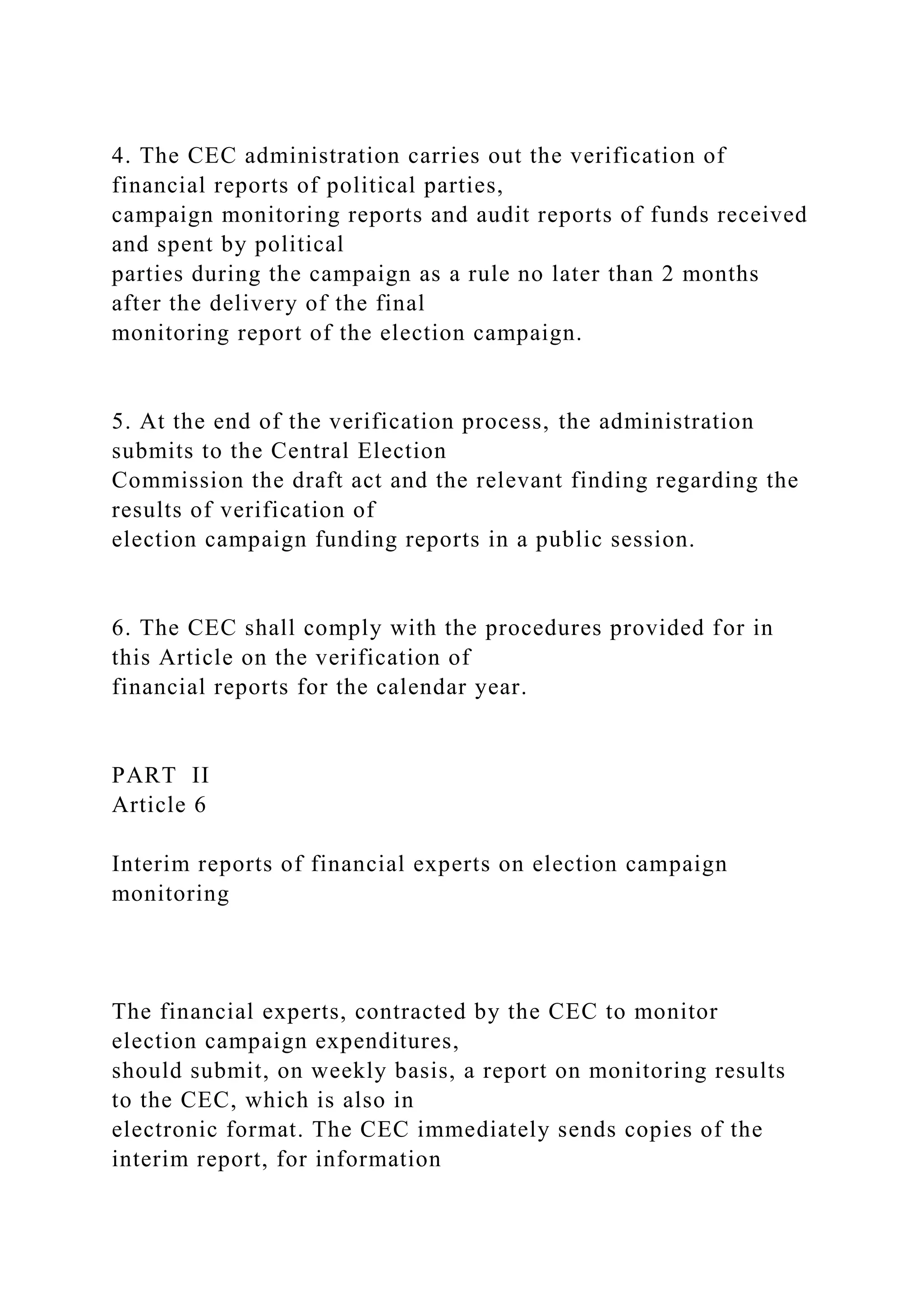


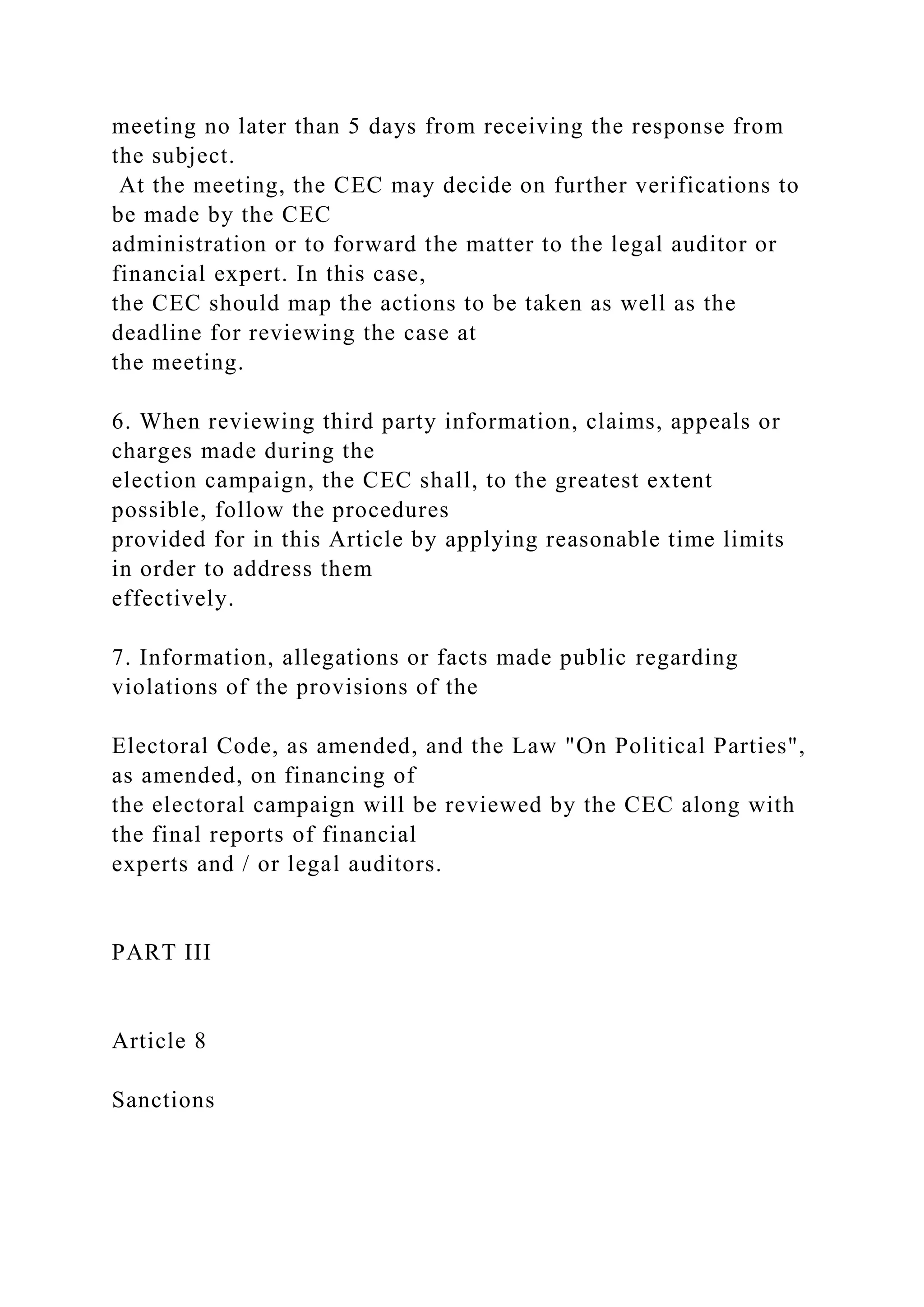


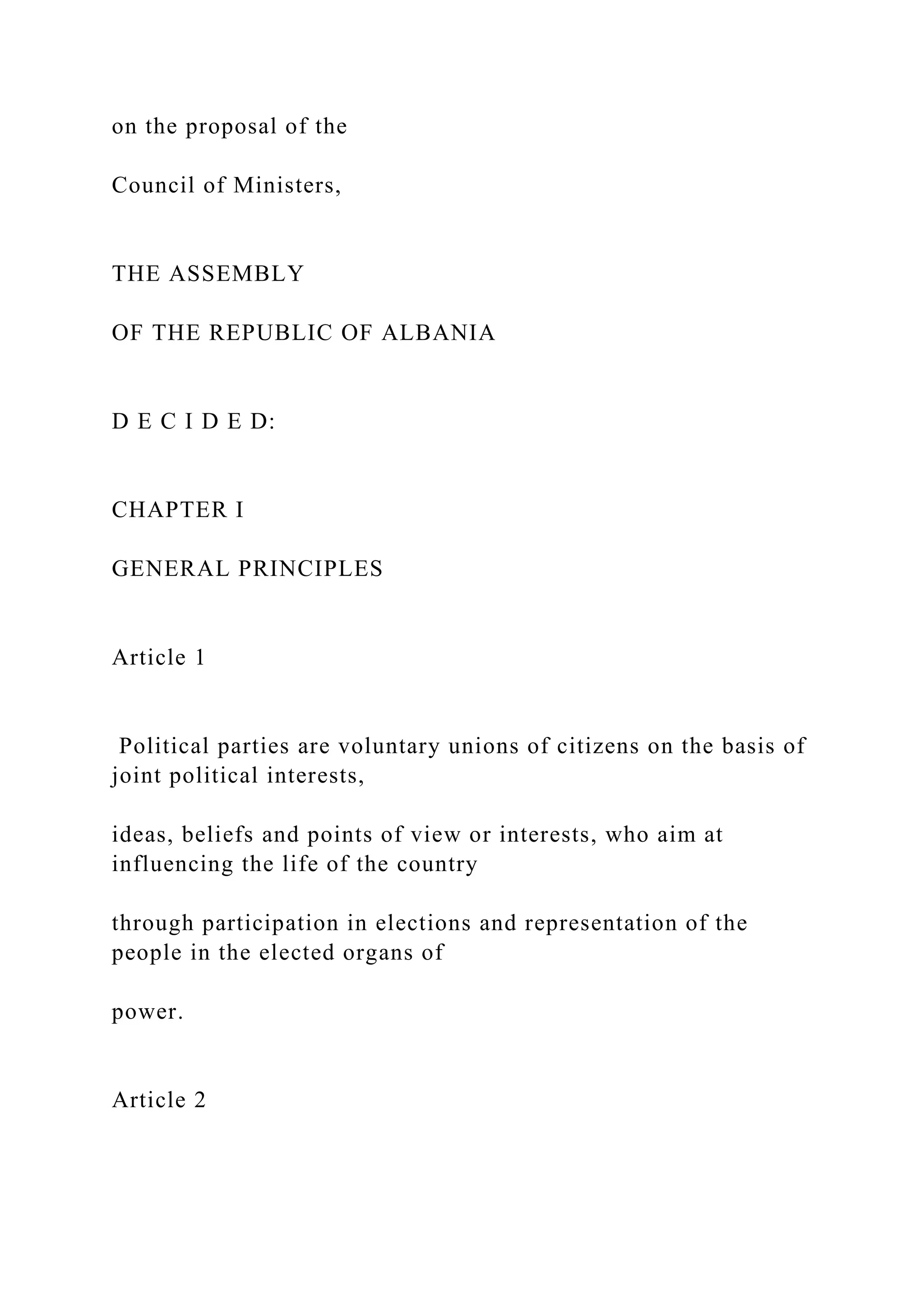



![Unconstitutional activity of political parties is prohibited.
The determination of unconstitutional activity of a political
party and its prohibition is
decided by the Constitutional Court.
CHAPTER II
THE CREATION OF POLITICAL PARTIES
Article 9
The registration of political parties is done in the court of the
first level of the district
of Tirana, which keeps the register of political parties. In the
registry of political parties there
is indicated: the numerical order of registration, the protocol
number [number of the official
document], the number of the judicial decision, the date of
announcement, the disposition of
the decision, the full name of the party, the initials of the party,
the emblem of the party, a
description of the configuration of the seal, the name of the
chairman, notes about the change](https://image.slidesharecdn.com/httpsifes-221015083553-d170a478/75/httpsifes-orgsitesdefaultfilesbrijuni18countryreport_fi-docx-467-2048.jpg)




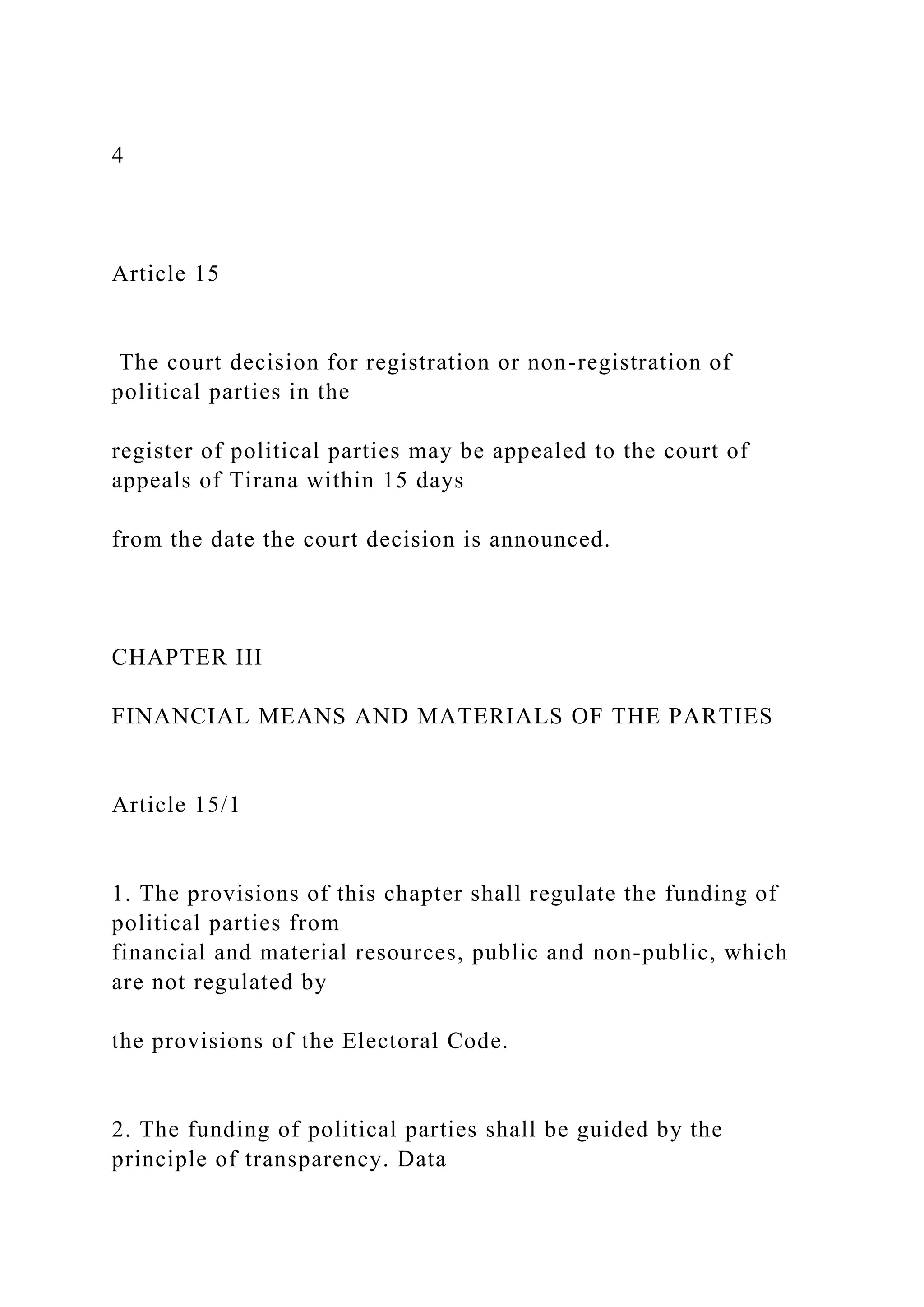
![on the parties’ financial resources and expenses shall be
published at any [given] time.
3. The rules on monitoring, supervision and auditing of
financial and material resources
must observe at all times the equality of political parties before
the law and must not
infringe their right to be established freely.
Article 15/2
1. The Central Election Commission is the body responsible for
the monitoring and
supervision of the funding of political parties according to the
rules of this law.
2. The Central Election Commission, based on and in order to
implement this law, has
the following competencies:
a. It drafts and adopts both rules on reporting of funding, on
monitoring, supervision and
financial auditing of political parties, and standardised
templates of annual financial
reporting;
b. It approves both the template of the special record book
[register] of non-public funds](https://image.slidesharecdn.com/httpsifes-221015083553-d170a478/75/httpsifes-orgsitesdefaultfilesbrijuni18countryreport_fi-docx-473-2048.jpg)

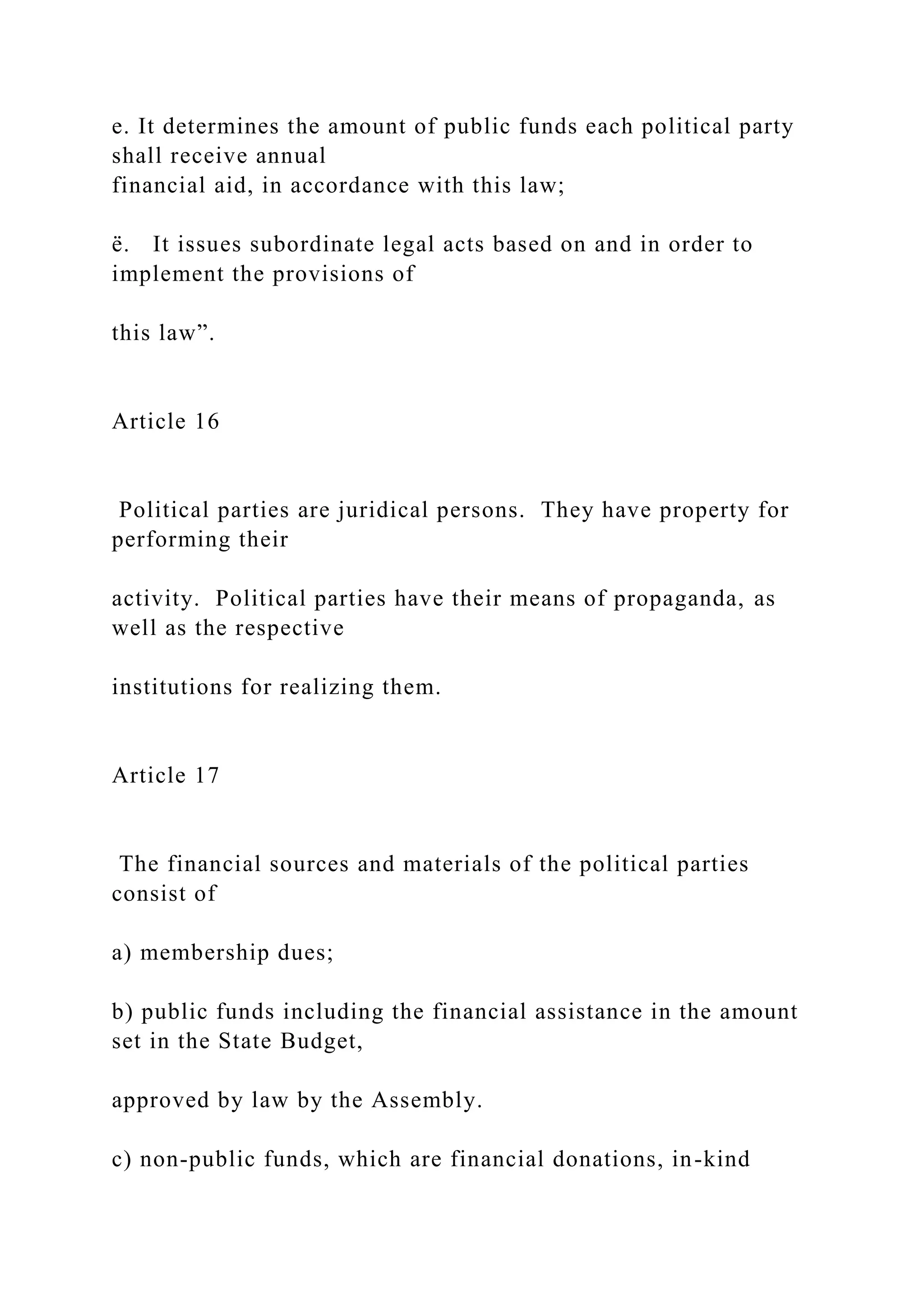

![parliamentary
elections;
c) 10 percent shall be divided according to the percentage
obtained among [by] the
political parties that took part in the last parliamentary elections
and obtained over
1 percent of the votes.
The non-allocated remainder of the 10 percent shall be added to
the 70 percent fund
and it shall be divided among parliamentary parties.
3. The concrete amount of the public fund received by each
political party in the form of
annual financial aid in compliance with this law shall be
determined by a decision of the
Central Election Commission. Both the beneficiary political
parties and Ministry of Finance
shall be notified of this decision.
4. In any case, annual financial aid shall be awarded on the
proviso that political parties have
already submitted the financial report of the preceding year
according to the rules defined by](https://image.slidesharecdn.com/httpsifes-221015083553-d170a478/75/httpsifes-orgsitesdefaultfilesbrijuni18countryreport_fi-docx-477-2048.jpg)

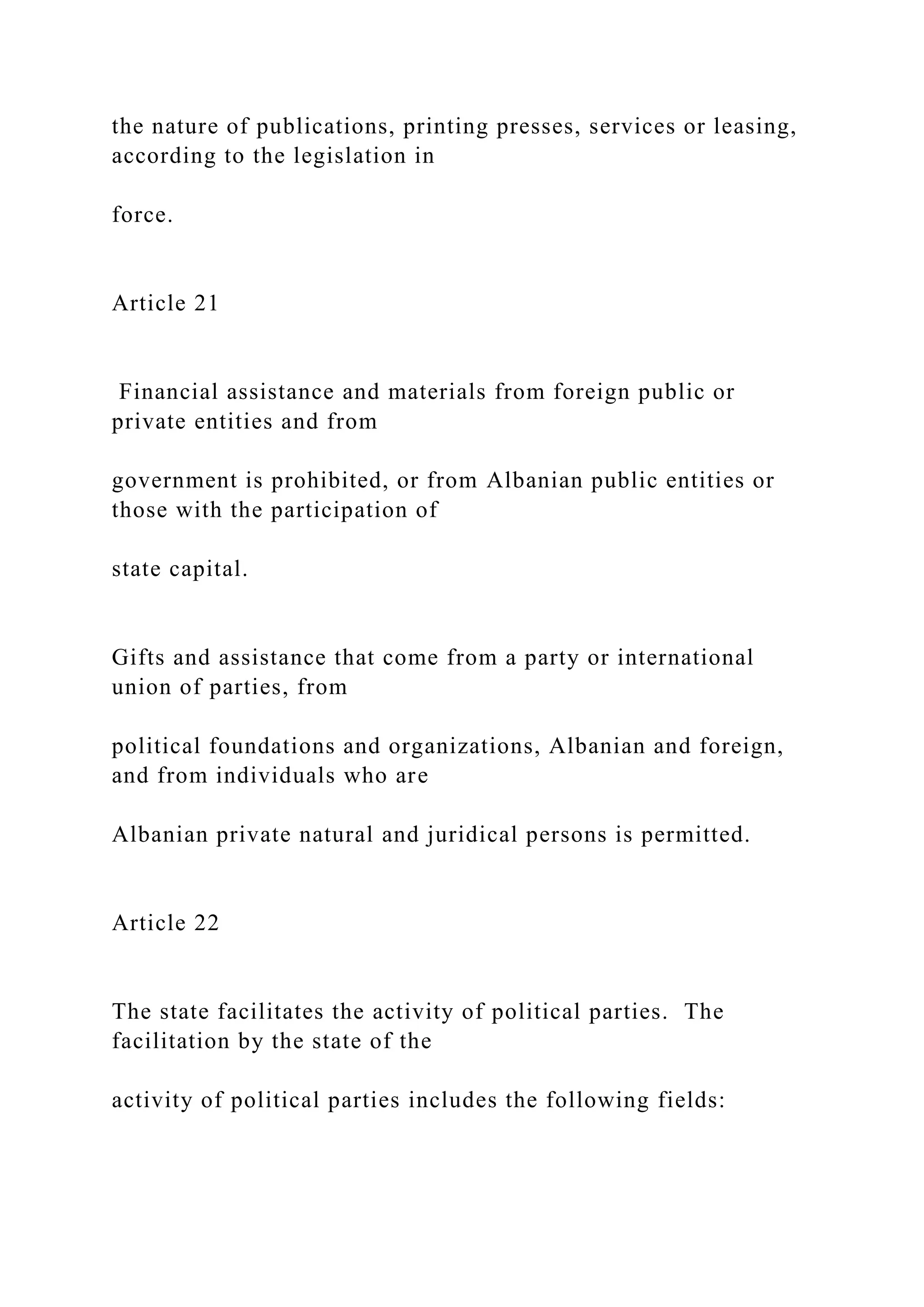


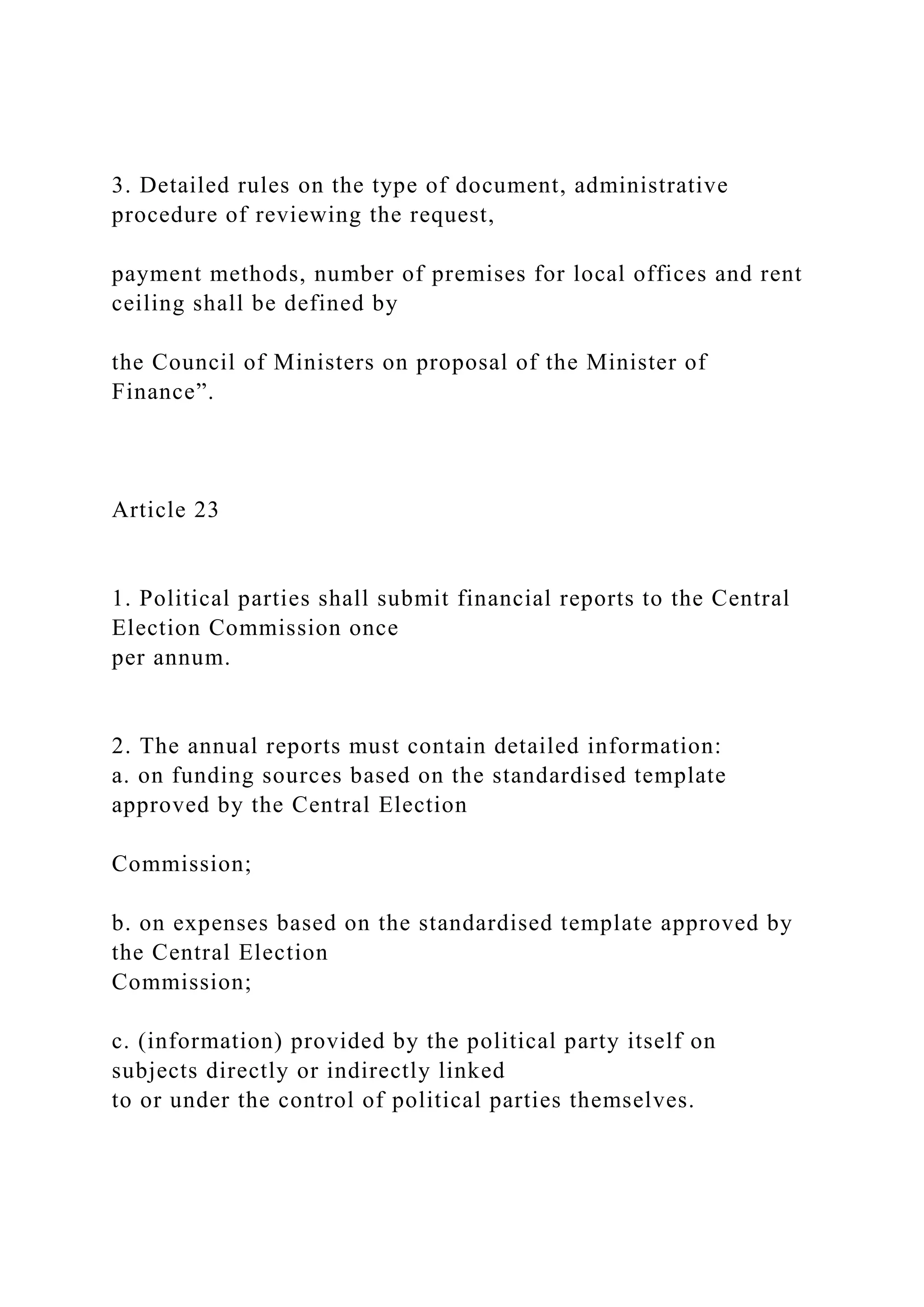
![3. Political parties shall submit the annual financial report along
with the auditing report
drawn up by certified accounting experts in accordance with the
provisions of this law.
4. The annual financial report shall be submitted either by the
person in charge of finances
at the political party or by an individual assigned [to carry out
this duty] by the statute of
the political party within the timeframe defined by the Central
Election Commission.
5. During an election year, the financial reports of the political
party must be submitted with
the financial report of the election campaign.
6. The annual financial report, the report of the certified
accounting experts, the financial
report of the election campaign and the report of the Central
Election Commission shall
be published in the official website of the Central Election
Commission no later than 30
days from the date of their submission by the political party”.
Article 23/1
1. Each political party must record in a special record book,](https://image.slidesharecdn.com/httpsifes-221015083553-d170a478/75/httpsifes-orgsitesdefaultfilesbrijuni18countryreport_fi-docx-483-2048.jpg)
![according to the template
approved by the Central Election Commission, the amount of
funds received by any
natural or legal person, and data clearly defining the identity of
the donor. When
awarding the donation, the donor shall at all times be obliged to
sign a donation
statement, in accordance with the template approved by the
Central Election Commission.
8
8
The list of persons who donate funds of not less than one
hundred thousand ALL along
with the respective amount [donated] shall be made public at all
times.
2. The donation of non-public funds in excess of one hundred
thousand ALL must be made
only through a special bank account opened by the political
party. The person in charge
of finances at the political party shall notify the Central
Election Commission of the bank](https://image.slidesharecdn.com/httpsifes-221015083553-d170a478/75/httpsifes-orgsitesdefaultfilesbrijuni18countryreport_fi-docx-484-2048.jpg)

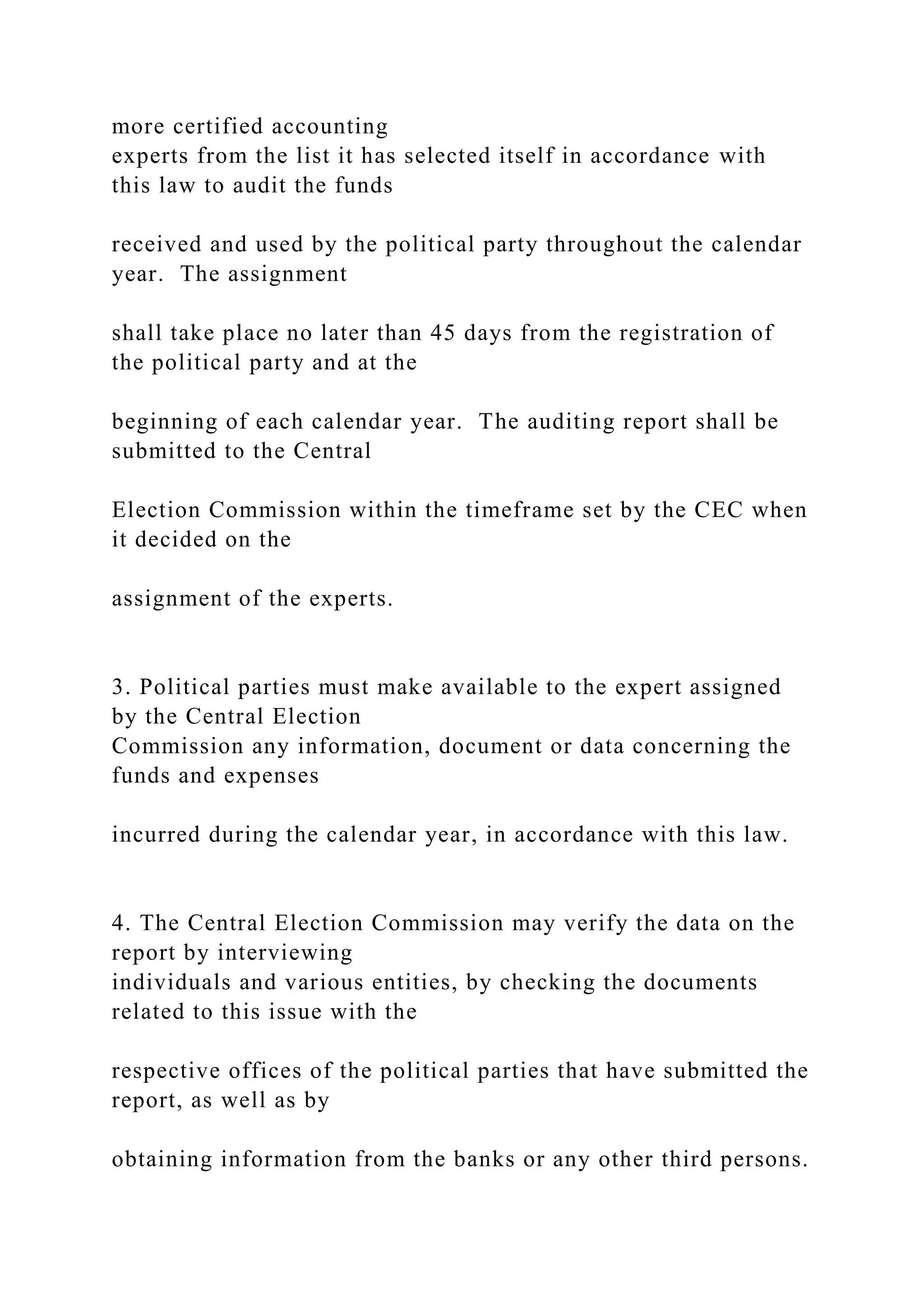

![2. The expenses needed to audit the political parties shall be
covered by the political parties
themselves. Political parties shall transfer the sums needed for
this purpose to the bank
account of the Central Election Commission. Detailed rules on
the running of this process
shall be defined by way of an instruction issued by the Central
Election Commission.
Article 23/4
1. The infringement of the provisions of the funding of political
parties by the person in
charge of finances within the political party or the individual
assigned by the party statute
[to carry out this duty] shall be punishable by a fine of 50 000
to 100 000 ALL.
2. The infringement of the obligation of the political party to
cooperate with the certified
accounting expert assigned by the Central Election Commission
shall be subject to a fine
of 1 000 000 to 2 000 000 ALL.
3. Failure or refusal to make the financial sources of the
political party transparent or to](https://image.slidesharecdn.com/httpsifes-221015083553-d170a478/75/httpsifes-orgsitesdefaultfilesbrijuni18countryreport_fi-docx-488-2048.jpg)









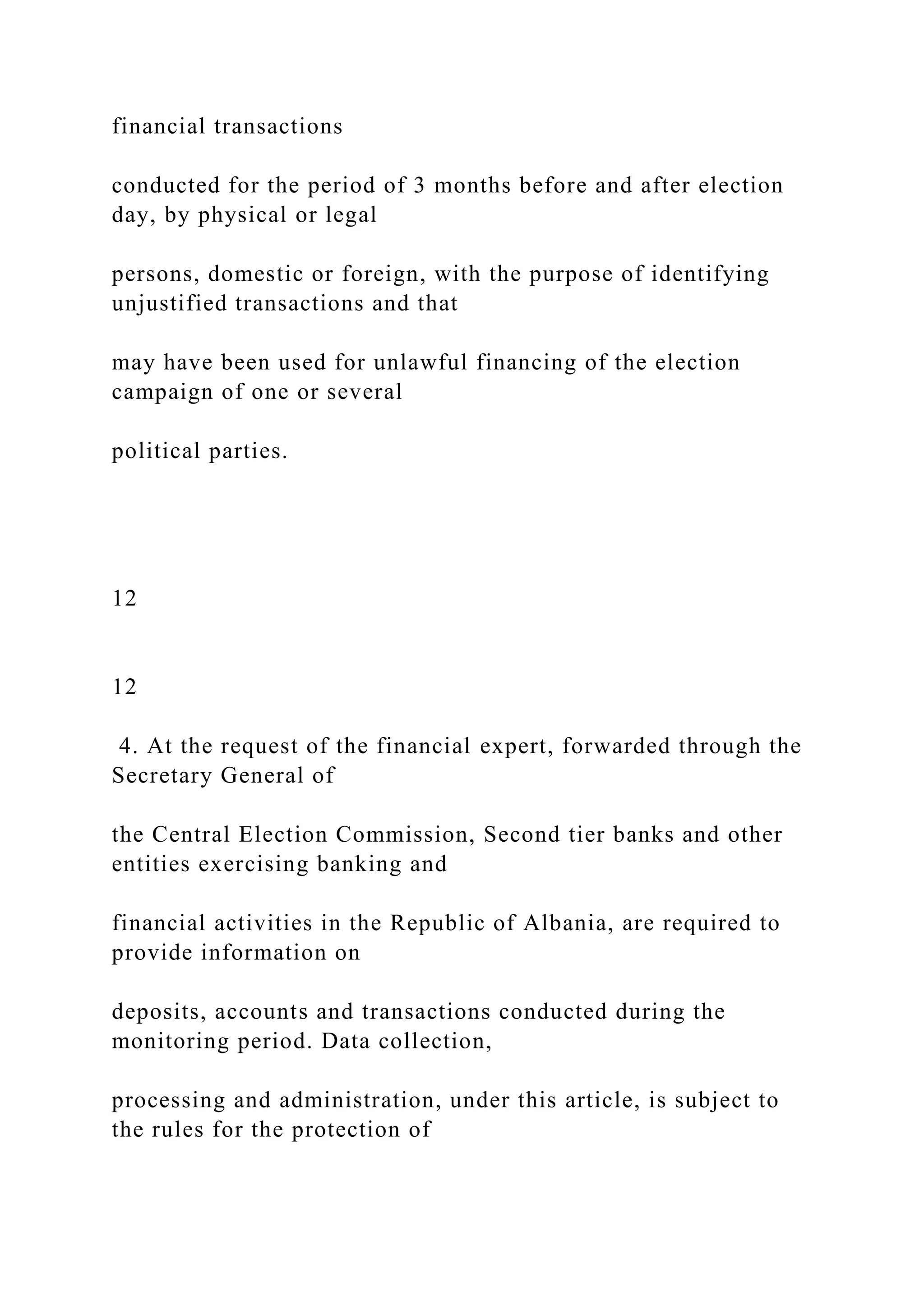










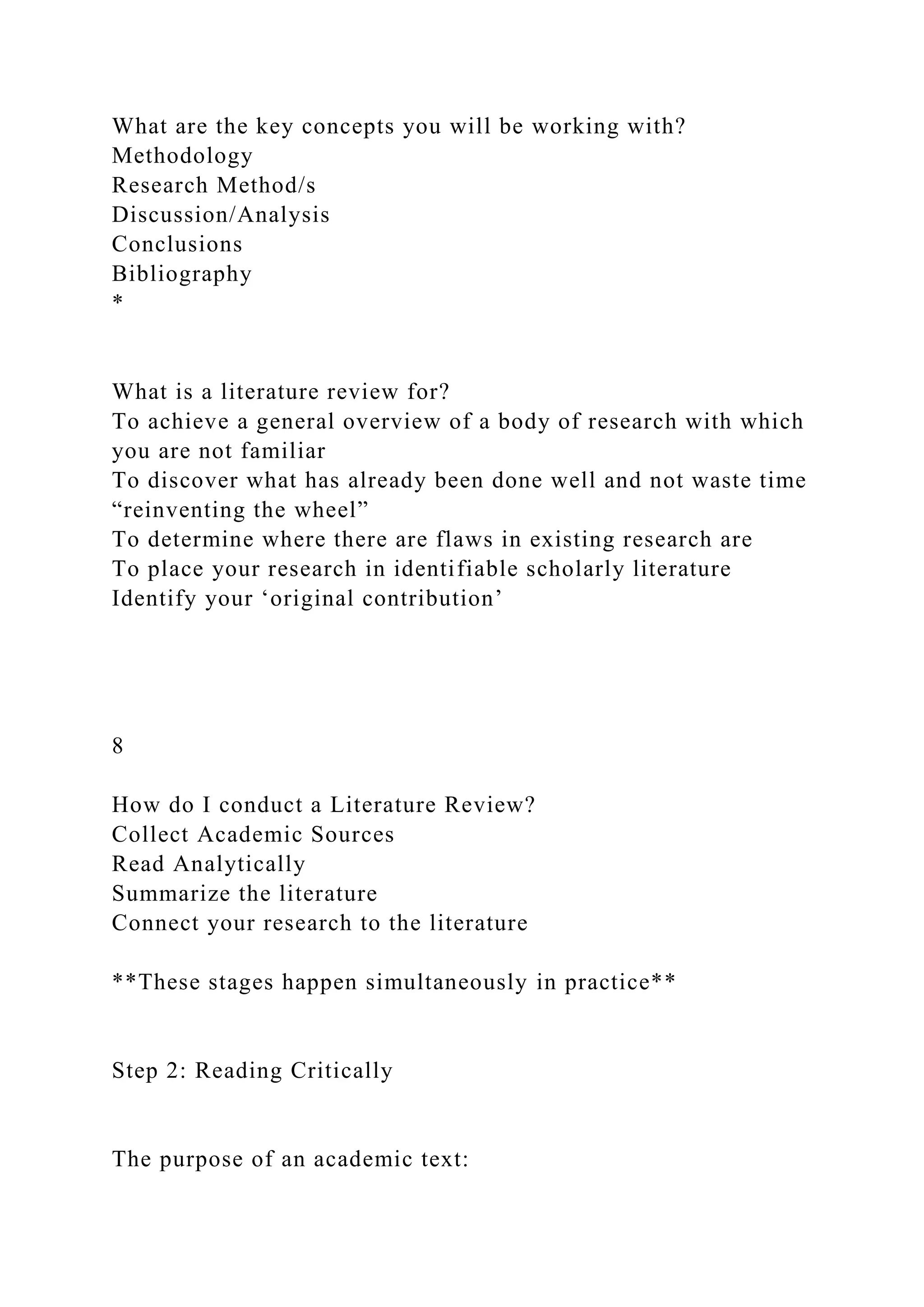
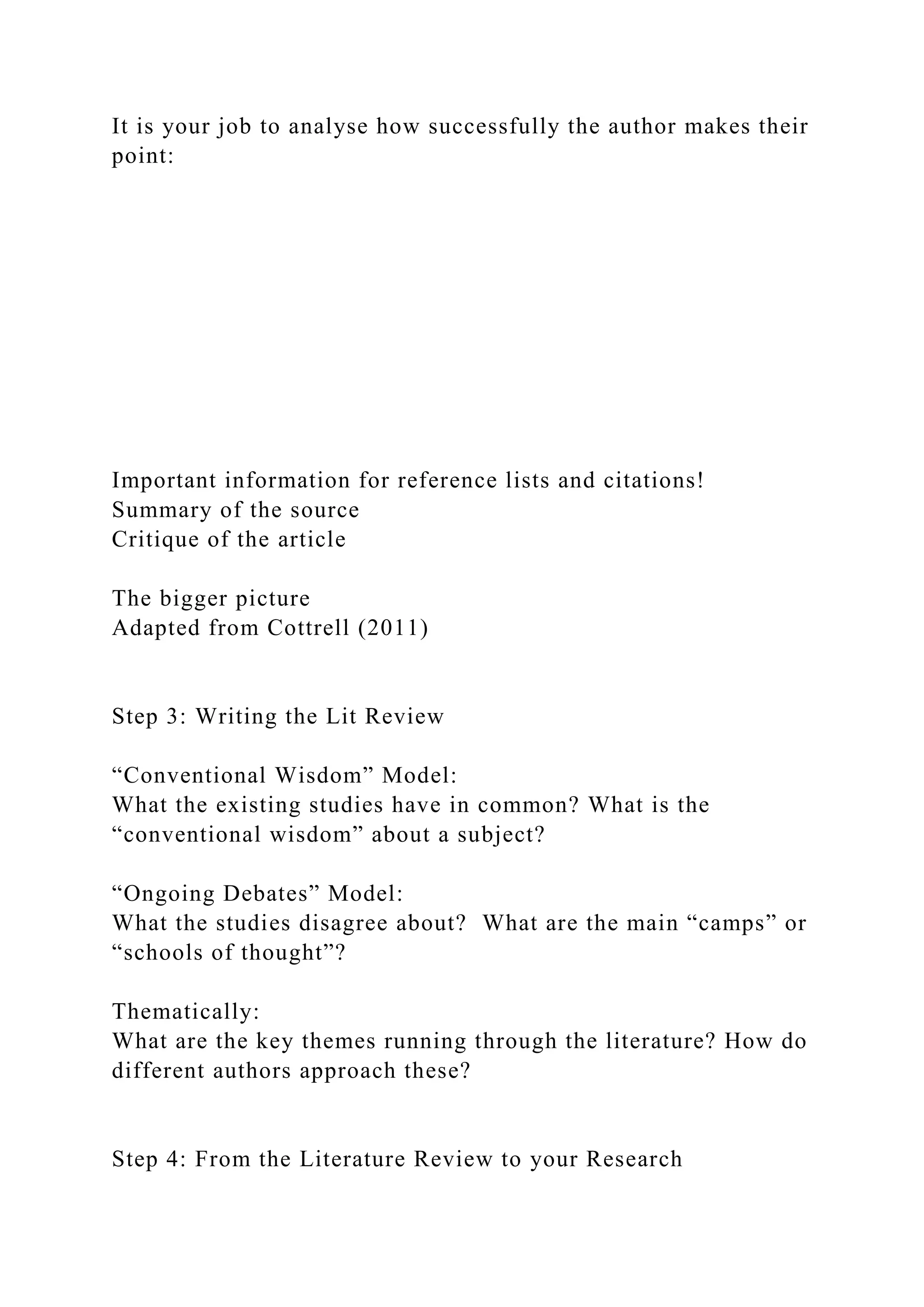




![YOUR RESPONSIBILITY TO CONTACT THEM
Seeking advice from other members of staff
You can also ask for specific advice from other members of
staff as long as you do not expect the other person to replace the
supervisor
Academic Tutor
For additional academic support, contact [email protected]
Administrative questions,
please contact [email protected] (T1); [email protected] (T2)
6
Questions?
7
Feedback
What was one piece of positive feedback you received on
IP2021
What was one thing you were told to improve on IP2021?
The Research Process](https://image.slidesharecdn.com/httpsifes-221015083553-d170a478/75/httpsifes-orgsitesdefaultfilesbrijuni18countryreport_fi-docx-515-2048.jpg)



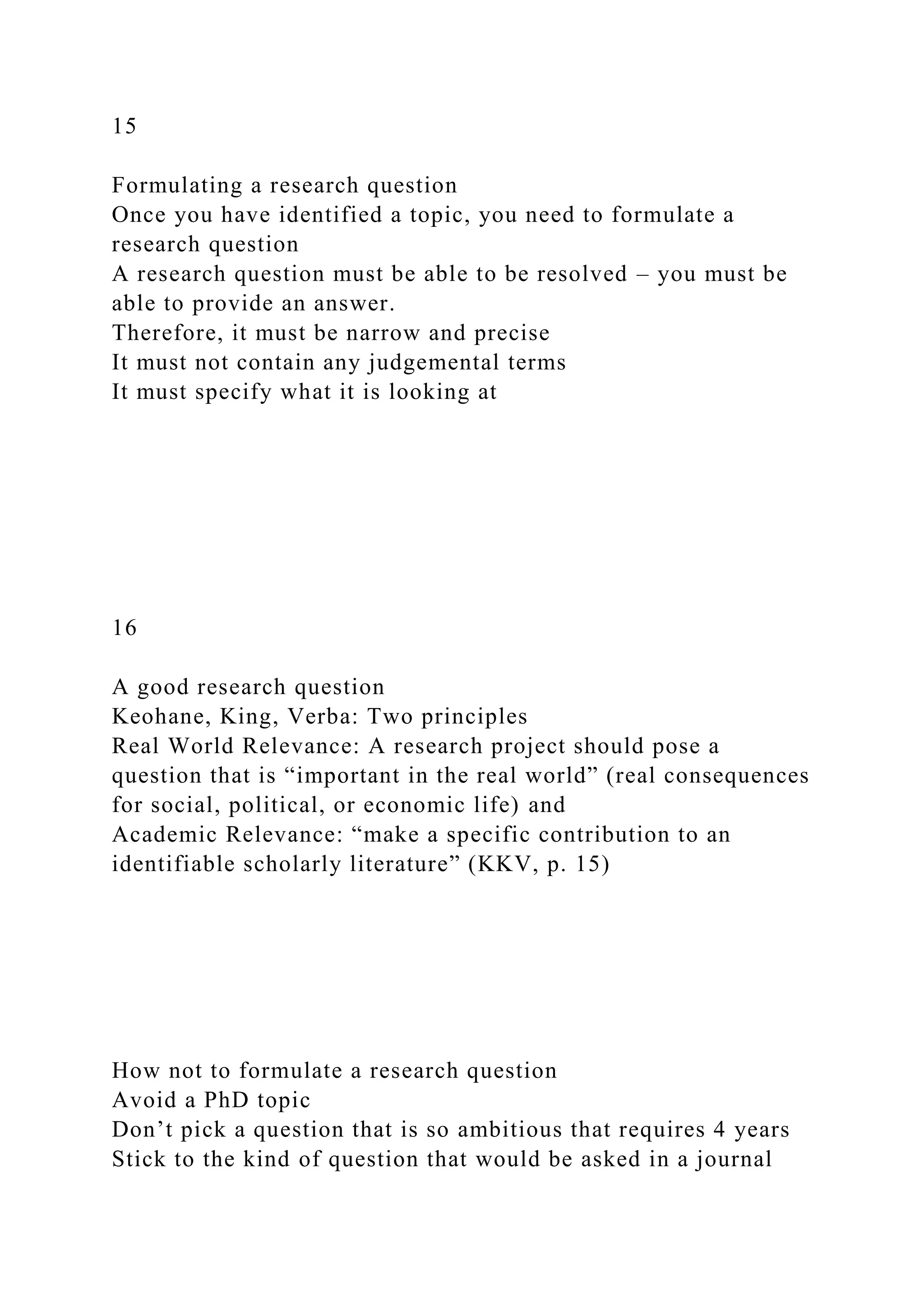

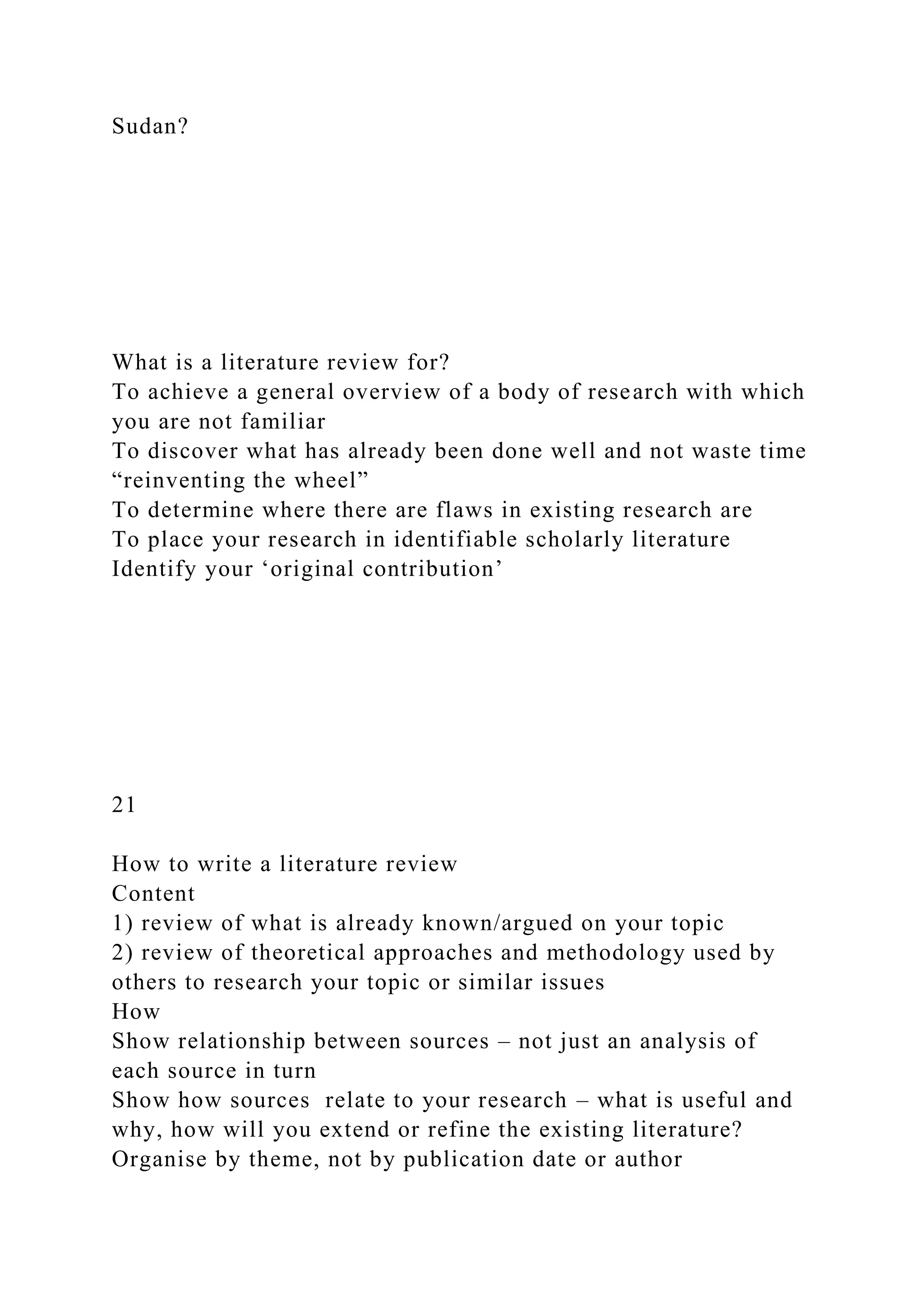
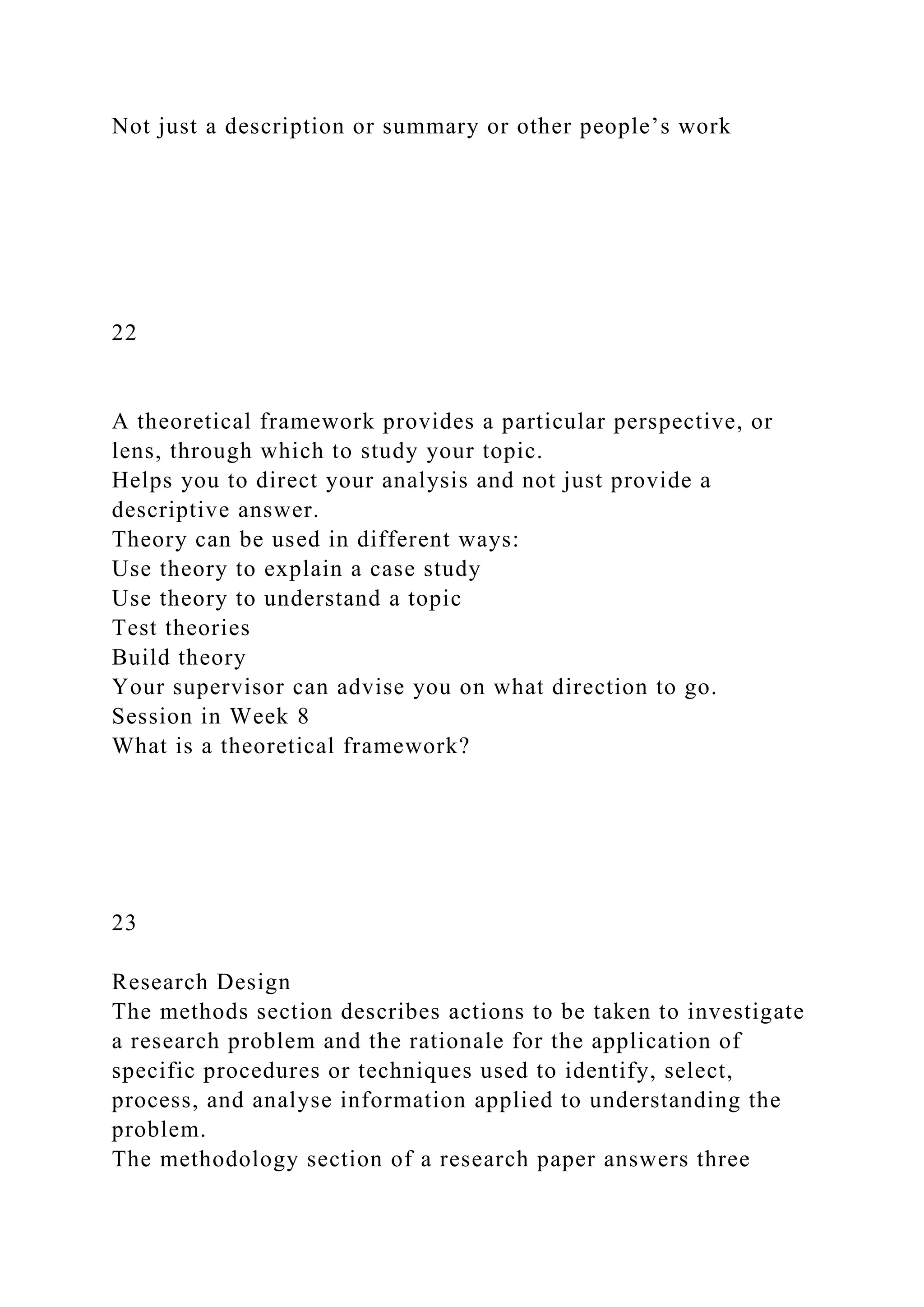



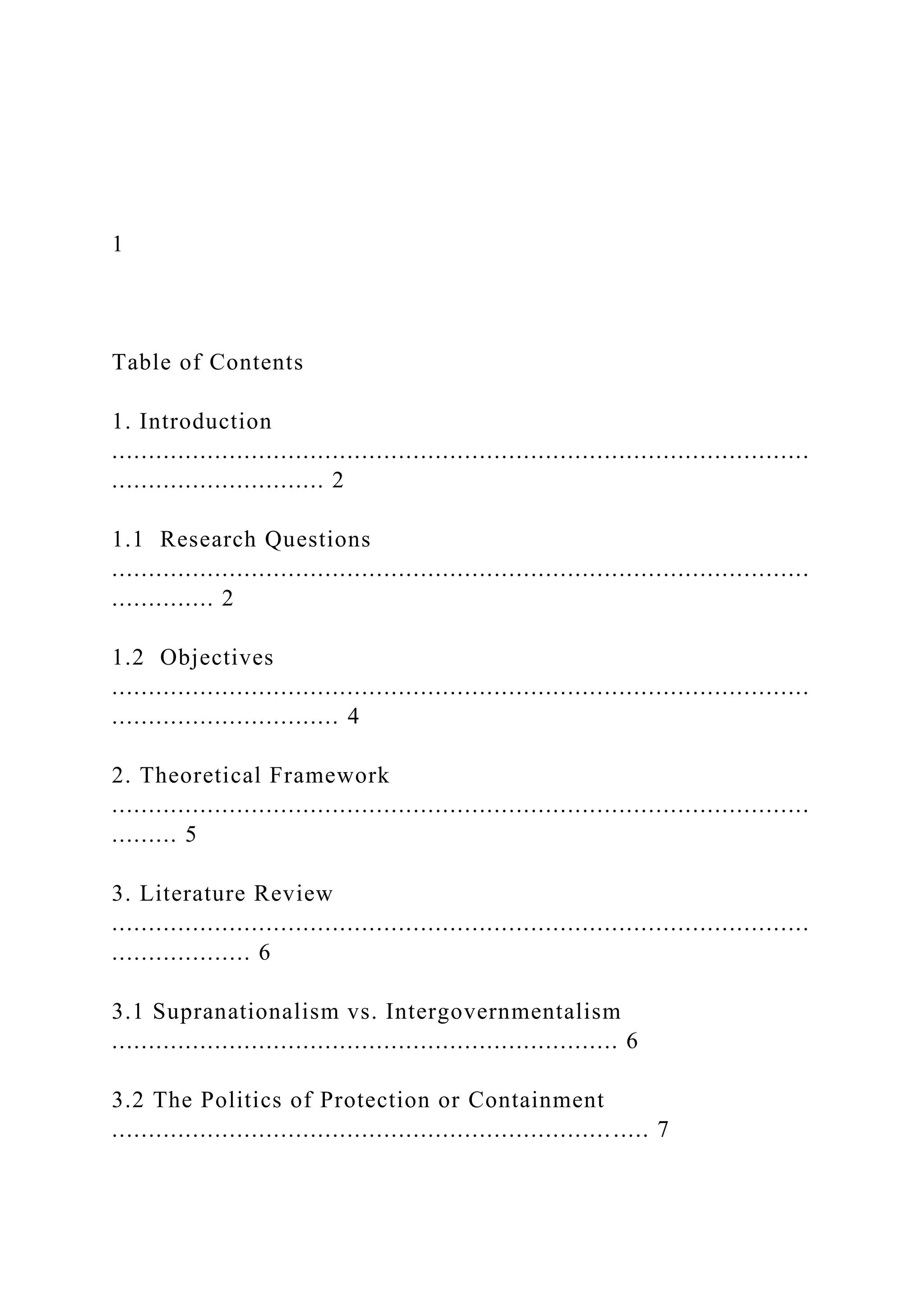
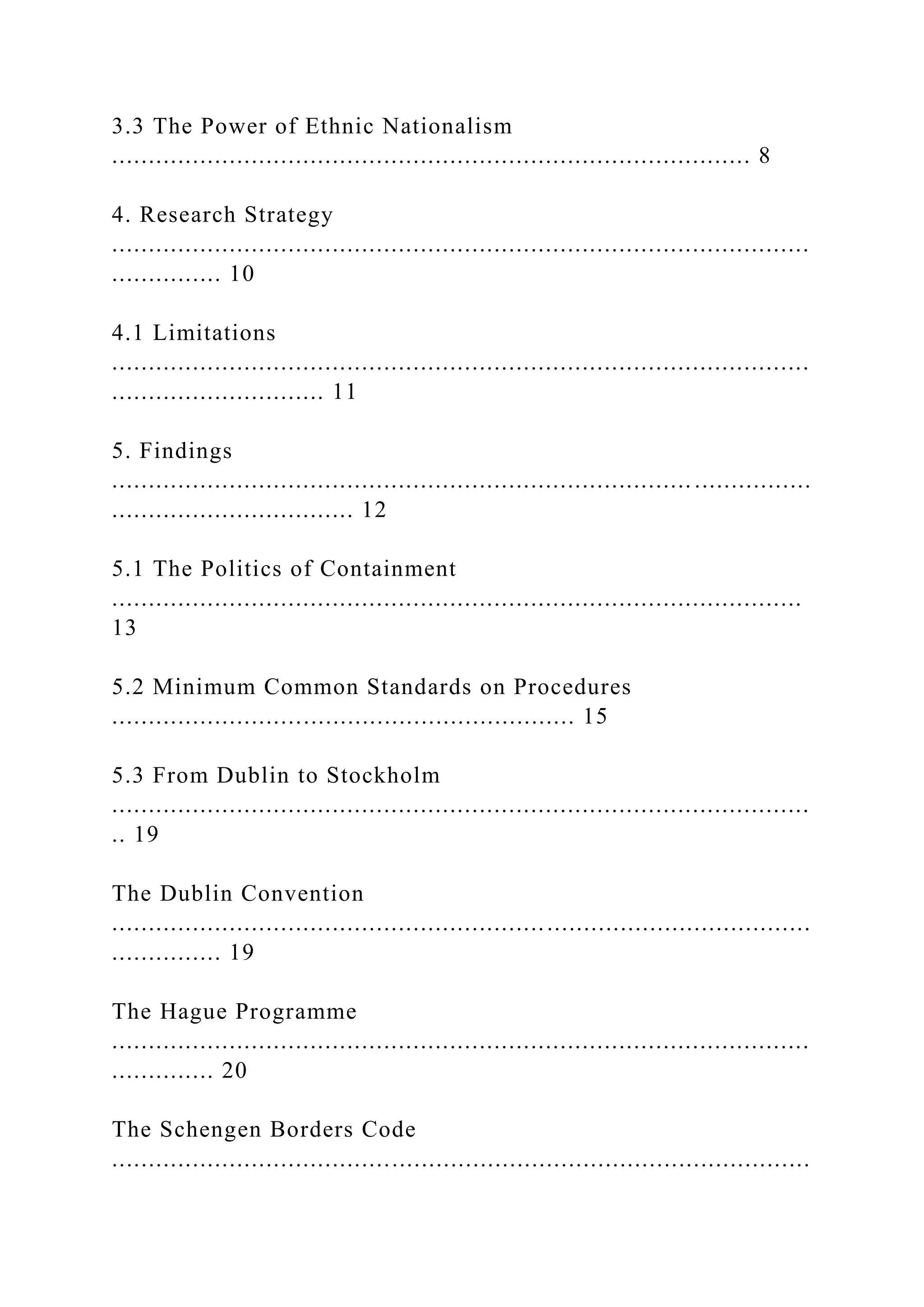


![, rather than liberal, democratic and humanitarian responses
supposedly
working under an umbrella of supranationalism. As a result,
European borders pose as
‘highly differentiated border zones [...] of highly perforated
systems or regimes’
2
, with
decision making driven by individual Member States’ interests,
portraying the Union as
incapable of adequately responding to flows of asylum seekers
attempting to reach its
borders.
Despite the common belief that this inability results from the
reluctance of Member
States to assume responsibility, or their concerns over the
notions of sovereignty and
power, the fact that European borders have been ‘more real for
most non-OECD
national than for members of OECD countries’
3
calls for different explanations.
Exclusionist policies of the European asylum regime divide
global society into groups of
‘Us’ and ‘Them’, whereby a ‘civilised European order is](https://image.slidesharecdn.com/httpsifes-221015083553-d170a478/75/httpsifes-orgsitesdefaultfilesbrijuni18countryreport_fi-docx-530-2048.jpg)
![situated like an island within a
threatening sea of starving, brutalised, but determined-because-
desperate inferior
peoples’
4
aiming to find refuge within European borders.
1.1 Research Questions
This paper seeks to unveil the space created by the European
asylum regime to allow
Member States to choose the preferred and exclude unwanted
asylum seekers,
adopting an essentialist concept of the nation through a lens
which argues that ‘if your
race or culture or religion does not fit the parameters, then you
cannot belong’
5
. By
implementing barriers to entry for specific groups of asylum
seekers, the European
Union allows the ethnic nationalist sentiments of its Member
States to guide policy on
asylum down a path of social exclusivity whereby Europe is
created ‘less as a
cosmopolitan melting pot and more [as] a white fortress’.](https://image.slidesharecdn.com/httpsifes-221015083553-d170a478/75/httpsifes-orgsitesdefaultfilesbrijuni18countryreport_fi-docx-531-2048.jpg)
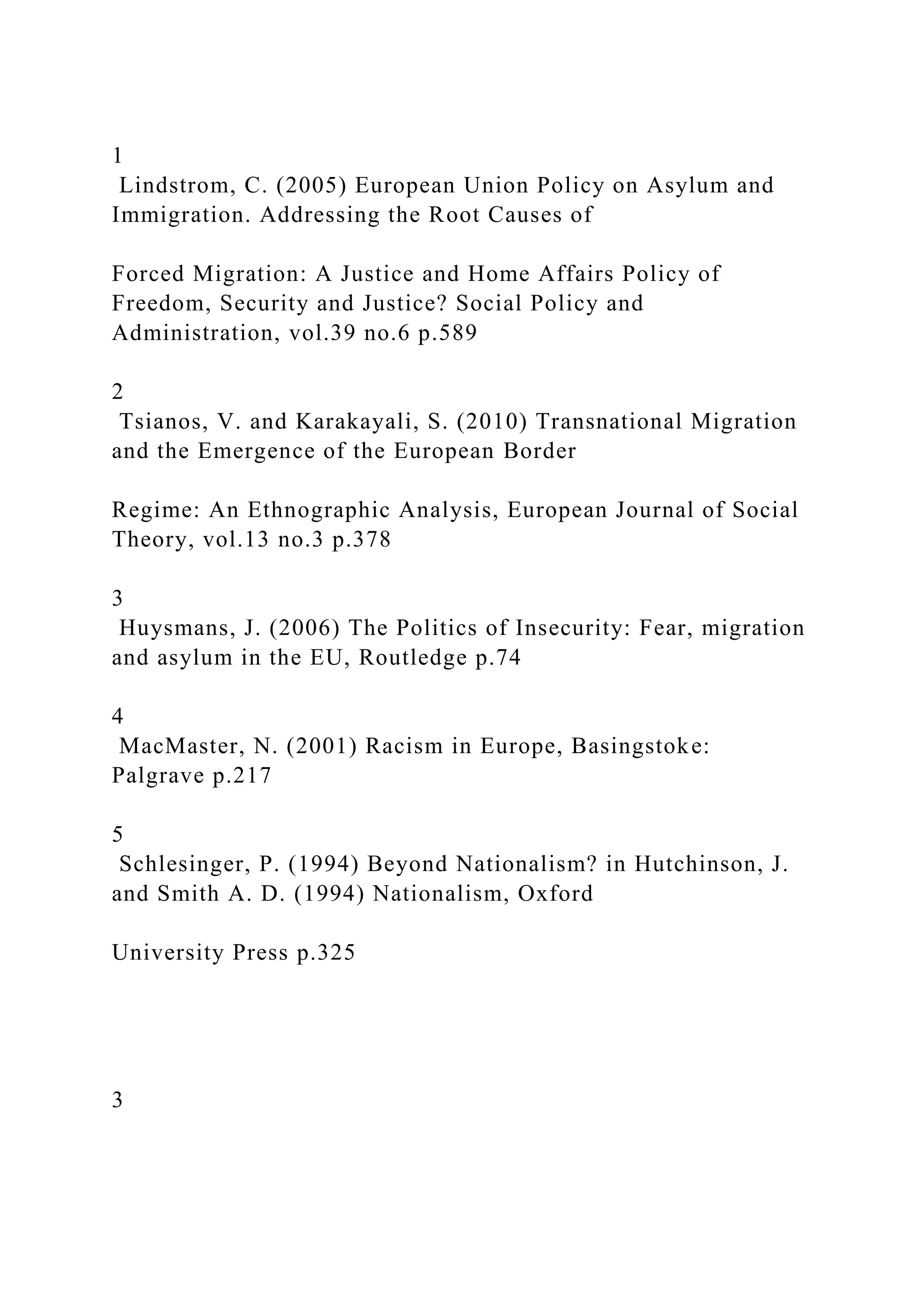


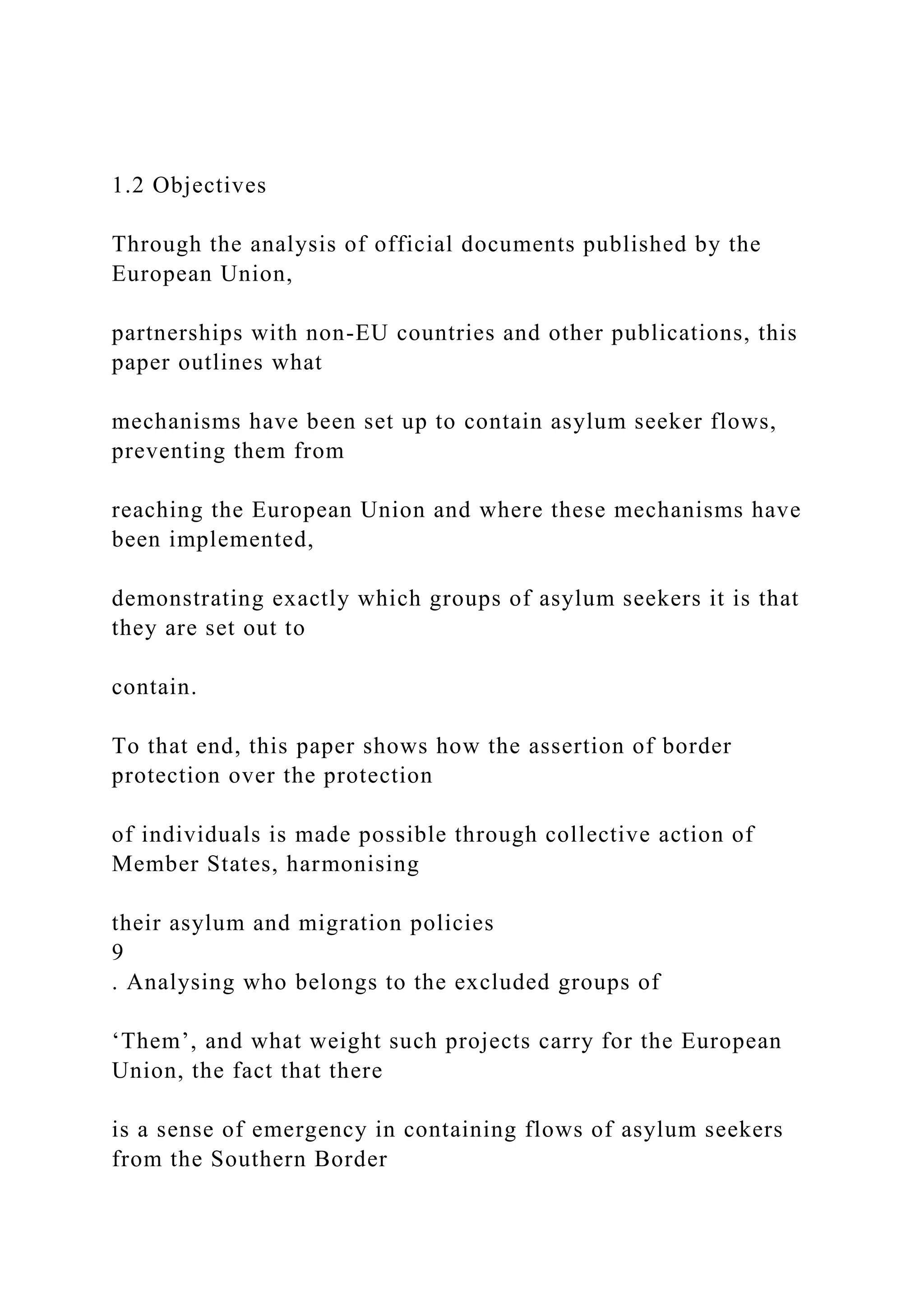




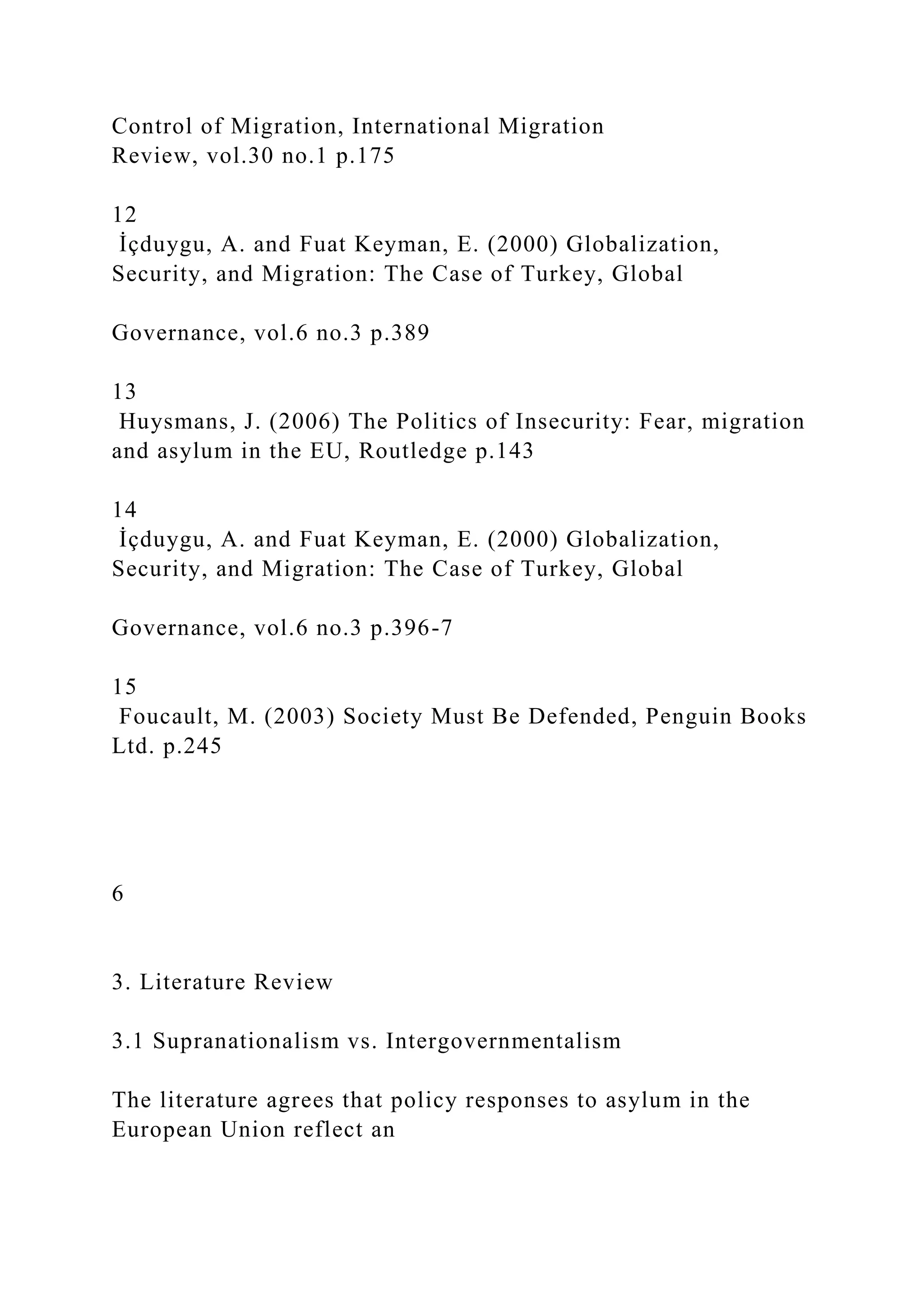
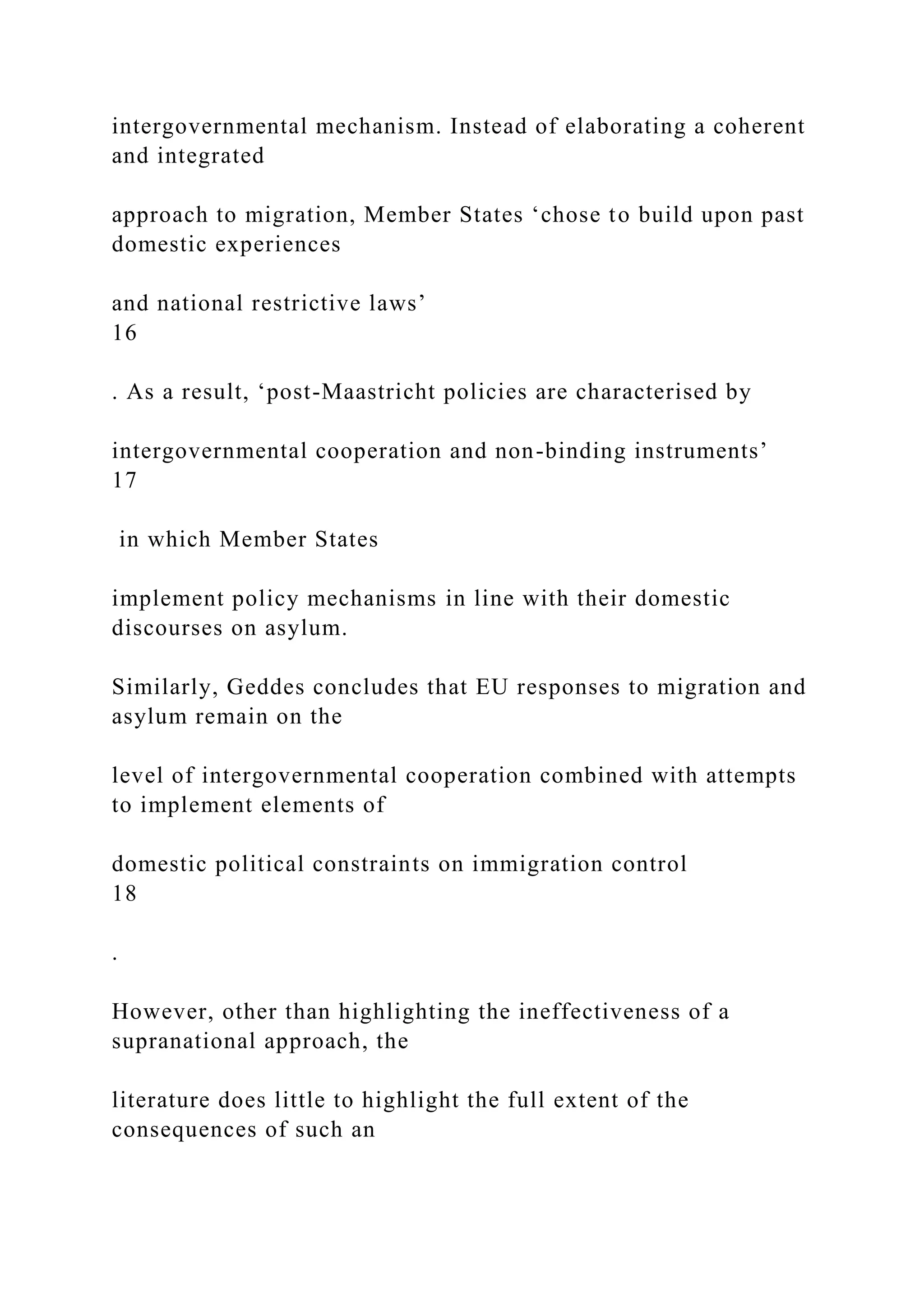
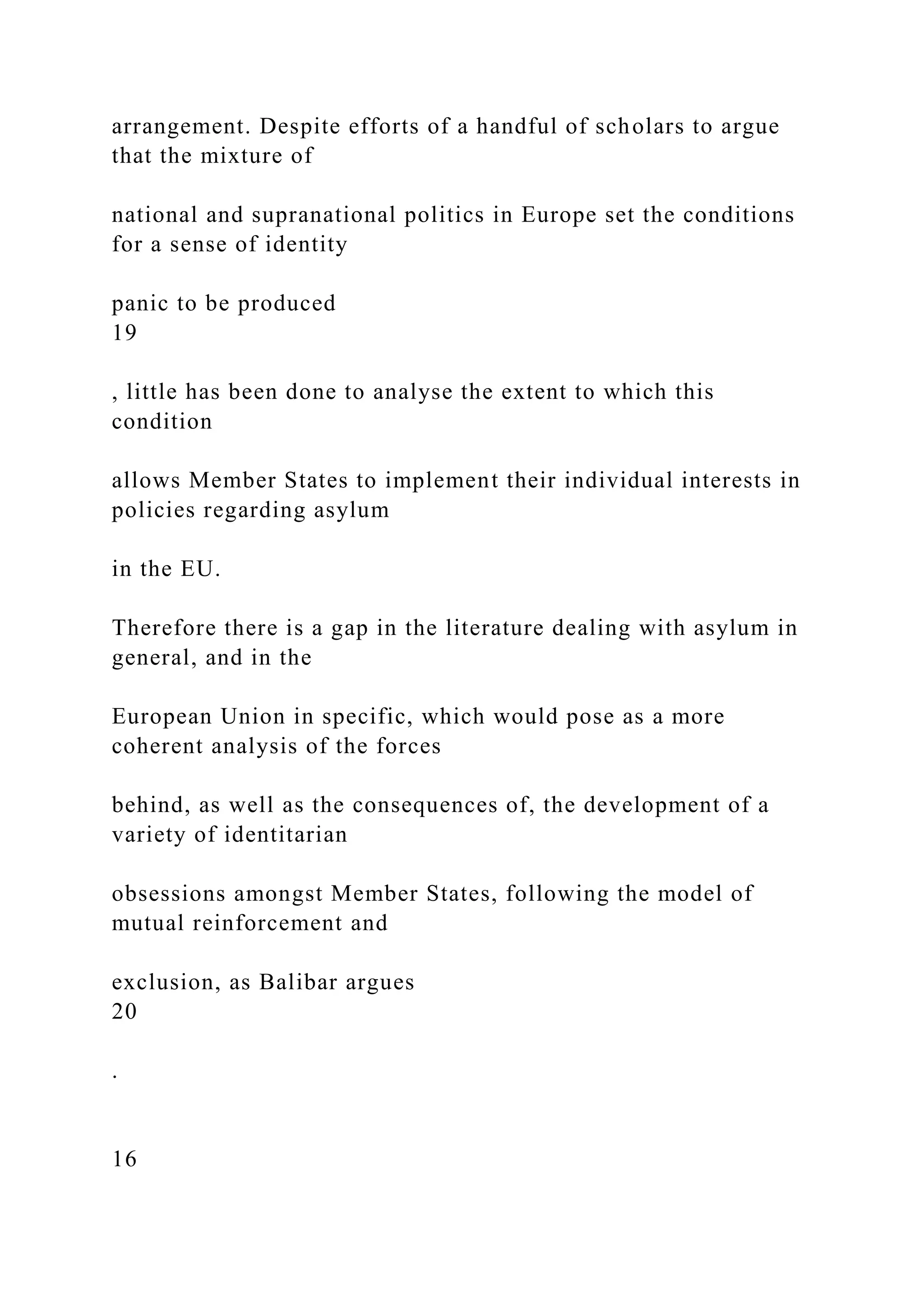


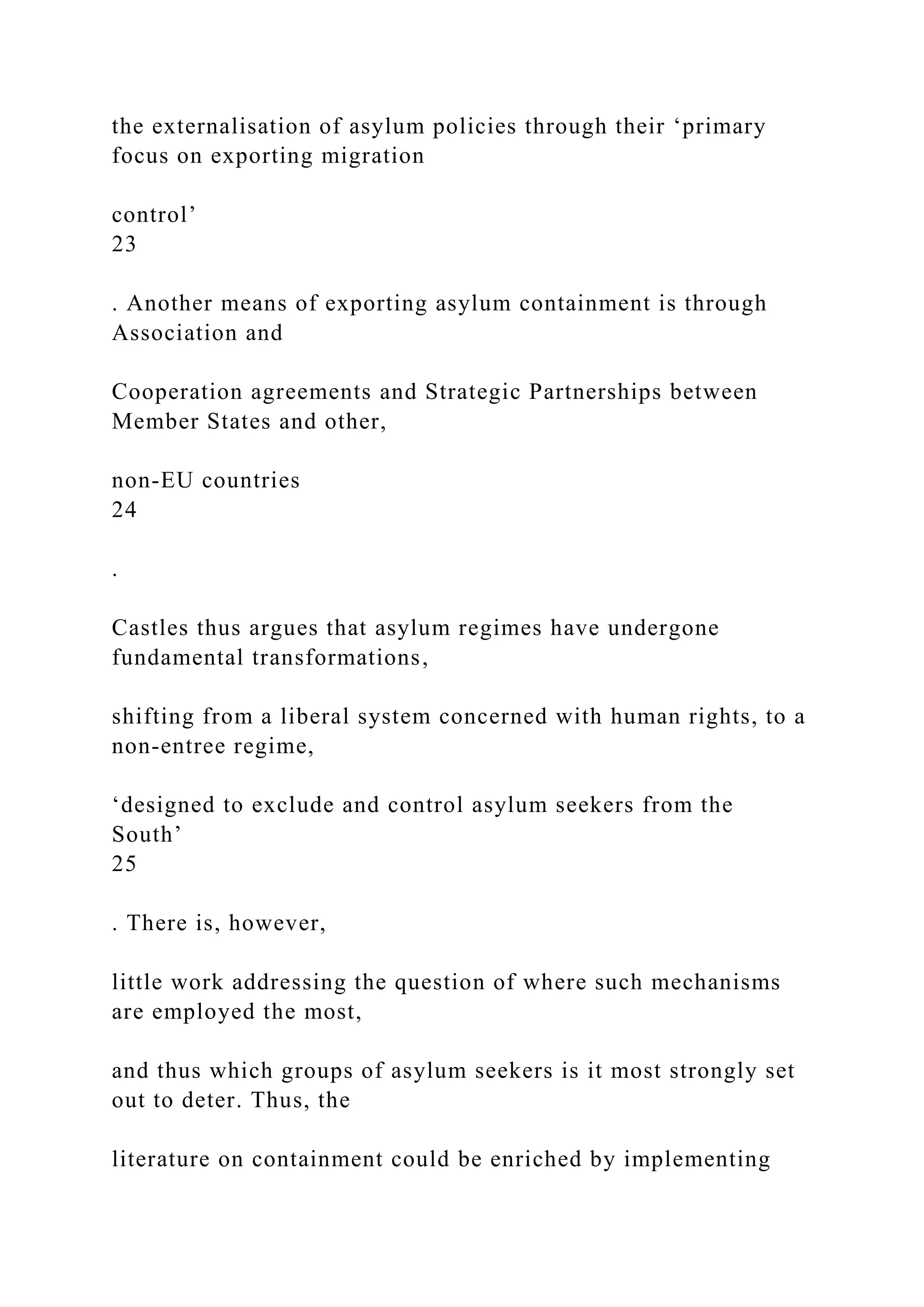

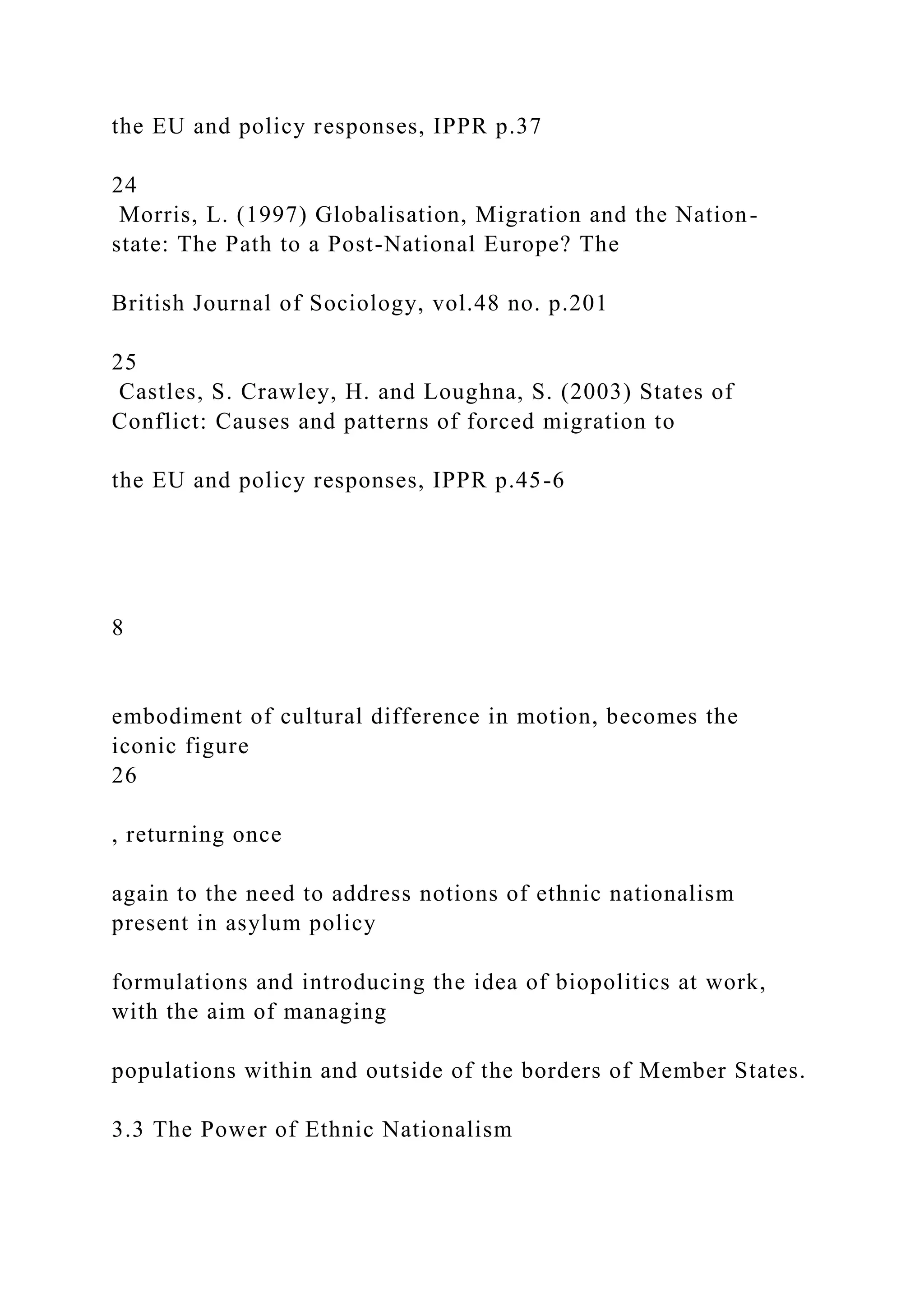






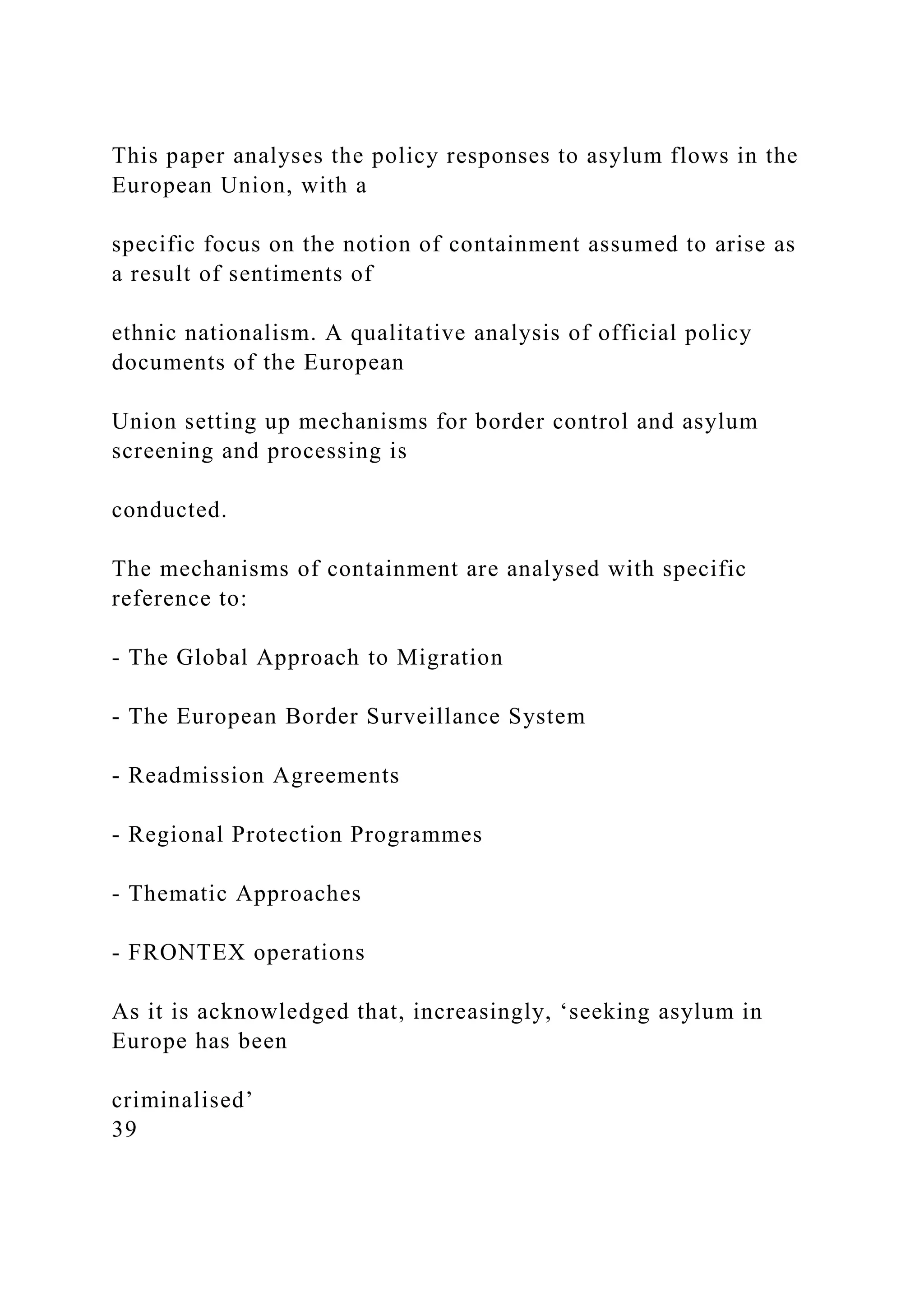

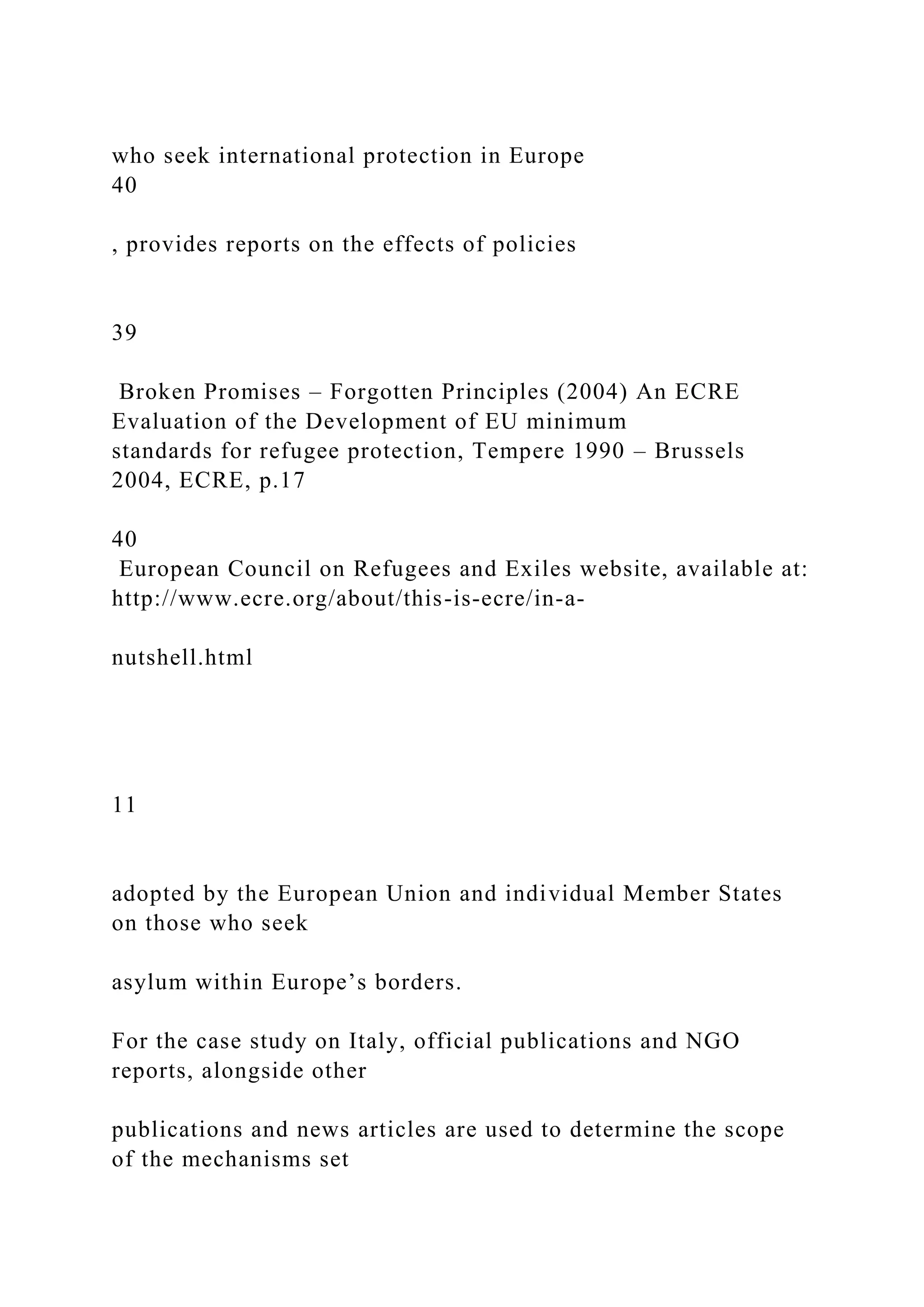






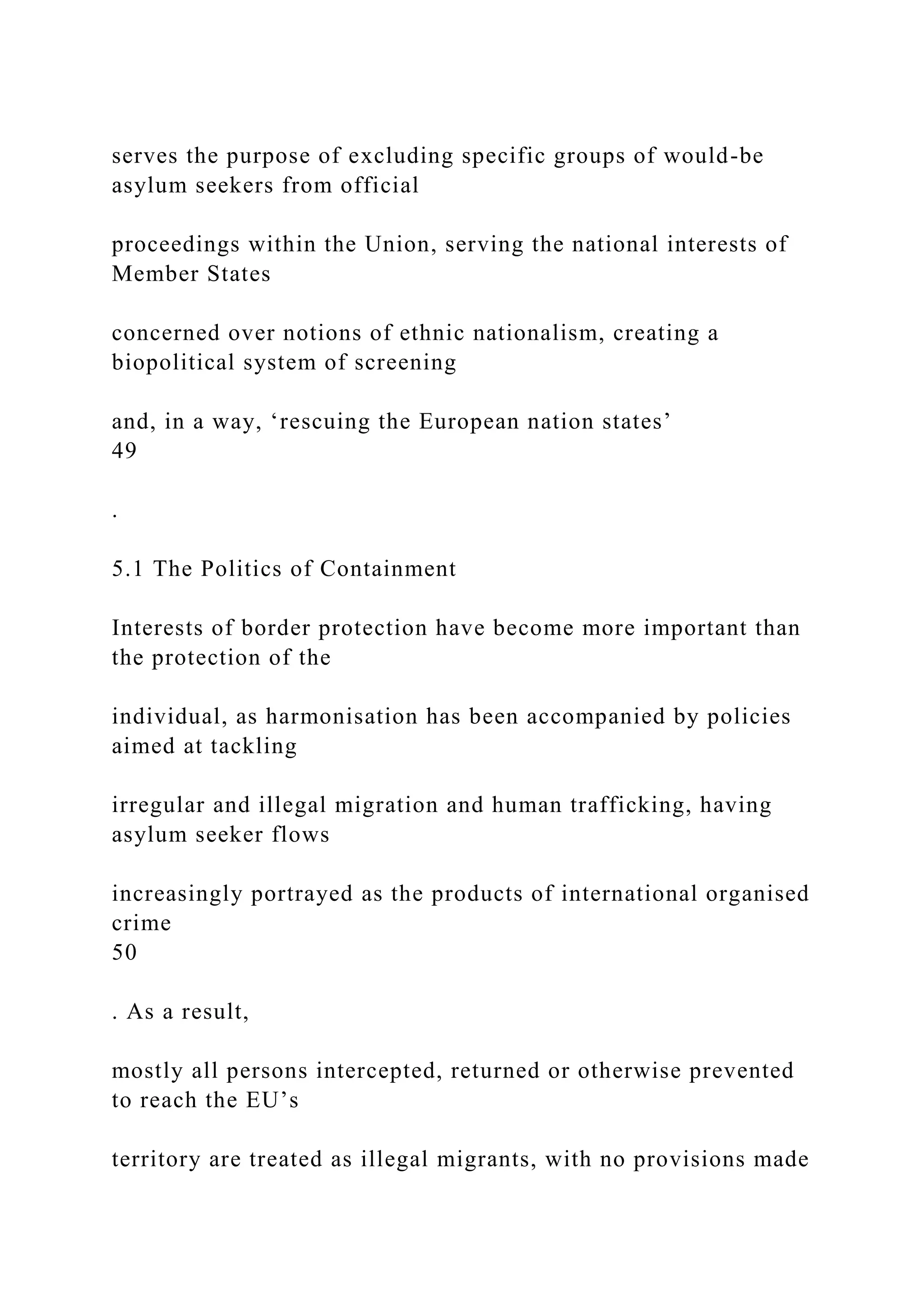









![of this Directive cannot establish an absolute guarantee of
safety for nationals
of that country. [...] For this reason, it is important that, where
an applicant
shows that there are serious reasons to consider the country not
to be safe in
his/her particular circumstances, the designation of the country
as safe can
no longer be considered relevant for him/her’
64
However, the application of the right of specific groups of
refugees to seek asylum by
providing reasons to consider that a third country is not safe for
his/her particular
circumstances is increasingly sidelined by the general
application of the regulation. This
is particularly evident when further examination of regional and
thematic approaches to
the notion of asylum is conducted.
Hence, a Communication from the Commission describing a
strategy on the External
Dimension of the Area of Freedom, Security and Justice
highlights the importance of](https://image.slidesharecdn.com/httpsifes-221015083553-d170a478/75/httpsifes-orgsitesdefaultfilesbrijuni18countryreport_fi-docx-573-2048.jpg)

![2000/0238 (CNS), p.4
65
Chapter V of the Communication from the Commission: A
Strategy on the External Dimension of the Area of
Freedom, Security and Justice COM(2005) 491 final
17
building such as a fundamental overhaul of the judiciary, and
the
development of border management and an asylum system in
line with
European standards. With the Mediterranean countries,
strengthening good
governance and the rule of law as well as improving migration
management and security are the main goals. [...] Migration and
border
management are at the top of the agenda, and partnerships
should be
strengthened in the region with countries of origin and transit.
Further
progress is necessary on readmission agreements, and efforts to](https://image.slidesharecdn.com/httpsifes-221015083553-d170a478/75/httpsifes-orgsitesdefaultfilesbrijuni18countryreport_fi-docx-575-2048.jpg)












![entry on the same grounds’
76
Therefore it is not applying for asylum, but reaching the
territory of the European Union in
order to do so that is extremely difficult. With the erection of
carrier sanctions and strict
border check mechanisms, the European Union has closed off its
borders to migrants
and therefore would-be asylum seekers from Africa and Asia,
revealing the biopolitical
patterns of European migration and asylum policies. Thus,
despite the Schengen
Borders Code Regulation encompassing a clause stating that
‘by way of derogation from paragraph 1[...] (c) third-country
nationals who do
not fulfil one or more of the conditions laid down in paragraph
1 may be
authorised by a Member State to enter its territory on
humanitarian grounds,
on grounds of national interest or because of international
obligations’,
77
those attempting to reach Europe from Africa and Asia are](https://image.slidesharecdn.com/httpsifes-221015083553-d170a478/75/httpsifes-orgsitesdefaultfilesbrijuni18countryreport_fi-docx-588-2048.jpg)





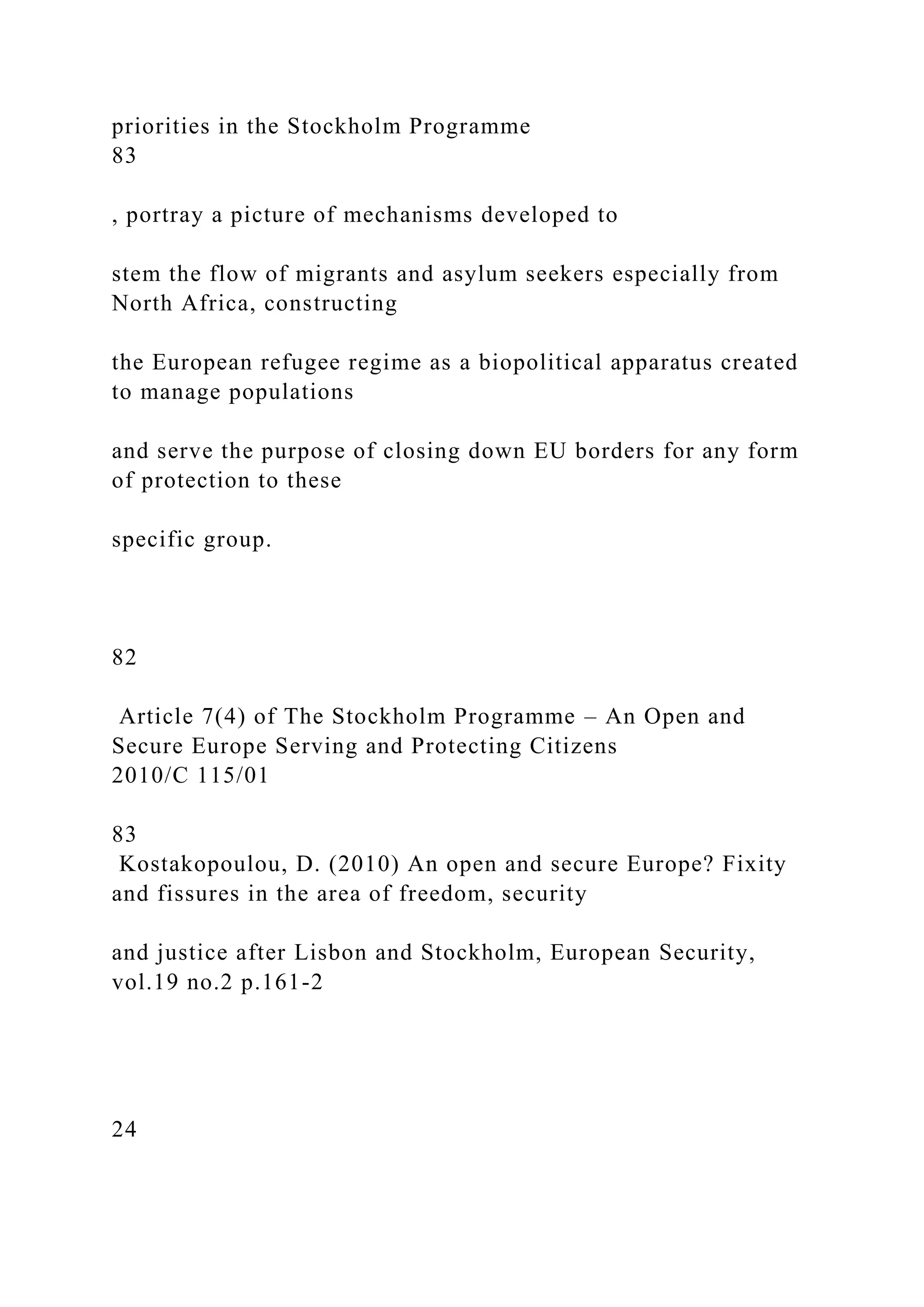
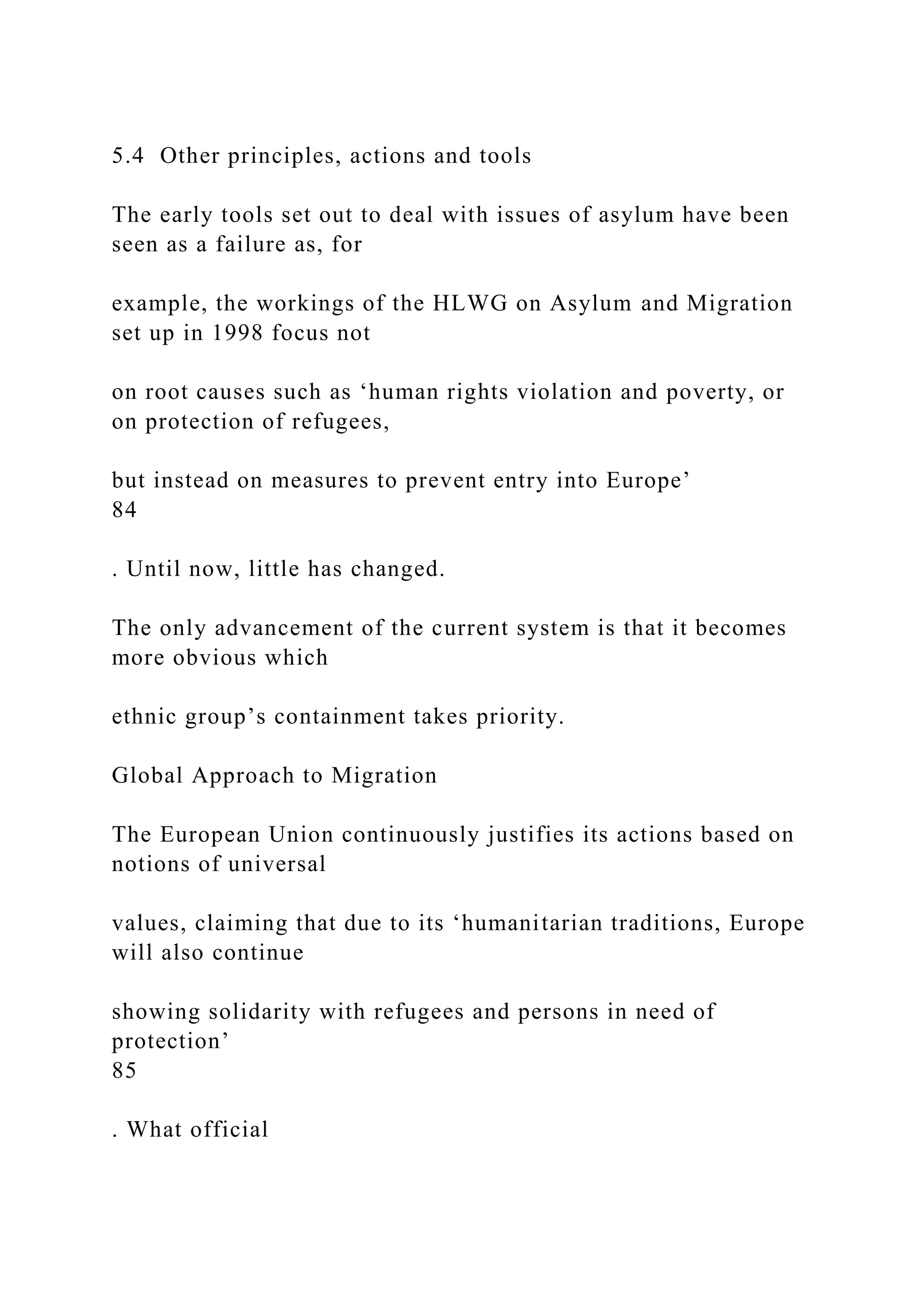


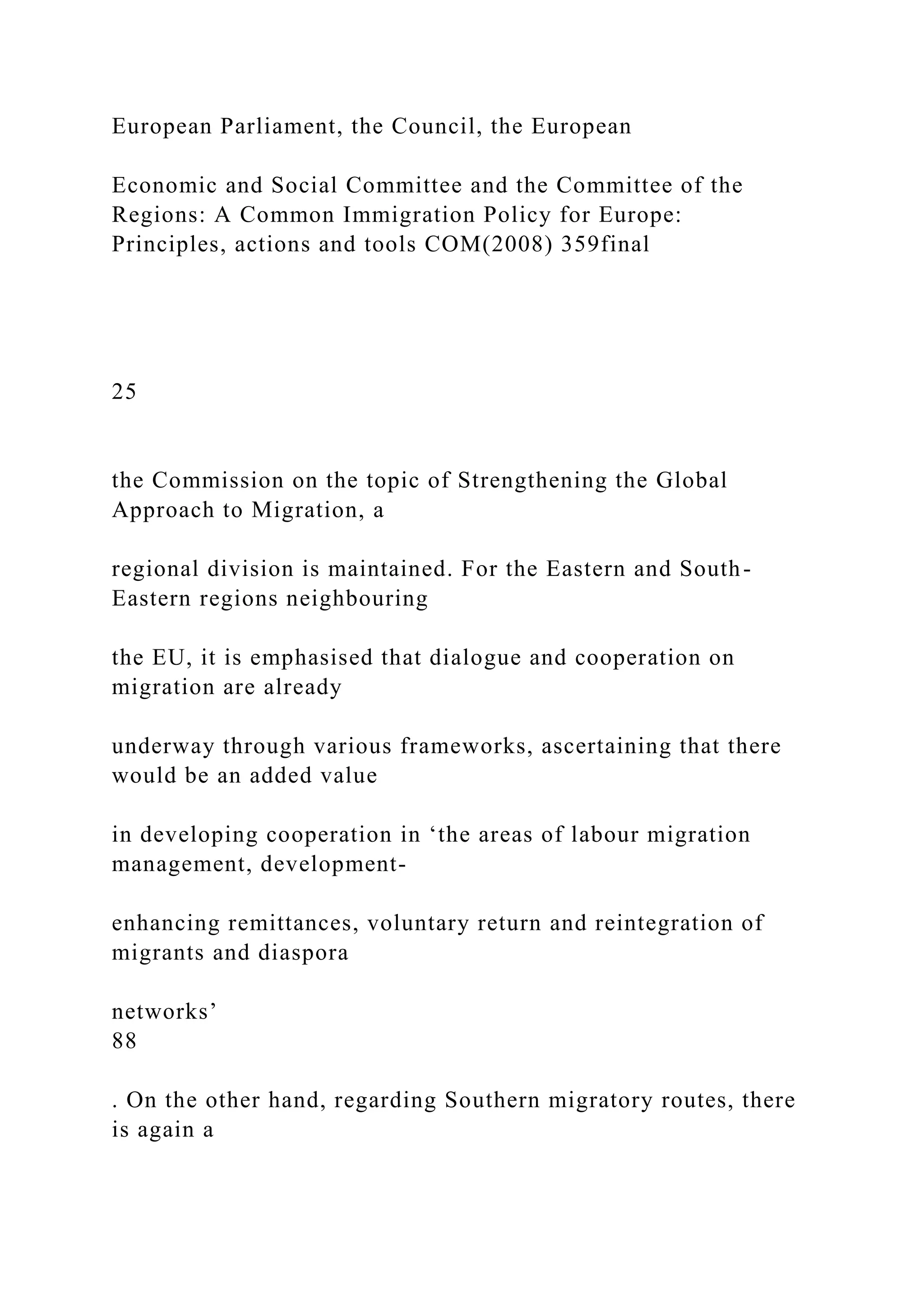








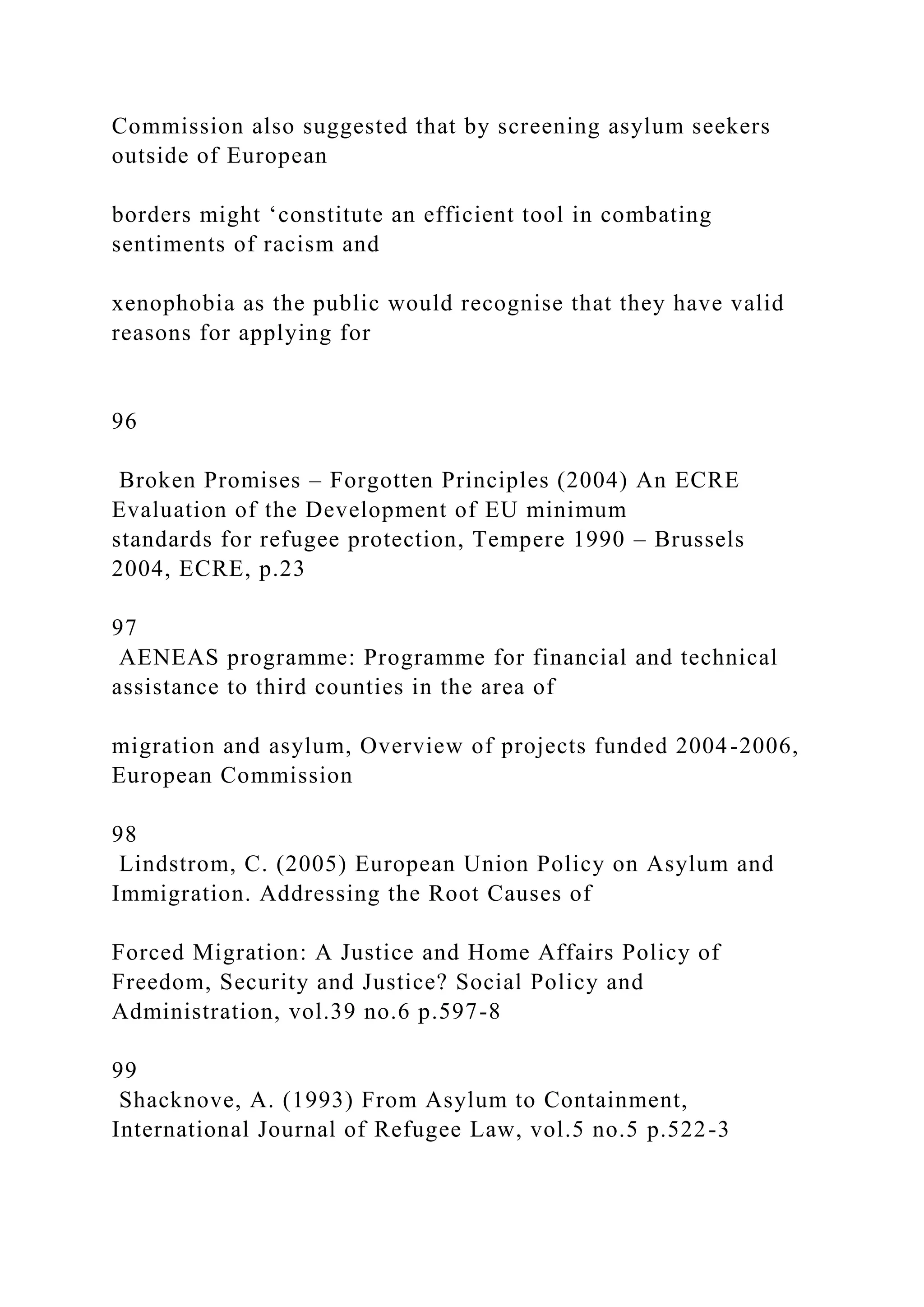


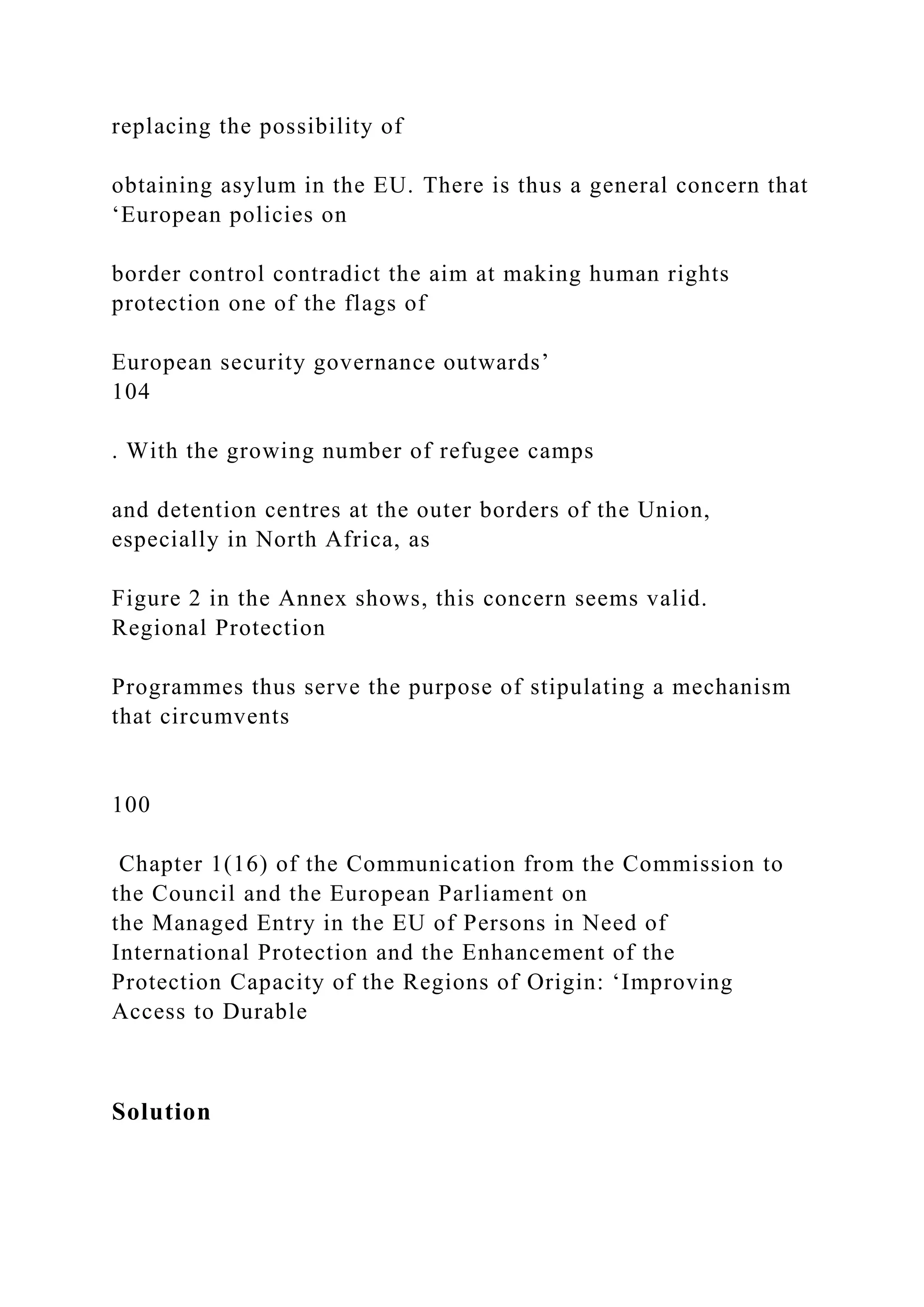


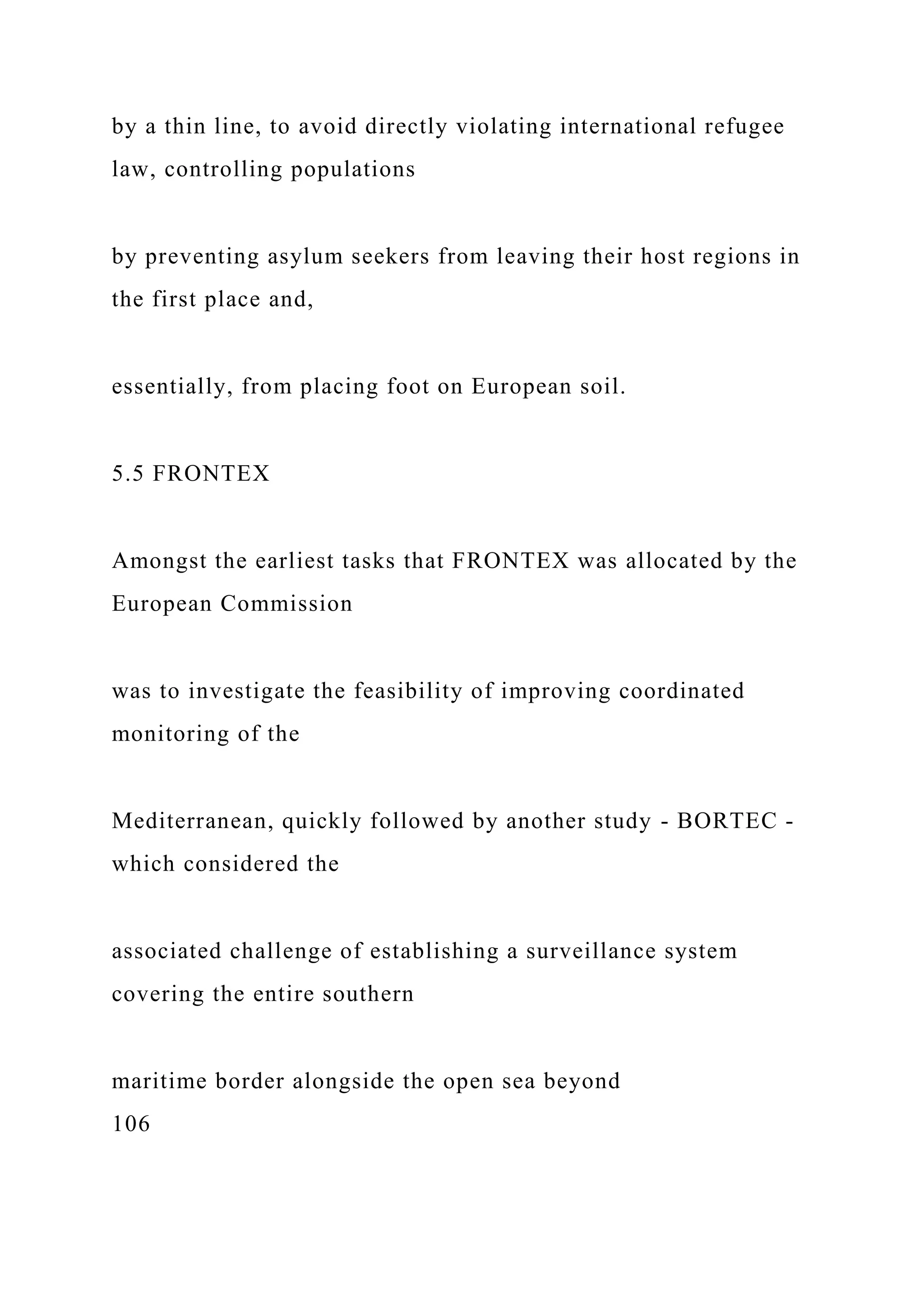








![31
[future] focus of maritime attention lay: the Mediterranean Sea’
114
. Despite Article 31 of
the 1951 Refugee Convention recognising that asylum seekers
may enter the territory of
a signatory State without authorisation
115
, their very attempt to reach the territories of the
European Union is prevented, with their illegal status used to
disqualify their rights
116
.](https://image.slidesharecdn.com/httpsifes-221015083553-d170a478/75/httpsifes-orgsitesdefaultfilesbrijuni18countryreport_fi-docx-622-2048.jpg)
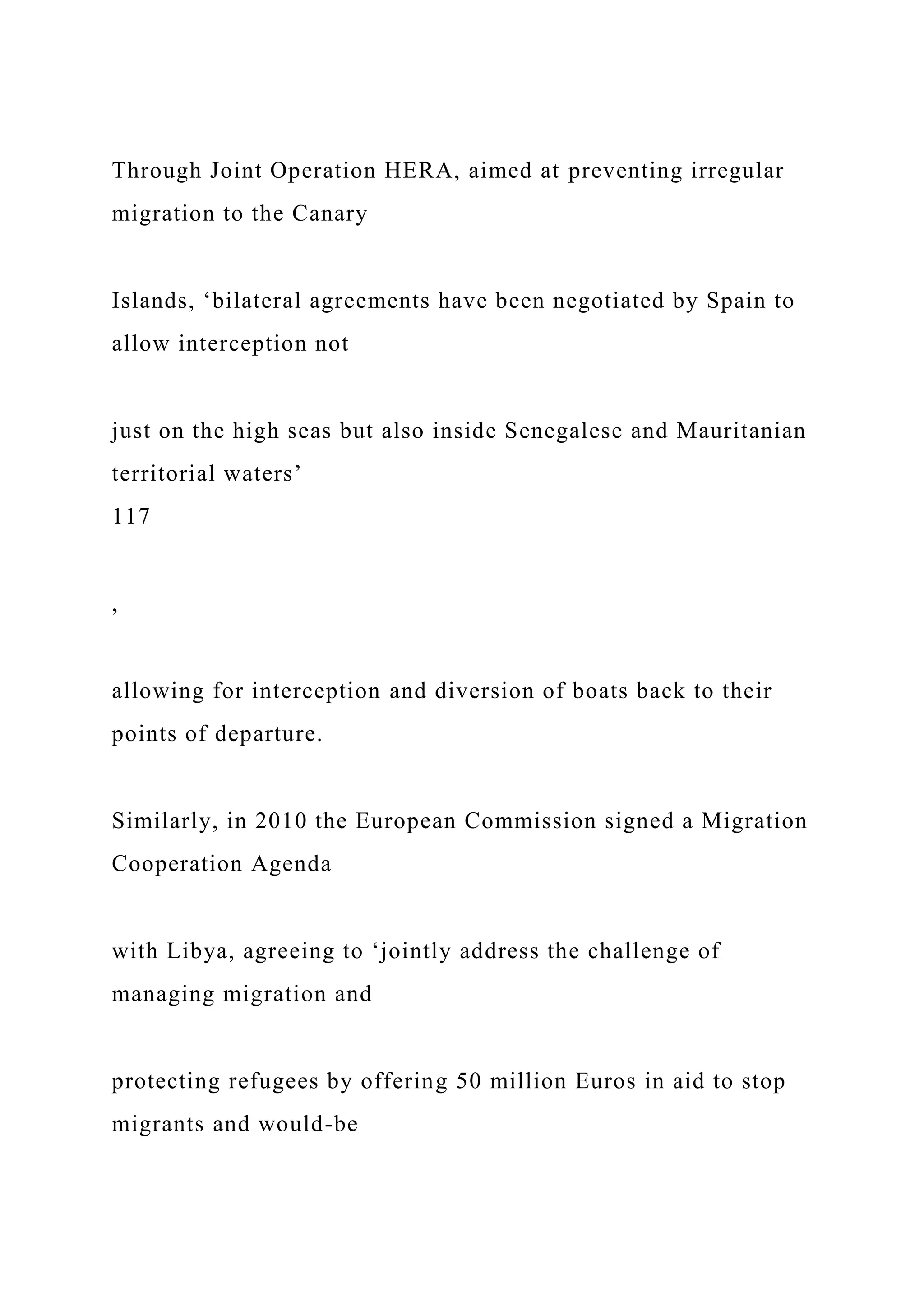


![5.6 Thematic Programmes
The Thematic Programmes of the European asylum regime are
erected with the aim of
setting clear principles and objectives for the Union’s
engagement with third countries. At
the same time, they serve the purpose of reducing ‘the burden of
control at their
[Member States’] immediate borders and increases the chances
of curtailing unwanted
inflows before they reach the common territory’
119
. As such, by analysing where the
focus of these is placed and what kind of action is prescribed, a
better understanding of
the Union’s objectives concerning specific regions, and thus](https://image.slidesharecdn.com/httpsifes-221015083553-d170a478/75/httpsifes-orgsitesdefaultfilesbrijuni18countryreport_fi-docx-626-2048.jpg)

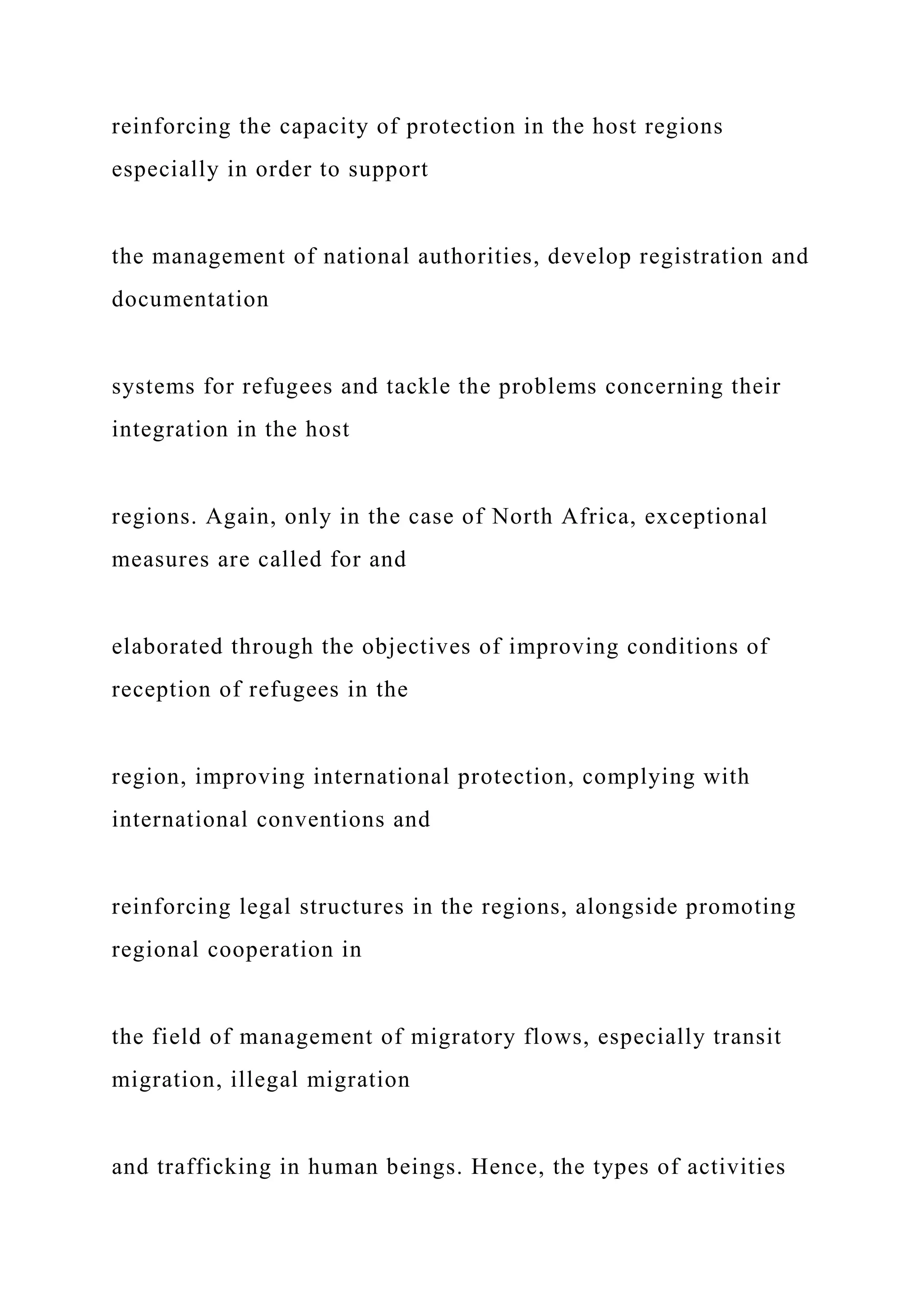




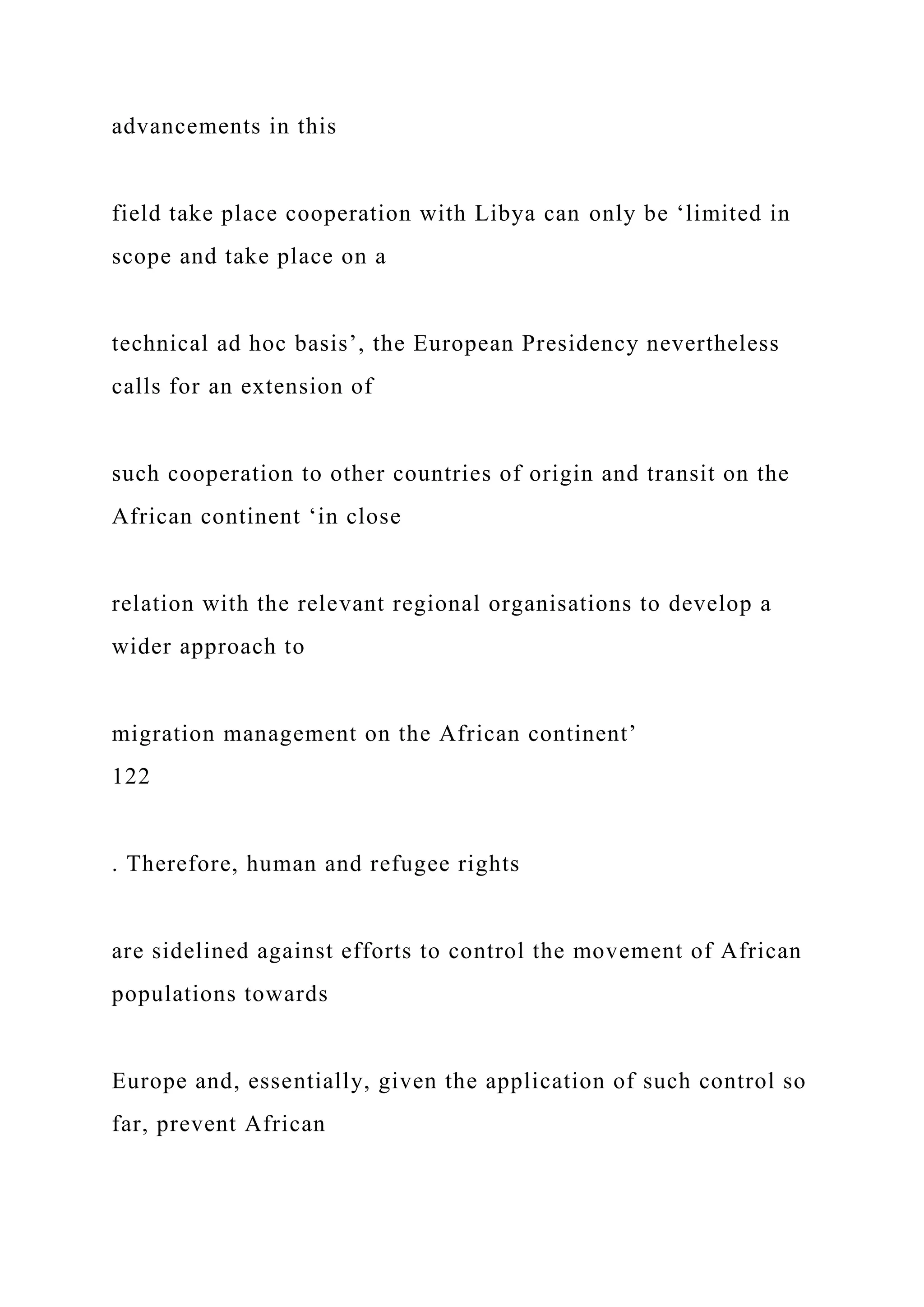





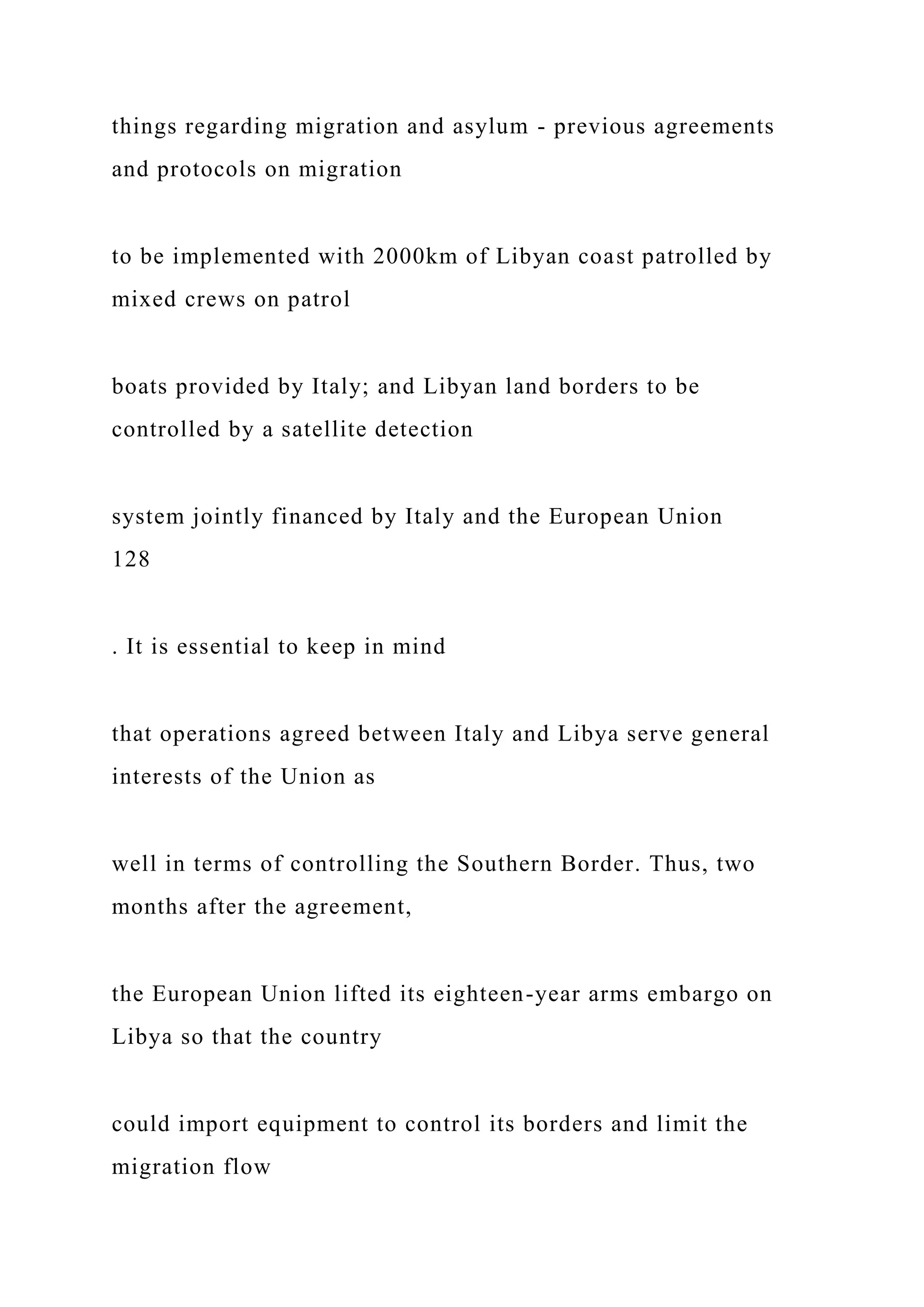



![seekers are not given the opportunity to lodge an application for
protection. Even if such
action was taking place, the CPT Report highlights that even if
protection was requested
aboard an Italian vessel, ‘there is no procedure in place capable
of referring him/her to a
protection mechanism’
133
. Meanwhile, Berlusconi was quoted by the Italian media saying
that the Italian idea it to ‘take only those citizens who are in a
position to request political
asylum [...] referring to those who put their feet down on our
[Italian] soil’
134
. This is
apparently a shared view across the Union demonstrated by the](https://image.slidesharecdn.com/httpsifes-221015083553-d170a478/75/httpsifes-orgsitesdefaultfilesbrijuni18countryreport_fi-docx-643-2048.jpg)
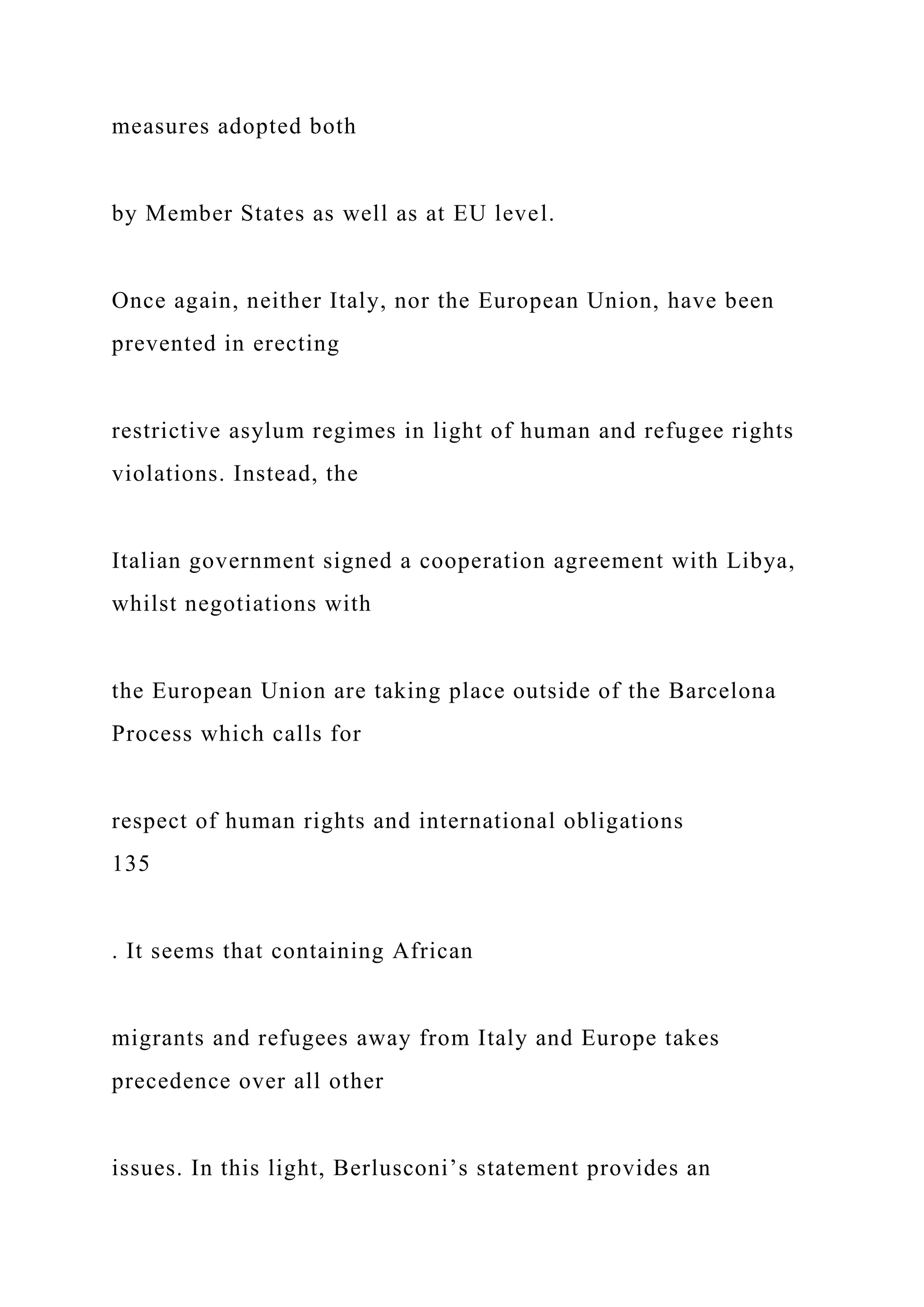


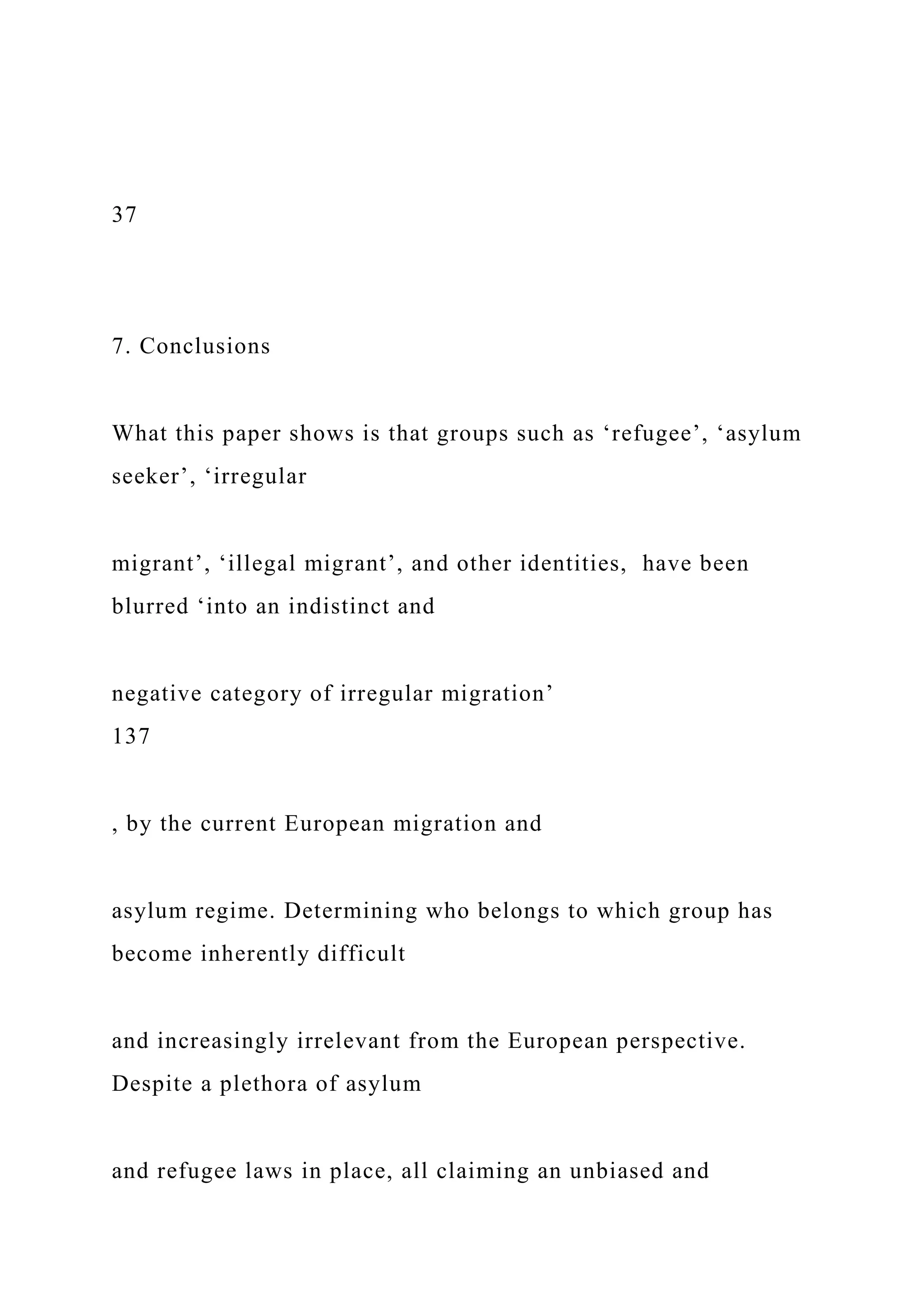


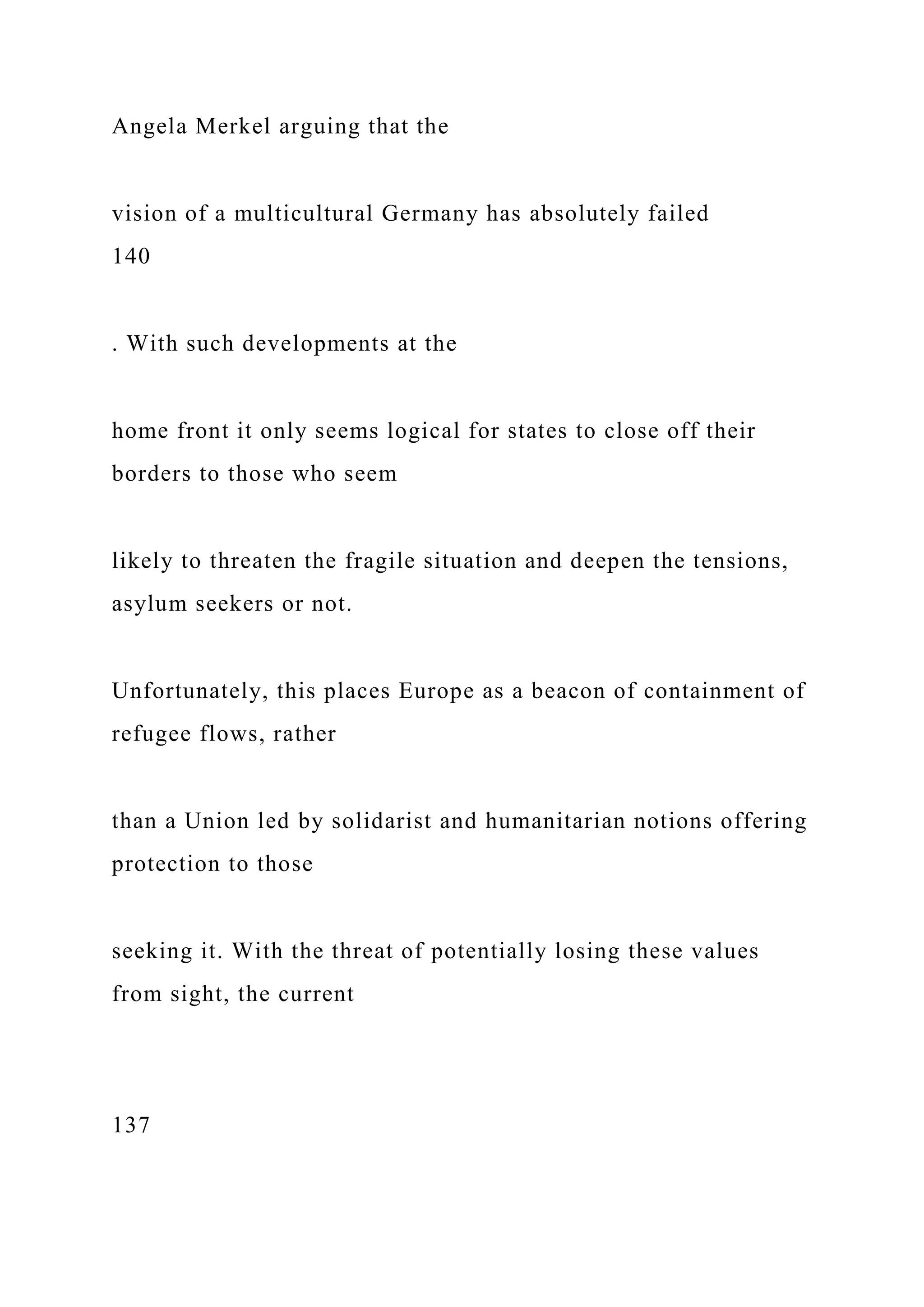

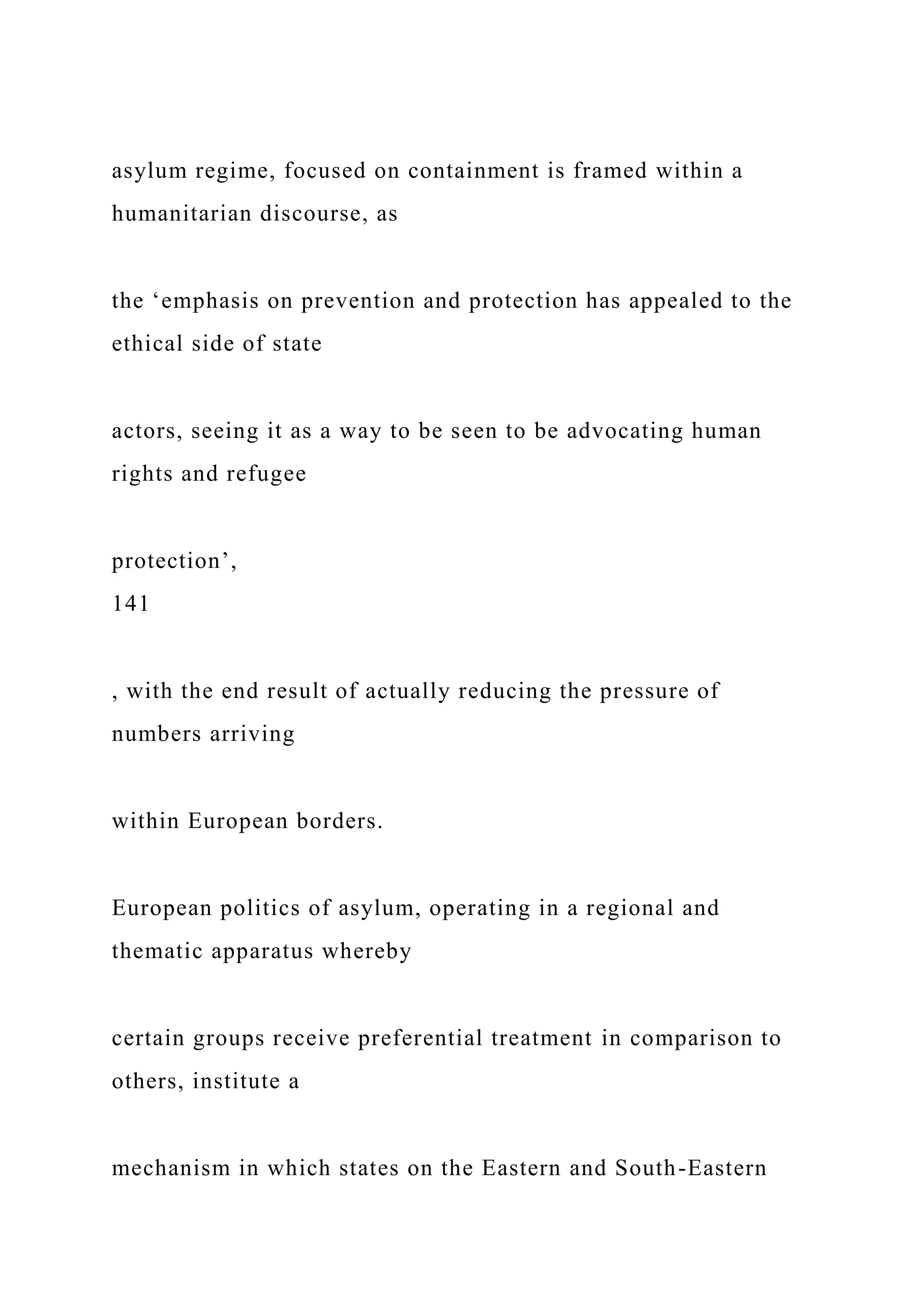

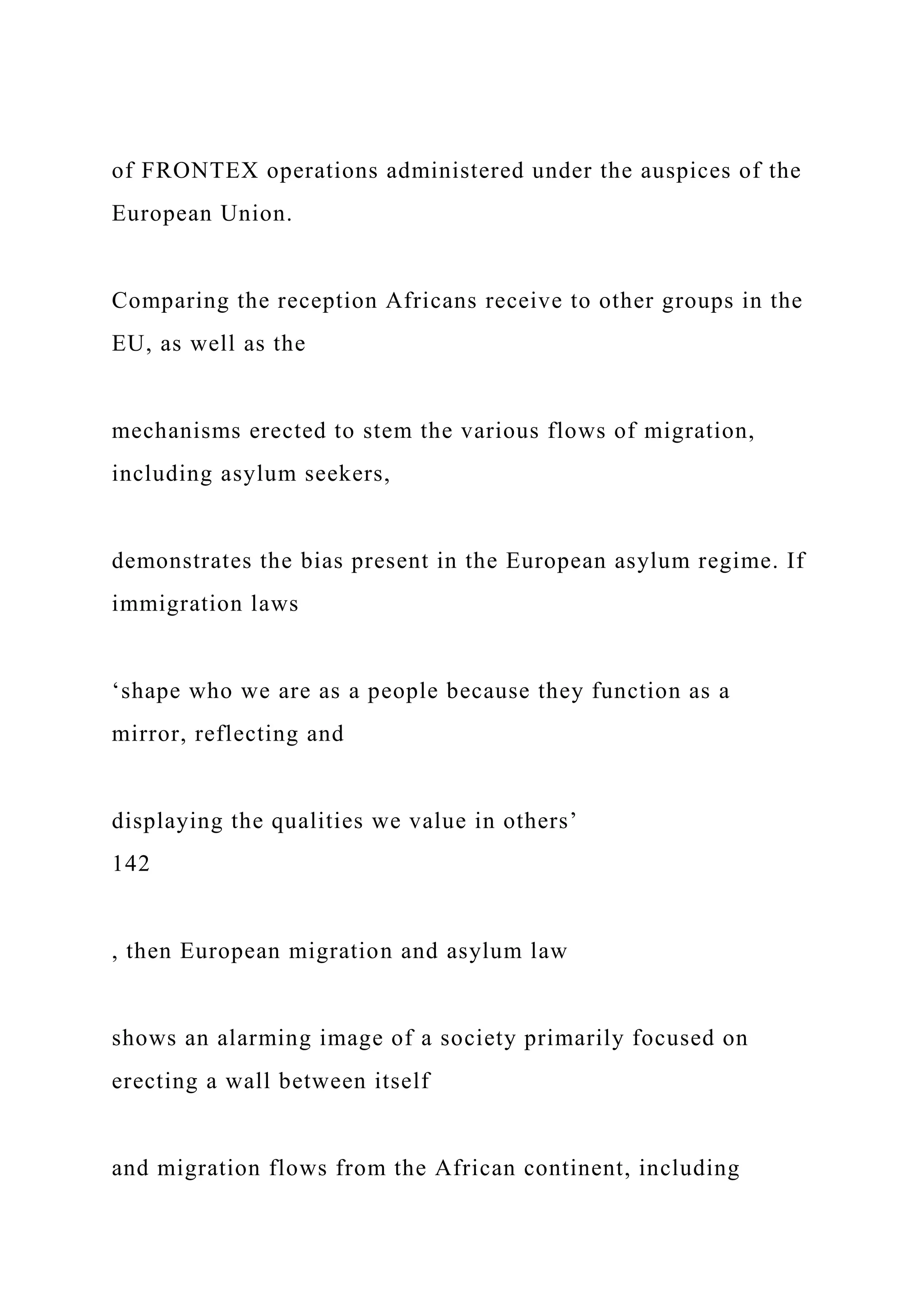
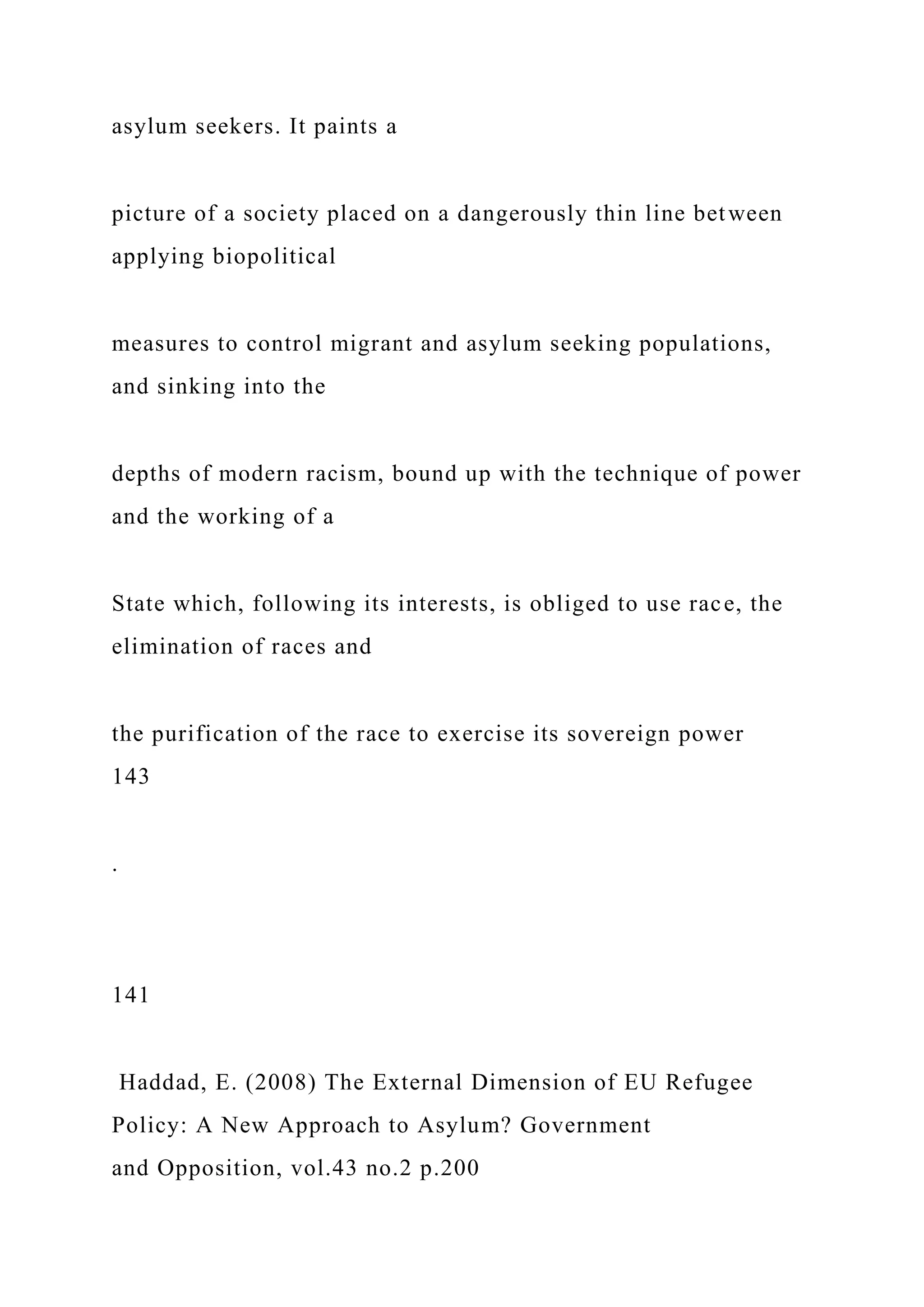
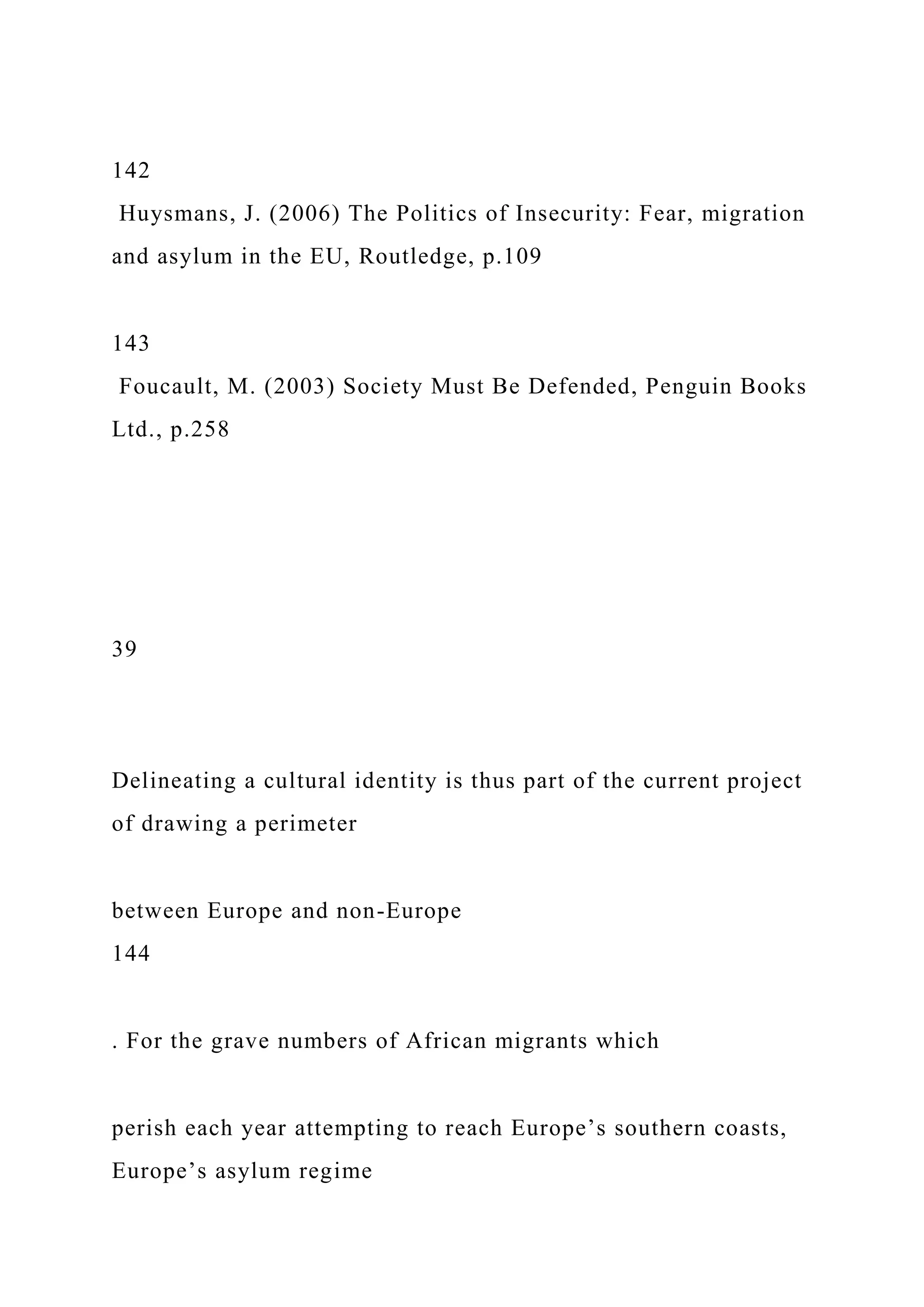

![ethnic nationalism and calls for greater social cohesion,
instituting a biopolitical
apparatus and shifting from a ‘system designed to welcome
Cold War refugees from the
East and to resettle them as permanent exiles in new homes, to a
non-entree regime,
designed to exclude and control asylum seekers, [especially]
from the South’
146
.
144
Bhabha, J. (1998) ‘Get Back to Where You Once Belonged’:
Identity, Citizenship and Exclusion in Europe,
Human Rights Quarterly, vol.20 no.3 p.598
145
Muller, J. (2008) Us and Them: The Enduring Power of Ethnic
Nationalism, Foreign Affairs, vol.87 no.3 p.19](https://image.slidesharecdn.com/httpsifes-221015083553-d170a478/75/httpsifes-orgsitesdefaultfilesbrijuni18countryreport_fi-docx-658-2048.jpg)
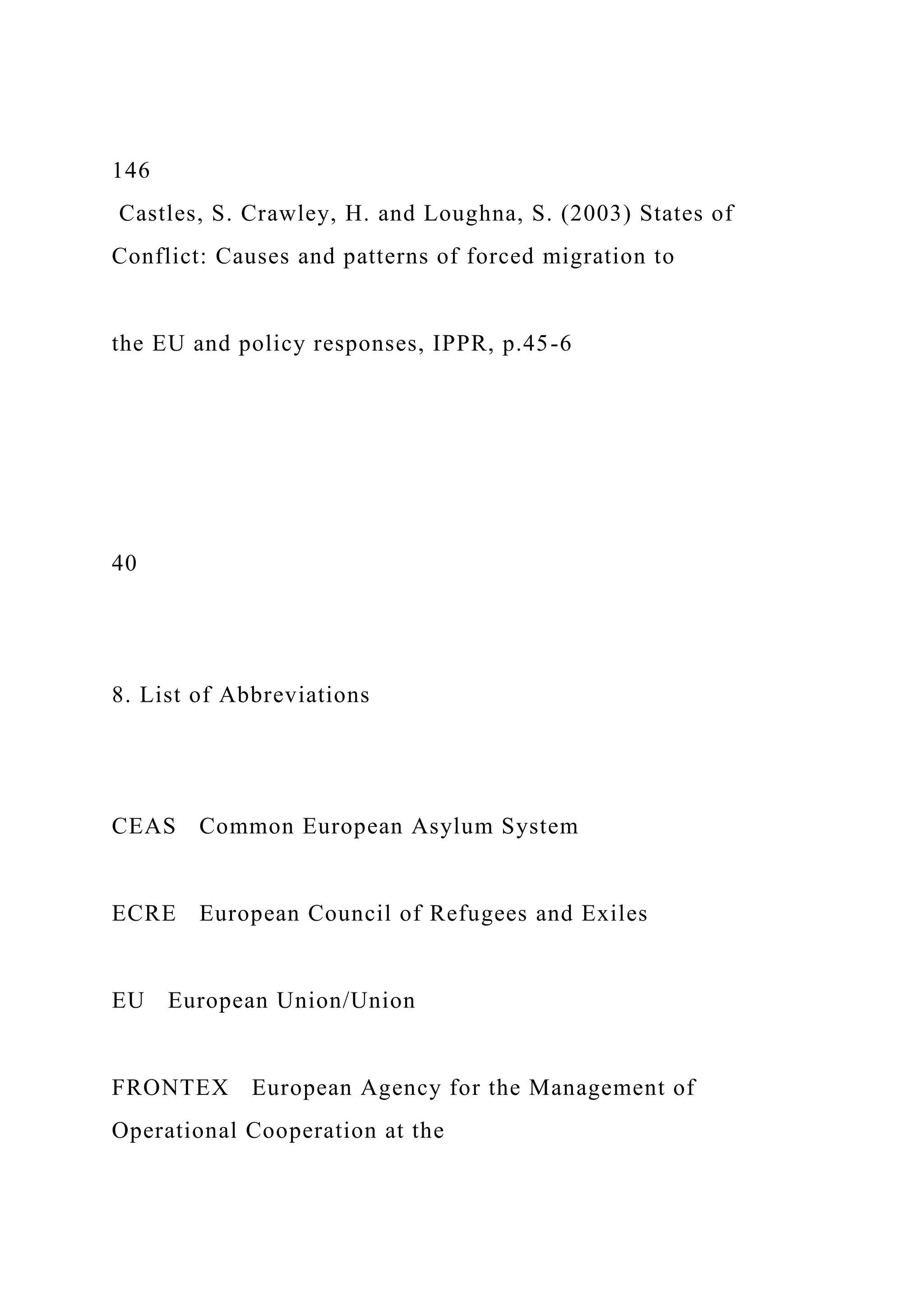

![Official documents:
1951 Convention and Protocol Relating to the Status of
refugees, UNHCR, available at:
http://www.unhcr.org/3b66c2aa10.html [accessed March 2,
2012]
AENEAS programme: Programme for financial and technical
assistance to third counties
in the area of migration and asylum, Overview of projects
funded 2004-2006, European
Commission, available at:
http://ec.europa.eu/europeaid/what/migration-
asylum/documents/aeneas_2004_2006_overview_en.pdf
[accessed April 15, 2012]
Commission Staff Working Paper: Report on Progress Made in
Developing the
European Border Surveillance System (EUROSUR) SEC(2009)](https://image.slidesharecdn.com/httpsifes-221015083553-d170a478/75/httpsifes-orgsitesdefaultfilesbrijuni18countryreport_fi-docx-661-2048.jpg)

